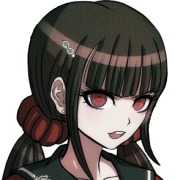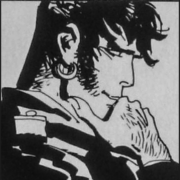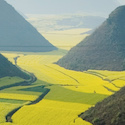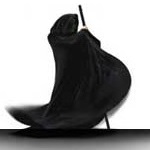|
Welcome to Let's Play Chemicus!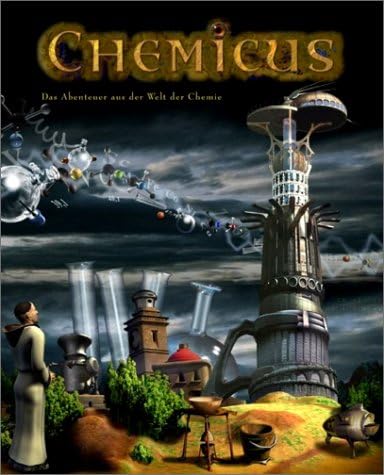 What's Chemicus? Chemicus (apparently titled "Chemicus: Journey to the Other Side" in an English language release I know nothing about) is a German point-and-click adventure from 2001 made with QuickTime. It's meant to teach German school kids about chemistry. How well they pull it off, I'll leave to your judgement. It's part of a series of learning games covering topics from physics, biology and some others, but Chemicus is the only one I've actually played, so that what we'll be going with today. I actually played this back in the day. I remember having some fun with it until it got too hard and I used the walkthrough that came with the game to finish it. I don't think it taught me anything that I didn't know going into it, but then again, I was too lazy to use the included encyclopedia of chemistry knowledge. So, German? Yeah, the game is in German, but I figure it's mostly chemistry puzzles, so I should be able to translate the bits that crop up here and there. For formatting, this normal text will be my commentary, while italics will be translated text from the game, usually of text that's on the screenshot immediately above. Spoiler policy I'd like people reading along to be able to try and solve the puzzles on their own, so if you know the game, please refrain from spoiling. Regarding the chemistry itself, I'll leave it up to your judgement. So, if you've got a PhD in chemistry and see a solution instantly, maybe put it behind spoiler bars so the others can have fun. Your call, though. Format I'll be doing a screenshot LP, mostly. There's a few cutscenes in there that will go up on youtube (and which I'll sub in English), the rest of the game will be screenshots and gifs. Furthermore, I want to add some opportunities for audience participation. Specifically, I'd like to encourage you to try and solve the puzzles yourself. If I just solve everything for you, I believe that makes it harder for you to assess how approachable the puzzles really are, because there's a certain tendency to read the puzzle, go "I don't get it" and immediately read up on the solution. So, at certain points where the game lends itself to it (i.e., we've just gotten all the parts and info for solving a puzzle), I'll make a deliberate stop to allow you to weigh in on what you think the solution is. I'm curious how much you'll be able to figure out just from backseating and without having access to the game's encyclopedia. To make it a bit easier on you, I will bold items that we pick up or use/lose. I'm unsure if I can reasonably track interactable spots in the environment and clues beyond that without spoiling too much, we'll see. If you'd prefer to just sit back and let the LP wash over you, that's fine too, of course. I will be giving the solutions regardless of whether anybody actually even comes close to guessing it, and I'll try to link relevant information so you can hopefully understand why the solution works. I should note that I'm not sure how often this will work out well, and how often the puzzles are so incremental that it would break the flow to put the individual parts up here. I will play/read ahead though to make this process more smooth. Table of Contents Update H - Useless Switches get Useless Stitches Update He - Give Me Warp Speed, Mr. Richard Update Li - She took the Midday Transporter going Anywhere Update Be - Electrochemistry, but without the drug use Update B - Open World Chemistry Maki fucked around with this message at 19:34 on Oct 7, 2023 |
|
|
|

|
| # ? May 5, 2024 00:38 |
|
Update H - Useless Switches get Useless Stitches The first thing we do is to enjoy the riveting intro cinematics (English CC are available) https://www.youtube.com/watch?v=lXwXHJsaLm8 And with that, we're in the game!  The interface is nothing fancy, we have our little eyeball cursor that morphs into different shapes when we can move or interact with something. Fairly standard. I immediately enter the room.  And since that fan in the back looks interesting, let's investigate it.  There's a switch...  switch ...that when flipped...  useless switch ...does nothing whatsoever. Great. In general though, this game just prefers to have things non-interactable instead of trolling you like this, so pixel hunting at least is made a bit easier by your cursor usually being a reliable tool to find interesting spots. It can be a bit finicky at times to get the game to agree with you that you're pointing at a certain object or dragging something to the right spot, but it's workable.  The room, for all its decor, actually contains almost no interactable objects aside from that useless switch. We can go to the desk...  ...and look up...  ...to see the tower from the intro cinematics and the box art, but nothing to interact here either. The only thing we actually can interact with is a cabinet on the far side of the room.  The small drawers all contain letters... 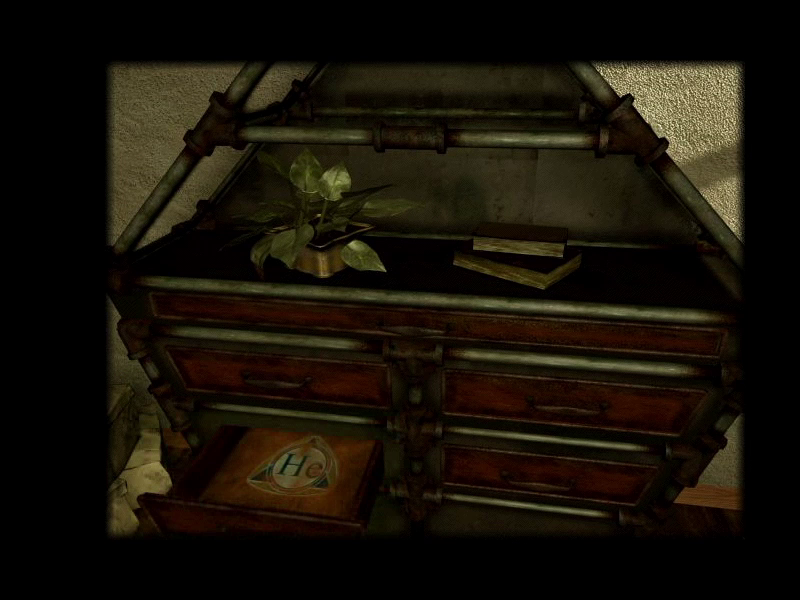   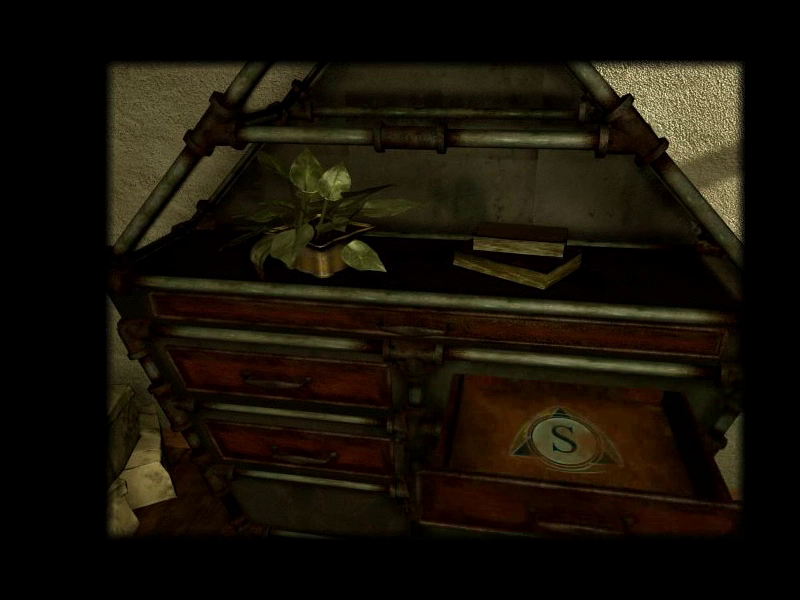 ...and as for the big drawer...   ...it actually contains our HUD that we will be looking at for the rest of the game. Immediately, a small monitor in the bottom left corner slides out...  ...and the dude from the intro (whom the manual helpfully identifies as "Richard") starts talking to us. https://www.youtube.com/watch?v=g6TY7gV7uXE Guess we've got a quest now! The other parts of the interface are rather straightforward, with one exception.  This button opens up the encyclopedia  There's a lot of high-school chemistry stuff in here, with the idea that you can and need to reference it to find out about all the chemistry you're going to have to do to beat this game  Not everything is accessible from the word go, the dark green sections unlock later, we'll get to that when it happens.  This one thing, for example, talks about different mixtures of substances, such as emulsions, suspensions, smoke and fog. Having played through this game before, I don't think this particular knowledge will be relevant for any of the puzzles.  The big green button on the left allows us to save, load, set settings and end the game.  And the yellow button at the right opens our (currently empty) inventory.  Finally, there's this thing on the left that you can drag around. If you've got any chemical substance, it should be able to tell you what it is. We don't have any chemicals here, so nothing happens. I don't think I ever understood what this thing does back when I played it as a kid, because reading the manual is for chumps. Actually, that might explain why I never finished the game without a walkthrough. Anyway, with that out of the way, let's look at that piece of paper sitting in the top drawer.  1. Hydrogen 2. Sulfur 3. Titanium 4. Helium Copper = Start And this is the game's first puzzle. This one's easy if you've got a passing familiarity with chemical elements. (If you don't, uh...good luck with the other puzzles) We simply open the drawers in the stated order, where each drawer's text is the chemical symbol for one of the elements on the list, so we go H, S, Ti, He and finish off with Cu. If we do that... 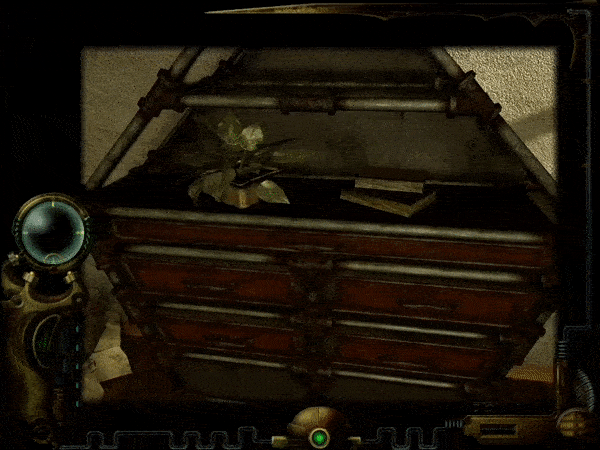 ...the cabinet slides to the side, revealing a hole in the wall...    ...and we land in some basement hallway.   The rope's snapped, so we gotta press onward...  ...which we do by immediately turning around 180 degrees and picking up a leaf of red cabbage from the corner. Picked up: red cabbage So, this game is very much in the "rub every item on every interactable" venue of adventure game, though I guess the intention is that if you've understood the chemistry, you don't need trial and error and can instead intuit what you're supposed to do. How much that works out is certainly up for debate, doubly so for you because you won't have the in-game chemistry encyclopedia if you're just following along with this LP. We'll get to a point where you can try that out very soon. Turning around again and walking down the hallway, a passage leading to the right is revealed.  No puzzle here, the door just opens.   And we're standing in a weird sort of lab room, the first of many.  There's a weird contraption with buttons in the center, but it doesn't react to interaction. Neither does what the game calls a "tank with pH indicator" on the left-hand side.  Lemon The right hand side of the room has a desk with three items to pick up. This lemon...  Potassium hydroxide dissolved in water (I guess English doesn't have a word for that?)  Hydrochloric acid Picked up: Lemon, Potassium hydroxide, Hydrochloric acid Also, below the desk we find...  ...a safe! Locked, of course. There's stuff in the corners of the room, but the game won't let us approach it. It's never stated in the game (our protagonist is silent and completely refuses to tell us why they won't do a thing, much like in Myst), but the implication is that it's actually too dark to see.    Luckily, the solution is right around the corner. If we leave the room again and turn to the left...  ...we find this panel which you already might have spotted earlier. We just have to generate energy here, so we're using a lemon battery...  ...which turns on the lights in the basement. Lost: Lemon  There's light reflected up there  Showing this weird scanline pattern on the far wall of the basement. Let's see where the light's coming from!  The room's bright now, allowing us to actually look at the corners.  Cooking pot with cold water The stove is usable to bring the water to a boil  Nothing else happens here.  The washing basin...  rusty security key ...contains this rusty key, which we take. Picked up: Rusty Security Key  Finally, the cabinet...  ...contains a can of cola, which we also take. Picked up: Cola  For fun, I try the rusty key on the safe, but it doesn't work, so I guess we gotta remove the rust first.    Pour the cola into the beaker...  ...drop in the key...  ...it bubbles and we get a clean key. Lost: Rusty Security Key, Cola Picked up: Clean Security Key Before we try to use it, there's two more things on this desk to note. There's the flasks on the left hand side, which have a close-up shot  And we have that book, which-  Maki posted:Yeah, the game is in German, but I figure it's mostly chemistry puzzles, so I should be able to translate the bits that crop up here and there. So, I forgot that, much like Myst, this game dumps backstory on you in books. I don't think there's too many of these (cue me quoting this bit of hubris in a few updates), so this shouldn't be too bad, still. It is a few pages though, so strap in for some lore dumping. I will paste in images where the book contains illustrations: continue to research. Only in the old texts of the Order can an answer be found, of which we all bore witness. My eyes are burning. But even at a late hour, it seems impossible to me to clear up the situation. What should I present at the next meeting of the council? The council couldn't convince our fellow citizens. The meeting was a failure. The mood escalated. I failed. An argument with Loïc today. I surprised him as he was packing his trunk. He wants to leave as well! Even him - my beloved husband. It's impossible for me to understand, why he, like our fellow citizens, believes in the power of a demon. The apparition still is a 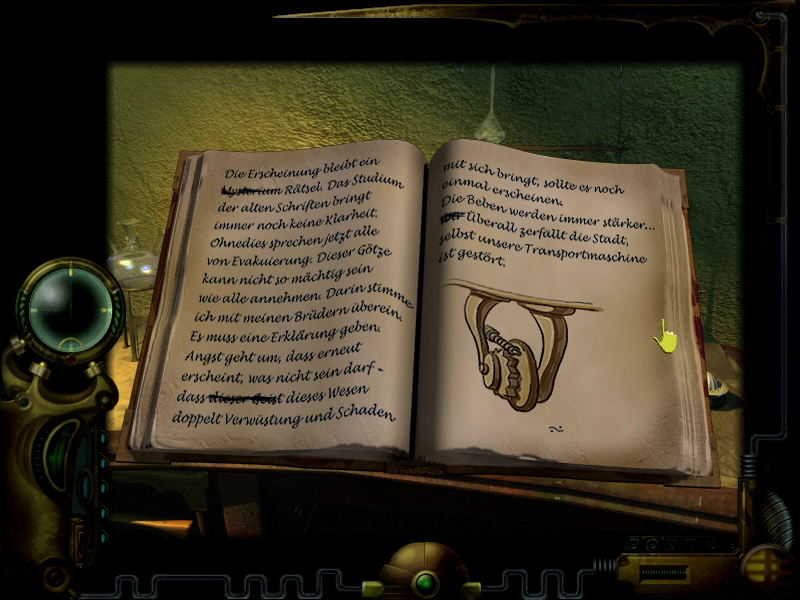 I will have to make the difficult journey to the volcano on foot to get some lava. I can only hope that the analysis is working, because our transmitter liquid is running out more and more. I couldn't work, I only could cry. Loïc joined the others at dawn. They are fleeing via the mountains. I couldn't convince him. Silence soaks the rooms. I convinced the council, that we - the Order - need to stay until the end. We need to find out whether that apparition will seal our fate! As he appeared a moon ago for the first time, I was not ready to believe, that he could be responsible. But it appears that since his arrival the bay is close to its demise. Much worse is, that our transmitter liquid has run out. I was not able to get lava today. The volcano is so active that the layers begin shifting. It is quaking more often and more violently. We decided to outfit the tower with a support. Thank the ancestors! We were able to open up the grotto of transformation. 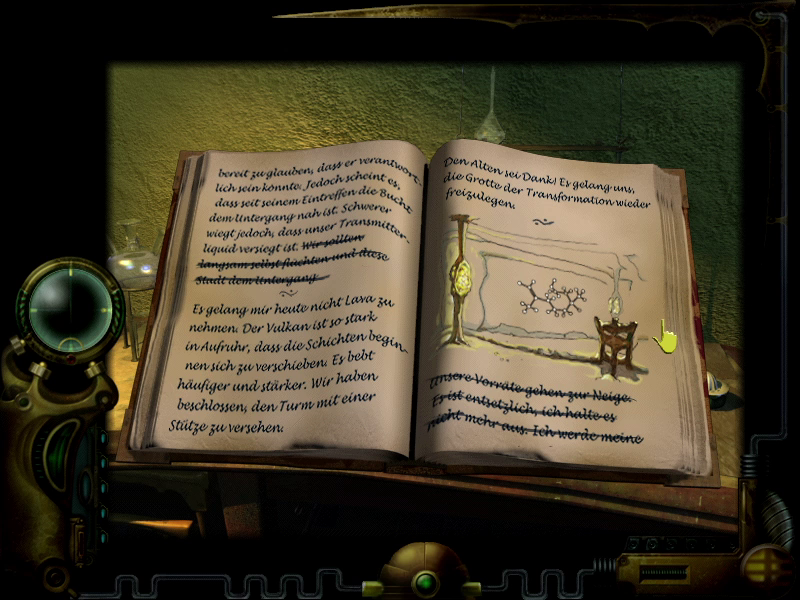 Loïc! If you were here, you could see the efforts we are taking to save our home. Our supplies are almost gone. The fields, Loïc, the field on which we harvested. The plots are lying fallow and the sea is silent. I decided to split up the order - some should preserve the tower and build the support. With the others I will continue to do research to find out about this apparition. Were we too sure? Too long we have hoped that the wisdom of the ancestors would be our salvation. When they settled in the bay, they used the violent energy of the volcano. Could anybody have predicted that this source of energy would be our demise because of its lava and its quakes? The books of the ancients don't give any hints, but this apparition cannot be supernatural. This interloper has to have something to do with our demise. He must be from another here, pages are missing or text is obscured by a blueprint lying in the book 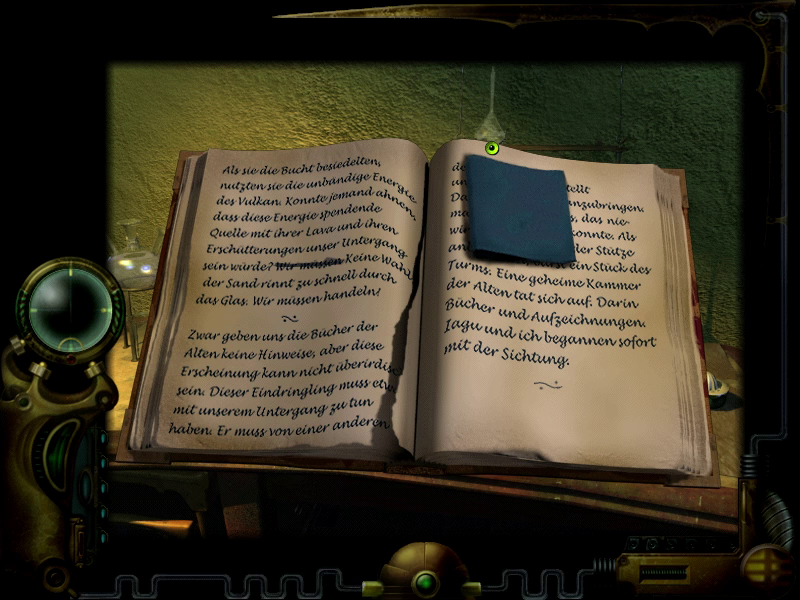 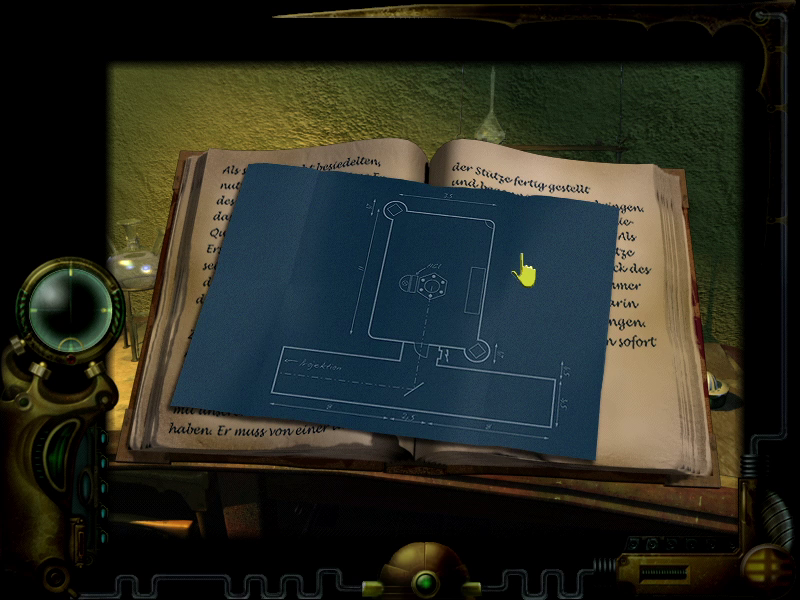 a piece of the tower. A secret chamber of the ancients opened up. Books and records inside. Iagu and I immediately started with cataloguing. Finally! We found knowledge that was closed off to us. A kind of ornament in a distinctive shape. 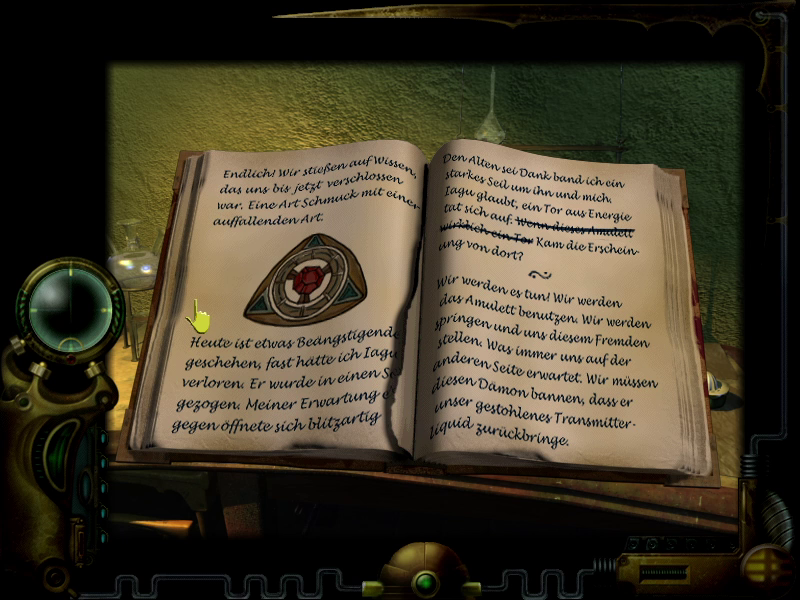 Something crazy has happened, I almost lost Iagu. He was dragged into a lake. Against my expectations, (???) opened up instantly. Thank the ancients, I tied a strong rope around him and myself. Iagu believes that a gateway of energy opened up. We will do it! We will use the amulet. We will jump and confront this stranger. Whatever may wait for us on the other side. We need to banish this demon, so he will bring back our stolen transmitter liquid. That's the only way to save the city from its demise. May the ancients be with us! We will make it! We have to! We don't have a choice. Loïc - I'm afraid Phew. So, to sum up, this was written by a person who is on the council of a place that's apparently doomed to natural disasters because they ran out of something called "transmitter liquid", so most people are fleeing. There's a weird apparition going around that might or might not be a demon and that might or might not have stolen this liquid. Also, they found an amulet that can be used to jump through a gateway of energy, and they think they can use that to banish that demon. Now, let's get back to our regular content and use the now clean key on the safe.    This time, it works. We take out the amulet (which Richard mentioned, but also was drawn in the book. Interesting)... Lost: Clean Security Key  empty sheet of paper with light scent of lemons ...and a sheet of paper. The lemon scent might give it away if you've played around with secret inks as a kid. We simply need to heat the sheet of paper to reveal the message. Picked up: Empty sheet of paper with light scent of lemons  hot plate Fortunately, there's a convenient hot plate on the desk.   It's blue! It is the number <<five>> and not the pentagon. Lost: Empty sheet of paper with light scent of lemons Alright, so, believe it or not, you now have all the clues and all the necessary items to solve the puzzle of this basement. So, as a warm-up, why don't you try to figure this one out? If you haven't looked at the videos, one of them contains a small clue (that should not be necessary) To remind you, this is our inventory right now: 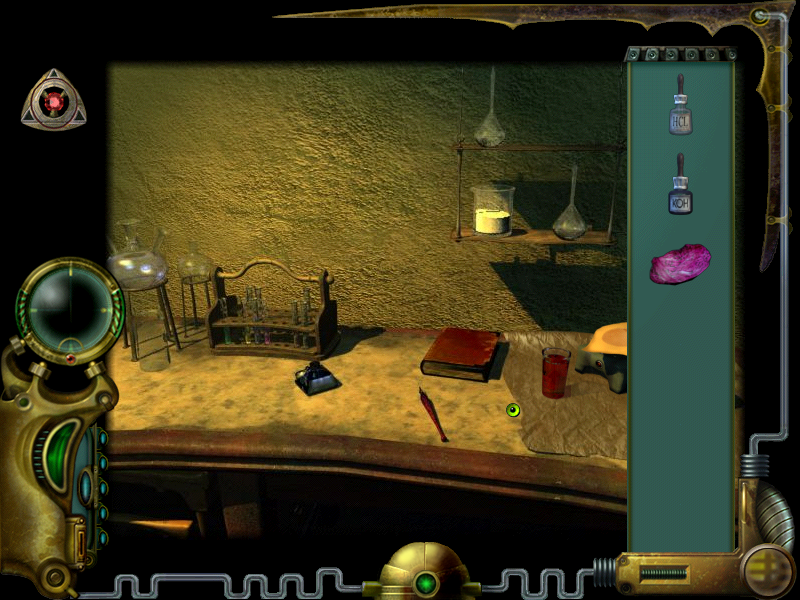 Inventory: Piece of red cabbage. Potassium Hydroxide solution. (KOH). Hydrochloric Acid (HCl). Interactables: Pot of boiling water Hot plate pH tank Buttons on device next to pH tank Beaker with Cola Maki fucked around with this message at 16:49 on Jul 4, 2023 |
|
|
|
What an extraordinary concept for a game. Myst but actually educational (or at least, aspirations to that). Good luck with the translations.
|
|
|
|
One big difference to Myst is that Myst never had an inventory, which lends its puzzles a certain elegance. This one is a "rub thing on thing"-jamboree, particularly later when you start to lug around half a chemistry lab in, presumably, your pants.
Maki fucked around with this message at 12:14 on Jul 4, 2023 |
|
|
|
Well it’s definitely a pH based puzzle. As a stylistic/readability thing do you think you could bold the items that we pick up. Then when there’s a puzzle for the readers give a list of held items and what interactable objects there are? Inventory: Piece of red cabbage. Used as an indicator. Potassium Hydroxide solution. (KOH). Basic. Hydrocloric Acid (HCl). Acidic. Amulet Environment: Set of PH beakers Pot of boiling water Hot plate Basin with tap (i.e fresh water) Clues: Note that reads: “ violet It's blue! yellow It is the number <<five>> and not the pentagon.” —————————— Anyway for this puzzle you can make a pH indicator solution by boiling cabbage. That solution should turn blue when at about pH 8 or so, so add Potassium Hydroxide until that happens. Then I dunno pour it on the amulet or something. Not sure what the number five is referring to.
|
|
|
|
Thanks for the suggestion, Elite! I have amended the post accordingly. The amulet doesn't count as a held item but has a special slot in the HUD, so I've left it out. Regarding the clues and the environment, this is going to be a lot harder going forward, as clues will be spread out through the world and which parts are relevant and which aren't is part of the puzzling, so I don't think I'll be able to keep track of those without giving too much away. I'll see what I can do.
|
|
|
|
I found sort of a translation for KOH solution: potash lye. Not sure if it's in common use though.
|
|
|
|
Yeah, we want to create a basic solution with the cabbage and the caustic potash.
|
|
|
|
Looks extremely dark, I can barely make out the content of the images. Good old brown era of gaming graphics, I guess. Can you maybe brighten up the images?
|
|
|
|
Maki posted:Potassium hydroxide dissolved in water (I guess English doesn't have a word for that?) Aqueous is a term for dissolved in water. So you could call it aqueous potassium hydroxide.
|
|
|
|
Or potassium hydroxide solution.
|
|
|
|
Oh hey we got these (I'm like 99% sure it's the same company that makes them) translated over here in Italy and they gave out the biology themed adventure game along with an issue of a pop-science magazine. The original german name was Bioscopia I think. It was pretty cool. Puzzles eventually gave up on the biology angle and instead veered off into bullshit pixel hunts or went for moon logic angles, but for a while you were doing quizzes on dna, matching the nucleic bases' shapes together and the like. I really liked science, chemistry and biology above all, before my high school teacher ruined those for me, and I think I learned more about bio from that game than I ever did in her class. I'll follow this one for a hit of nostalgia, and cheers for the German school games!
|
|
|
|
Still laughing about nutzloser.
|
|
|
|
EssOEss posted:Looks extremely dark, I can barely make out the content of the images. Good old brown era of gaming graphics, I guess. Can you maybe brighten up the images? On my screens, it looks fine, to the point where I think brightening them would look weird. I think I have fairly bright screens though. Can somebody else weigh in on this? Meanwhile, I was going to post another update, like, a week ago, but real life happened right at my face and while everything's recorded and written, I still need to edit the images and cut gifs out the video. This would be the prime opportunity to brighten them up, if desired.
|
|
|
|
Some example brightening that brings it to more comfortable viewing for me:  Settings used in Paint.NET: 
|
|
|
|
mortons stork posted:Oh hey we got these (I'm like 99% sure it's the same company that makes them) translated over here in Italy and they gave out the biology themed adventure game along with an issue of a pop-science magazine. The original german name was Bioscopia I think. There is a Bioscopia, by the same developers, so yeah, I guess you're right on the money. I think this one also gets fairly moon logicy later, but it never really abandons the chemisty. Chemicus is the only one I've played, so this is interesting to hear. Maybe something to do in the future, though in that case I'd probably do the physics one first, biology never was my strong suit.
|
|
|
|
Update He - Give Me Warp Speed, Mr. Richard Okay, so we left off in the basement and I set you the task of solving this introductory puzzle with cabbage, acid and lye. Elite posted:Anyway for this puzzle you can make a pH indicator solution by boiling cabbage. That solution should turn blue when at about pH 8 or so, so add Potassium Hydroxide until that happens. And you found the chemistry part of the solution immediately, well done. The rest is less chemistry and more...clicking things until something happens. You'll see what I mean in a second. Before we do that, I want to quickly show off the lens from our interface though, since I forgot to do that when we picked up the chemicals near the desk. 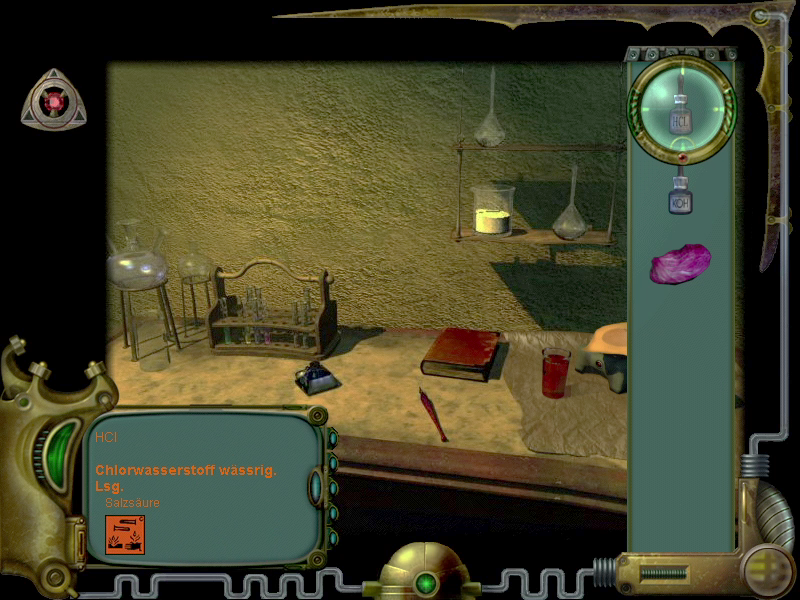 Hydrogen chloride in aqueous solution (hydrochloric acid) Fun fact, the German name for hydrochloric acid, "Salzsäure", literally means "salt acid", which has the same etymology as "muriatic acid", just more literal. 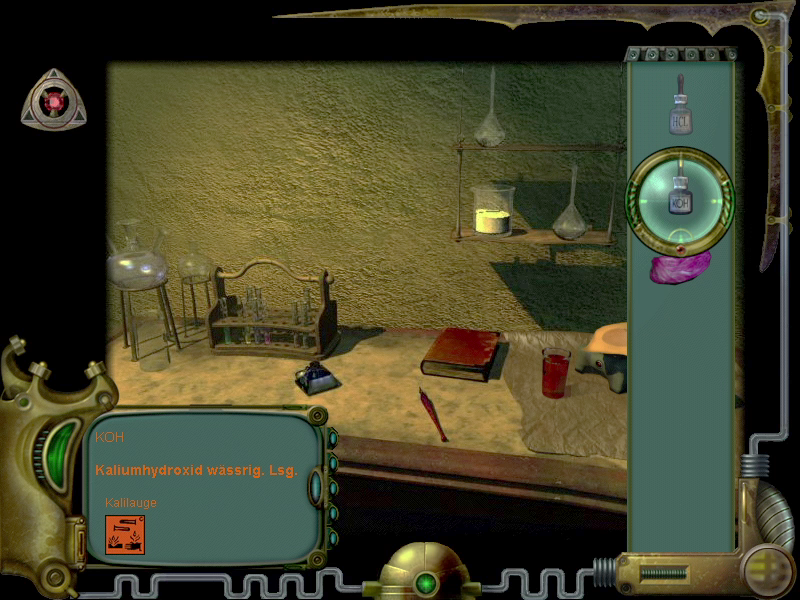 Potassium hydroxide in aqueous solution (potash lye) Potassium in German is "Kalium" and lye is "Lauge", hence, "Kalilauge".  Sadly, the lens doesn't show us anything cool about the cabbage. Anyway, let's go and do what you suggested. First, we walk to the stove, turn up the heat and put in the cabbage... 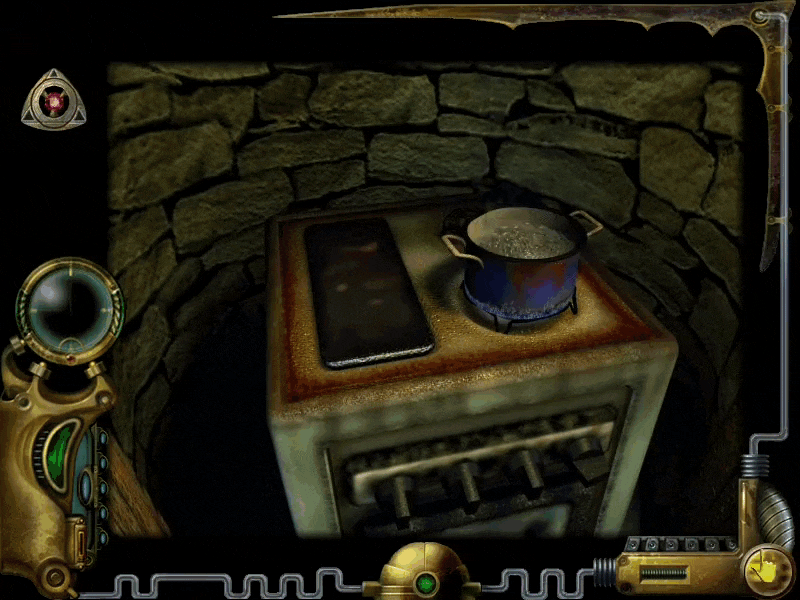 Pot with hot cabbage juice which colors the water in the pot. We can now take that water... 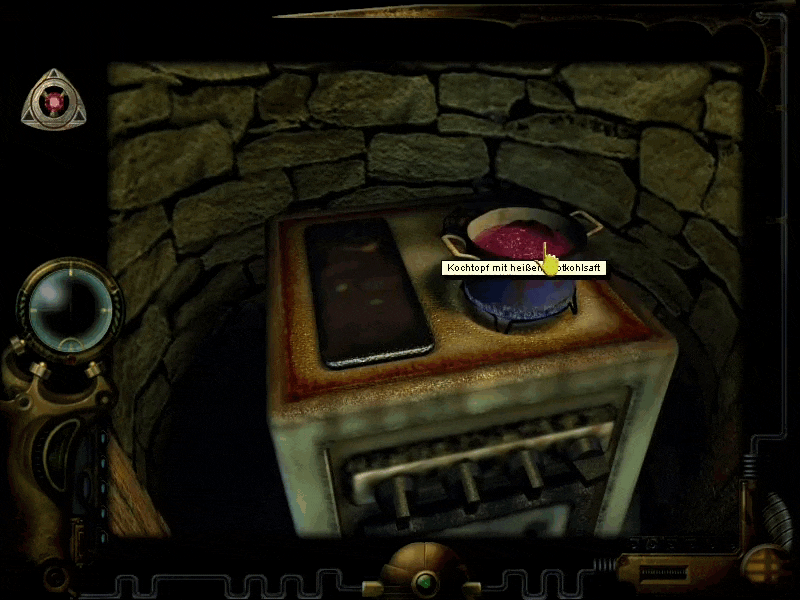 pH-indicator solution from red cabbage And get a solution that is capable of showing the pH of its surroundings by color And for this, the lens actually has something to say: 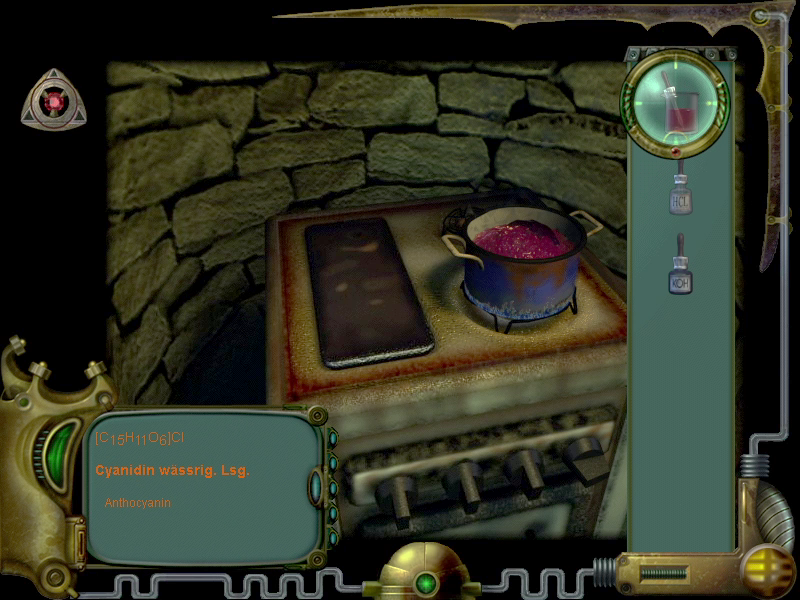 Cyanidin in aqueous solution Btw, don't ask where the beaker and pipette come from. I assume we were already walking around fully equipped. I guess Richard likes to throw chemistry puzzle parties on Saturdays and our silent protagonist likes to be prepared. Lost: red cabbage Picked up: pH-indicator solution Now, as you correctly suggested, we need to make this solution turn blue with the lye we picked up. What the game wants us to do now is to walk over to that contraption in the middle of the room.  I mentioned off-hand in the previous update that the tank on the left is labeled "tank with pH indicator". When we dump our indicator solution in there... Lost: pH-indicator solution 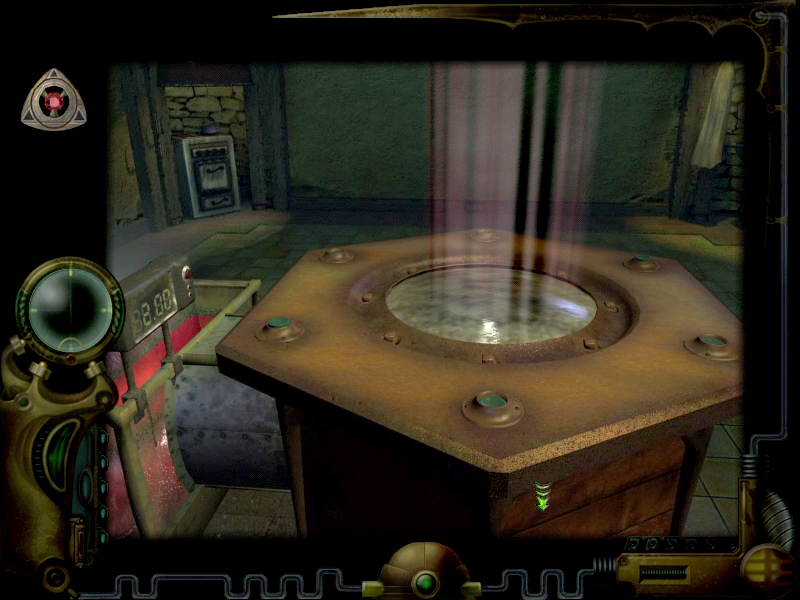 ...the whole thing becomes deep red, as does the light that is radiated through the room. To check, I walk over to the scanline pattern on the wall... 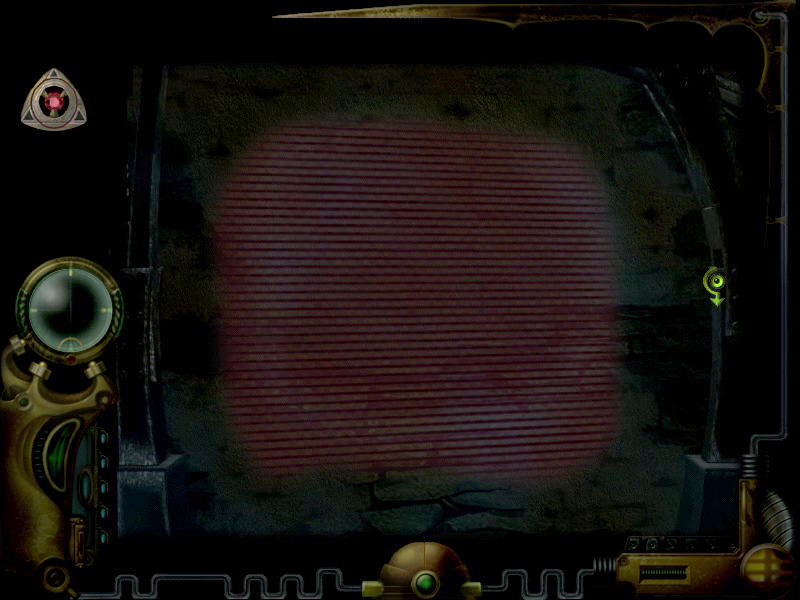 ...and confirm that it, too, has turned red. The other component that influences what happens on that wall is the six buttons here. They don't do anything as long as there's no indicator in the tank, but now, if I depress four of the small buttons around the projector in the lab room... 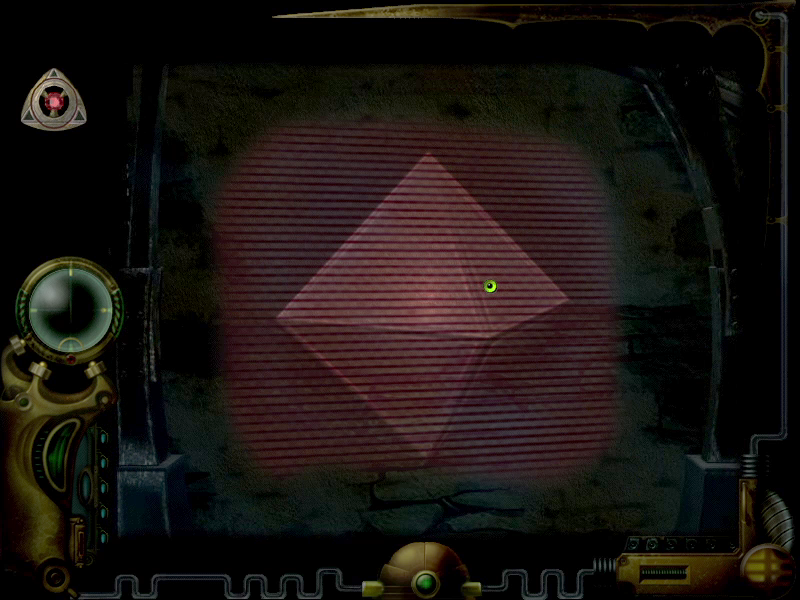 ...we get an octagon on the wall. If I depress an additional button...  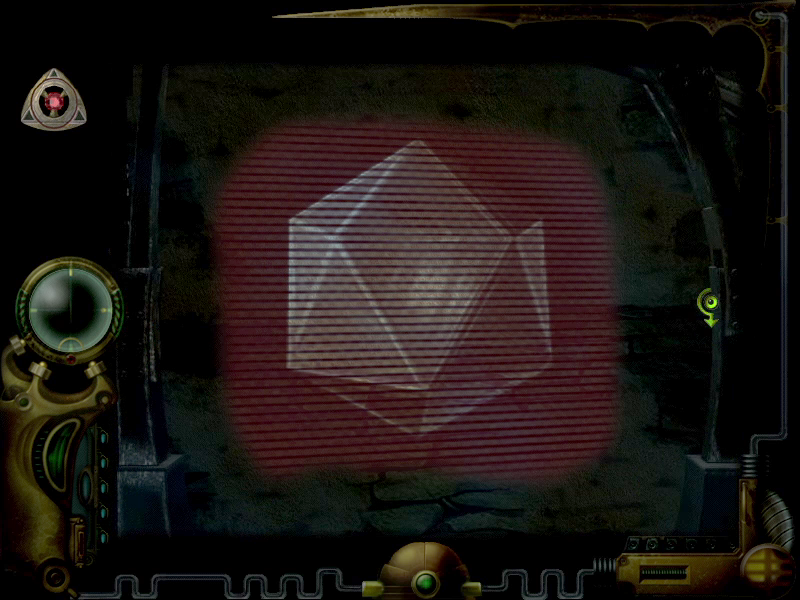 ...we get a dodecahedron from farther away, but an icosahedron from close up. I genuinely don't know if that's intentional or an oversight. Anyway, we're pretty clear on blue as our desired color, so I dump in two squirts of lye into the basin.  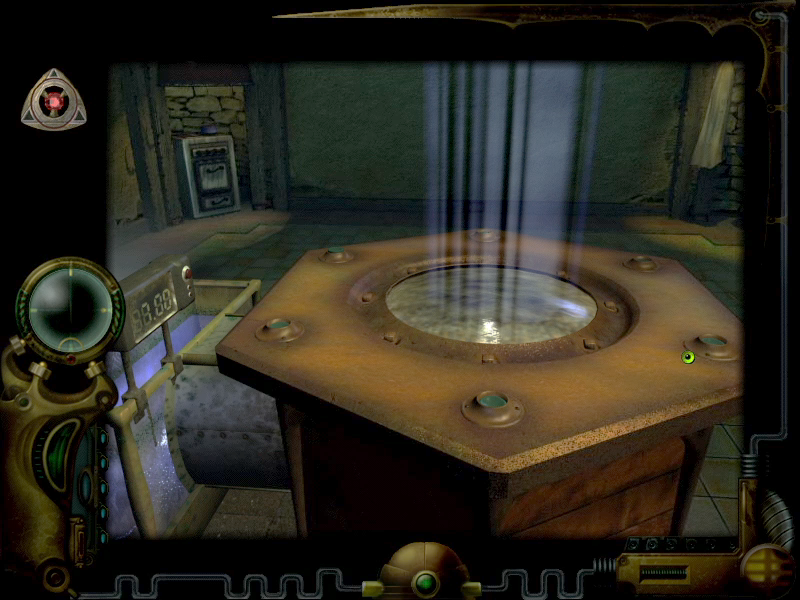 Now for the other part of the cryptic piece of paper. What the game means by "It is the number <<five>> and not the pentagon" simply appears to be "push down any five buttons on the device". I find that pretty out of left field, though I suppose with barely anything else to interact with, it isn't too unreasonable. We do just that...  ...and now, the projection has shifted into what appears to be a window with the amulet shape in front of it. Richard told us we can use it like a key if we correctly set the projector, so I move the amulet onto the projection... 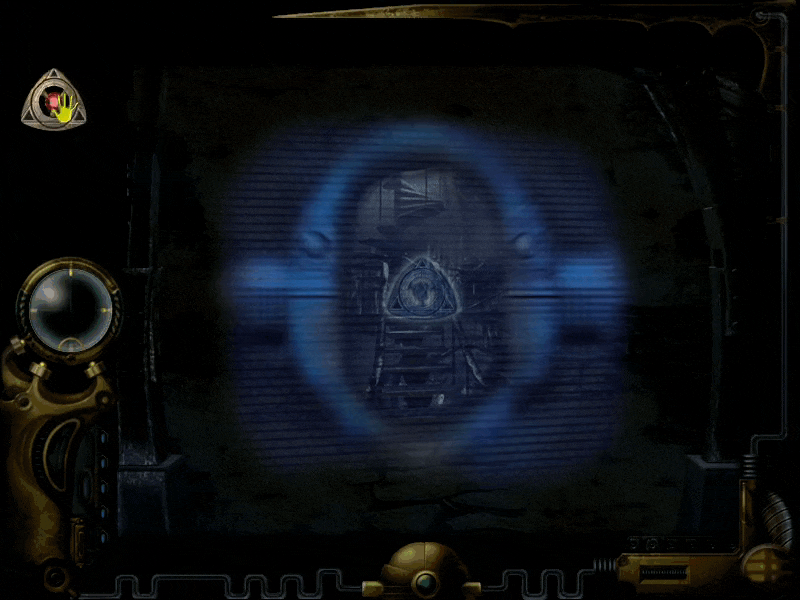 ...and we are pulled though. 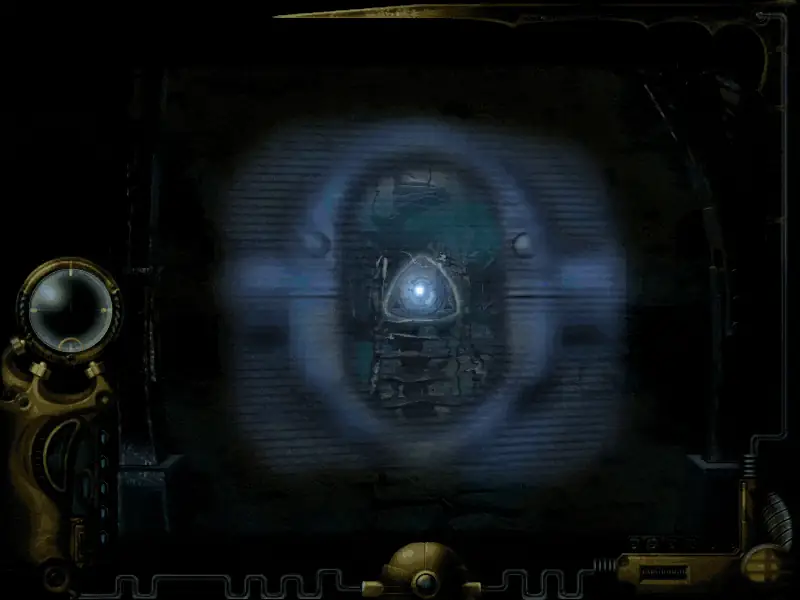 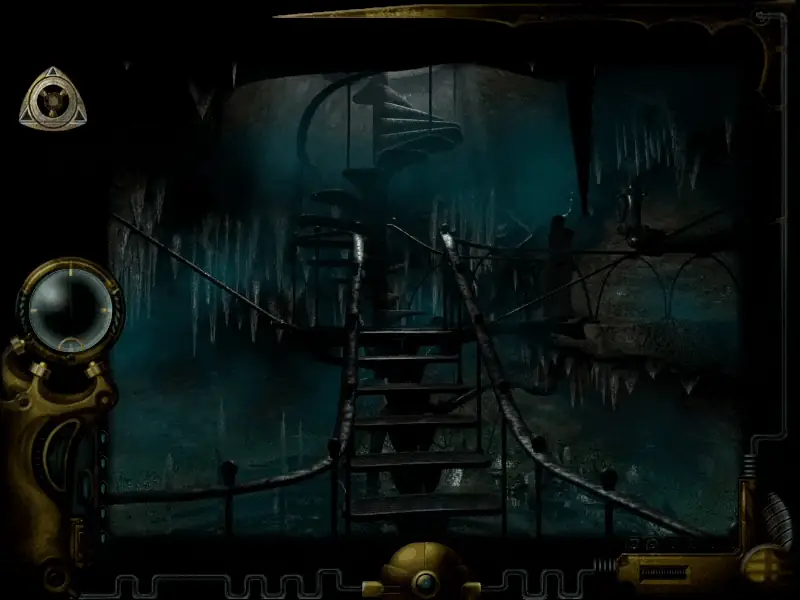 On the other side, we are treated to a small cutscene of a dude walking away. Either, he can't see us, or he just doesn't care. The game also uses this opportunity to wipe our inventory clean, so no easy access to an acid and a base until we find something else. Lost: potash lye, hydrochloric acid Anyway, we're standing in a small cave, directly in front of some electrical looking contraption. 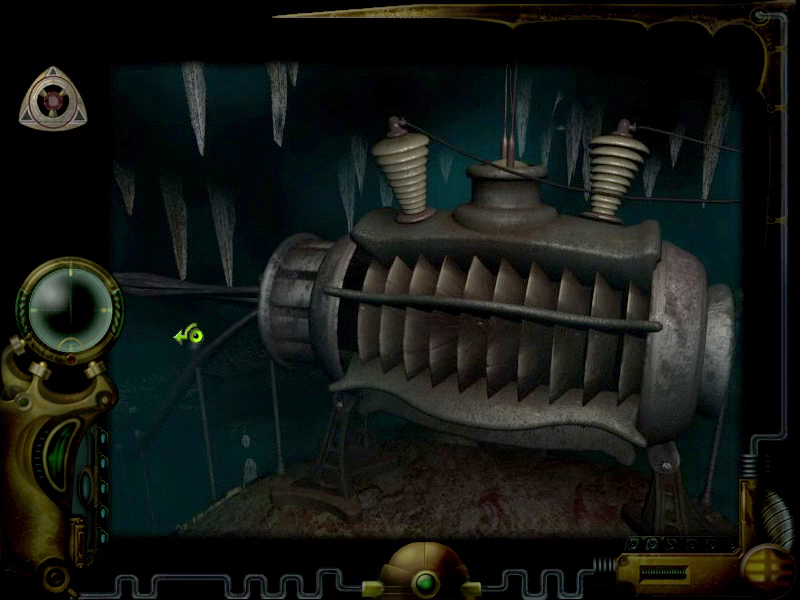 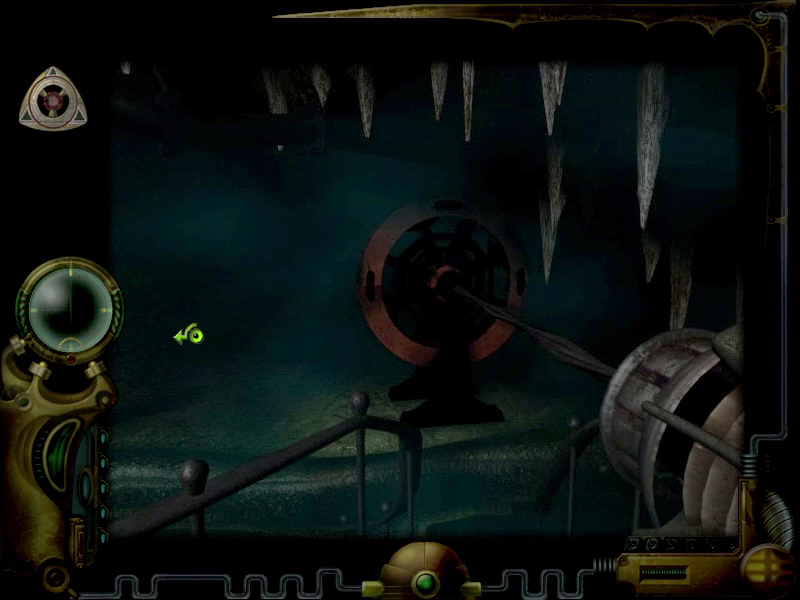 And it is in this shot that we see the first problem with navigation in this game. To me, it looks like there's an opening in the railing in front of us. However, there is nothing there, we cannot actually go down here. Now, in this spot, it doesn't matter too much, since it's easily checked and maybe takes three seconds until you know this is not a passageway. We shall soon see much worse examples. Up the starway is a platform... 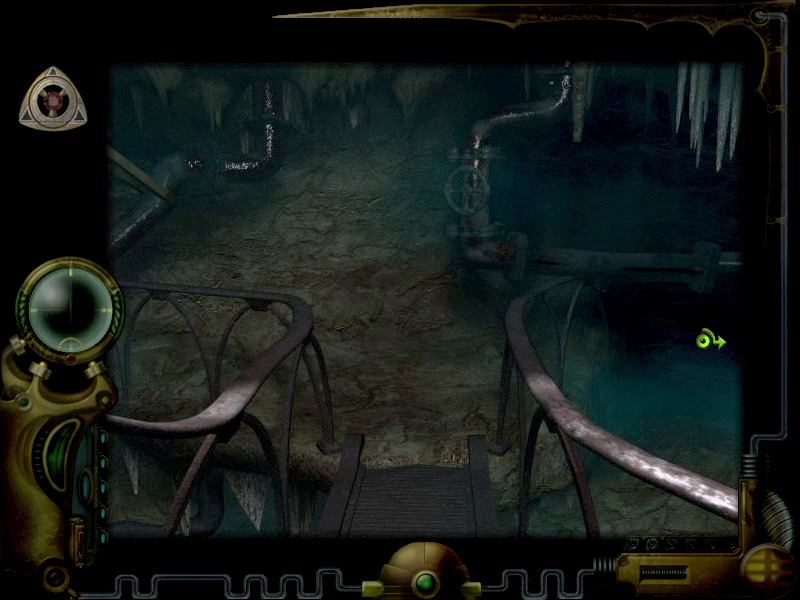 ...with a valve positioned nearby. I leave it alone for now and take the spiral staircase. 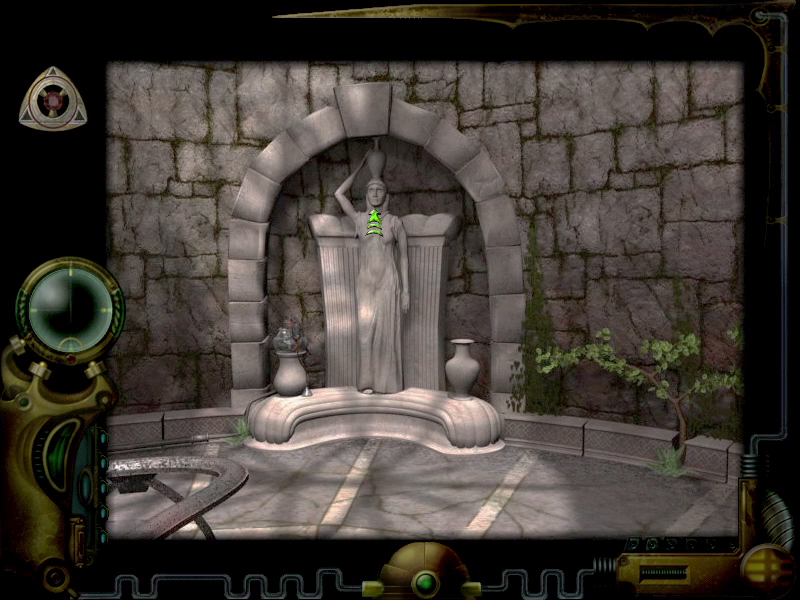 A statue with some contraption on its left. 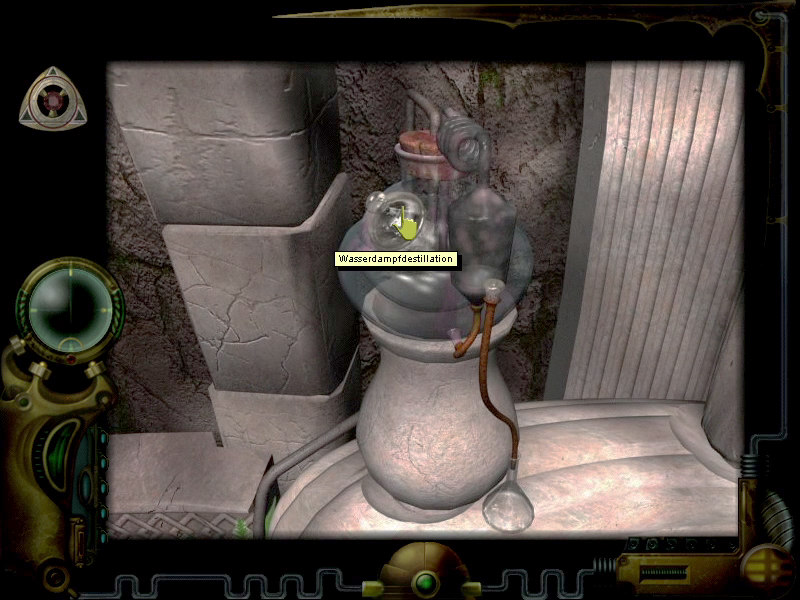 Steam distillation This is an inactive setup for steam distillation. We currently have nothing we could distill here anyways, but at some point, we will probably find something. 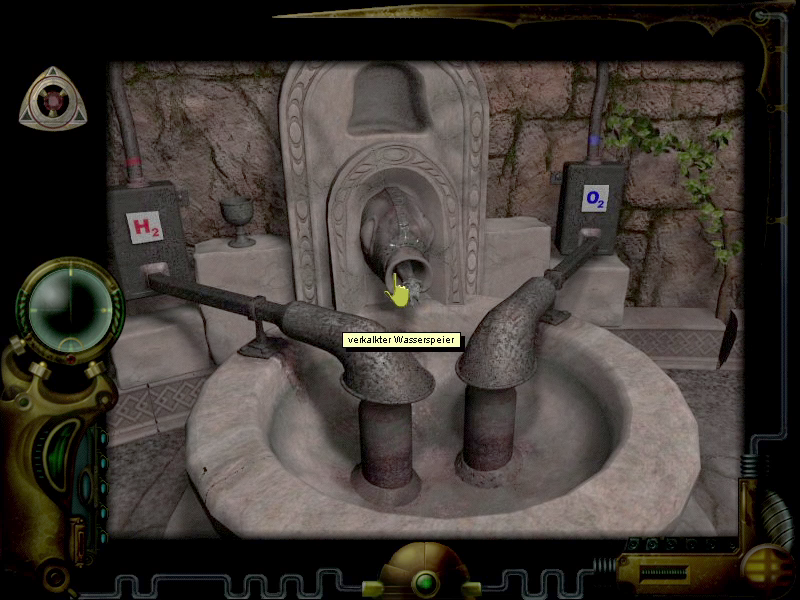 calcified gargoyle Since I'm not 100% clear on whether this translation makes sense: This is a figure that is meant to serve as a water source (in a fountain), but has had enough limescale build up that no water comes through anymore. 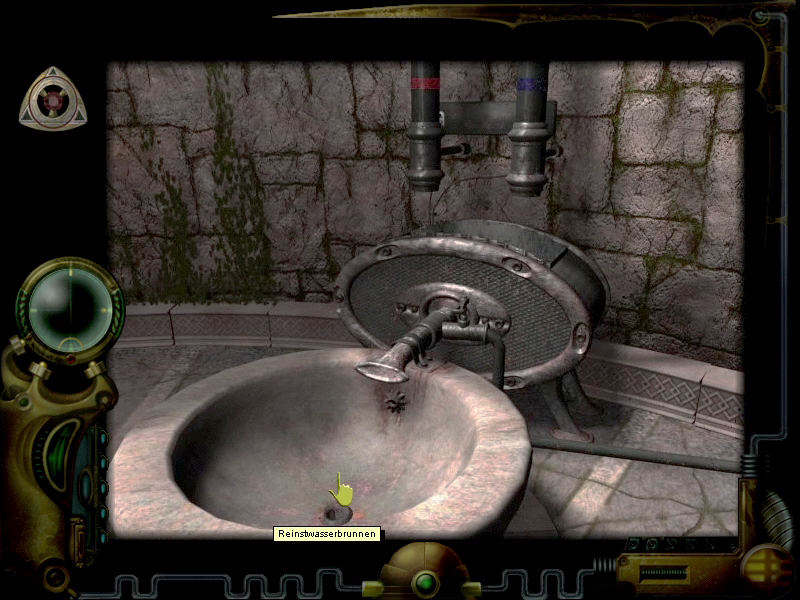 ultrapure water fountain This, apparently, is supposed to give us Ultrapure water. It does nothing, though, not even when I hit the valve on the right. 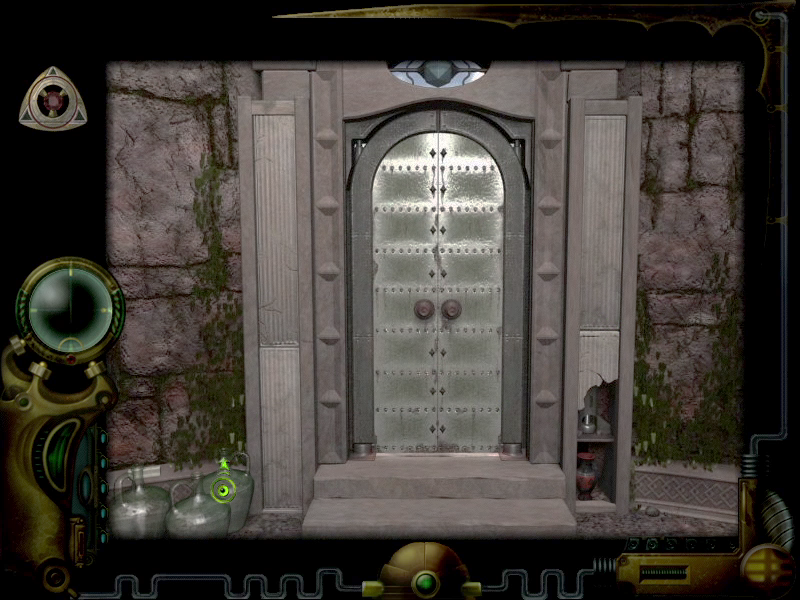 Finally, we have this door. There is some stuff on its left... 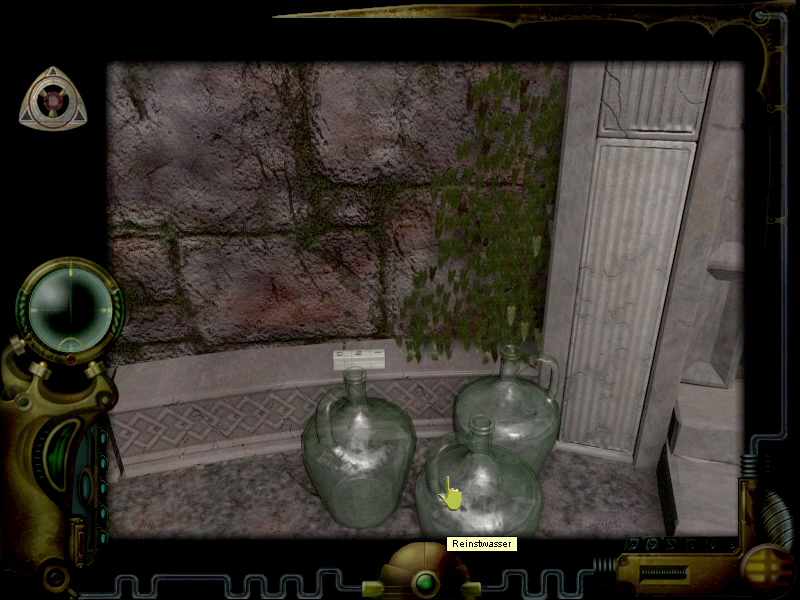 ultrapure water 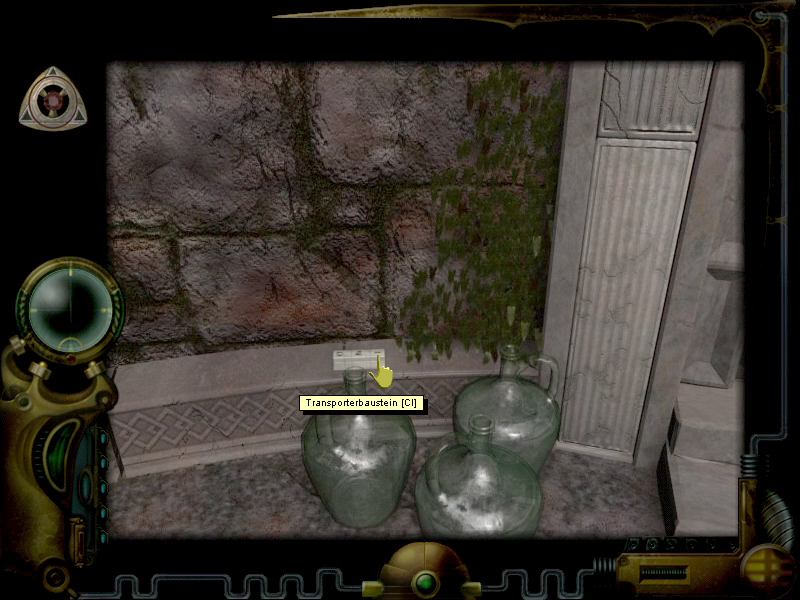 transporter block[Cl] ...which we take. Picked up: ultrapure water, transporter block [Cl] And when we open the door... 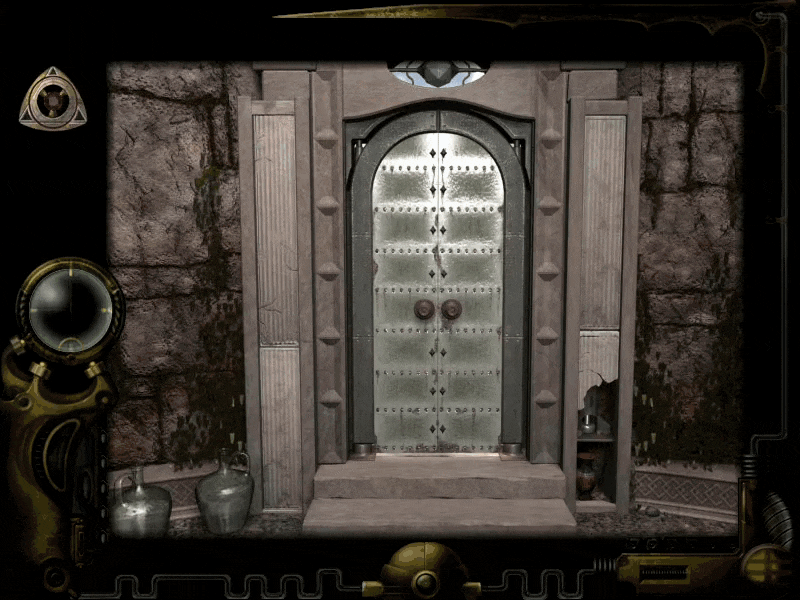 ...something moves (The black bar appears to be an artifact). We can actually zoom in onto that, and after a few seconds... 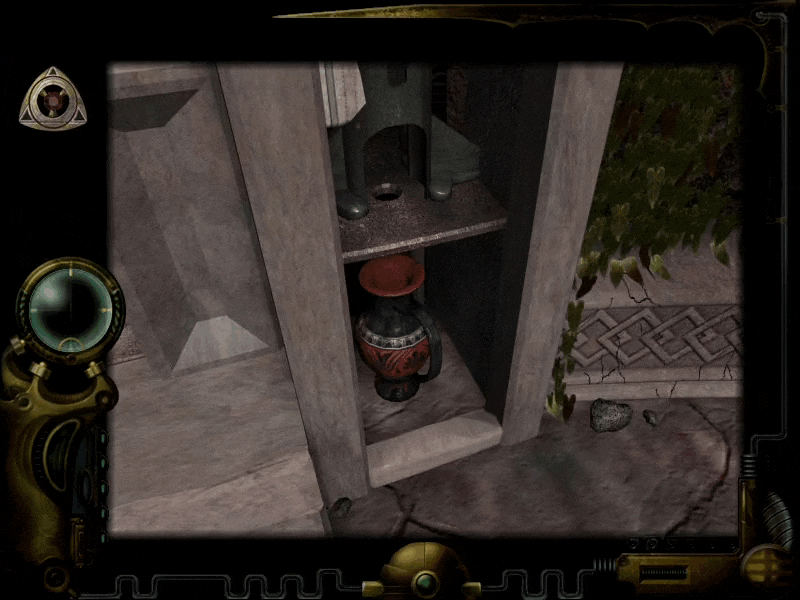 ...this metal rod moves down again. Before we head out the door though, let's see what that valve in the cave does. 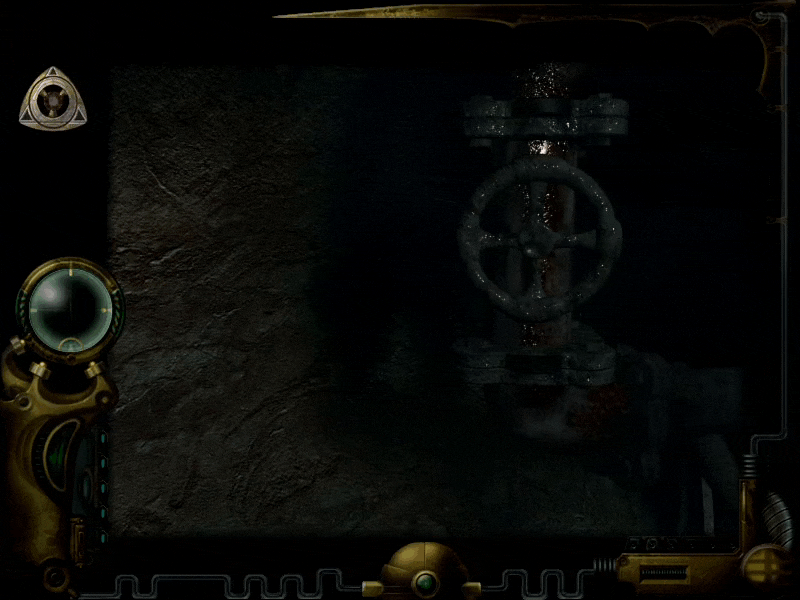 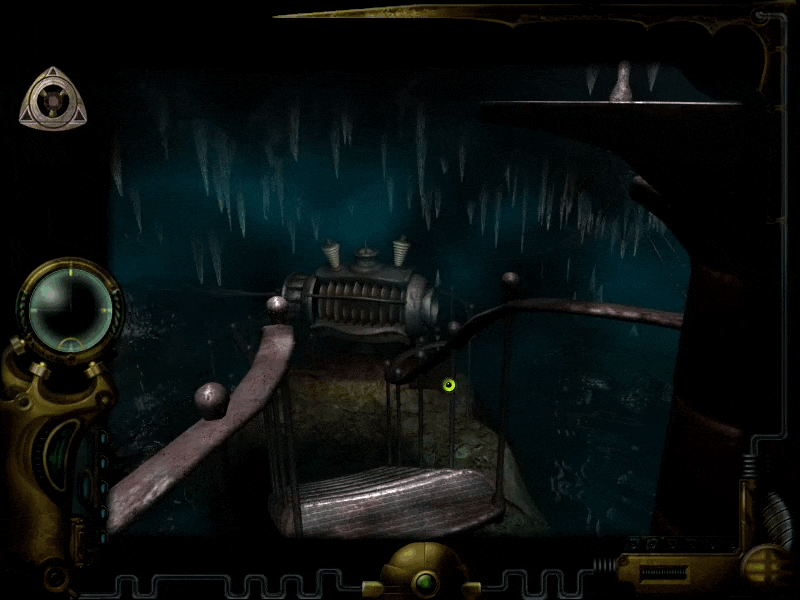 Turns out, it activates this turbine, generating electricity. 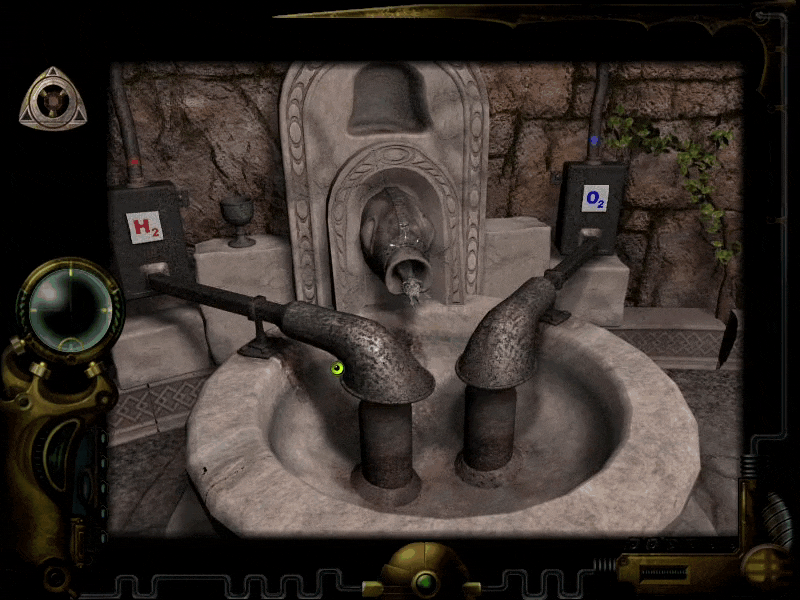 Now the basin with the gargoyle also is powered, the other basin is unaffected, though. That's all we can do in here for now, so let's head out the door.  Okay, so here is where navigation becomes...well, not harder, but certainly weirder. The route we can take is marked by this linear path, but this is the only way we can go. We cannot just wander off anywhere, because there is just no transitions for any other places. Sure, there has to be a certain suspension of disbelief to engage with a game, so we just have to take that we can only walk where the game developers put stuff, but I find this a bit jarring. Anyway, when I said that we'll see worse examples, this is not actually what I meant. 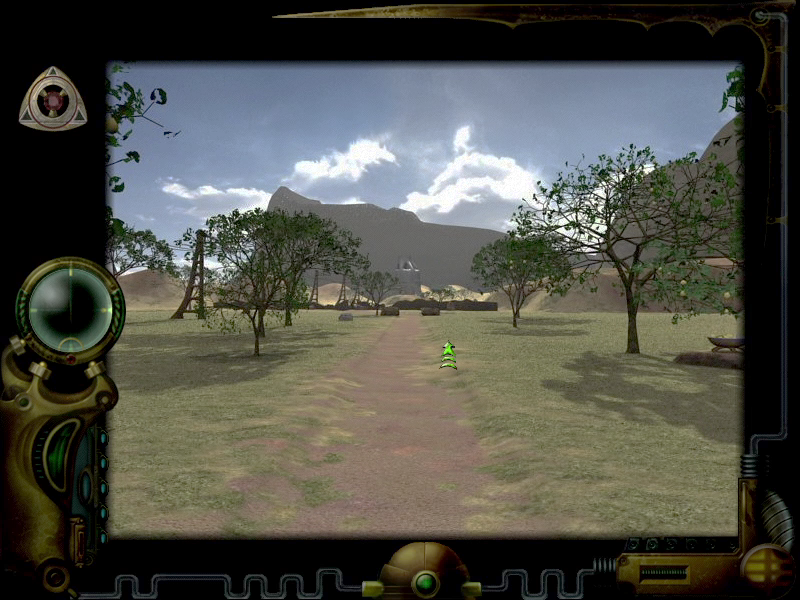 Note the bowl on the right side of that screen. If we walk down the road a bit, we can turn to the right... 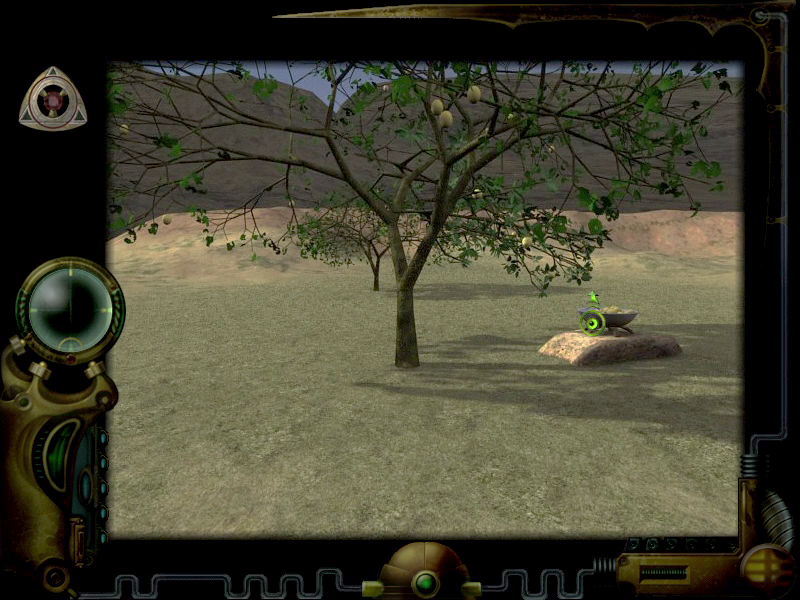 ...and here, and only here, we are allowed to leave the path... 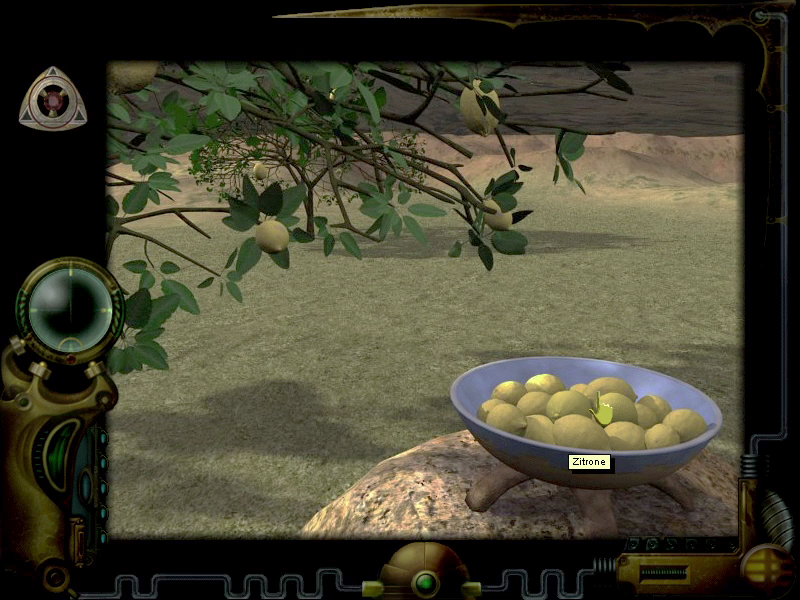 ...to grab another lemon. Picked up: lemon We then follow the path further to a gate 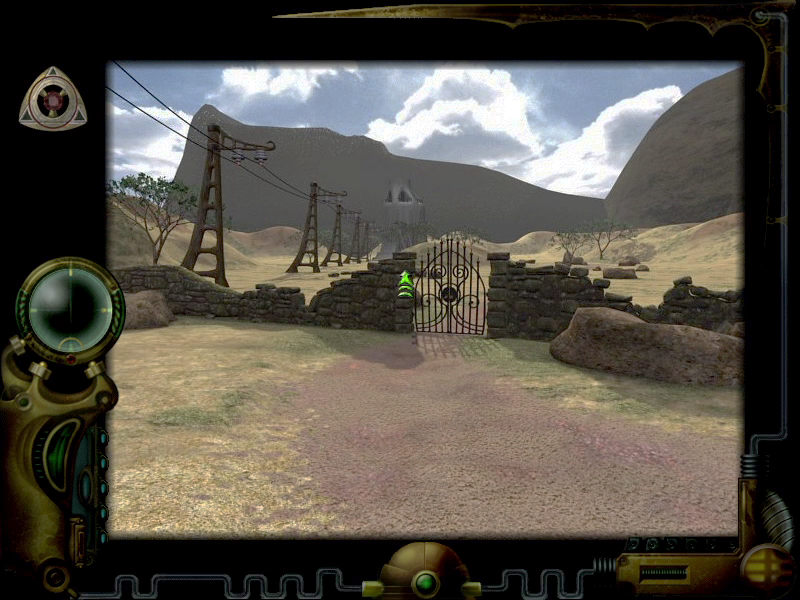 Thankfully, it's unlocked and we can progress to that building in the distance. 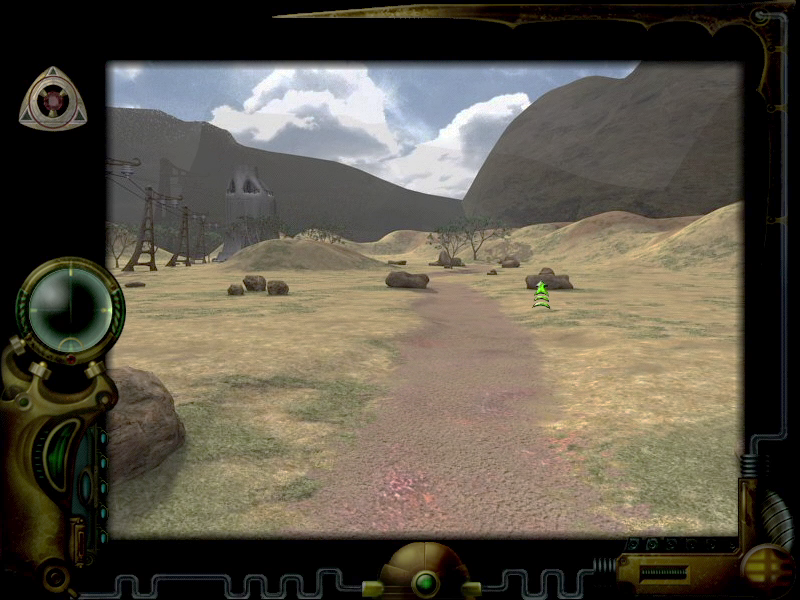 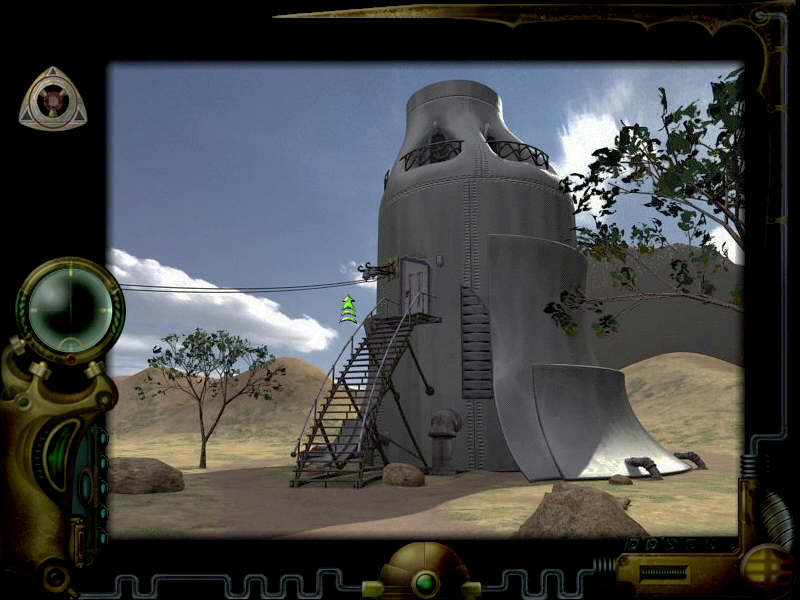 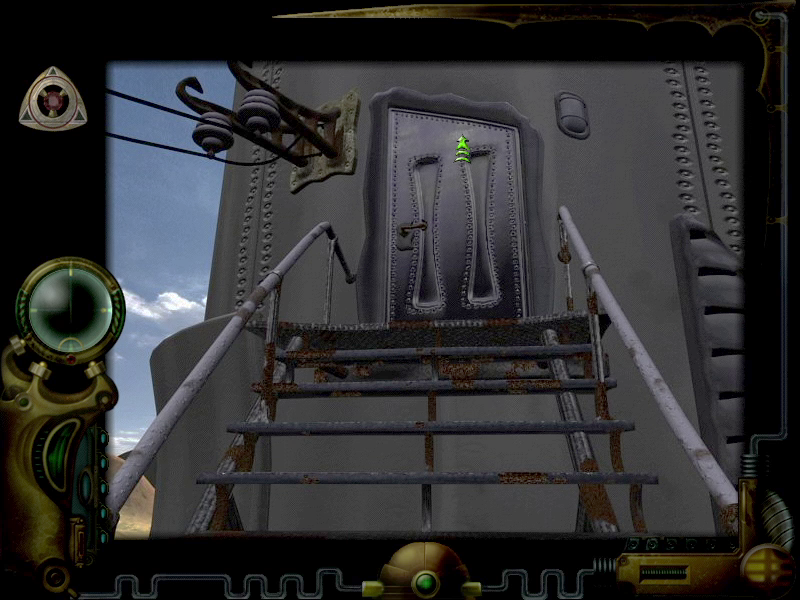 When we reach for the door, Richard contacts us. https://www.youtube.com/watch?v=jx1rhghIzOc 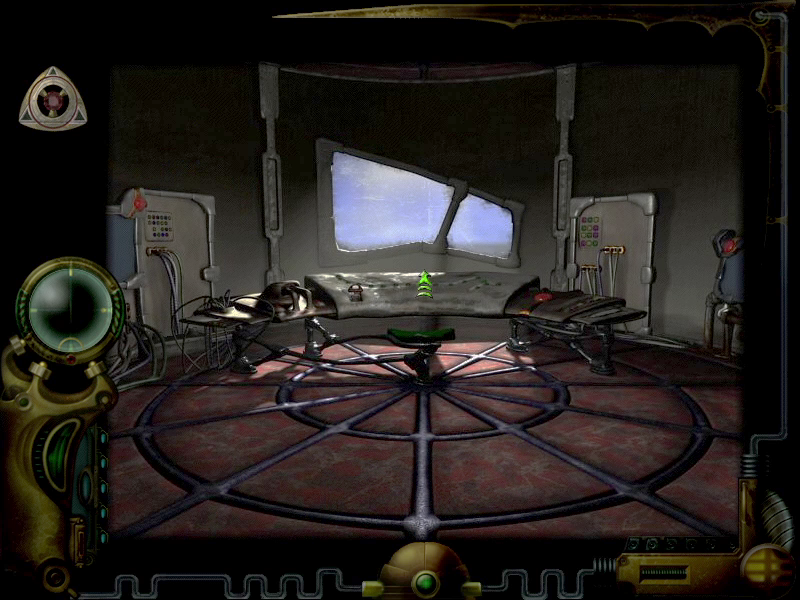 Inside the room, we find more strange machinery: 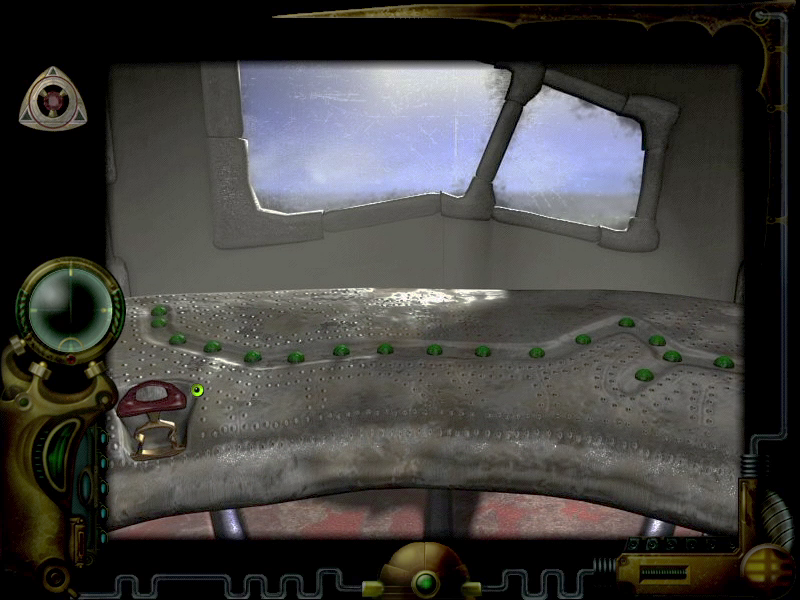 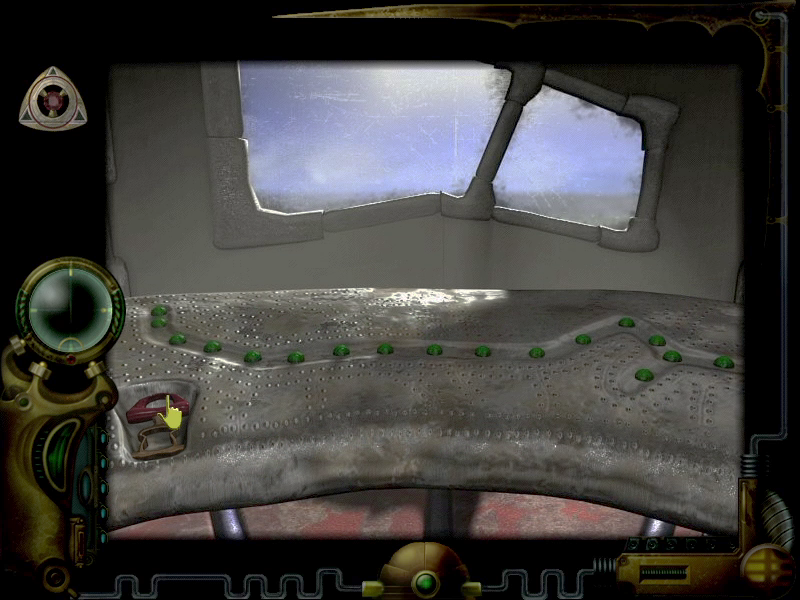 There is another useless switch here... 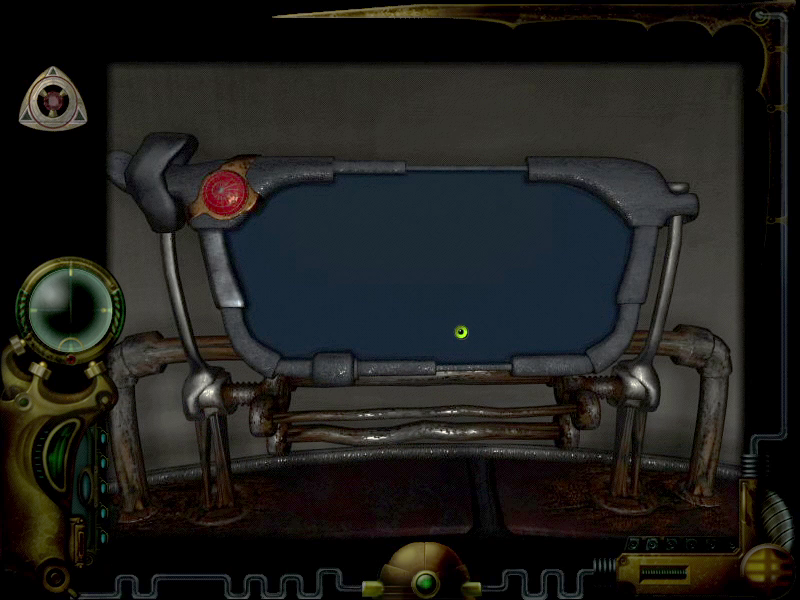 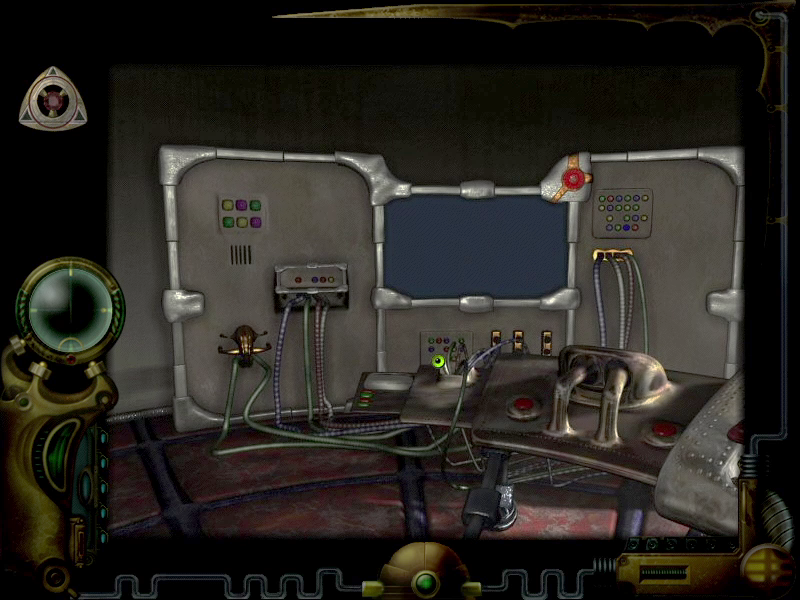 ...as well as what looks like empty screens. In front of the left screen though, we find things... 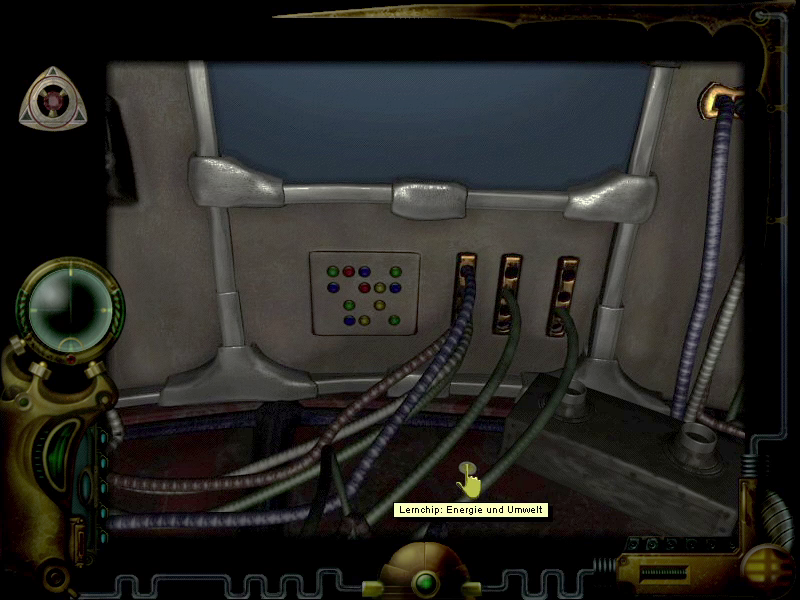 learning chip: Energy and environment Remember how I said that our builtin encyclopedia doesn't start with all of its entries unlocked? You unlock more of the entries by finding these chips around the world. I guess the idea is that if you need new knowledge, you find a chip containing it and related topics near the puzzle. The problem with this though is that the game marks in no way what info actually was in the last chip you picked up, so you either have to memorize what you already had to compare, or use the name of the chip to guess what was added. Since this whole thing was made in Macromedia QuickTime, I wouldn't be surprised if a feature to track these things would've actually been hard to develop. Anyway, you might not realise it (I certainly didn't and had to come back, even though I kinda remembered it had to be somewhere), but there's another pickup here 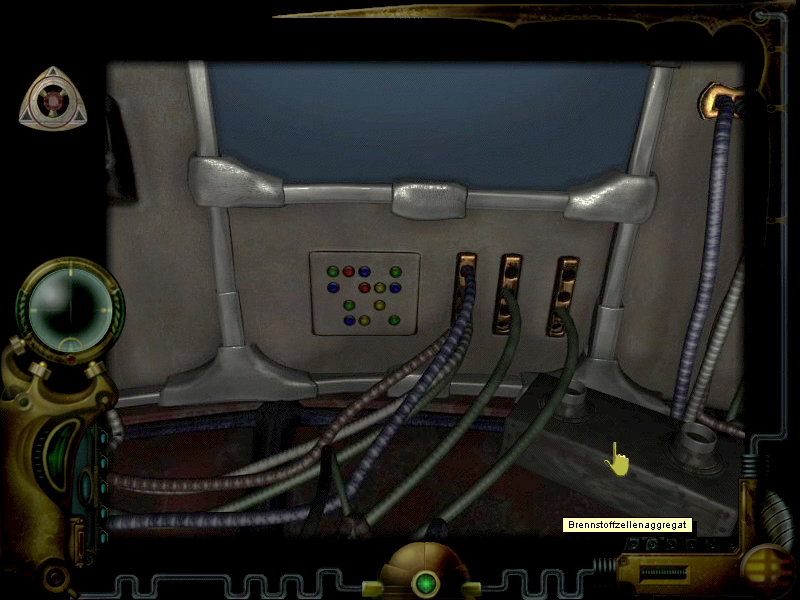 fuel cell A fuel cell! I wonder where that goes... Picked up: learning chip: Energy and environment, fuel cell 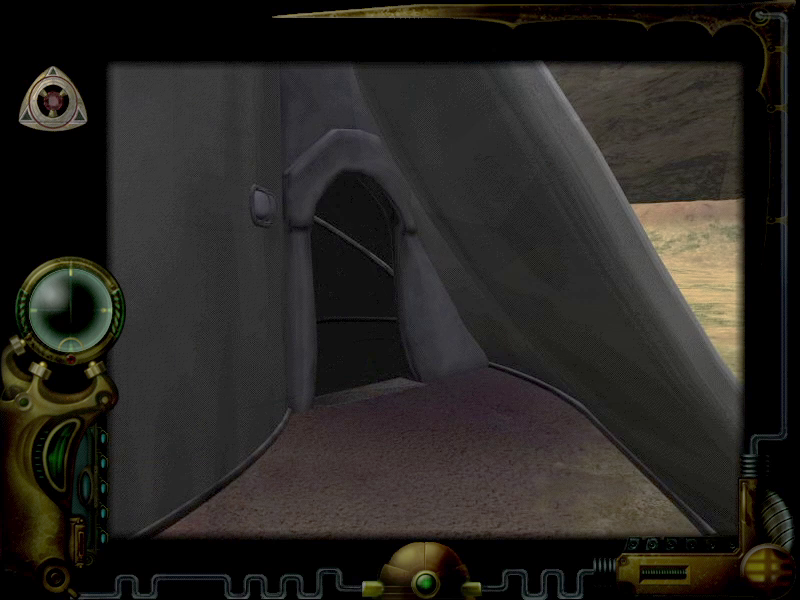 Anyway, I head back out. There actually is a second entrance into the building, though you'd be forgiven for not seeing it at first. This leads us to the basement, with more strange machinery that appears to be completely unresponsive. 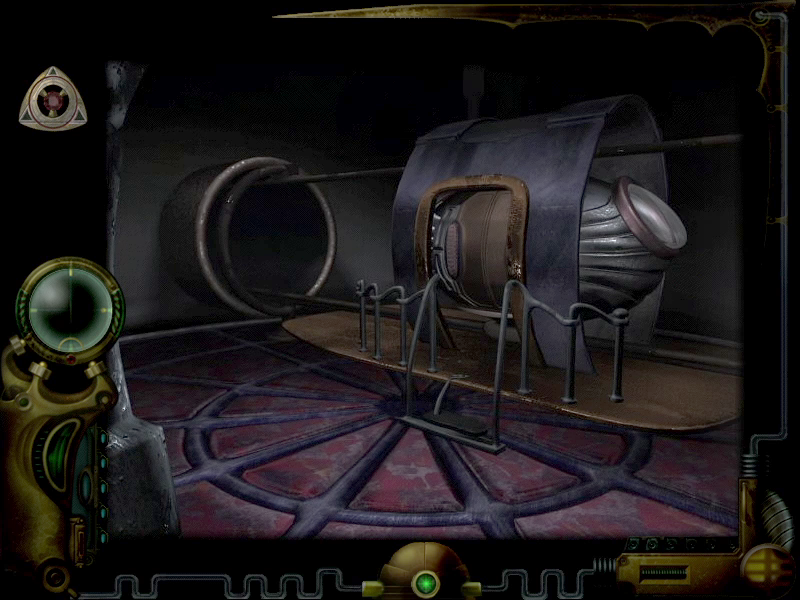 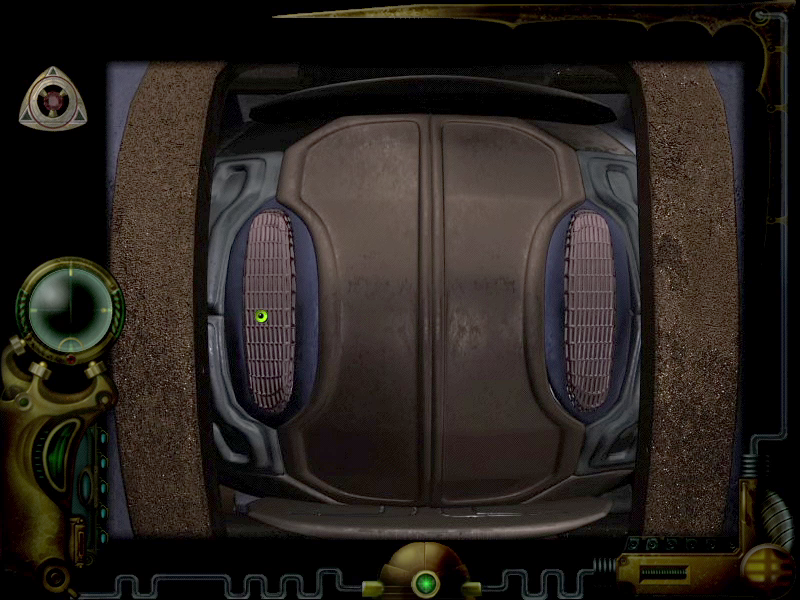 So, with our new pickups in tow, let's head back to the first building we were in. The first thing we need to do is to open the door, put a lemon in the mechanism, and use it to squeeze it. 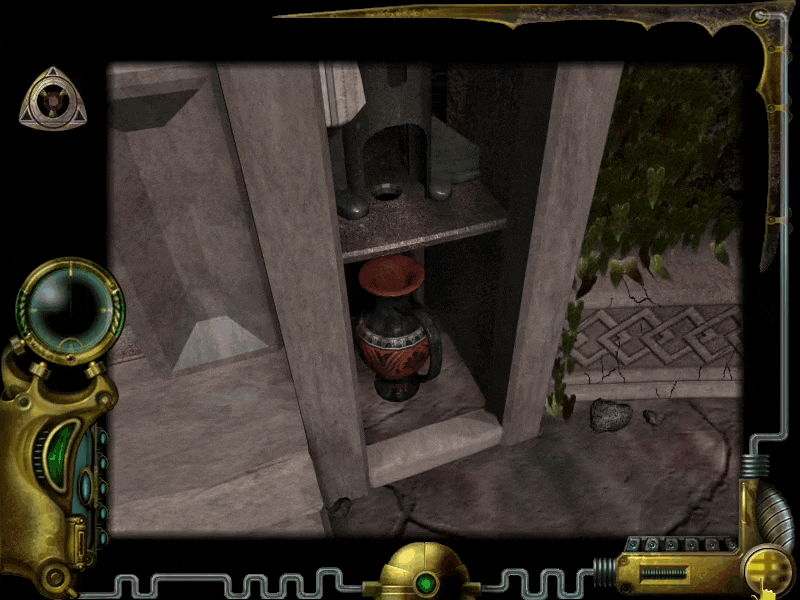 This puts fresh lemon juice into that amphora, which we promptly take. Lost: lemon Picked up: amphora with lemon juice And finally, we dissolve the limescale with the lemon juice we just made. 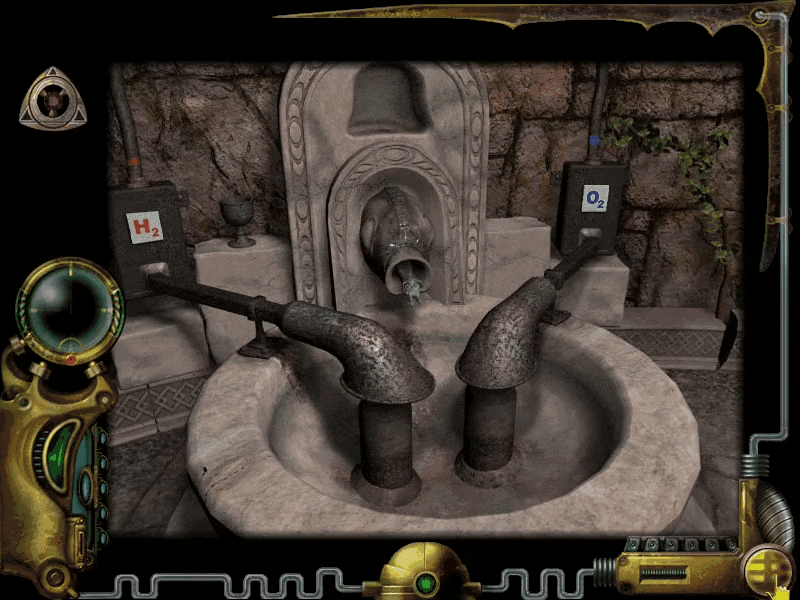 3 CaCO3 + 2 C6H8O7 → Ca3(C6H5O7)2 + 3 H2O + 3 CO2 The limescale (calcium carbonate) reacts with citric acid to form calcium citrate, carbon dioxide and water (alternatively, carbonic acid instead of the CO2 and the H2O, those are pretty much interchangable). The key point is that calcium citrate is more soluble in water that the calcium carbonate is, which is why this works. Now, this gargoyle spews water, which is electrolyzed into hydrogen and oxygen. 2 H2O → 2 H2 + O2 This reaction is endothermic, so it requires energy to happen, which the electricity provides 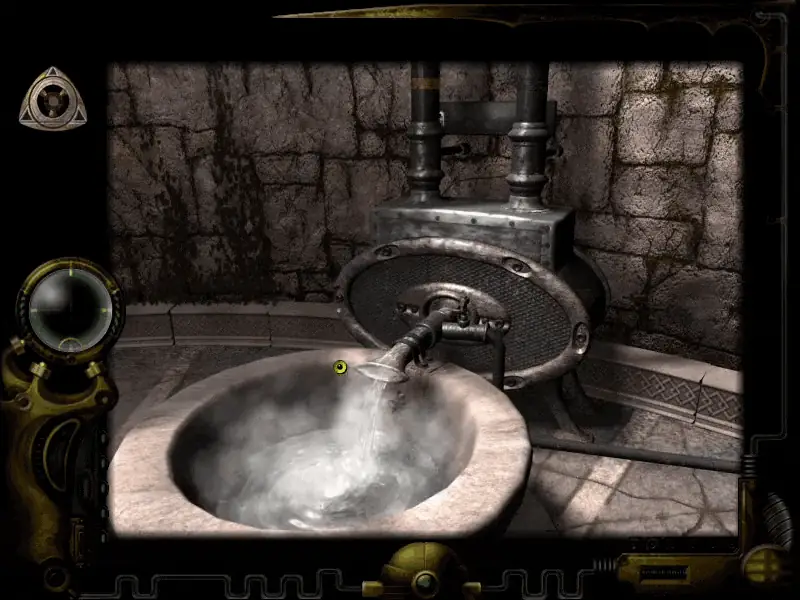 warm ultrapure water shut-off valve We also put the fuel cell in the slot specifically waiting for a fuel cell (is your brain melting from the hardcore puzzle action yet?) which activates the ultra pure water fountain. Lost: fuel cell 2 H2 + O2 → 2 H2O This reaction is the converse of the reaction up there, so it is exothermic, i.e. creates energy. This we can see from the water coming out steaming hot (even though the game just calls it warm) 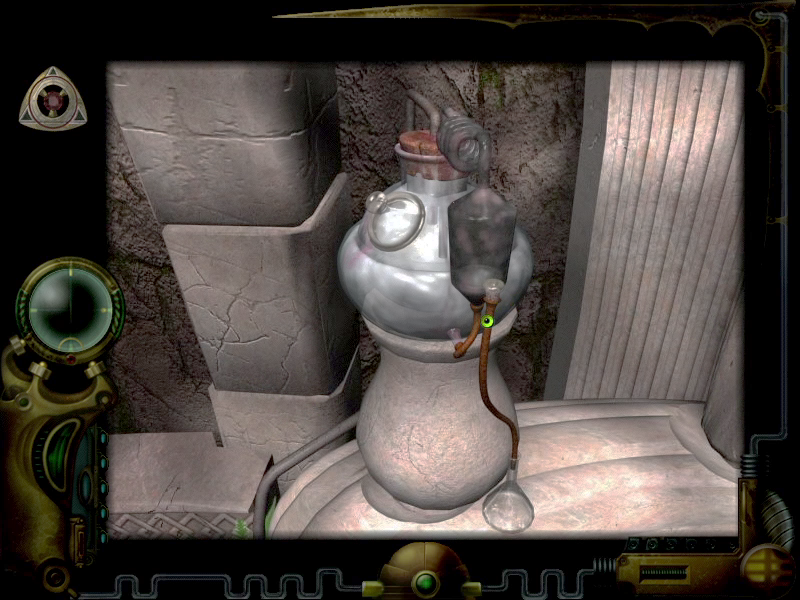 This has the effect that now, the steam distillation setup is working, though we still have nothing to distill. There is a secondary effect which I thought was very poorly telegraphed. If we go back to the second building, the power is now on, presumably from energy generated by the fuel cell. Why whoever built this place wouldn't just hook the building up to the power from the cave directly is beyond me. 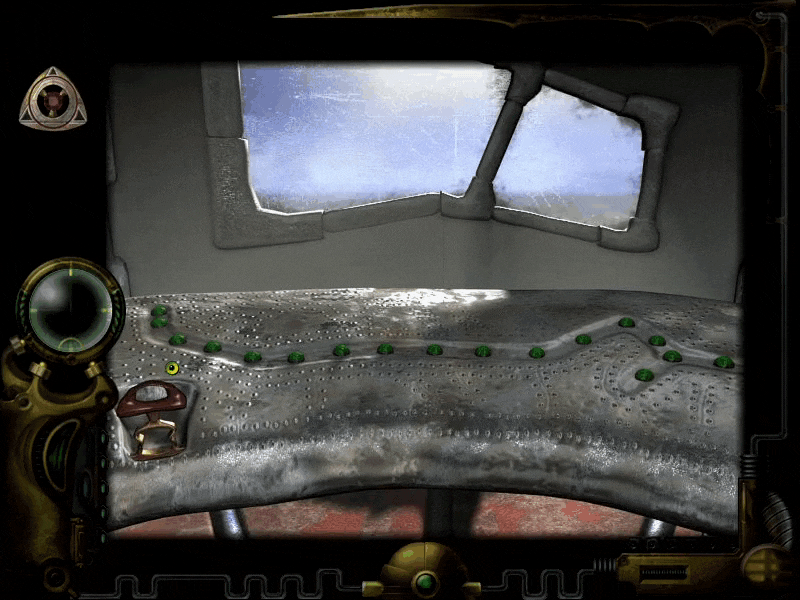 Anyway, the useless switch turns out to not be so useless after all. What specificially it does though remains to be seen. Furthermore, the screens now show data. 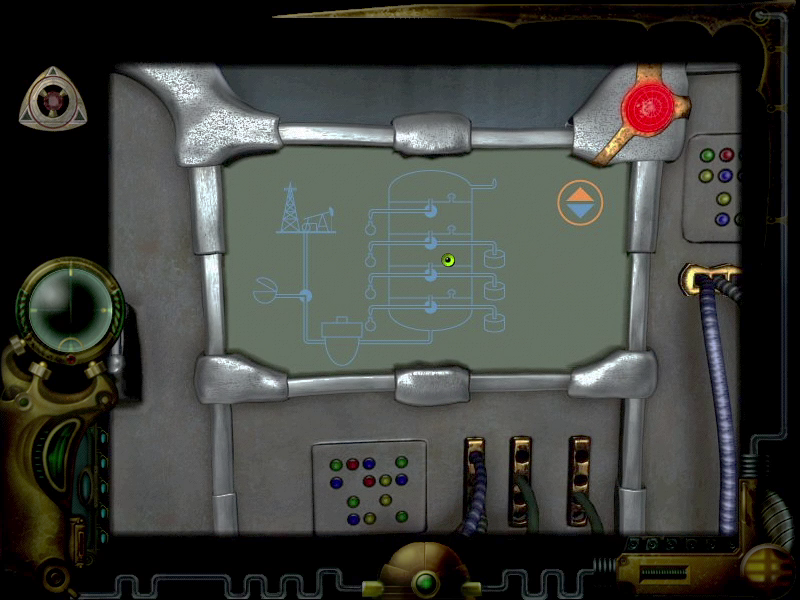 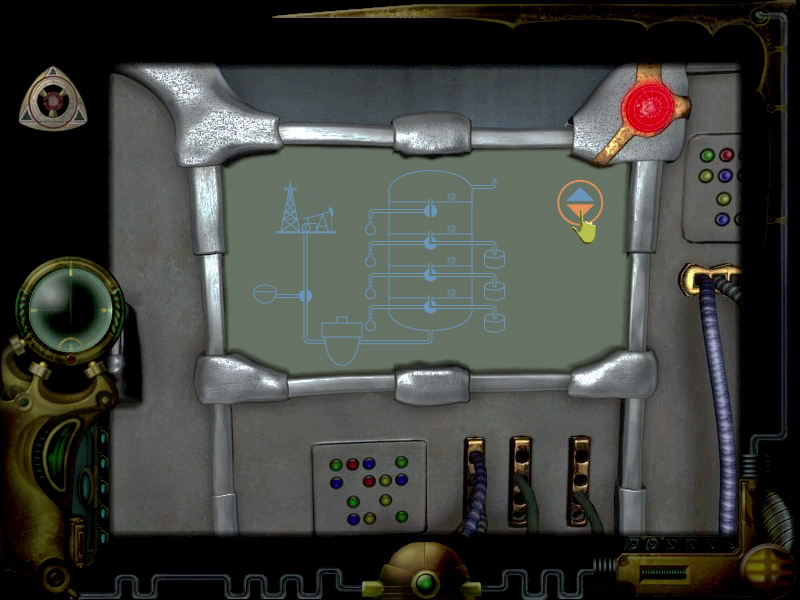 The left screen allows us to toggle between two states. 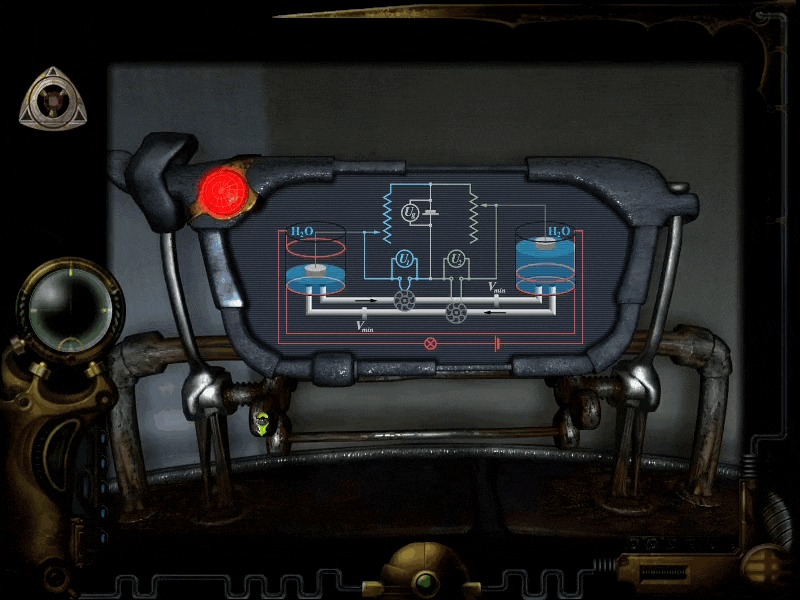 While the right screen has this thing rotating beneath it which changes the - tanks, I guess? - depicted on it. I opt to leave everything the way I found it and check out the basement again. 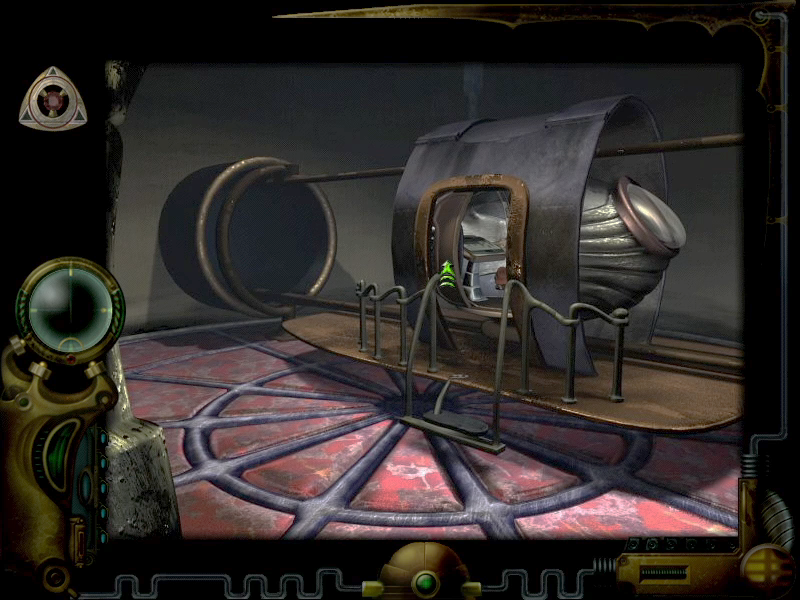  This time, the capsule here is open. I step inside..  ..and see a control pad based on the periodic table, with some holes though. The transporter block we found earlier fits in one of the empty spots, and with nothing better to do, I push it, which sets the transporter we are in into movement. 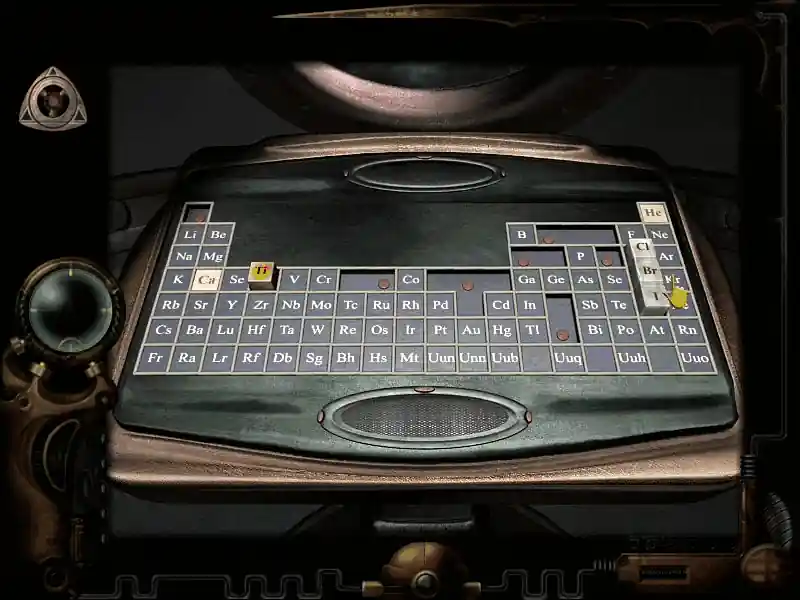 Lost: transporter block[Cl] 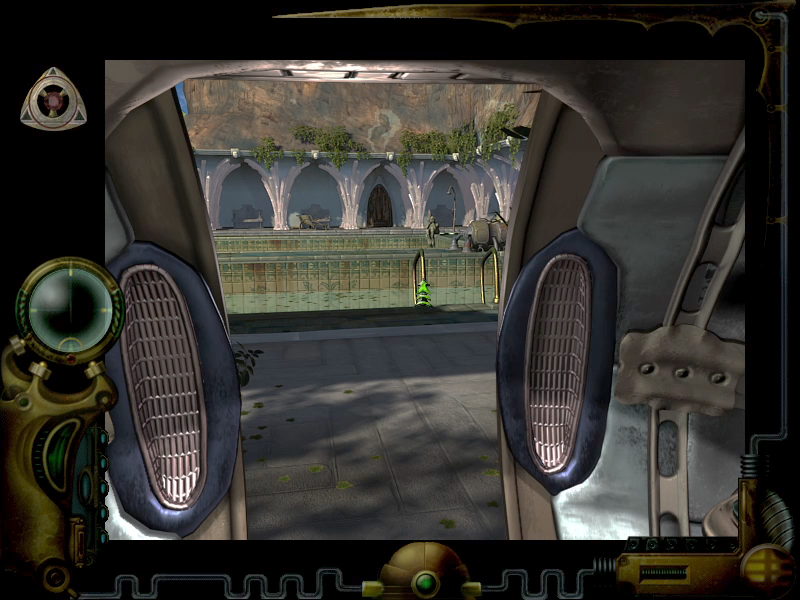 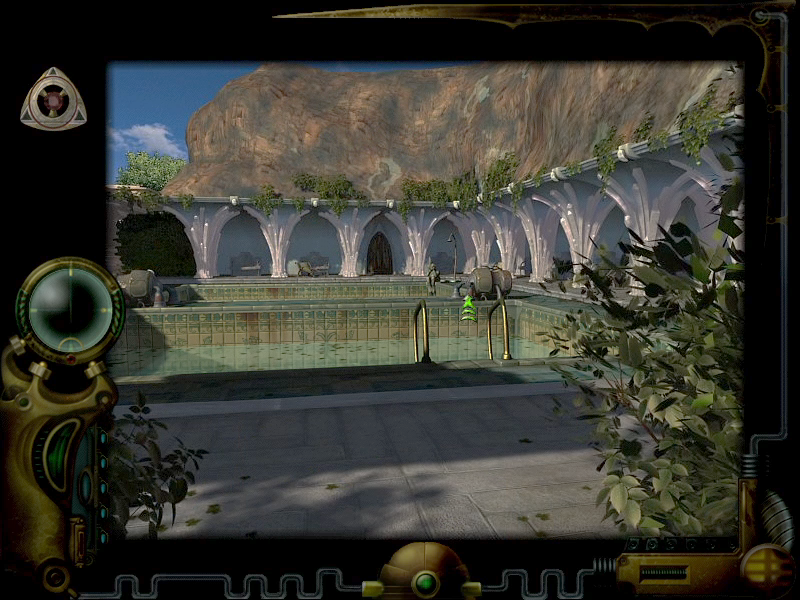 At the other end, we arrive at a new place that looks to be a...swimming pool? So, there's no open puzzle here at the end of this update for you to solve, but I can still give you an overview about our current inventory: Inventory: Amphora with lemon juice (C6H8O7 in aqueous solution) Ultrapure water (H2O) Knowledge gathered: Energy and environment Unlocked Areas: Ti - Electrolysis Cl - Swimming Pool Maki fucked around with this message at 21:05 on Jul 25, 2023 |
|
|
|
Maki posted:[timg]https://lpix.org/4556396/Basement%20Transporter.png[\img] You got some broken image links in there.
|
|
|
|
Thanks, I fixed it.
|
|
|
|
Update Li - She rode the midday transporter going anywhere Alrighty, last time we smooshed a lemon and made ultrapure water through electrolysis and a fuel cell, which also led us to activate the transporter and set us off to the next destination, the swimming pool area. Let's go and explore that!  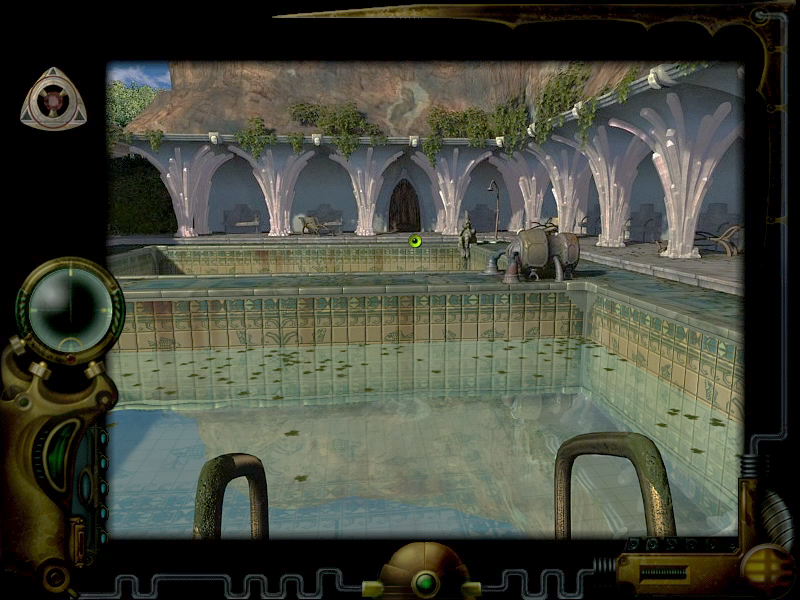 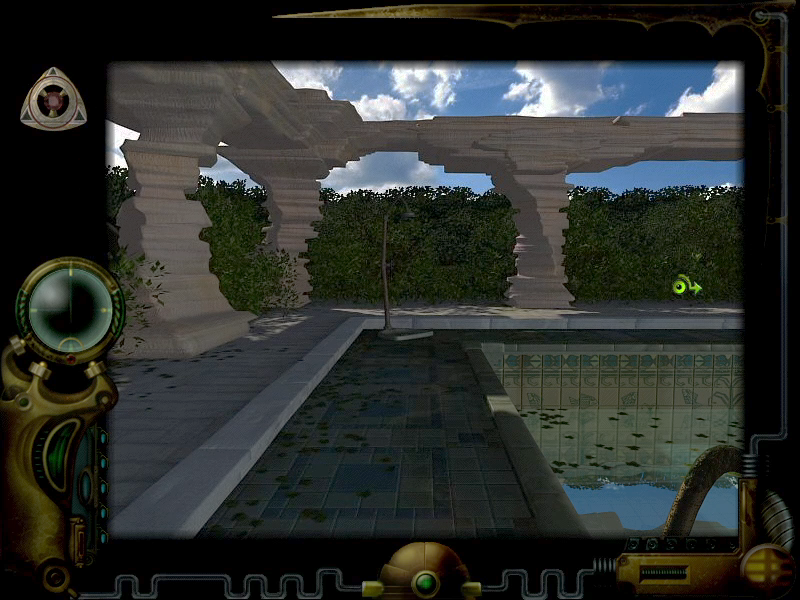 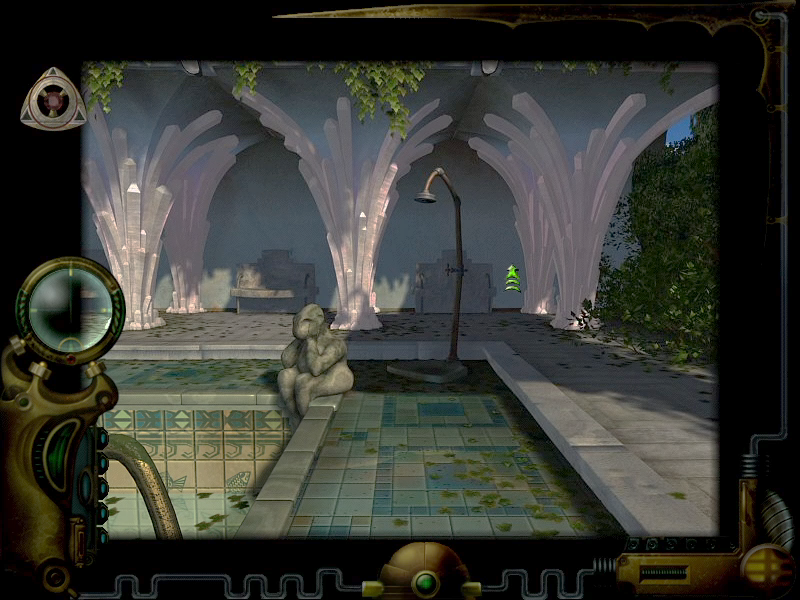 Okay, so here's the first part where navigation goes a bit wonky. There is nothing to tell us where we can and cannot go, except for mousing over and trying. You'd be forgiven for thinking you can go both left and right around this pool, but only turning right actually allows us to go forward. In fact, the game allows you to turn around here and look around, but gameplay-wise, this is a linear way to the door at the far end there, and no interactables inbetween. 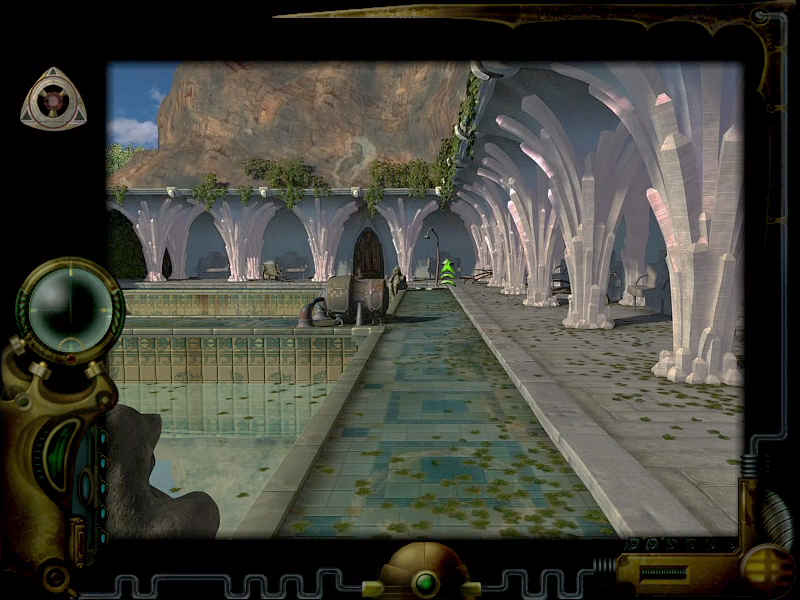 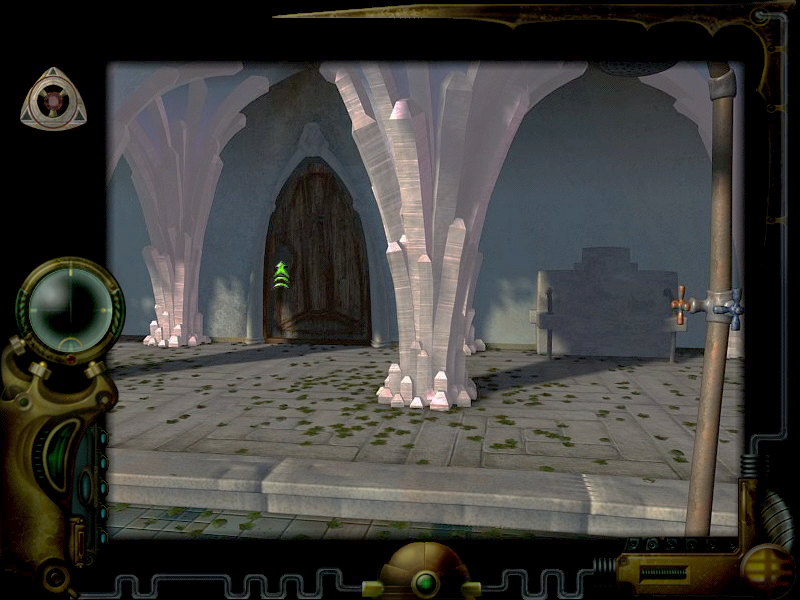 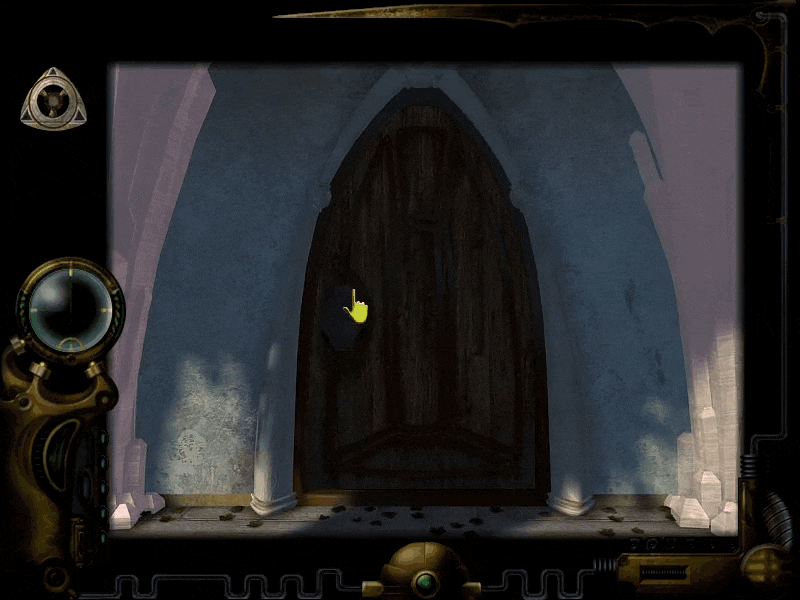 We open it and step inside, where Richard has another message for us. https://www.youtube.com/watch?v=GjAZhfaVJOU 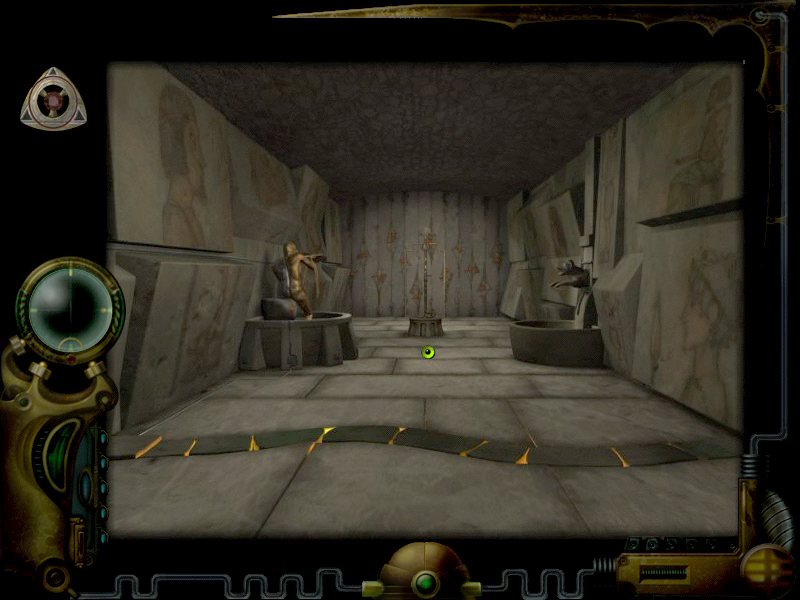 Afterwards, we can take in this strange room we're standing in. The first thing we can look at is not even visible from this picture, but can be seen if we turn right: 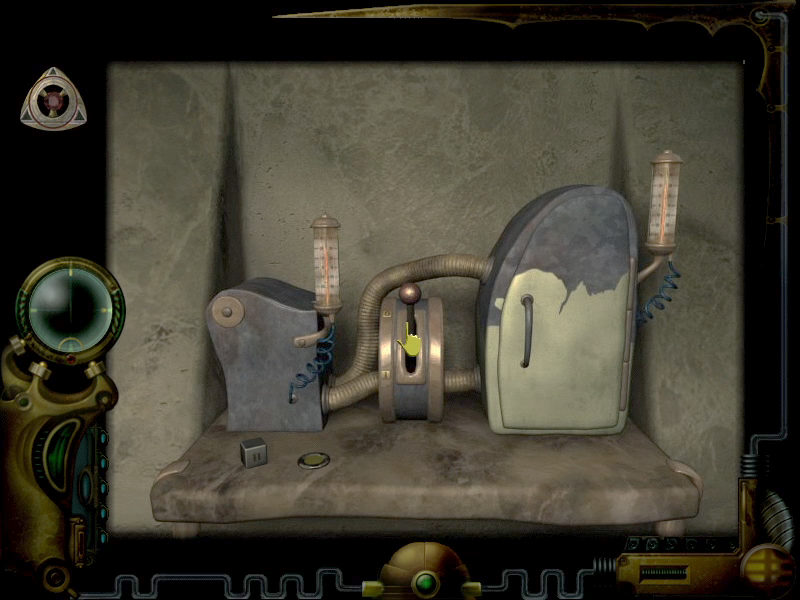 A table with two pick-ups and a machine! We first take the two things. Picked up: transporter block [H], learning chip: Electrochemistry What's left is this machine. 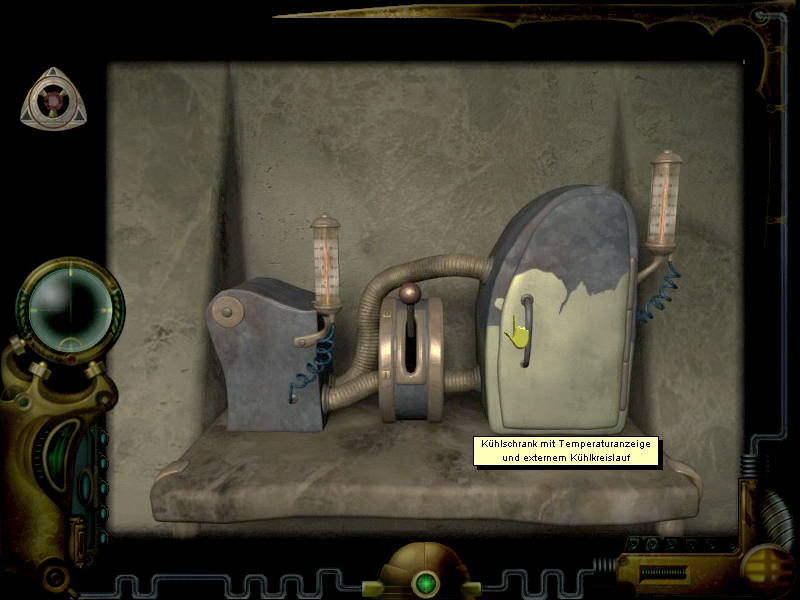 fridge with temperature indicator and external cooling circuit 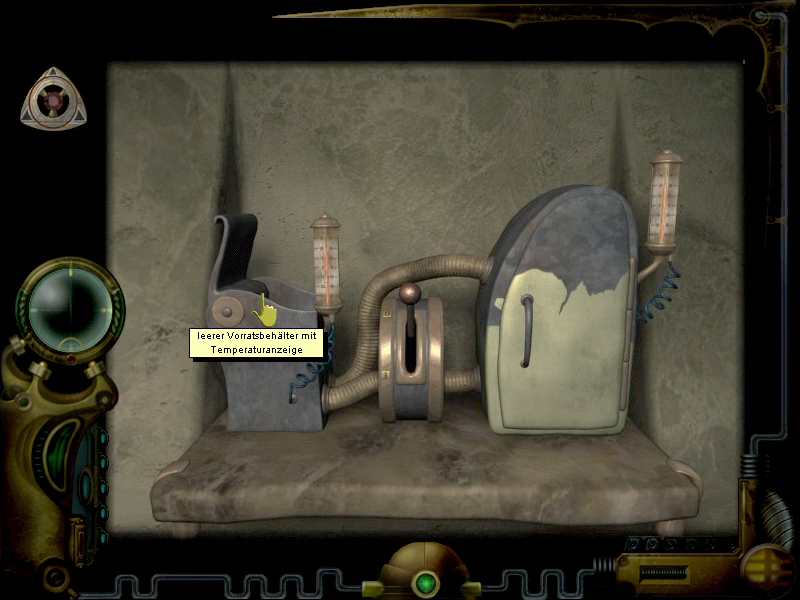 empty container with temperature indicator We can open up that fridge, but sadly, it's empty. Back to the main view of the room, the next thing is that glowing line of plates on the ground. We can examine the spot where it hits the left wall: 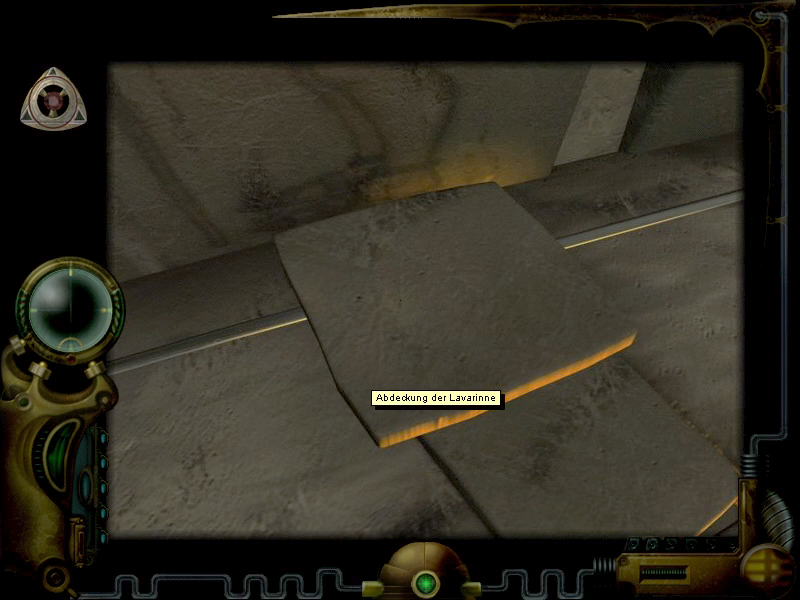 cover of the lava gutter We can click that to move it 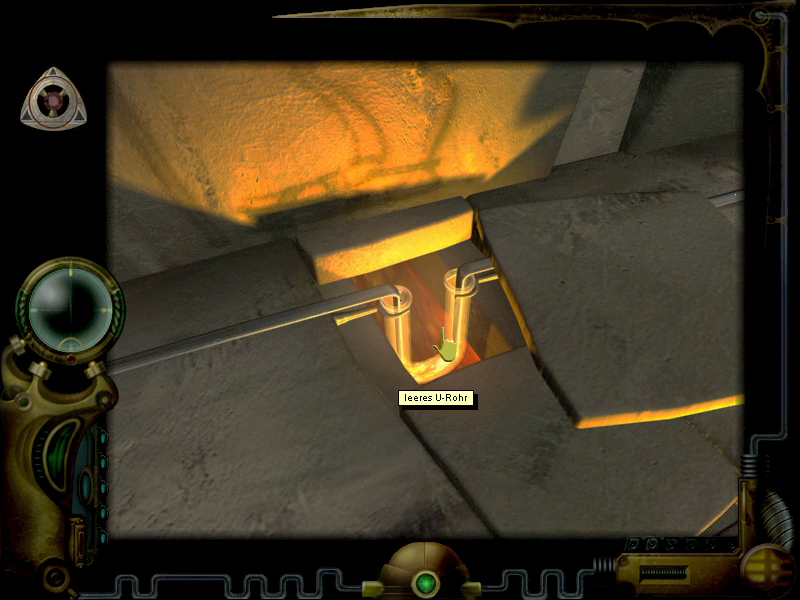 empty U-bend Nothing we can do with that yet either, so on we go. On the right-hand side of the room, there's this...dog fountain I guess? 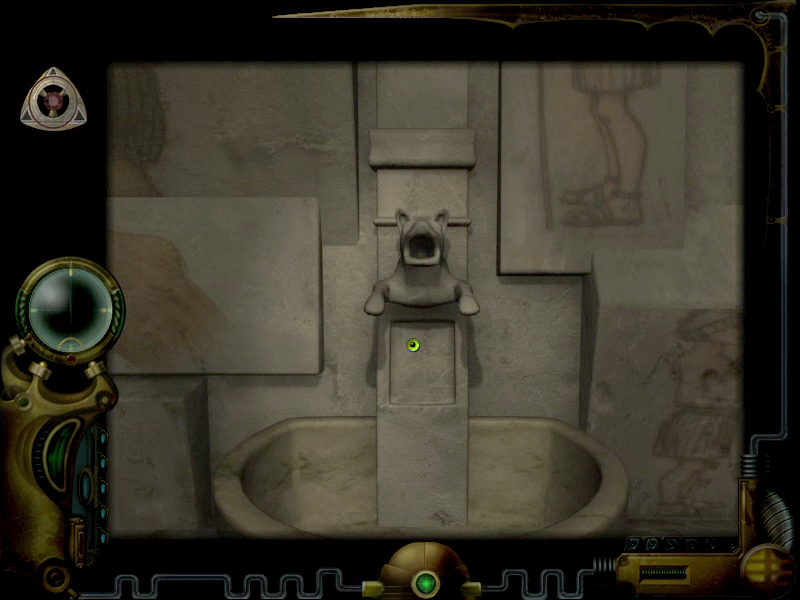 It doesn't even seem to be interactable though. 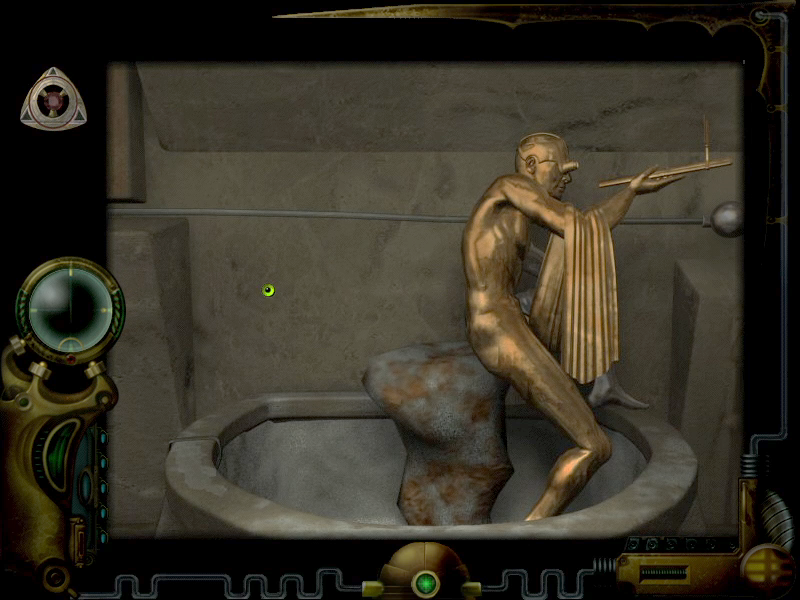 On the left-hand side, we've got this metal statue of a dude with a thing in his hand. We can actually zoom on the basin below him.  salt-encrusted fountain 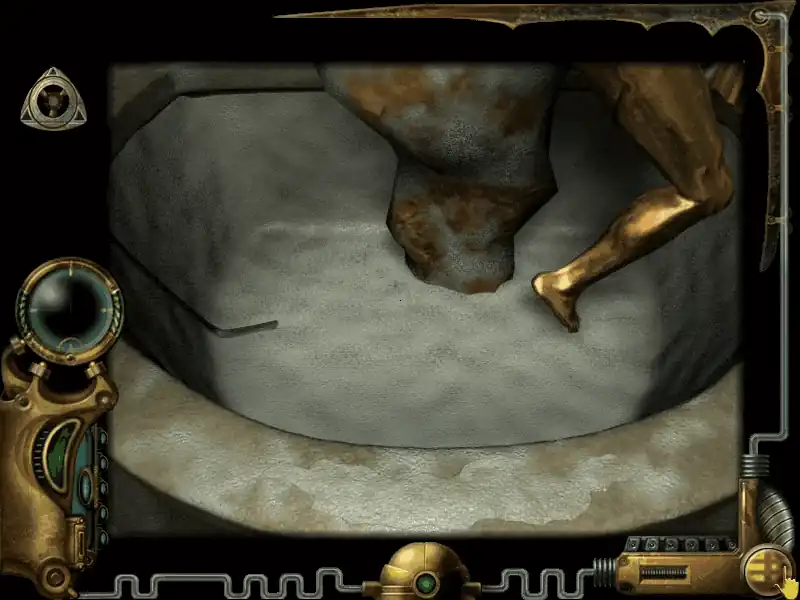 We can pour in some ultrapure water into this thing, and it dissolves some of the salt, showing us an image on the bottom of the fountain. 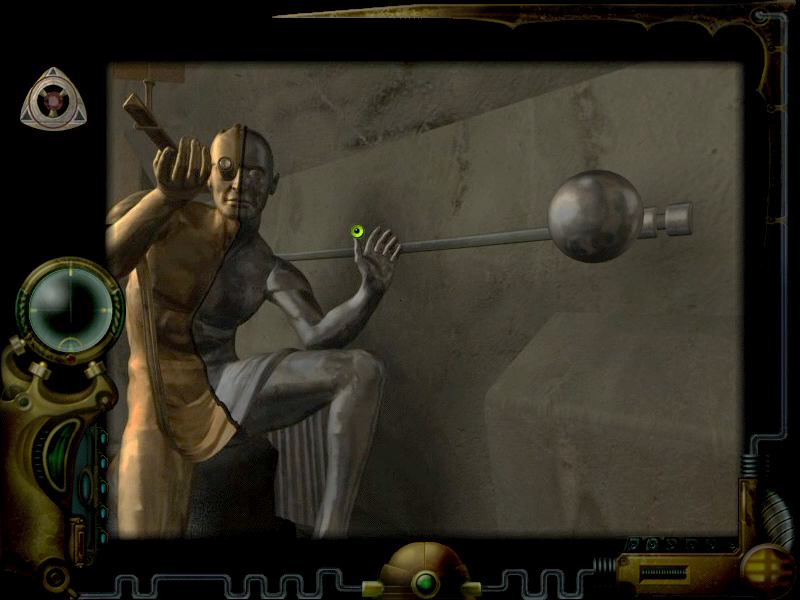 If we walk around a bit, we can get another view of the statue, and the orb we can see here actually moves. 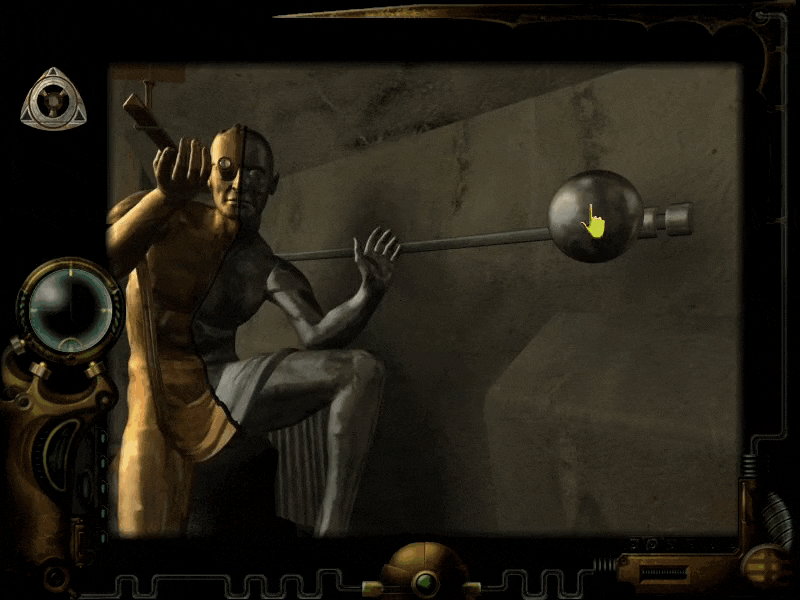 Not knowing what it does, I leave it as is for now. 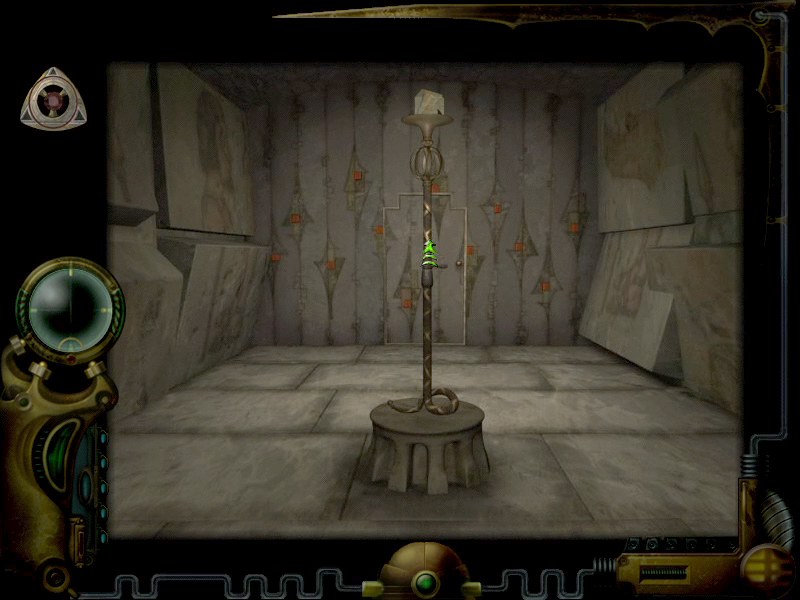 We've left out this column in the center up until now, let's check that one out. The handle has two settings we can switch between. 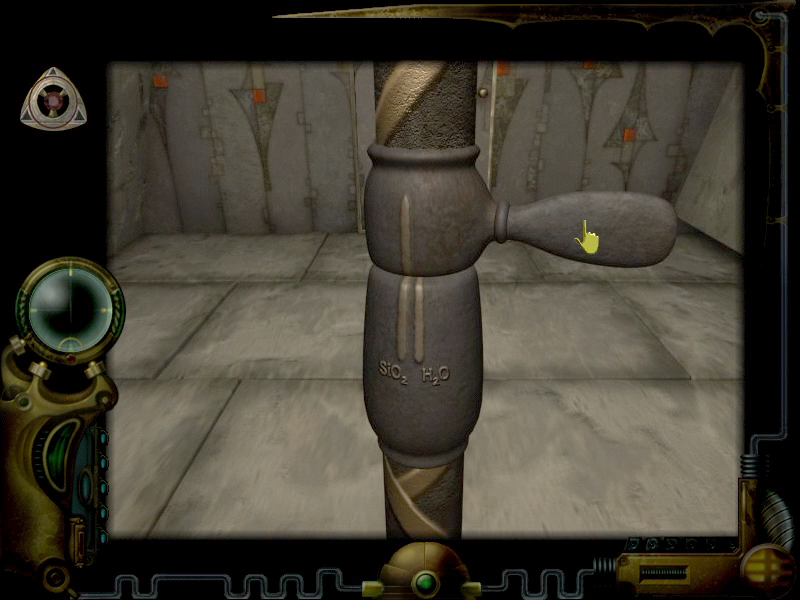 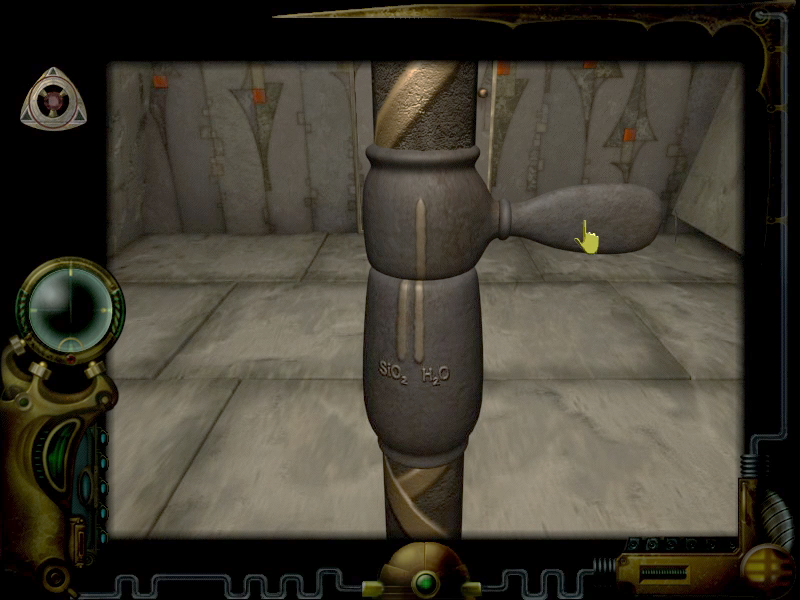 We can also look up and see that there's something on the pedestal 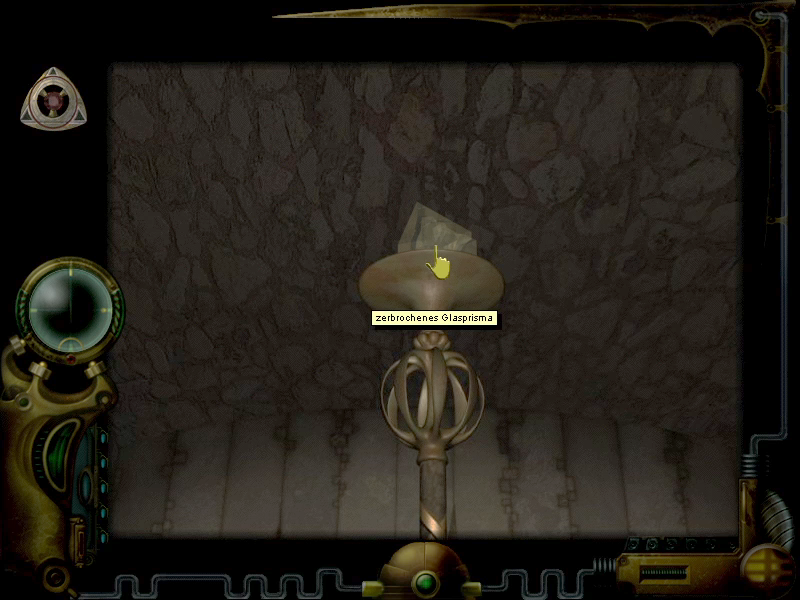 broken glass prism Picked up: broken glass prism The last place we can check out is the door at the end of the room, but it is not interactable right now. It does have marked spots next to it, though: 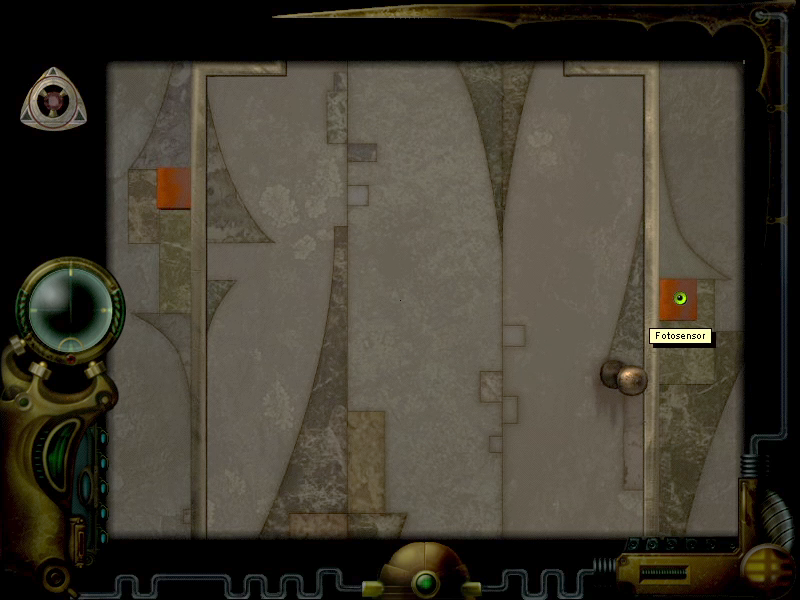 photo sensor Interesting. Anyway, we've done all we can do in this area for now, so let's head back to the transporter and see where that [H] block takes us. 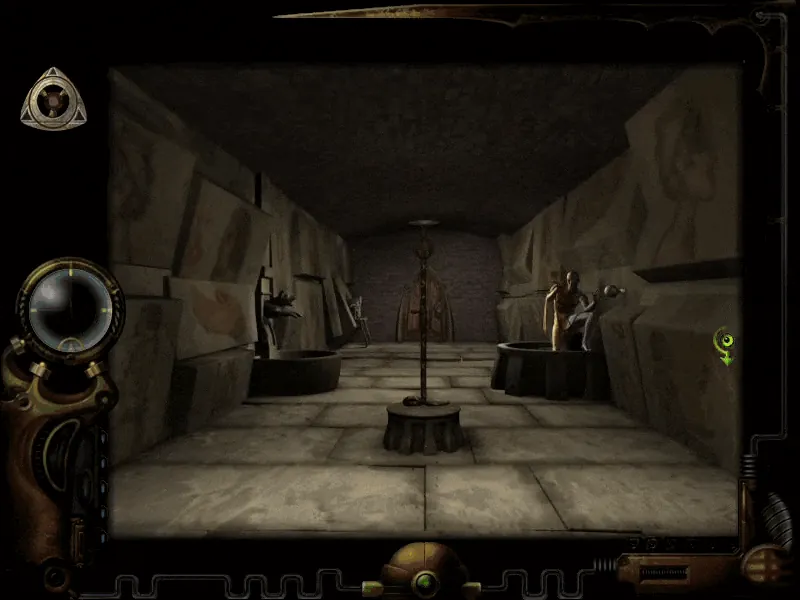 However! When stepping out, the game freezes us to give us this cutscene. 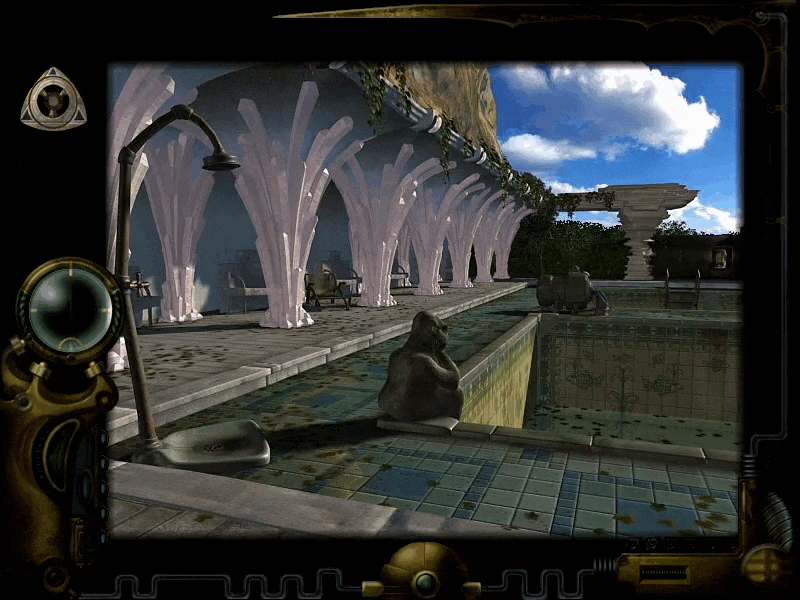 Not gonna lie, I expected that person to move the transporter away and trap us here. They seem to have gone into the bushes, so after them! 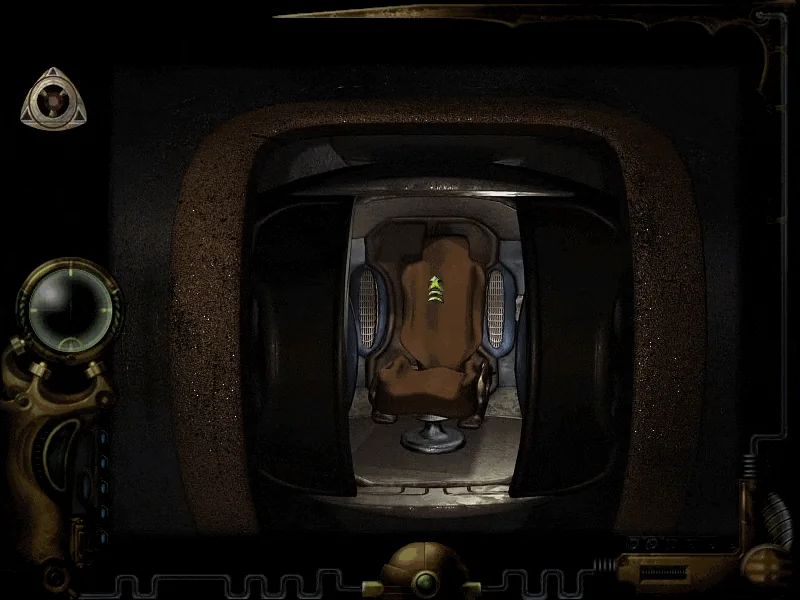 ...aaaaand we can't. We can't even turn around by less than 180 degrees to look into the direction of the bushes. Meh. Guess we gotta stick to plan A and check out that [H] button. 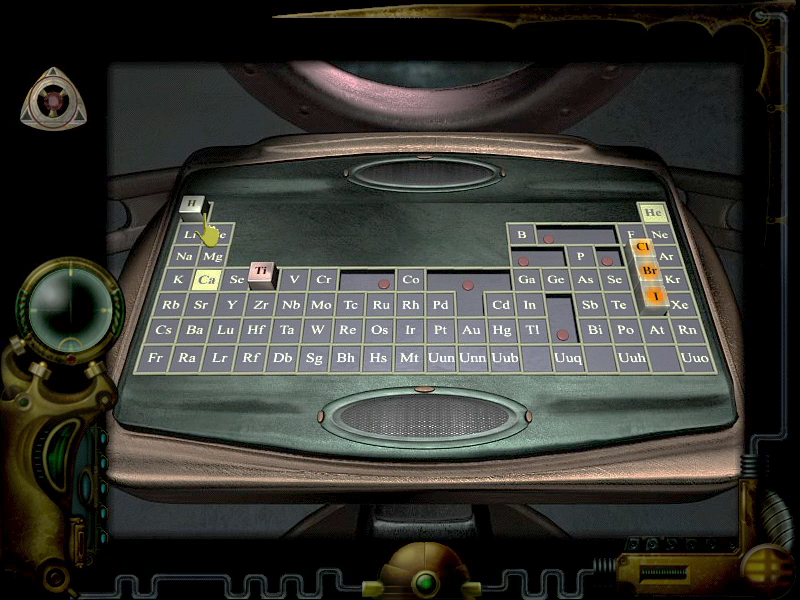 Lost: transporter block[H]  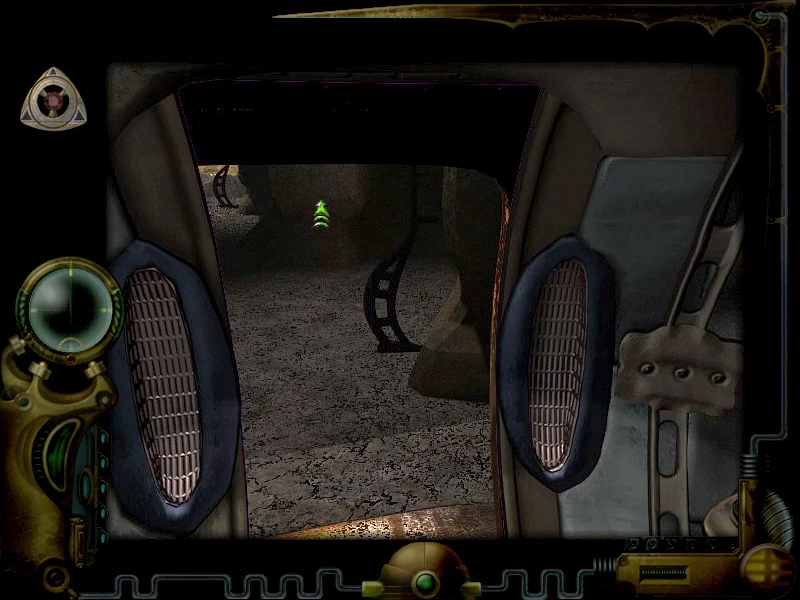 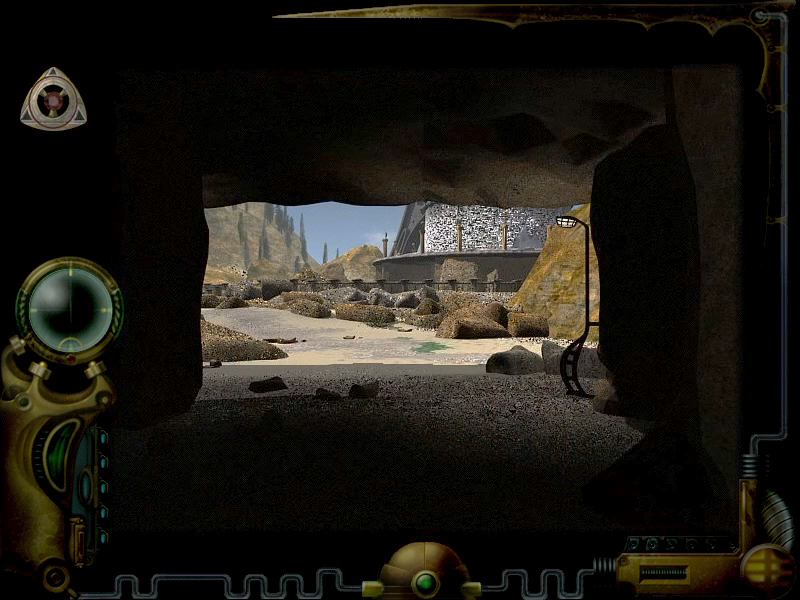 And we're standing in some sort of cave. Immediately, Richard has a message for us. https://www.youtube.com/watch?v=8nE3iGuoUqo Seems like he isn't doing so hot, poor guy. Anyway, let's explore this new place. 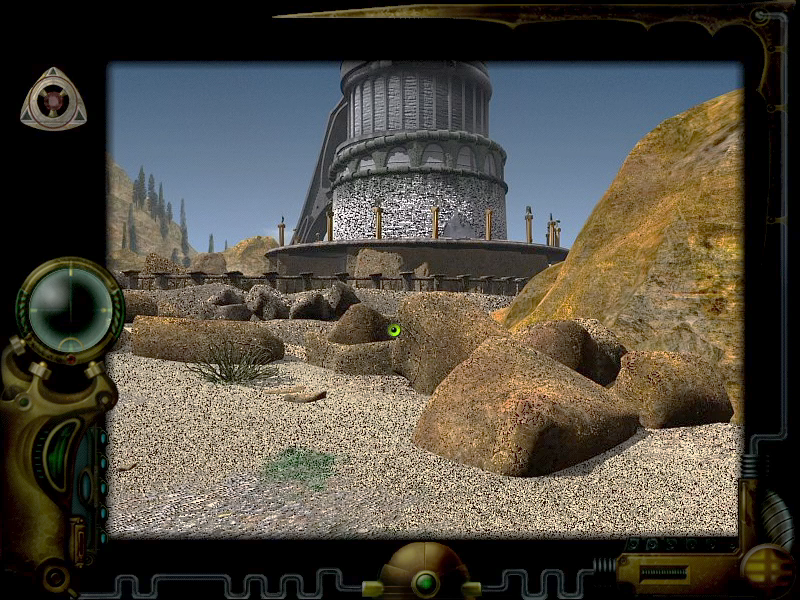 Huh, that seems familiar. 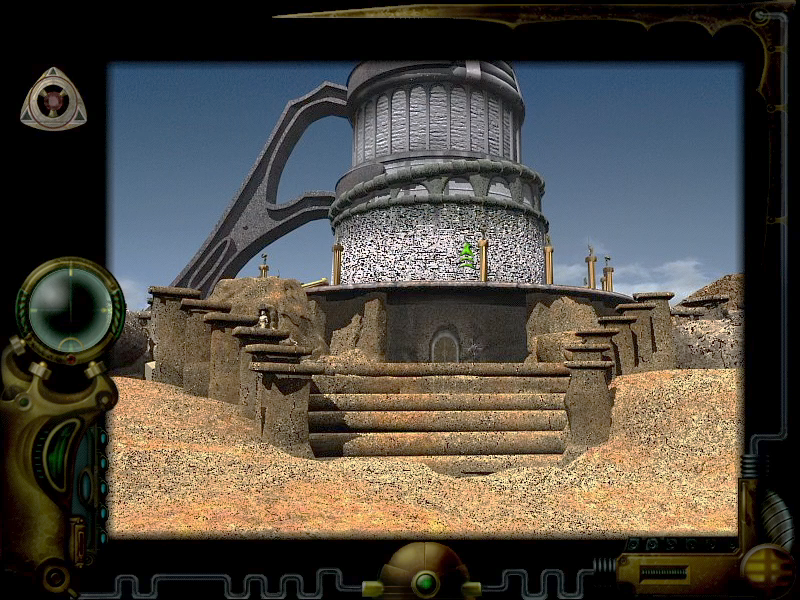 So yes, this is the base of the tower we've seen on the cover art and in Richard's place. Let's go in and find out what's up. 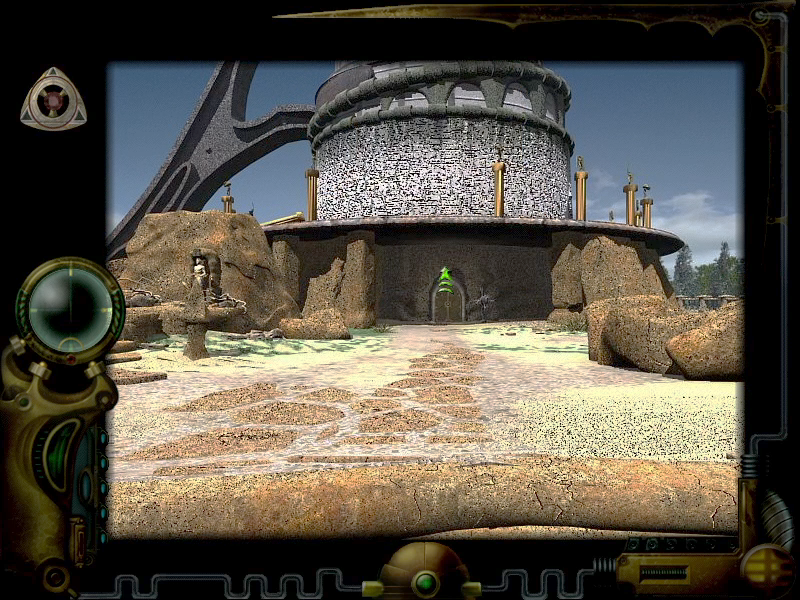 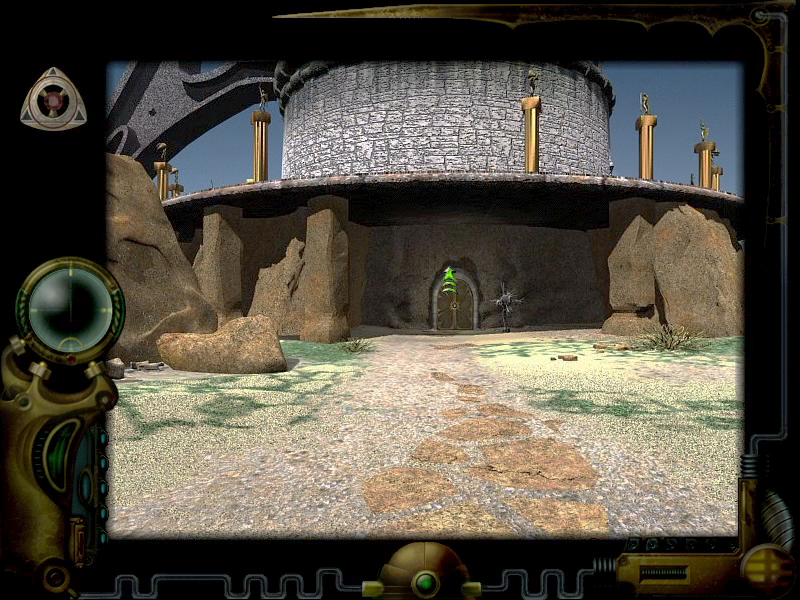 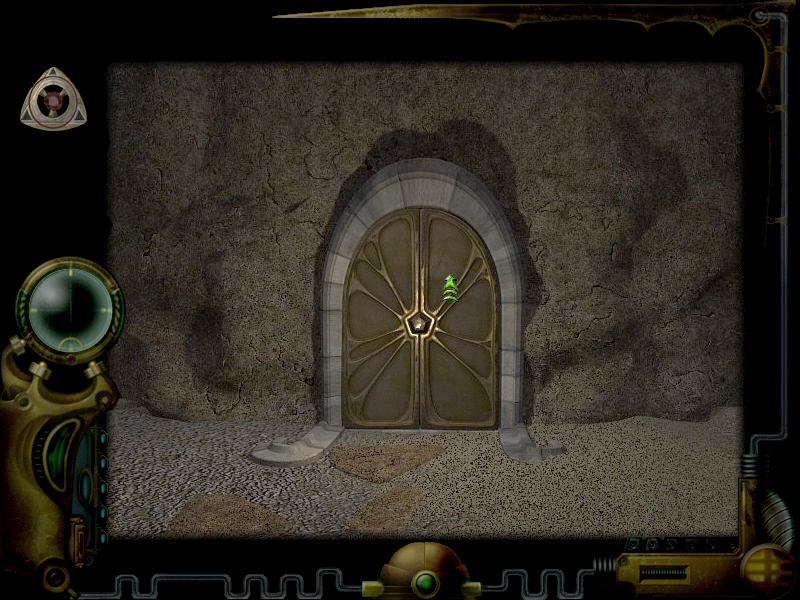 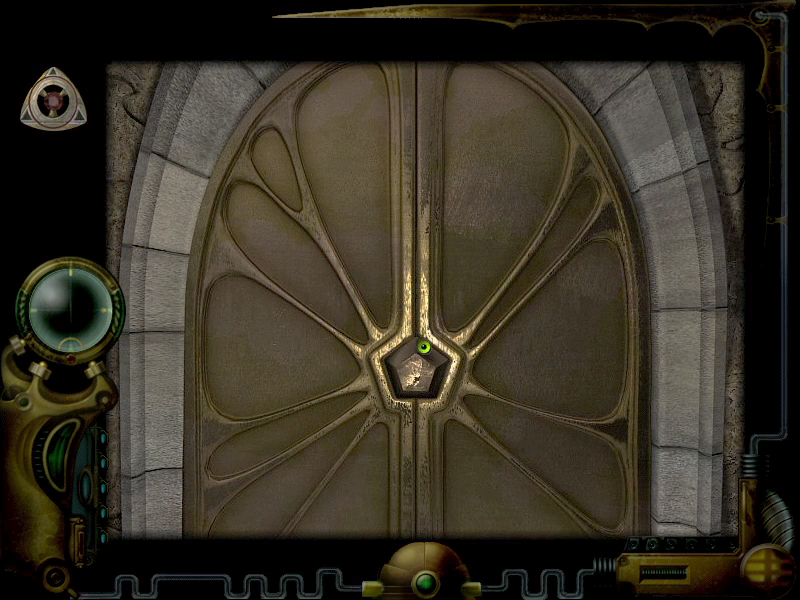 But of course, the door isn't interactable. Would've been too easy. Let's check out what else is here. 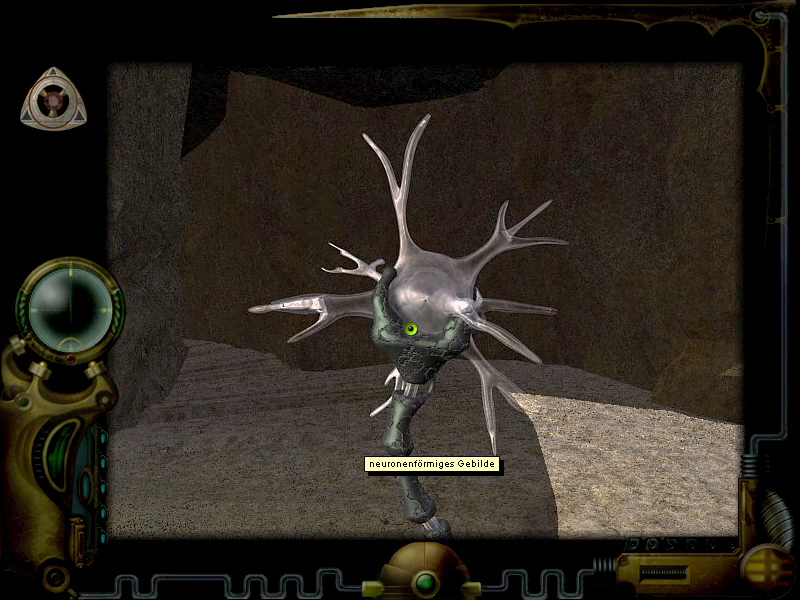 neuron-shaped formation Whatever this is, it doesn't allow for interaction either. On the way here, there actually was a platform we could've gone to on the left, so let's check that out. 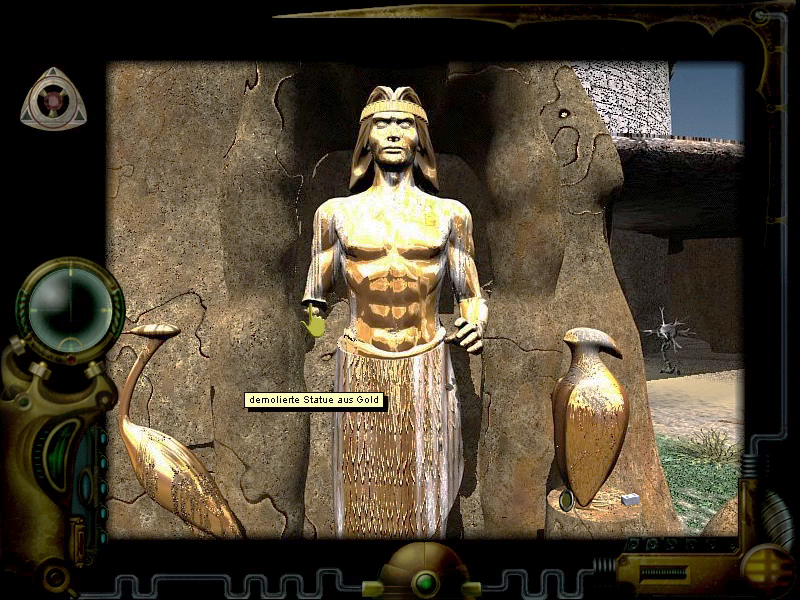 vandalised golden statue No interaction here either, except for the two familiar items on the right pedestal Picked up: learning chip: metals, transporter block[Pb] and that's all for this area, for now. Again, no puzzles, just ambling around and stealing things, the bread and butter of every adventure game protagonist. Let's get back to the transporter and try out the new block. Lost: transporter block[Pb] 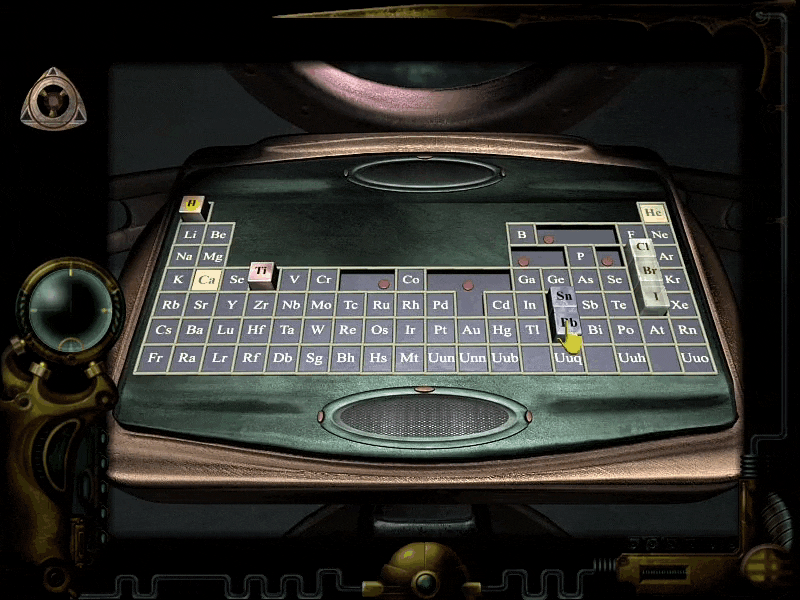  When we arrive, the game plays a buzzer sound. It didn't do that for any of the other locations. Seems to have worked fine though, we're standing in another cave and Richard has yet another message for us. https://www.youtube.com/watch?v=0xioPRVzZKI Okay, so this will be our quest now: Find out what this transmitter molecule is and how to synthesize it. I have...opinions on how they implement this quest, but those can wait until you've seen it. 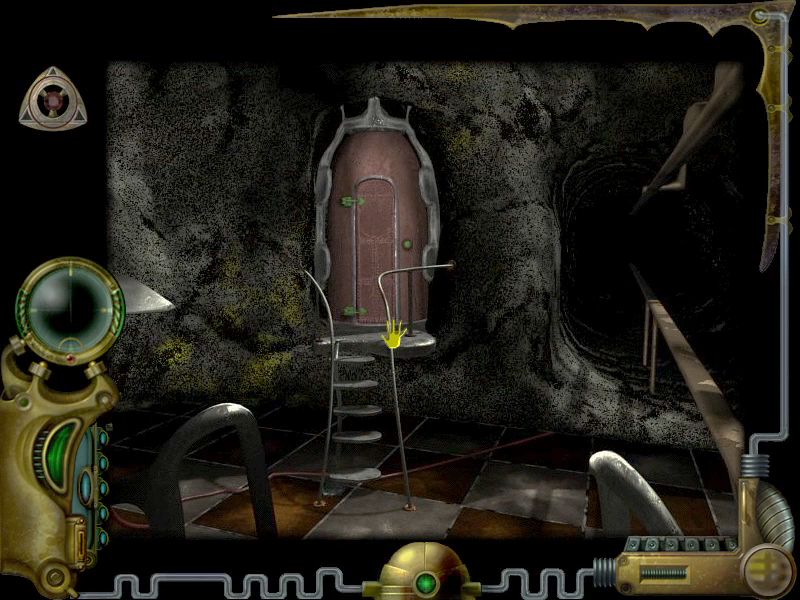 So, let's continue exploring. On our left, we find this thing here  drainage grate with gypsum With, again, a learning chip and a transporter block. Picked up: learning chip: salts, transporter block[Cu] This time though, there's more to go and pick up, by going through that door we saw at first. 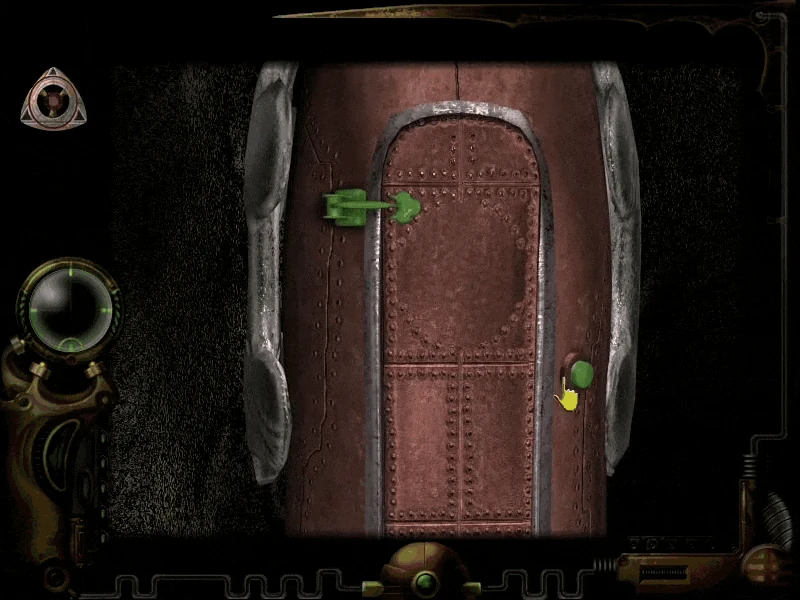 Turns out, it's an elevator that we take to the top. 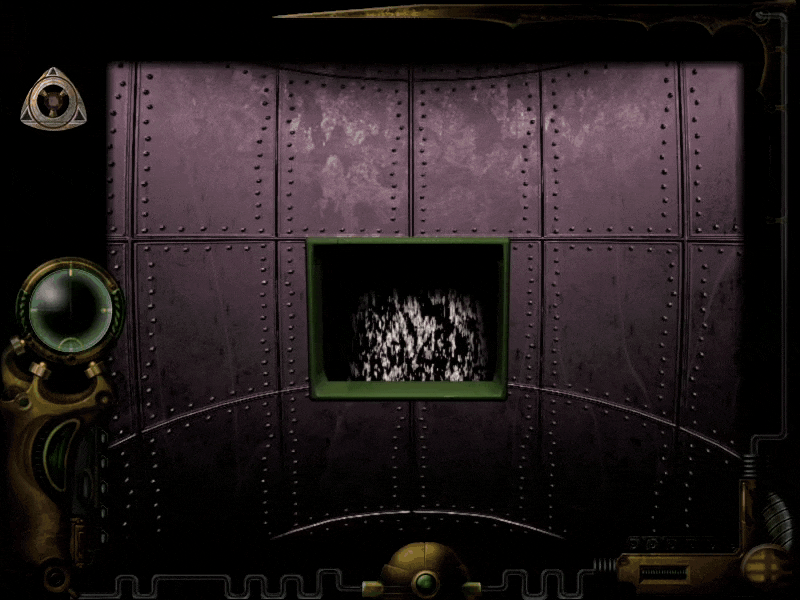 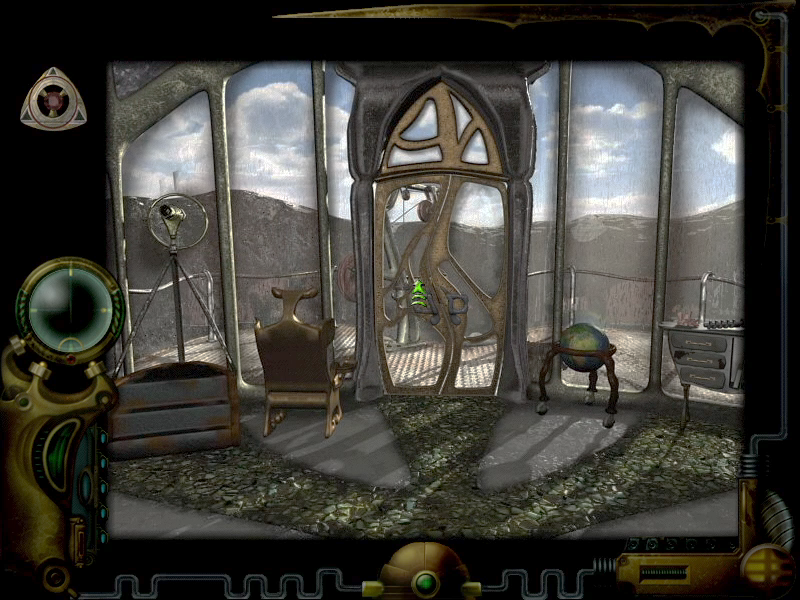 We stand in a room with glass windows. Lots of stuff modelled in here, but again, nothing can be interacted with, with the exceptions of... 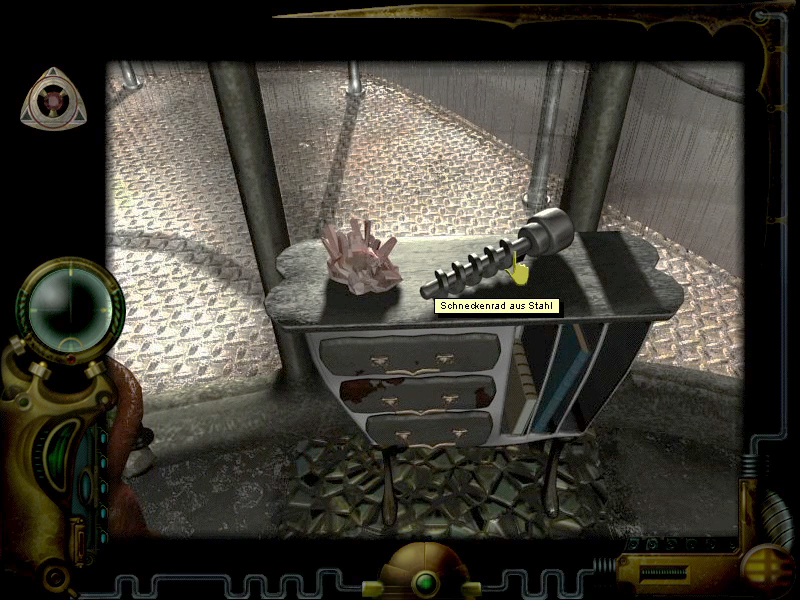 steel worm wheel This thing which we pick up Picked up: steel worm wheel 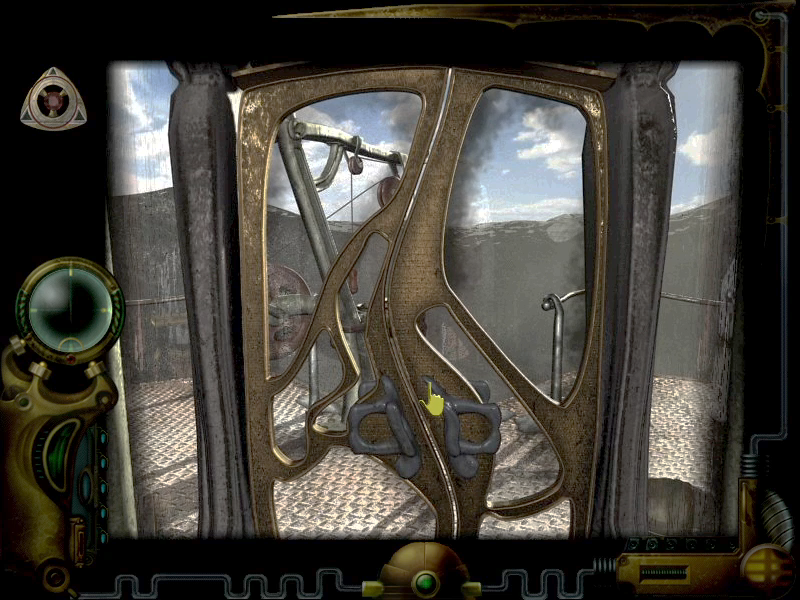 And this door, which opens and lets us outside. 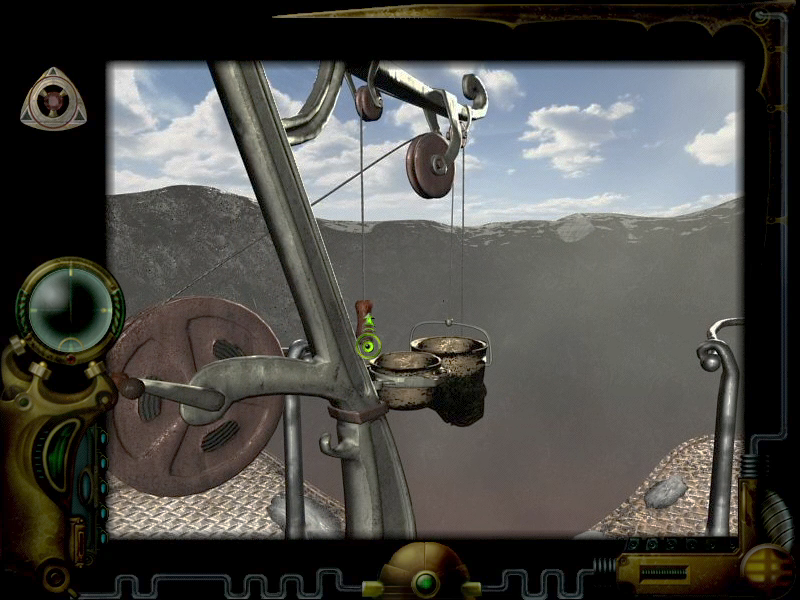 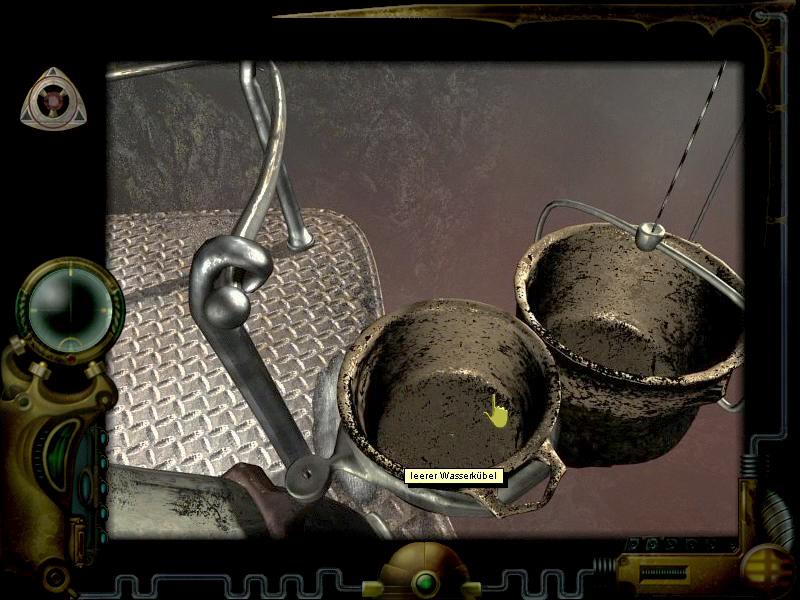 empty water bucket 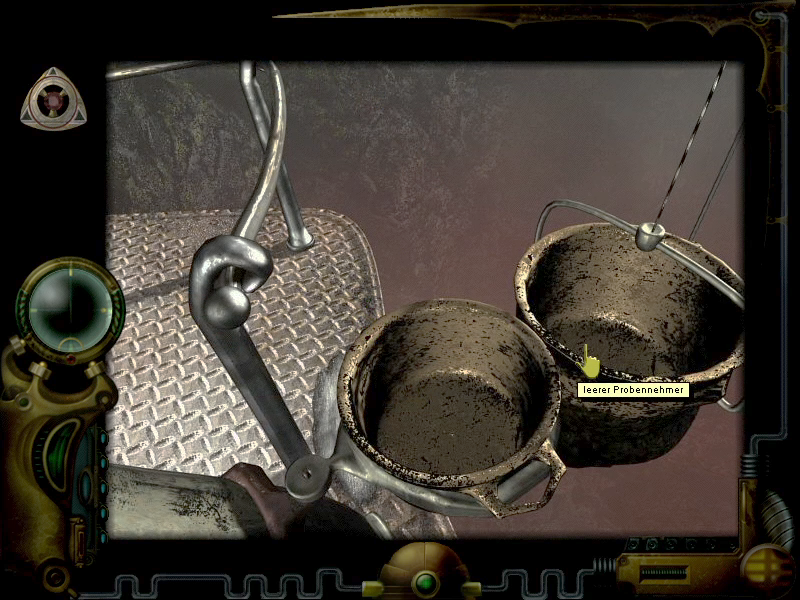 empty sampler Looking down, we see that we're actually standing over an active volcano. Luckily, it seems to be cold up here, cold enough even to give us another item 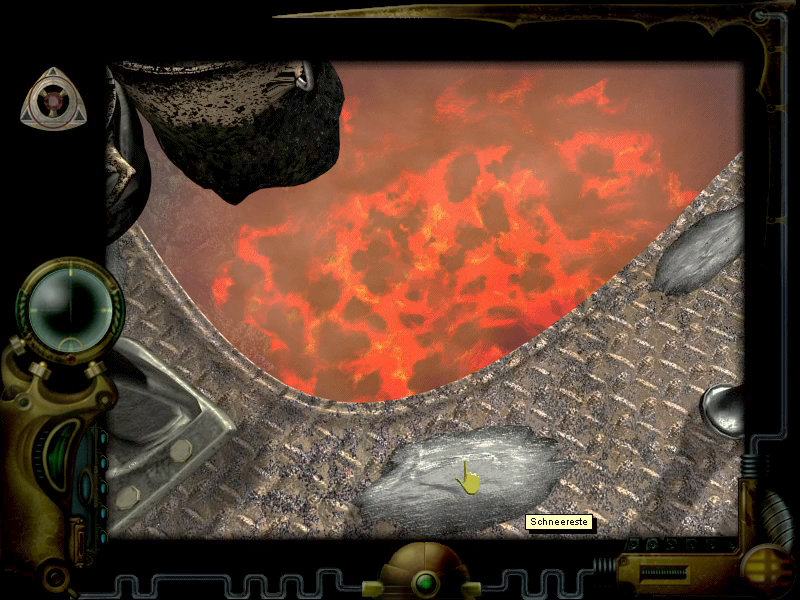 dregs of snow Picked up: dregs of snow And now, we've done everything we can do here, so again, let's go back to the transporter and use the new block to go to a new place. Down here, I notice that there's actually a spot below the transporter that is interactable. 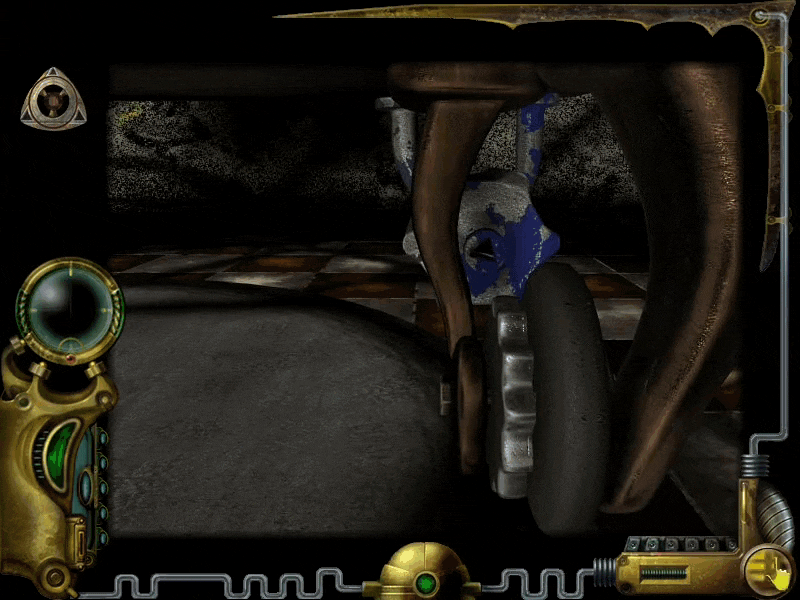 motor with missing transmission shaft Thinking I've got the solution, I try to stick that worm wheel in there, but no, this does nothing. Off we go, then. Lost: transporter block[Cu] 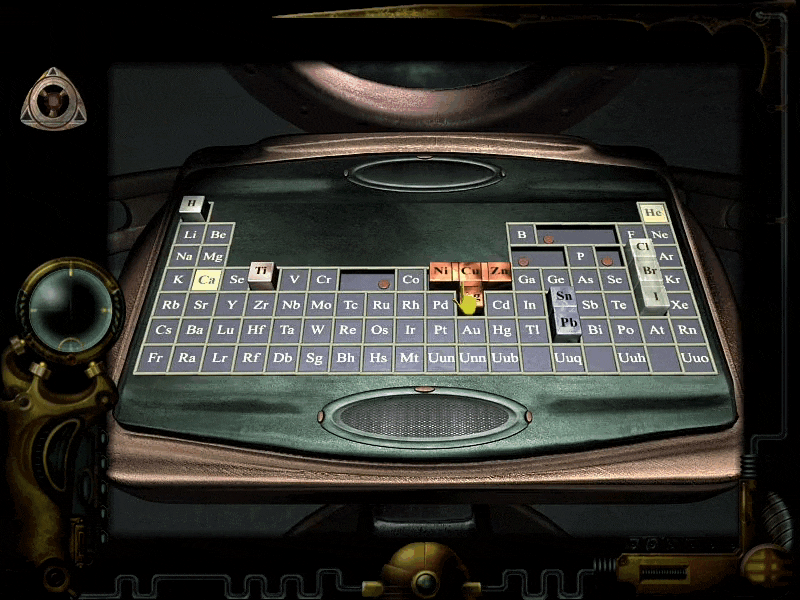  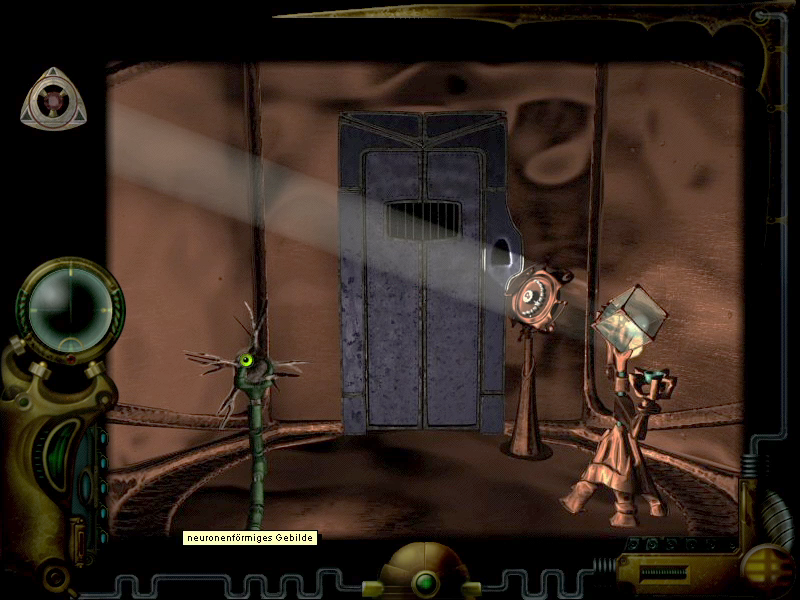 neuron-shaped formation And we stand in this small place. First, we examine this thing on the right. 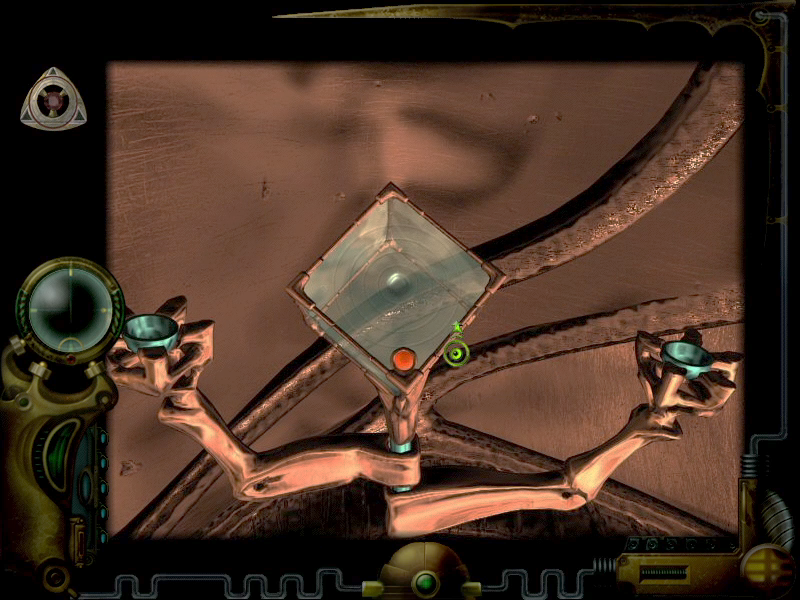 We can zoom in on the top 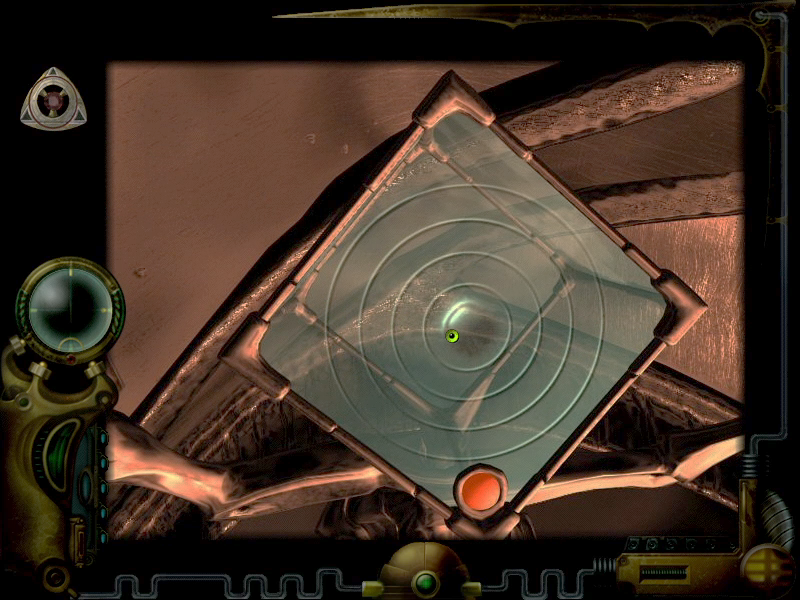 but even if we push the button, nothing happens. On a whim, I try to put in the snow we found in one of the cups, but that doesn't go in there. The only other interactable here is that thing next to the doorway. 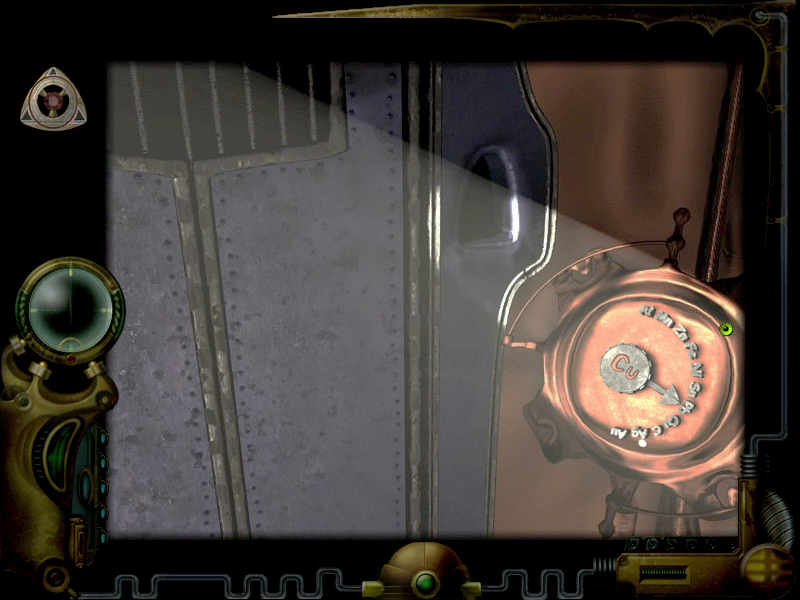 It's an arrow that points to one of many elements (currently Pb), but we can move it to only three of them: Zn, Ni and Ag. From the top, let's start with Zn. 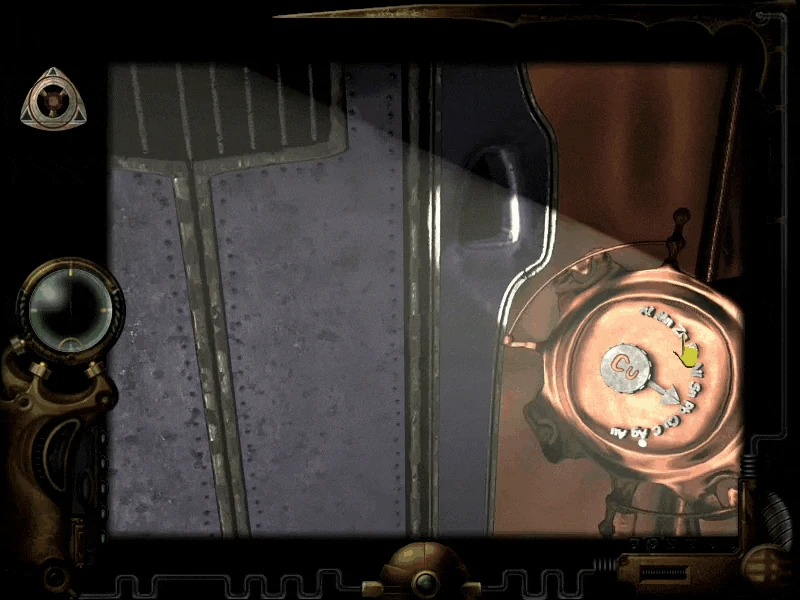 The door opens and shows us a small lab. 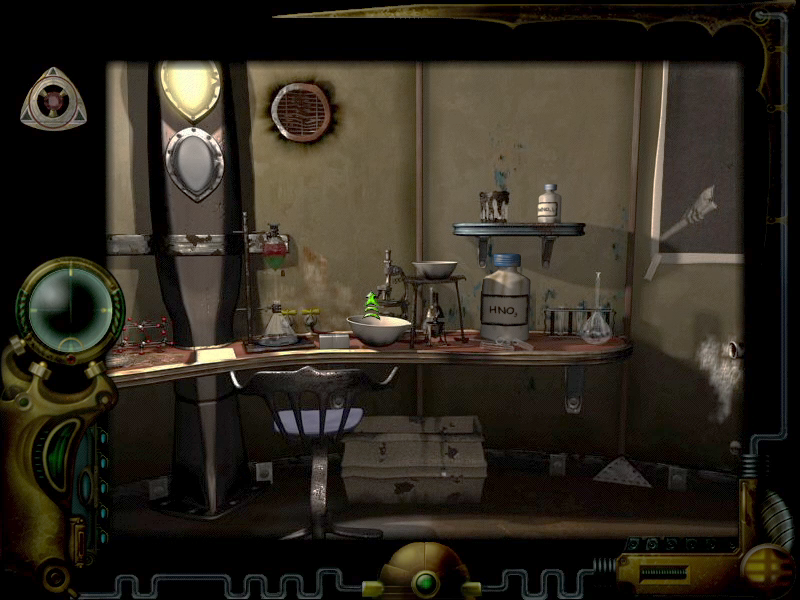 There's also interactables here that do nothing right now 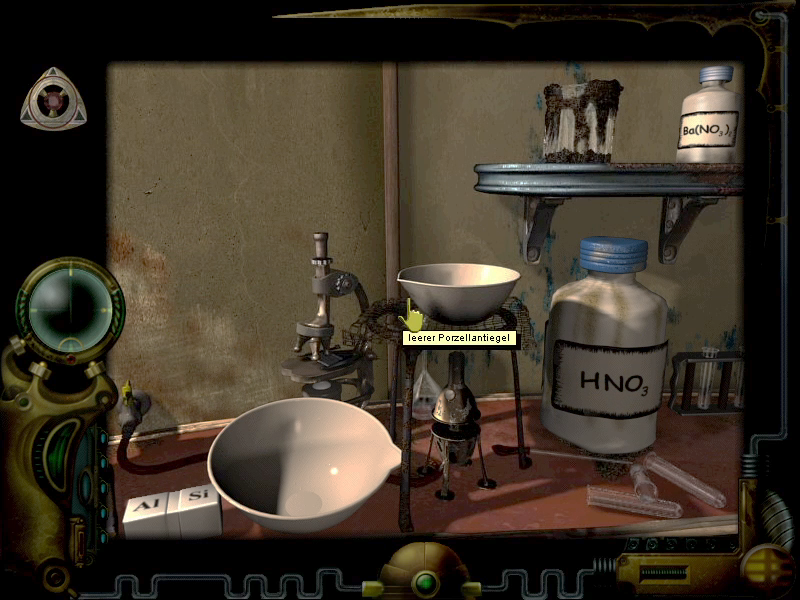 empty porcellain crucible 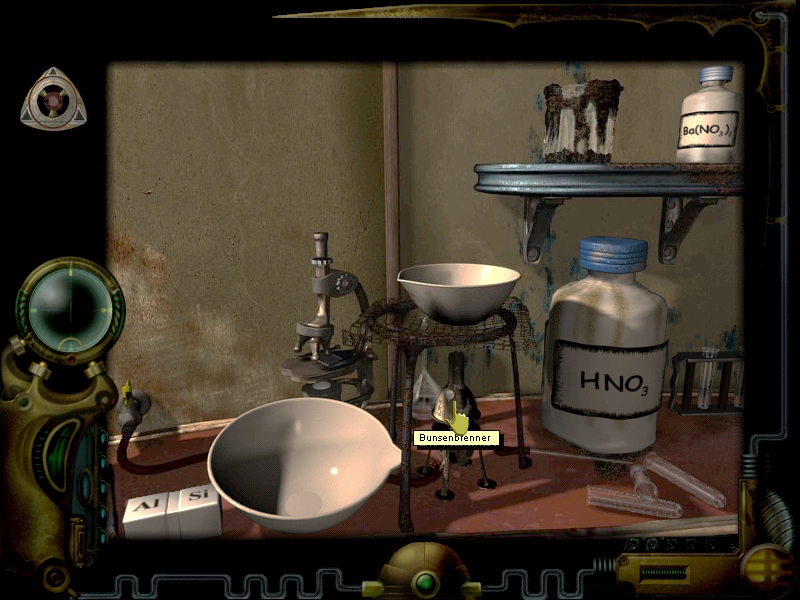 bunsen burner 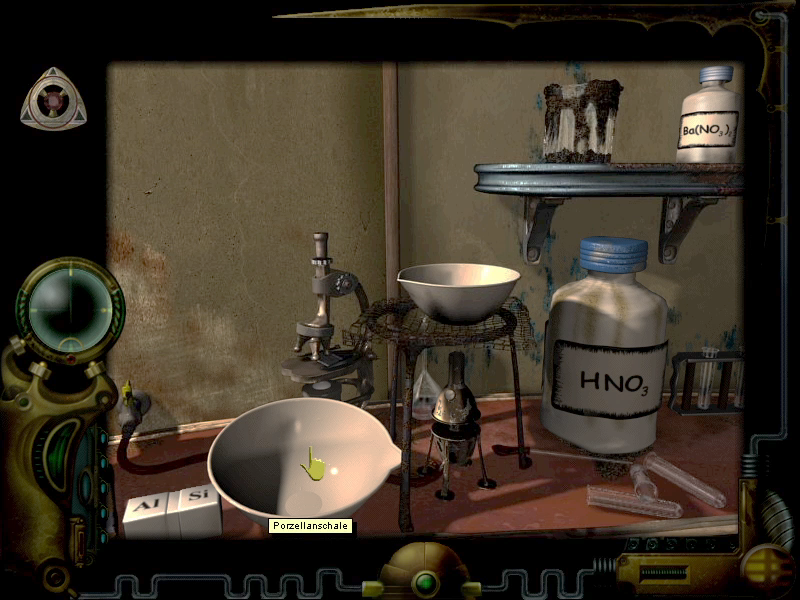 porcellain bowl And more items for the item god! 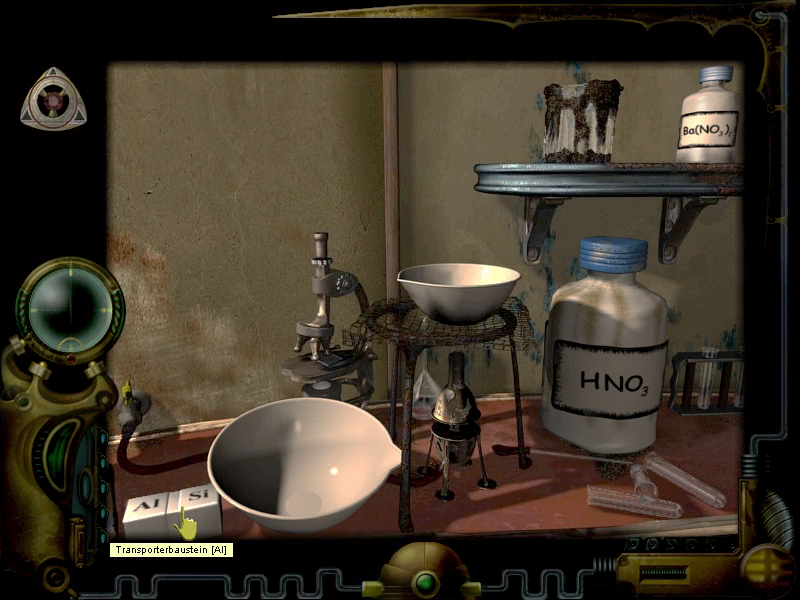 transporter block[Al] 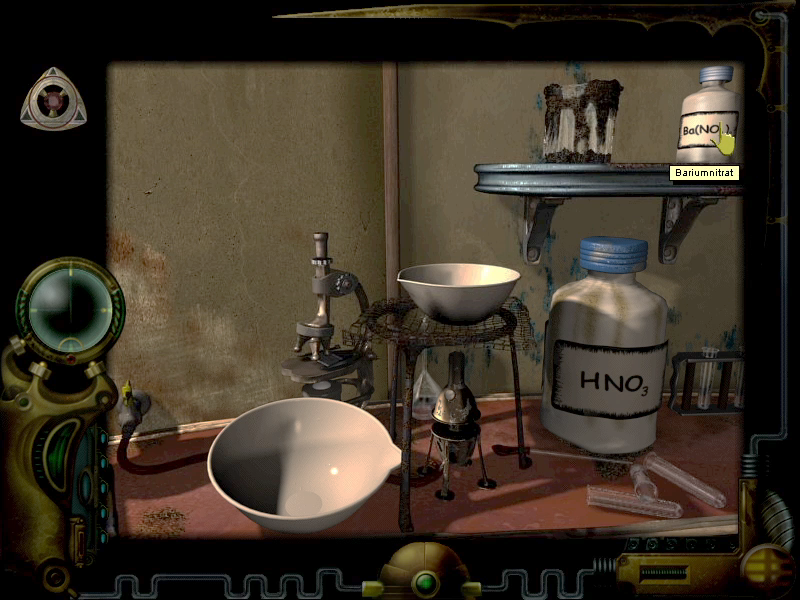 barium nitrate 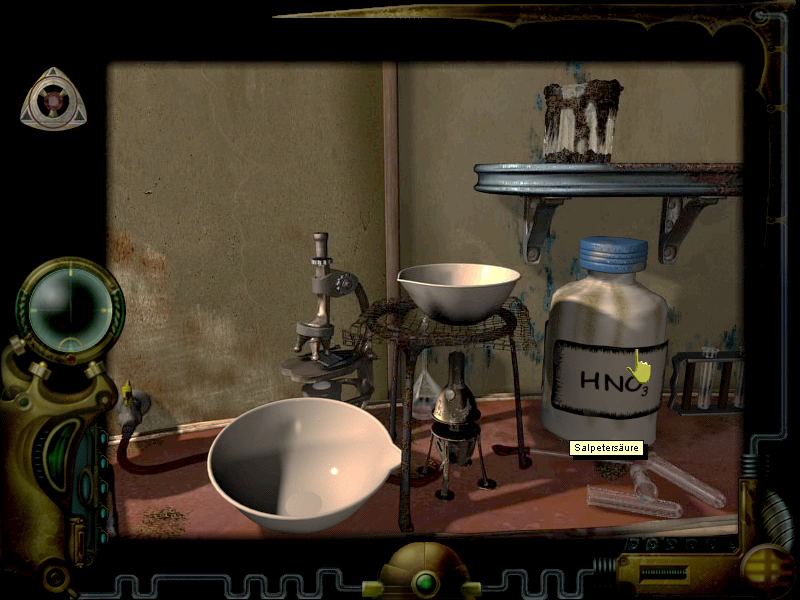 nitric acid Picked up: transporter block[Al], barium nitrate (Ba(NO3)2), nitric acid (HNO3) Further left, there's this piece of paper that we can interact with. 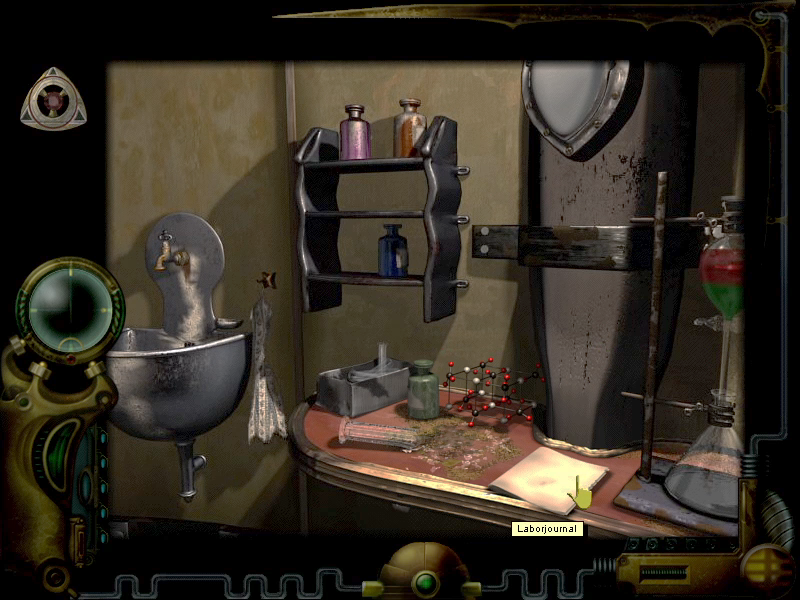 lab journal 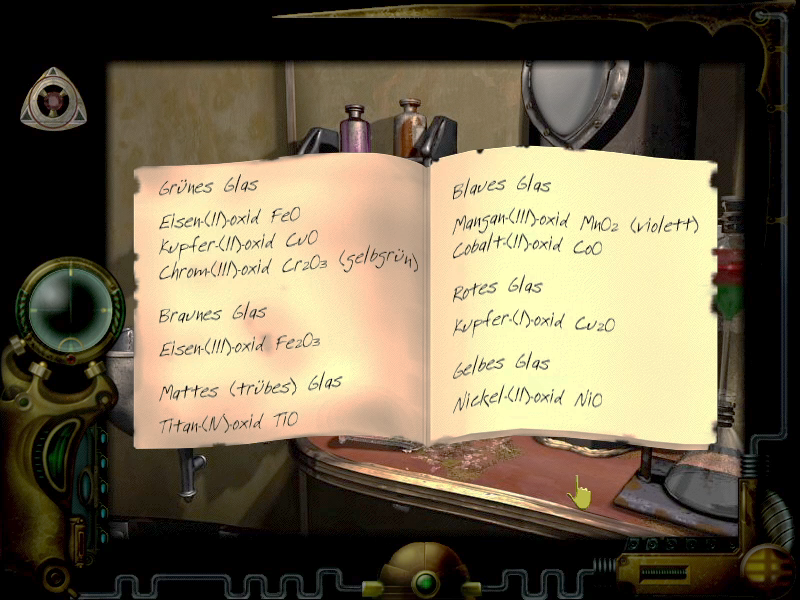 Green glass Iron(II) oxide FeO Copper(II) oxide CuO Chromium(III) oxide Cr2O3 (yellow-green) Brown glass Iron(III) oxide Fe2O3 Matté glass Titanium(IV) oxide TiO Blue glass Manganese(III) oxide MnO2 (violet) Cobalt(II) oxide CoO Red glass Copper(I) oxide Cu2O Yellow glass Nickel(II) oxide NiO 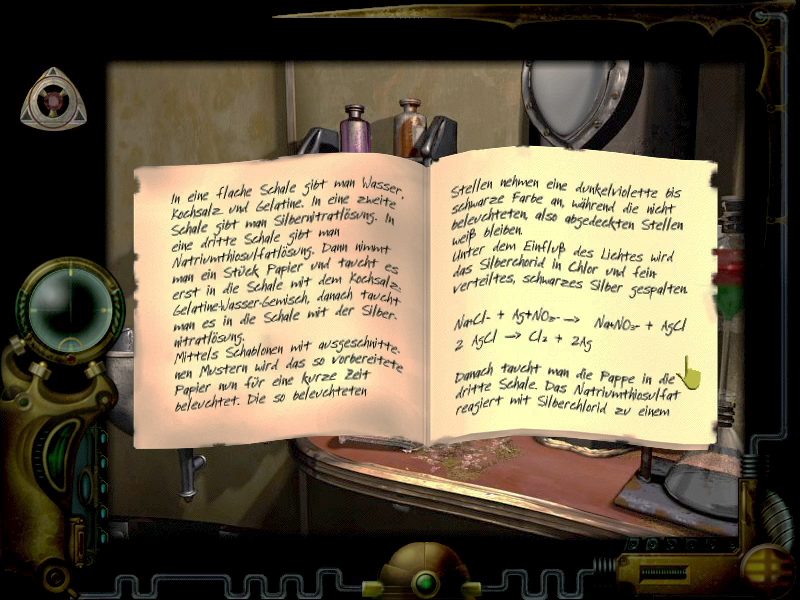 In a flat bowl put water, table salt and gelatin. In a second bowl put a silver nitrate solution. In a third bowl put a sodium thiosulfate solution. Then you take a piece of paper and submerge it first in the table salt/gelatin/water mixture, then in the silver nitrate solution. With templates in which patterns have been cut, the paper is exposed to light for a short time. The areas exposed to light take on a dark violet to black color, while the covered areas stay white. Under the influence of light, the silver chloride is split into chlorine and finely distributed, black silver. Na+Cl- + Ag+(NO3)- → Na+(NO3)- + AgCl 2 AgCl → Cl2 + 2 Ag Then, the paper is submerged in the third bowl. The sodium thiosulfate reacts with silver chloride to water-soluble complex. This way, the leftover silver chloride is removed from the paper In case you were not aware, this is how black-and-white photographs used to be developed when we still used film instead of doing it digitally. There's two more things to show in this room. First, there is this thing in the corner 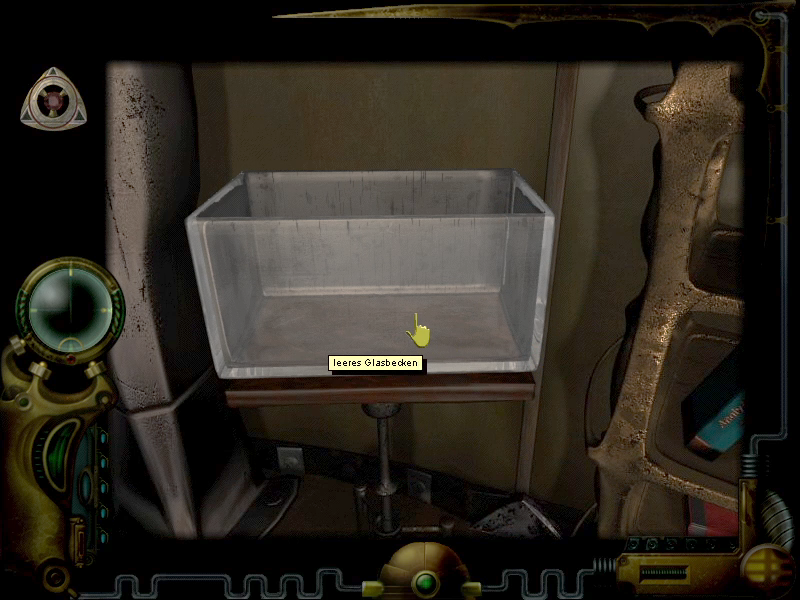 empty glass tank And finally, next to the door, we have a panel like outside.  The only label interactable here is the Zn, so we click it. 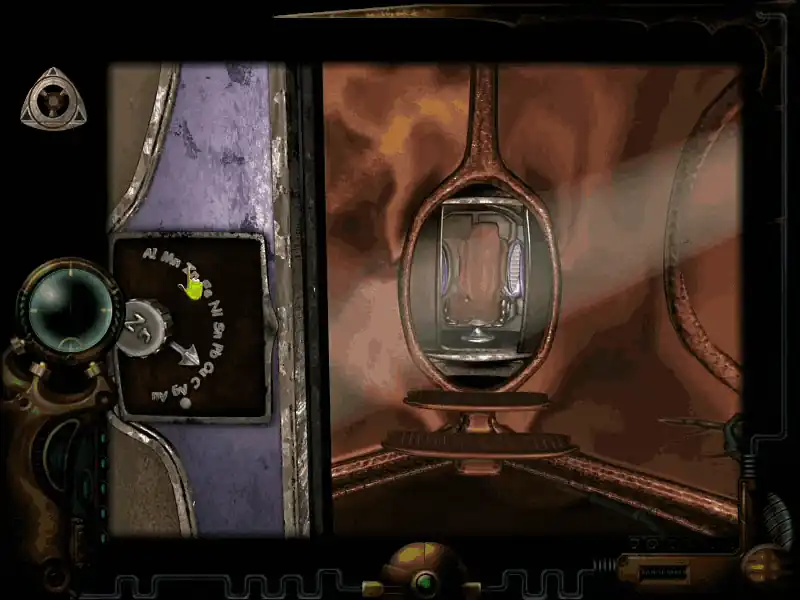  The room goes dark, moves, and lights up again. Everything's the same as before, except we can't leave, and the other light-bulb is burning on the wall. We move the arrow back into the Cu position 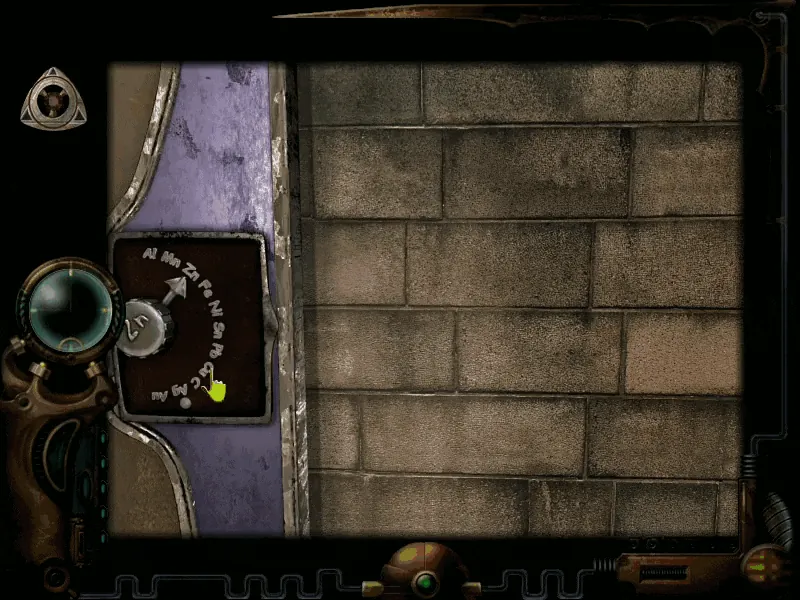 and are able to leave again. 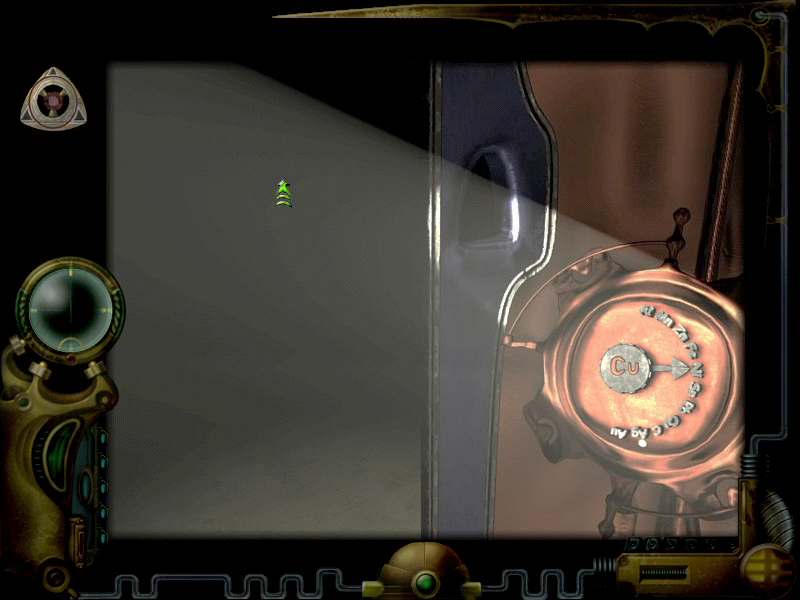 Let's try the next position, Ni. 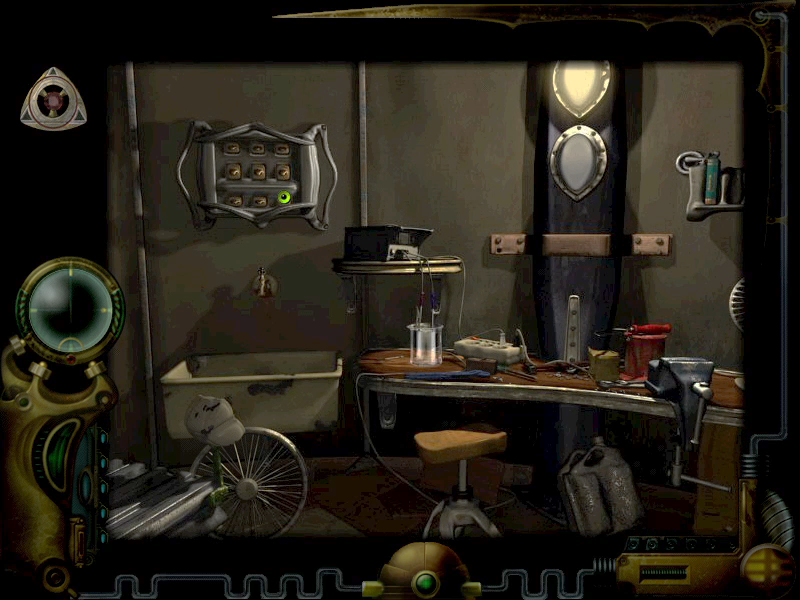 A different kind of lab awaits us, with more things to pick up. 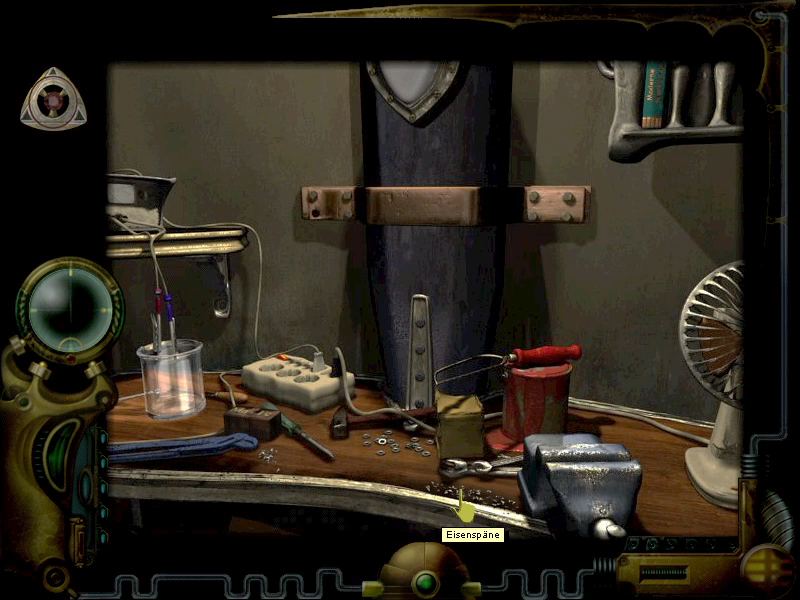 iron filings 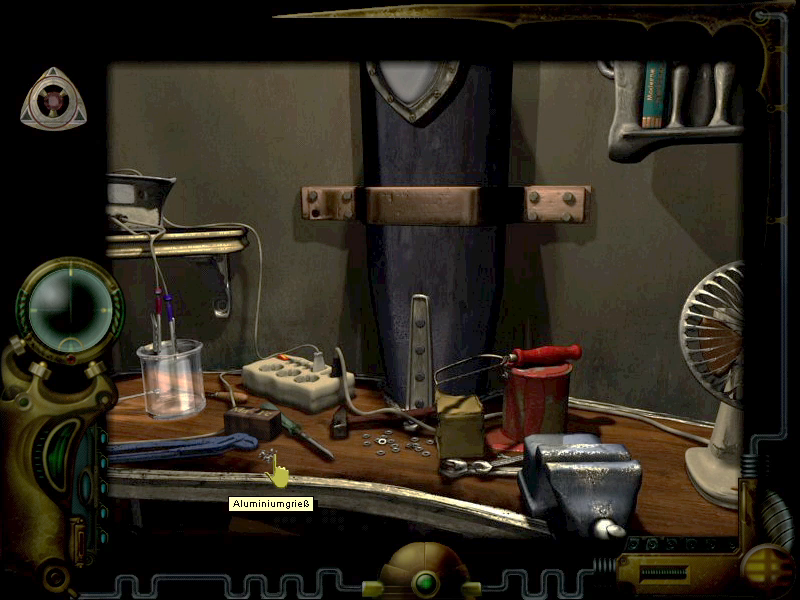 aluminium grits 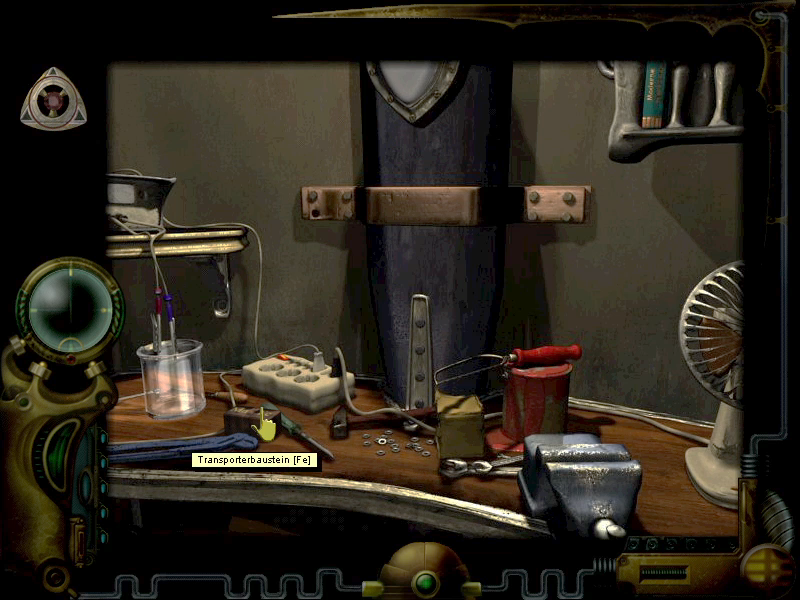 transporter block[Fe] Picked up: iron filings, aluminium grits, transporter block[Fe] 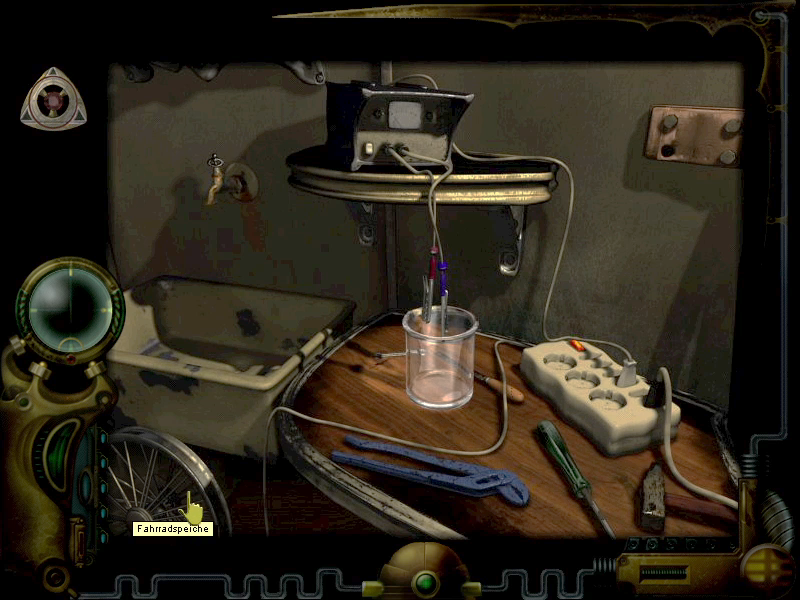 bike spoke Picked up: bicycle spoke 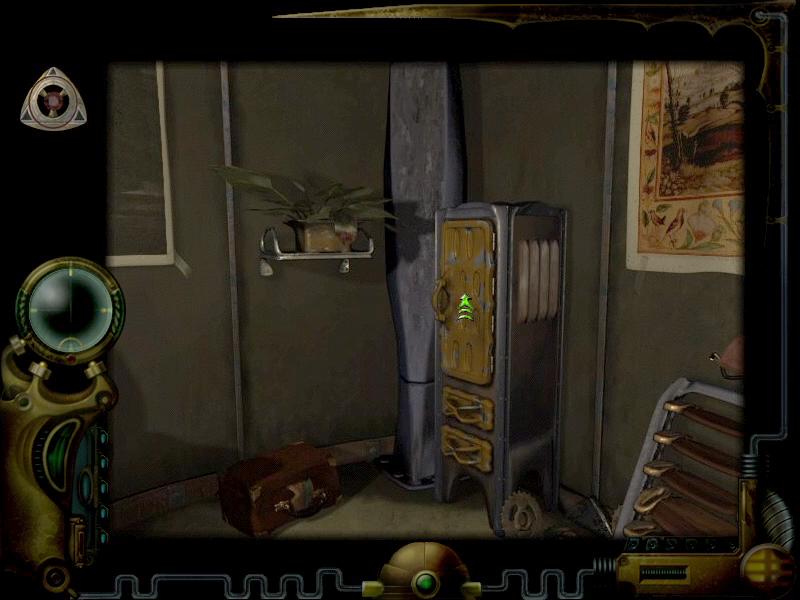 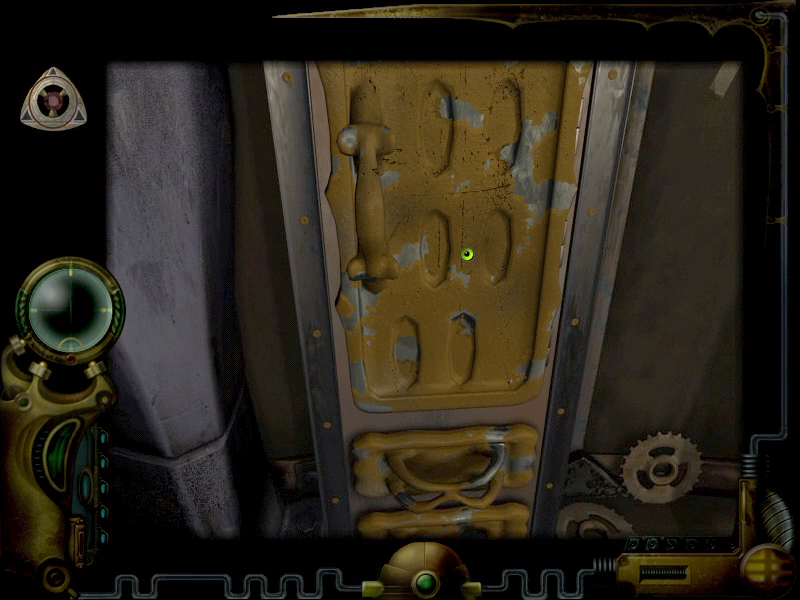 There's a cupboard on the wall the door is on which we also rifle though. 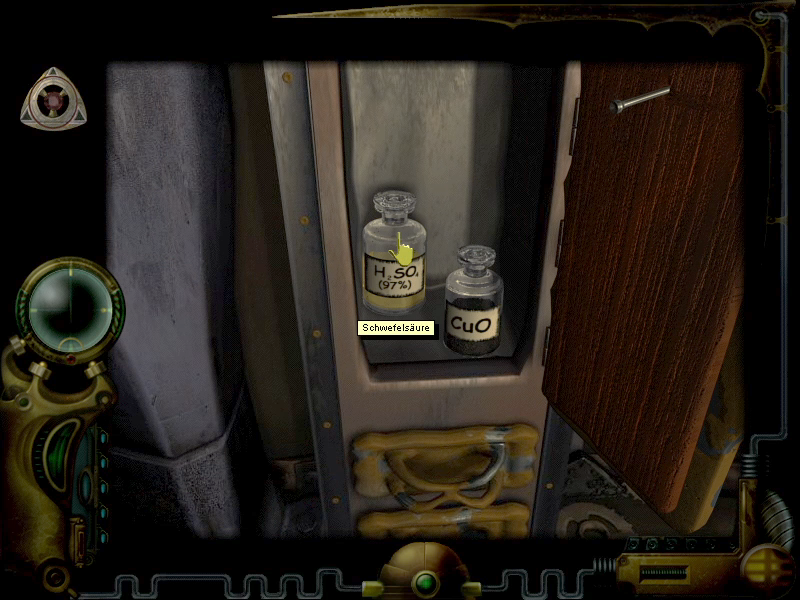 sulfuric acid  copper(II) oxide 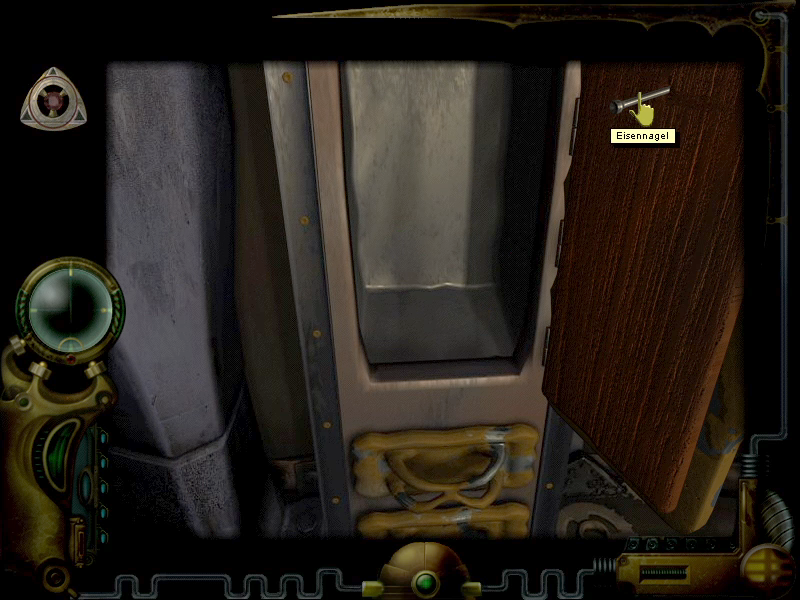 iron nail 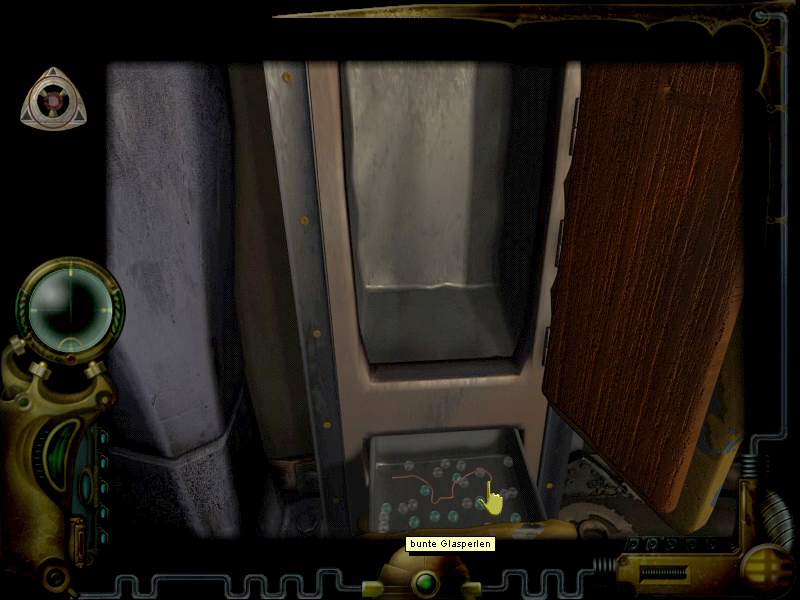 colorful glass pearls 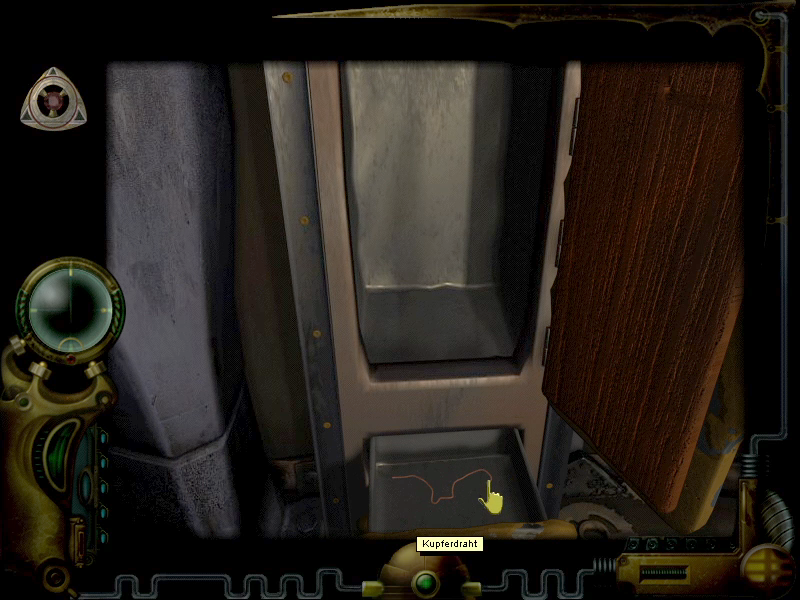 copper wire Picked up: sulfuric acid (H2SO4), copper(II) oxide (CuO), iron nail, turquoise glass pearls, white glass pearls, copper wire Jeez, getting flooded here rather quickly. We'll get to a point to take stock soon, though. There's also a small desk between the cupboard and door, which contains two things: 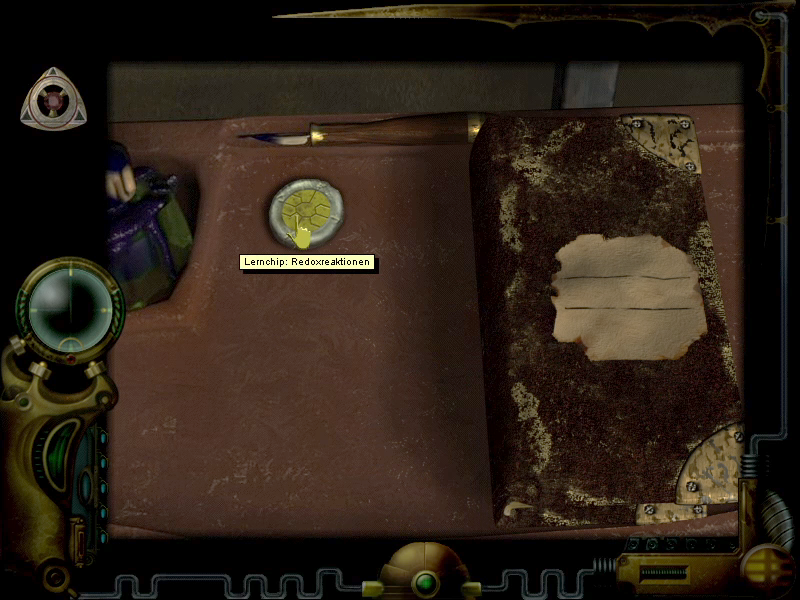 learning chip: redox reactions Picked up: learning chip: redox reactions 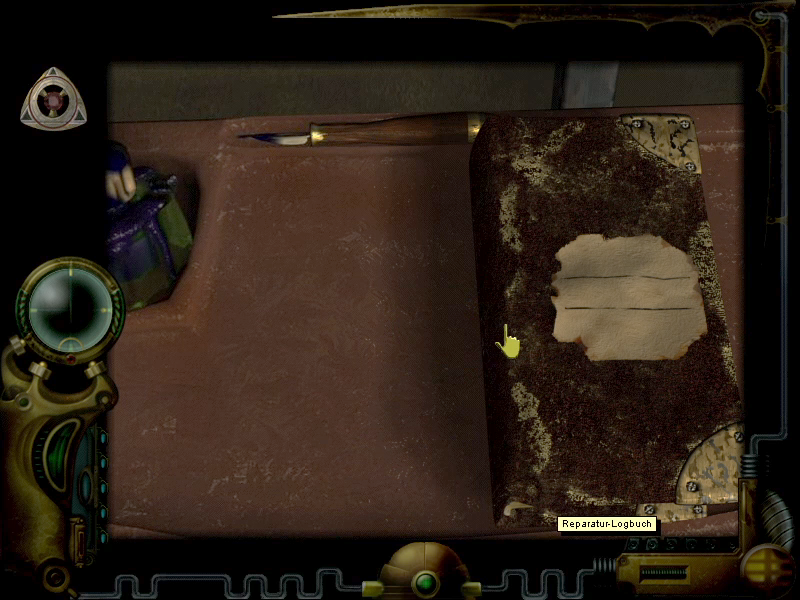 repair log and this book which is more fun text for me to translate, yay! 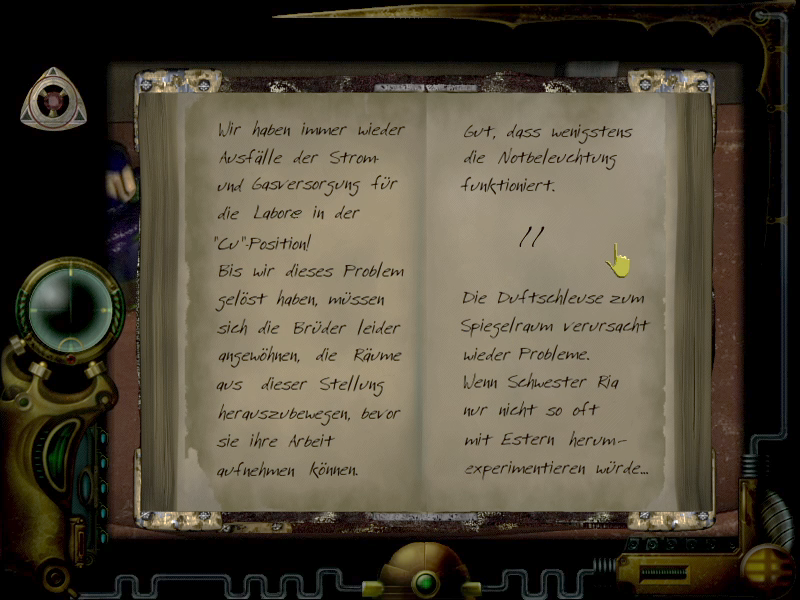 We keep losing power and gas for the labs in the Cu-position! Until we have solved this probem, the brothers will get used to moving the rooms out of that position before they can start their work. At least the emergency lights are working. // The scent lock to the mirror room is making problems again. If only sister Ria wasn't experimenting with esters so much... // Something weird is happening. The communication with the other brothers and sisters is almost impossible. I feel like we're losing track of things. // I must repair Martulia's glass bead bracelet. Without the one missing pearl she won't be able to activate the room of mirrors. I see a lot of work coming up... 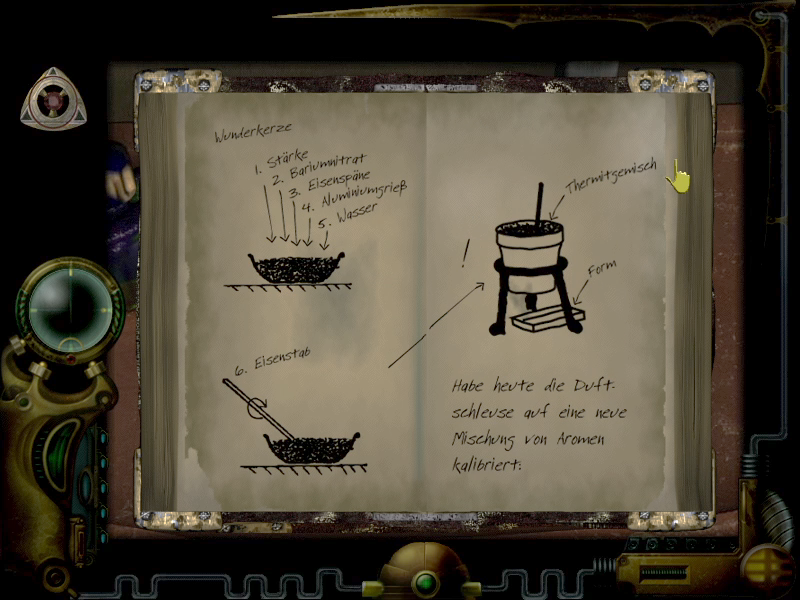 Sparkler 1. Starch 2. Barium nitrate 3. Iron filings 4. Aluminium grits 5. Water 6. Iron stick Thermite mixture Mould I was able to recalibrate the scent lock to a new mixture of aromas: 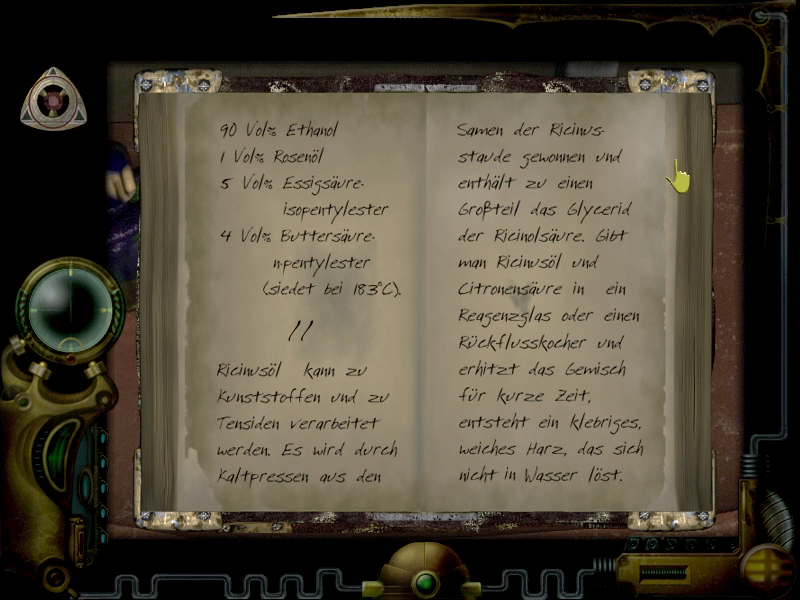 90 Vol% Ethanol 1 Vol% Rose oil 5 Vol% Isoamyl acetate 4 Vol% Pentyl butyrate (boils at 183°C) // Castor oil can be processed into plastics and tensides. It's produced by cold pressing the seeds of the castor oil plant and contains in large parts the glyceride of ricinoleic acid. If you put castor oil and citric acid into a test tube or a reflux cooker and and heat the mixture for a short period, it produces a sticky, soft resin that is insoluble in water. I will be able to use it in my repairs. // After the big explosion we had to move the lab for organic chemistry into the maintenance building for the petrol fractionation. I hope we won't get any problems from integrating the fractional destillation for lab use into the existing plant. I will instruct the brothers that gas supply to the city is only guaranteed at a temperature above 250°C. // Brother Lumin borrowed the projector lamp for his chromatography experiments. As long as the dark room lamp is in the gas plant to be filled, the photo lab is unusable anyways. // It's frustrating: The missing 31st pearl from Martulia's bracelet is nowhere to be found. Our inorganic chemists have assured me that making a new pearl is not a big problem.  To make glass, we use a mixture of the following composition: SiO2 (sand) 14 parts K2CO3 2 parts Na2CO3 3 parts The mixture must be heated to a temperature over 1400°C. When it hardens, a silicon lattice is formed (glass matrix). By adding small amounts of metal oxides, the molten glass can be colored. // c) pane of glass a) AgNO3 b) glucose warm water 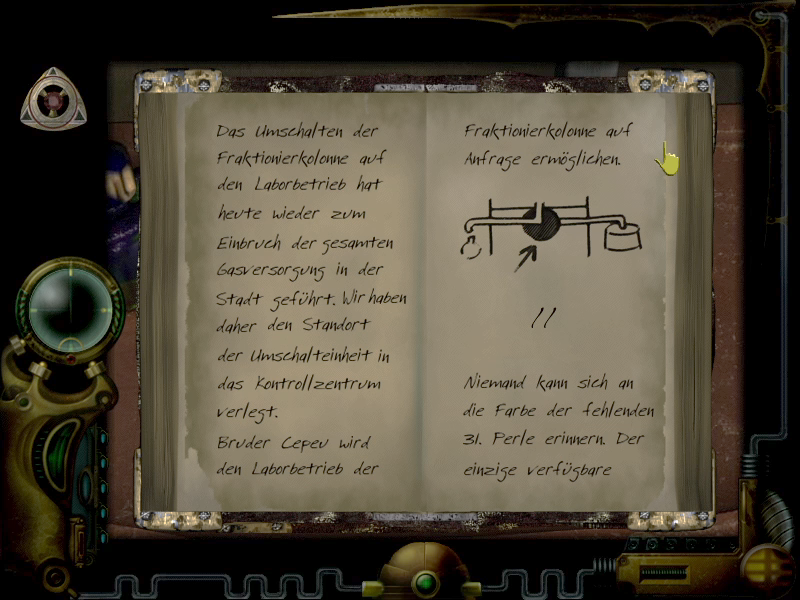 Setting the fractionating column to the lab mode has led to the entire city losing its gas supply. We have accordingly moved the place to switch between modes into the control room. Brother Cepeu will allow for using the lab mode of the fractionating column on request. // Nobody can remember the color of the missing 31st pearl. The only available hint from the diary of the builders was make unintelligble though a knocked over inkwell when moving the organic lab. Sister Ria is conviced that the color should be deducible from the molecule models...if we could get rid of the ink stain. // It's strange: We cannot do even the simplest of tasks anymore because we cannot remember. It seems as if all our knowledge was erased. I'm afraid the big neural network is collapsing. Maybe this is my last entry... And that is the last entry. Lots of chemistry that I'm sure is totally incidential and has nothing to do with any upcoming puzzles. There are two more things to look at here. 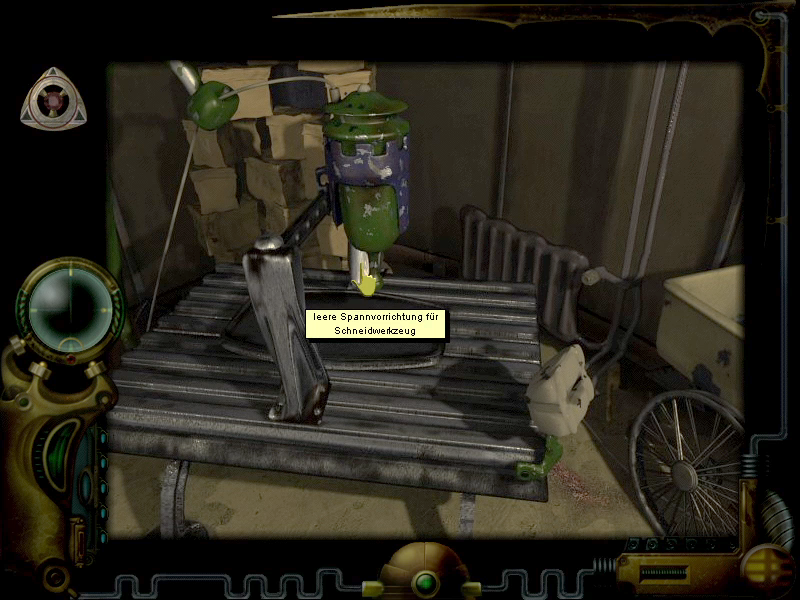 empty clamp for cutting tool  working surface of the CNC-glass cutter 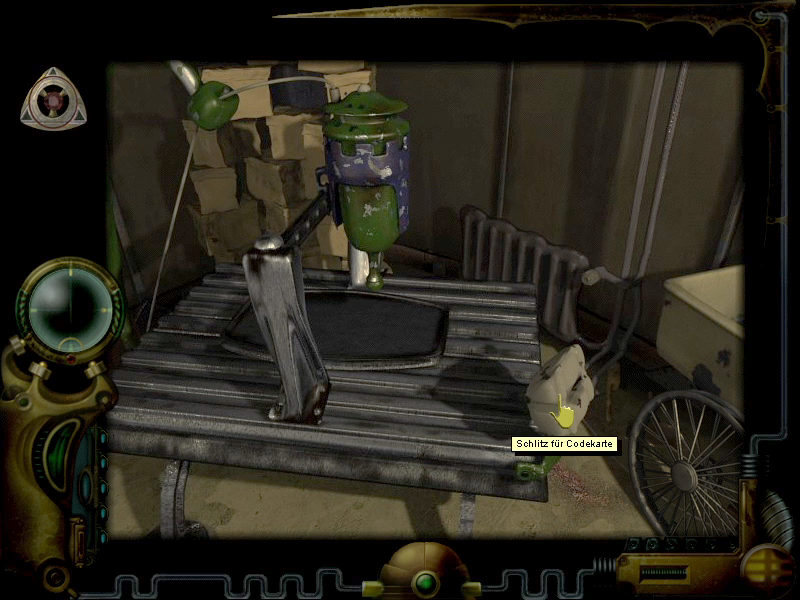 slot for code card 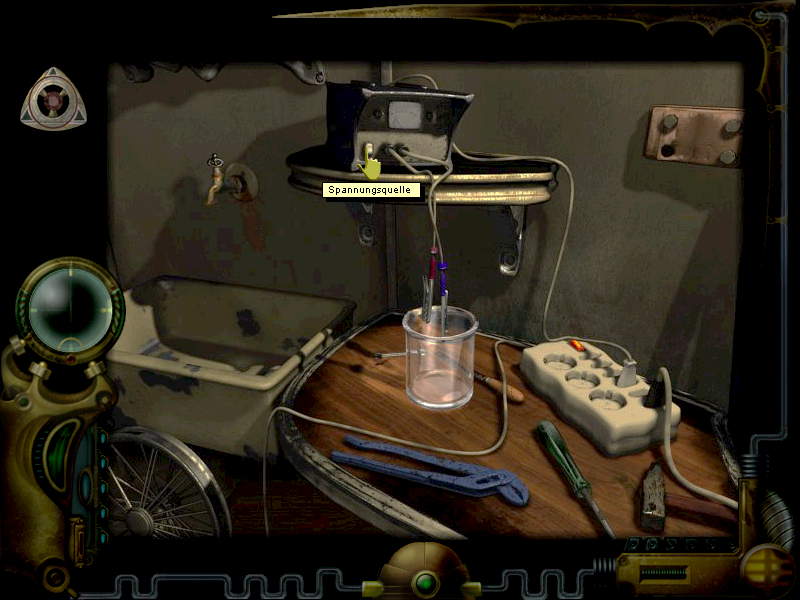 voltage source 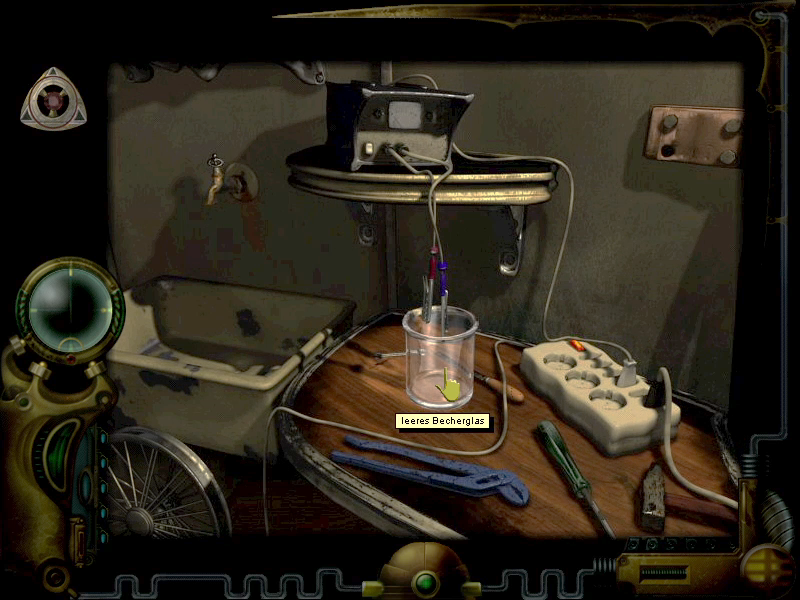 empty beaker Okay, so that big book up there mentioned that the labs have no energy in the Cu position, which gives me the hint that we should try moving this lab into another position. I do just that, moving it to the Ni position... 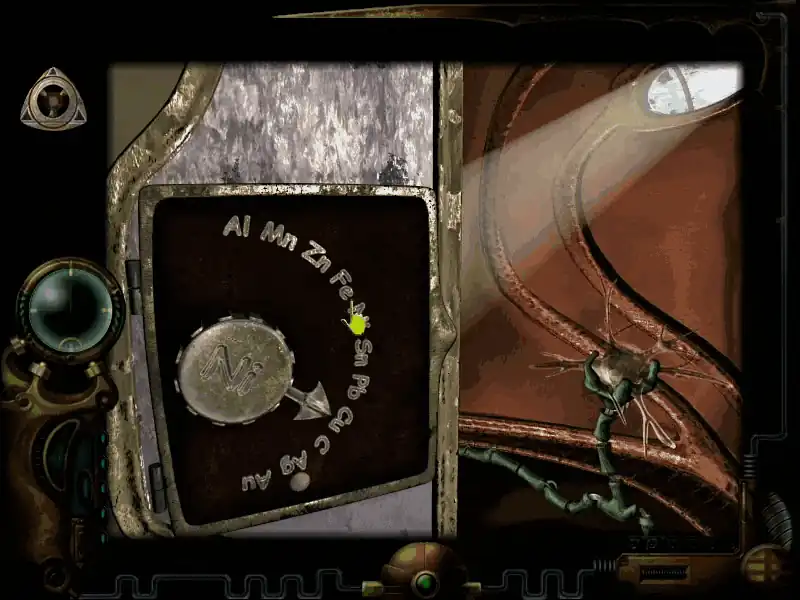 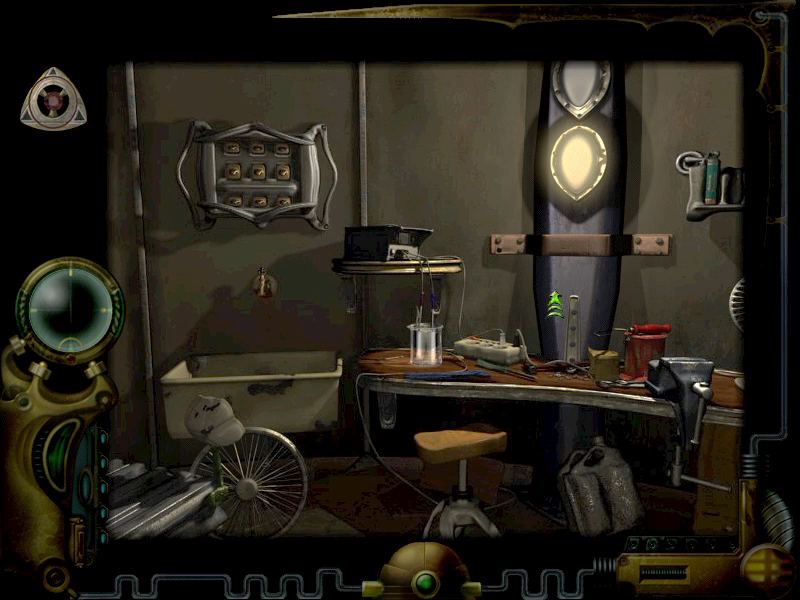 Alright, so the lower lamp turned on, as in the previous lab. After rifling around a bit, we find nothing obvious and new, so I decide to check out the last lab... 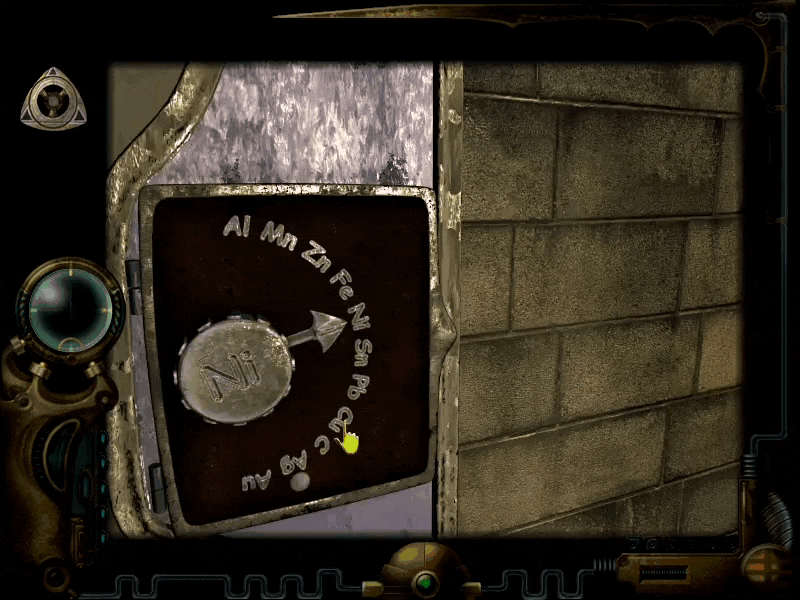 uh oh. Okay, so apparently, we're now trapped in here, the thing doesn't move. We can, however, open this panel, and look at the mechanism behind it. 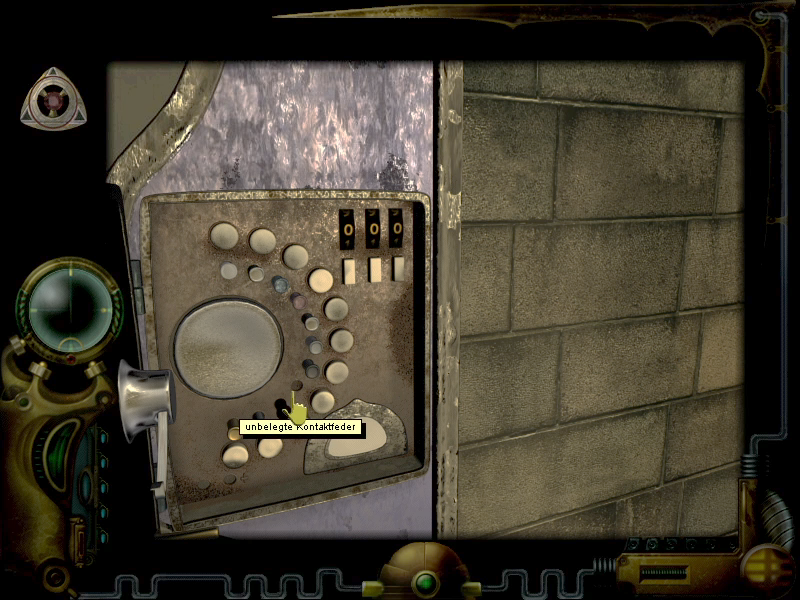 unfilled contact spring 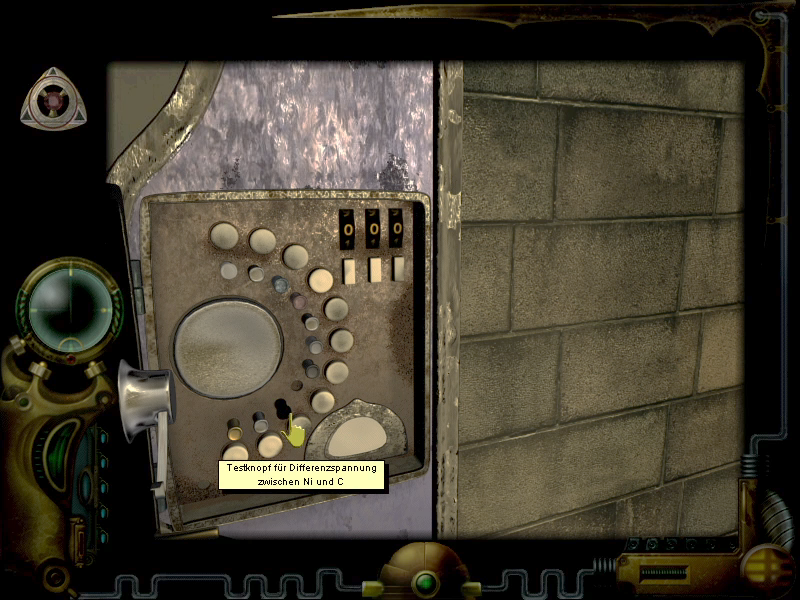 testing button for difference voltage between Ni and C 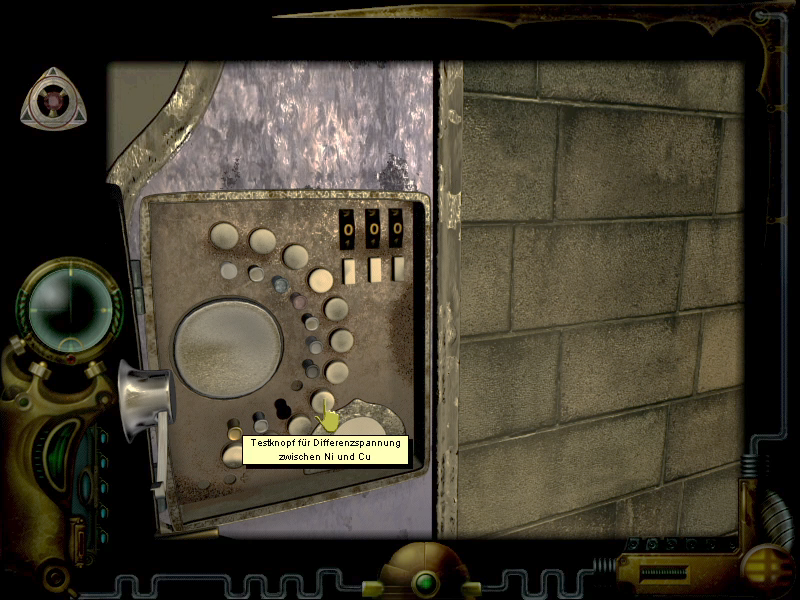 testing button for difference voltage between Ni and Cu 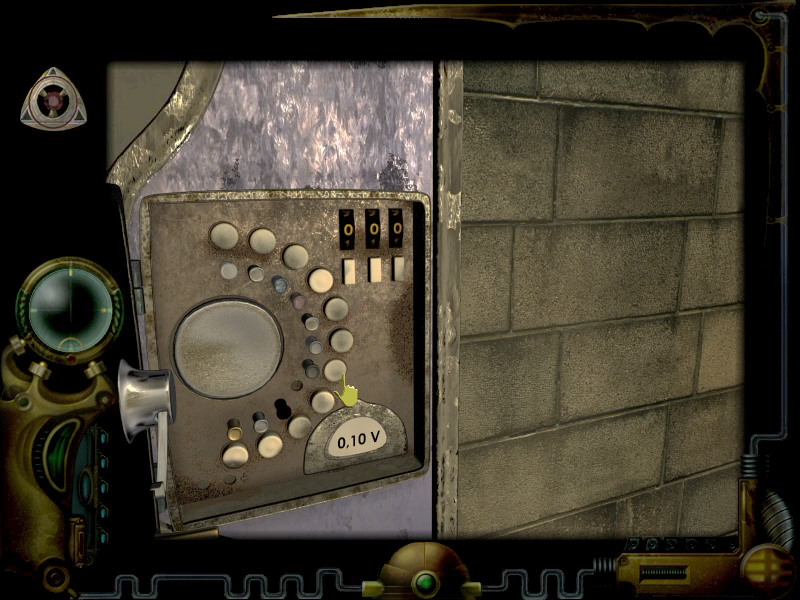 We can hit the different buttons and get different voltages in the bottom right. It seems we need to fill this contact spring, which is next to the testing button for the difference between Ni and Cu, with a proper thing to be able to leave here again. And that's the next puzzle for you guys to ponder. We naturally have everything we need in the metric fuckton of items we picked up, so I'll give you the rundown again. For interactables in the current room, we have the cupboard, the book, the CNC cutter and that beaker with the voltage source, plus the different parts in that panel we're trying to fix. Since we cannot go elsewhere, the solution must be in here. So why don't you have a go at it? I'd consider this a bit harder than the first one we did, but with less moon logic, so maybe try to think what that panel needs to be fixed first, and then consider how we can use chemistry to build what we need (it should go without saying that most of the things in our pants-lab do not actually contribute to this particular puzzle) Inventory: bicycle spoke copper wire white glass beads turquoise glass beads iron nail copper oxide (CuO) sulfuric acid (H2SO4) transporter block [Fe] aluminium grits iron filings nitric acid (HNO3) barium nitrite (Ba(NO3)2) transporter block [Al] dregs of snow steel worm wheel broken glass prism amphora with lemon juice ultrapure water Knowledge gathered: Energy and environment Electrochemistry Metals Salts Redox reactions Unlocked areas: Ti - Electrolysis/Control Room Cl - Swimming pool H - Tower base Pb - Volcano Cu - Labs Maki fucked around with this message at 09:11 on Aug 2, 2023 |
|
|
|
Holy item and info dump. Anyway, two notes: - In English, the branch that deals with compounds that don't contain carbon-hydrogen bonds is usually called "inorganic", not "anorganic". - I literally have no idea what I was supposed to see in that cutscene where you said someone disappeared in the bushes. After you open the door I don't see anything move. For the puzzle, the difference in standard electrode potential between Ni and Cu when it reacts to 2+ is about 0.60V, between Ni and Cu when it reacts to Cu(1+) is 0.78V. I'm not entirely sure what the puzzle wants from you, like at first sight it looks like you should just stick a piece of copper in, but you already got copper wire so that would be trivial. With the voltage source and the chemicals you have you definitely have some way to make elemental copper from the copper oxide but I don't see how that helps when we already have copper wire.
|
|
|
|
I don't know what we want to do for this puzzle, but I can already see us making red glass to fit over one of the two lab lights so we can develop photos later.
|
|
|
|
Carbon dioxide posted:Anyway, two notes: Fixed the inorganic chemistry. As for the cutscene, I might have set the pause at the end of the animation too long. Here's the looping version without a pause, does that help? 
|
|
|
|
Yep, now I see it. 
|
|
|
|
Update Be - Electrochemistry, but without the drug use Last time on this show we traveled around a bunch, nicked every thing we could and now are carrying a lot of chemicals around. Whether this is a Death Stranding sort of situation or whether we are wearing the bulkiest pants known to mankind, I will leave up to your imagination, the game never confirms it one way or the other. For our thieving ways, however, the game punished us and trapped us in the Ni lab. We checked the elevator panel and found a contact spring associated with the Cu button missing something, clueing us in that something to do with copper is afoot. Carbon dioxide posted:For the puzzle, the difference in standard electrode potential between Ni and Cu when it reacts to 2+ is about 0.60V, between Ni and Cu when it reacts to Cu(1+) is 0.78V. I'm not entirely sure what the puzzle wants from you, like at first sight it looks like you should just stick a piece of copper in, but you already got copper wire so that would be trivial. CO2 got the most important points here: We need to get a piece of copper to jam in there, and we can make it with the voltage source and some chemicals. The part the game doesn't telegraph very well (I feel like I've said that before) is what copper it will and won't accept. The goal the game expects us to guess is: We need something like a stick or a nail, a solid piece of copper, that fits into the opening in the panel. We have actually picked up a nail, but it's iron instead of copper. So what we need to do is to use our chemistry skills to electroplate the nail with copper. I will explain how that works once we've set it up, for now, just know we need the following things: a) A source of positive copper ions b) voltage to make the copper ions deposit on the iron nail. So, with that in mind, let's step over to the bench and make some copper ions. To that end, we fill the beaker with copper (II) oxide 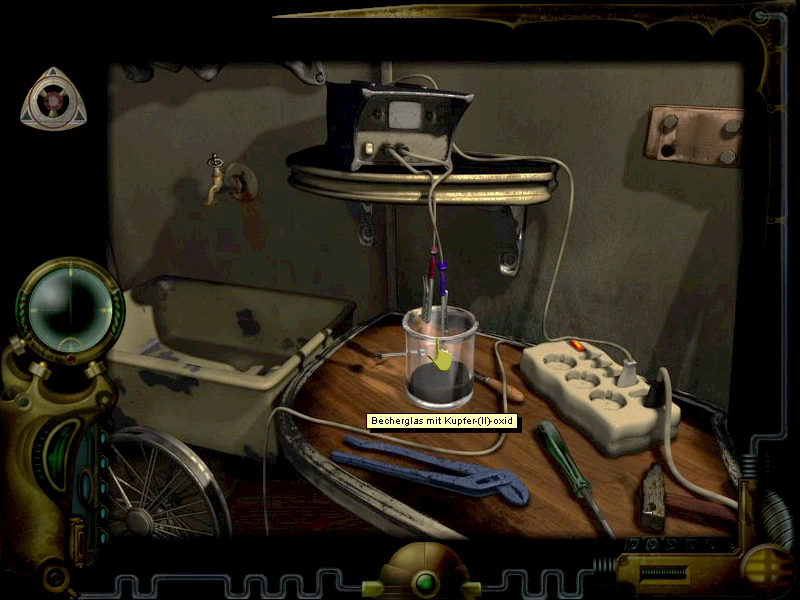 beaker with copper (II) oxide and sulfuric acid 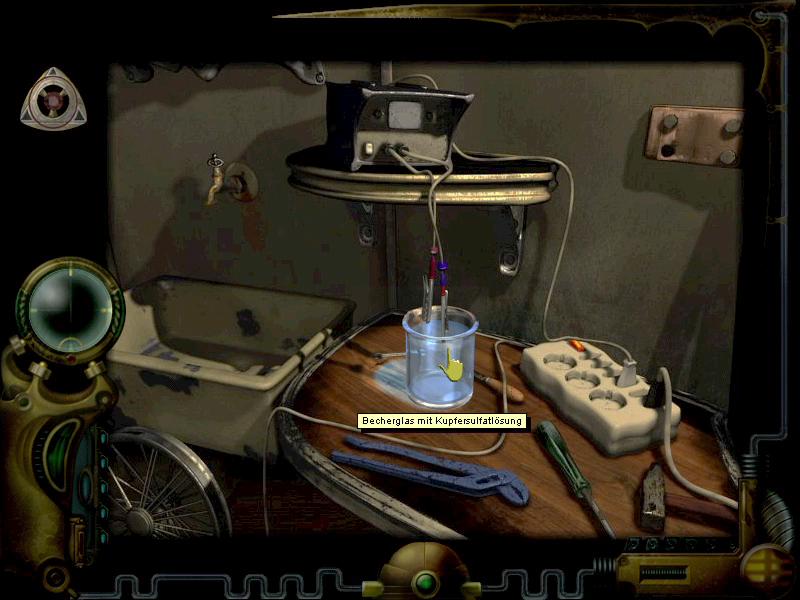 beaker with copper sulfate solution Here, we get a chemical reaction of the copper oxide with the sulfuric acid forming copper sulfate and water. CuO + H2SO4 → CuSO4 + H2O The copper sulfate readily dissolves in the water, splitting up into copper ions Cu2+ and sulfate ions SO42-. The nice blue color happens because Cu2+ ions in contact with water form a complex with it, which is blue. So this gives us the copper ions that we need. Now we need to get the iron nail into this solution, and since we know we'll need voltage, we can clip it on the cathode (negative side) of the voltage source 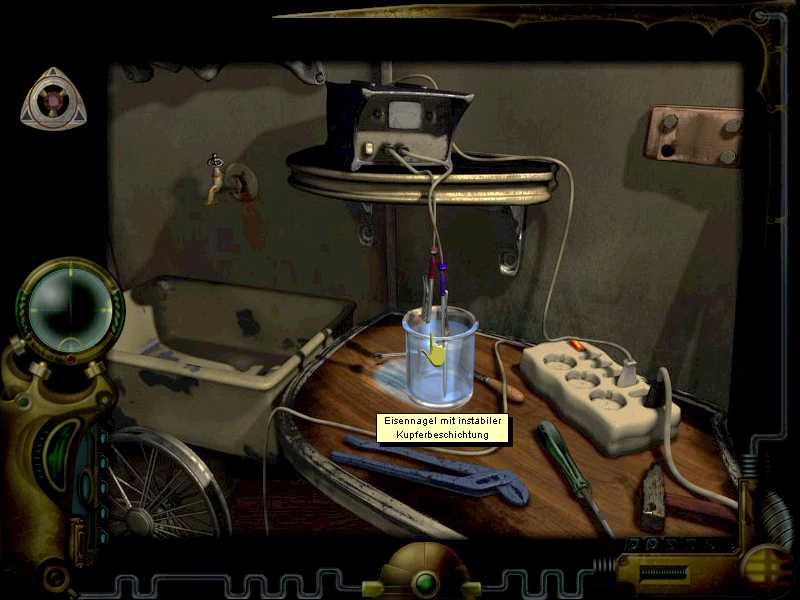 iron nail with unstable copper plating This already causes some copper ions to deposit on the iron nail, but this isn't nearly enough to give us a good plating. To be able to properly plate it, we need to run a current through this thing, so we need a corresponding anode (positive side) as well. 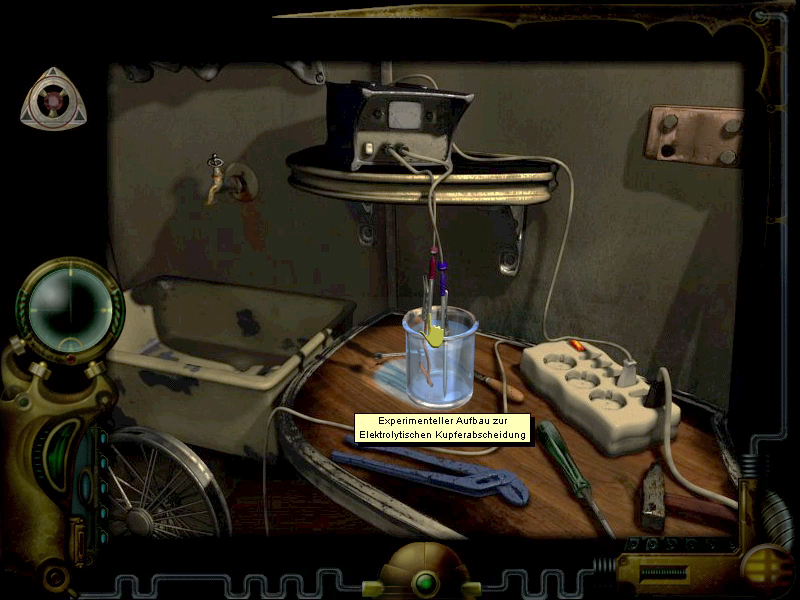 experimental setup for electrolytic copper deposition This copper wire we found should do the trick, and we actually want something out of the same element that we're trying to plate the nail with. Now it's time to turn on the voltage source and see what happens 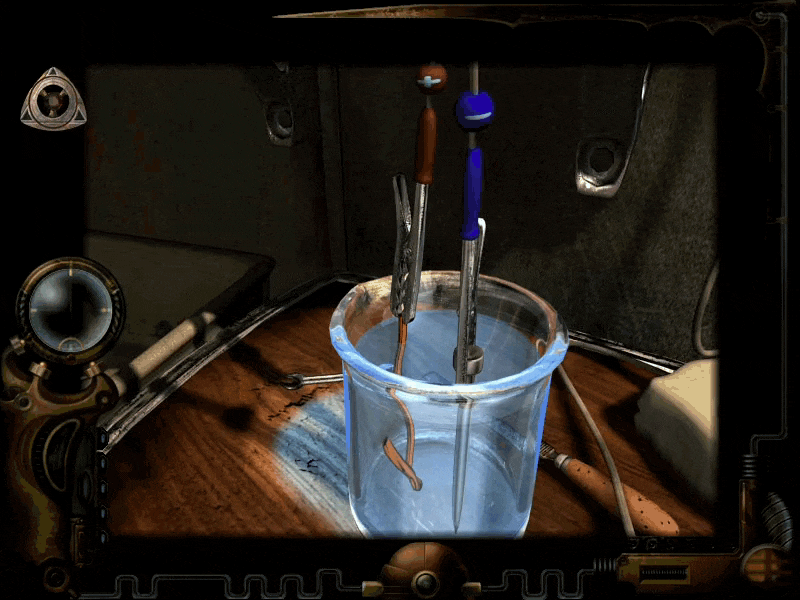 Bubbles appear on the copper wire, and the nail takes on a coppery tint. To try and explain what's happening here: The voltage source induces a positive charge on the copper wire and a negative charge on the iron nail. The charge on the nail attracts the positively charged copper ions, which gather around the iron. The negative charge means there's an excess of electrons on the iron nail, which get absorbed by the copper ions to form elemental copper. Cu2+ + 2e- → Cu The elemental copper cannot stay in solution and deposits on the iron, forming a solid shell on the outside. This is electroplating. The bubbles, I will have to admit I'm not 100% sure about, but what I think is happening is that in theory, the sulfate ions would also be attracted by the positively charged copper wire and its deficiency of electrons, but sulfate ions hang on to their electrons fairly tightly, I think. For this to work though, electrons need to be pulled out of the anode at the same rate as they are put into the cathode, so something else has to give electrons there. Now, we do have copper there, so the reverse of the reaction above can take place Cu → Cu2+ + 2e- That doesn't explain the bubbles though. The only thing we've got left is water, which can give up electrons with the following reaction: 2 H2O → O2 + 4 H+ + 4 e- Two water molecules are electrolysed into an oxygen molecule, four hydrogen ions, and four excess electrons, which form in a mix with the copper ions to balance the copper reaction happening on the cathode. I could be wrong about this though, if you've got a better idea (maybe the sulfate is decomposing into oxygen and sulfur dioxide?) feel free to speculate. Whatever it is, eventually, we finish the reaction. 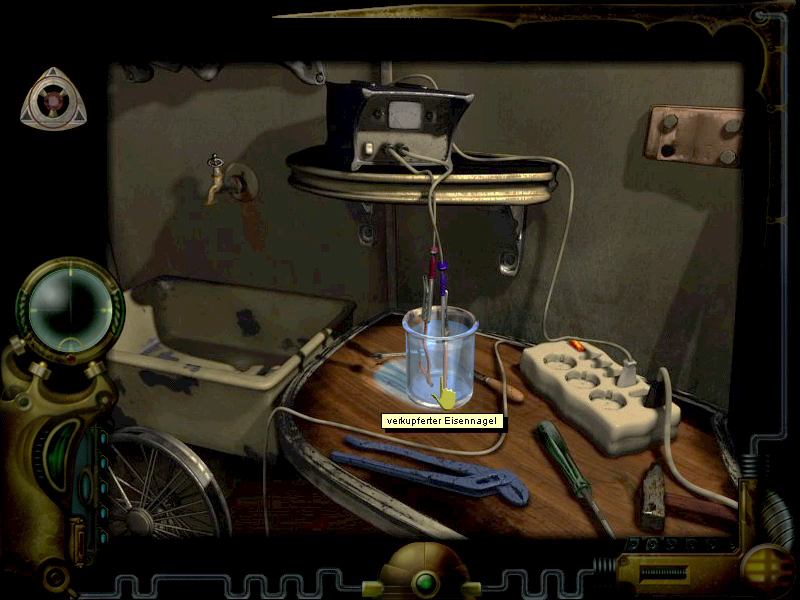 copper plated iron nail And we got what we need. Lost: copper wire, iron nail, sulfuric acid Picked up: copper plated iron nail (note that the copper(II) oxide stays with us) 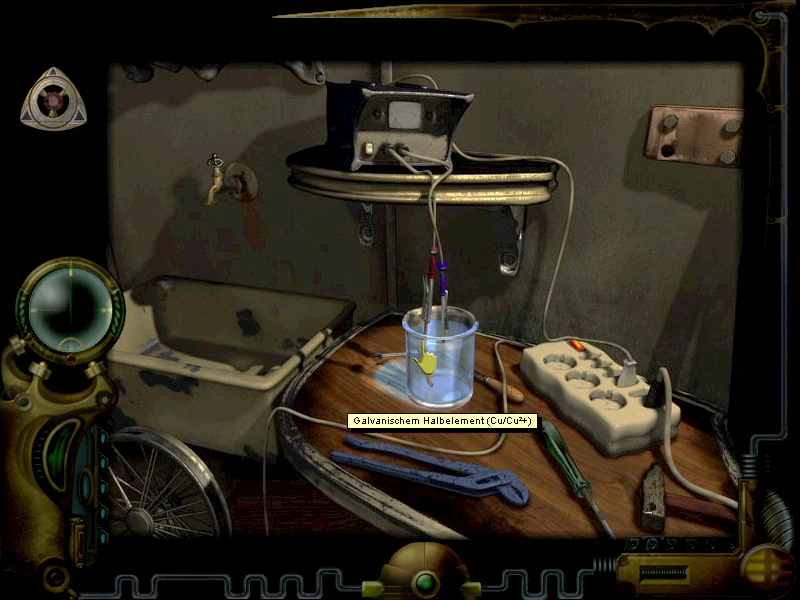 galvanic half-cell (Cu/Cu2+) Alright, so the game leaves us with the information that what we have left is a galvanic half cell (though it has a grammatical mistake, it should be "galvanisches" instead of "galvanischem"), so I guess I should say a few words about that concept as well? Basically, with a slightly different setup, we could've run a reaction like this, but in reverse. This means we would've had ions moving around, but instead of them being moved by voltage induced from the outside, they move on the own and induce their own voltage which can be picked up outside. With this, you need two separate but connected halves that contain, for example, a metal electrode and a solution of the same metal's ions. Each of these halves has a different inherent electrical potential, which is basically defined by how much the metal's atoms like to be ions or not. Copper, for example, likes being elemental more than zinc does. So if you connect one of these half cells made with copper (like the one we have here) and a similar one consisting of a zinc electrode and a zinc sulfate solution in the right way, copper ions are going to deposit with the copper and take electrons from the zinc electrode, which is slowly dissolved into zinc ions. The electrons move through an outside wire connecting the electrodes, and this is a galvanic cell. Congratulations, you've built a battery! Anyway, that doesn't need to concern us, we're just here for the nail. We jam it into the elevator controls 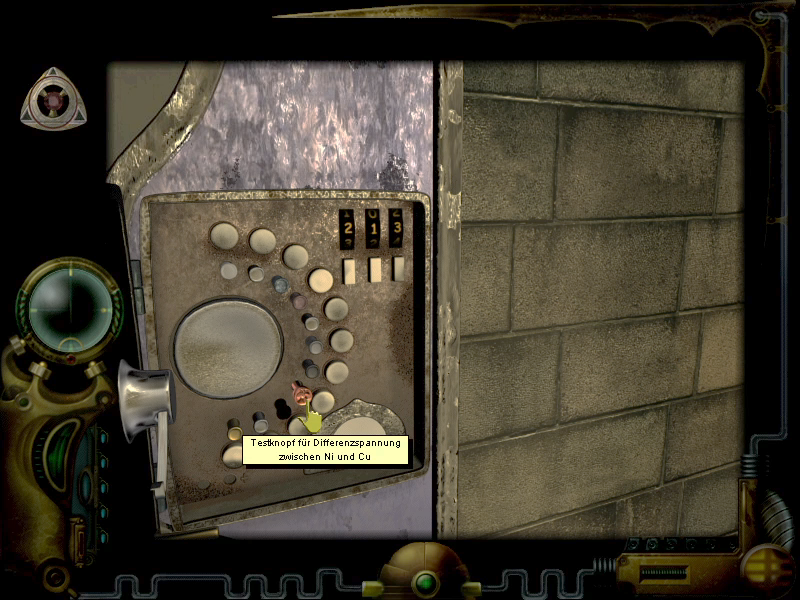 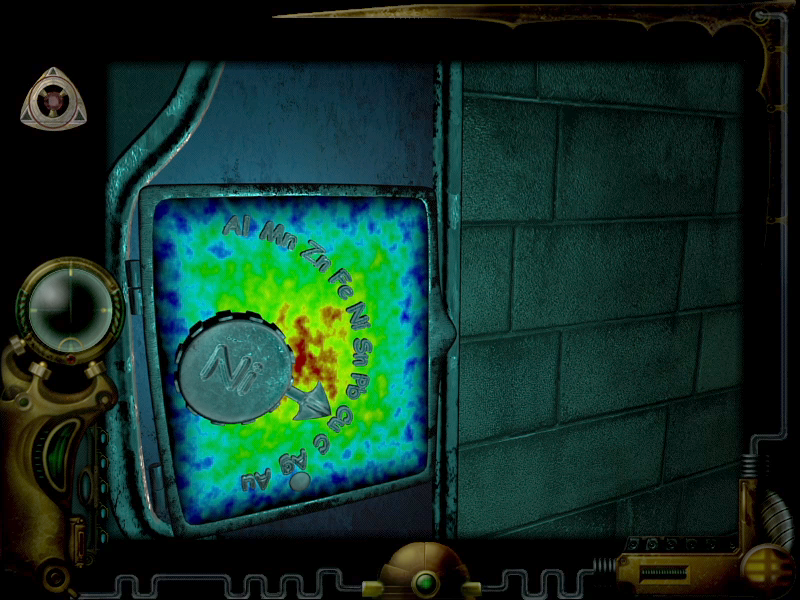 and the elevator properly carries us back to the Cu floor. Lost: copper plated iron nail We aren't done in this location yet, because there's still the Ag lab to check out. 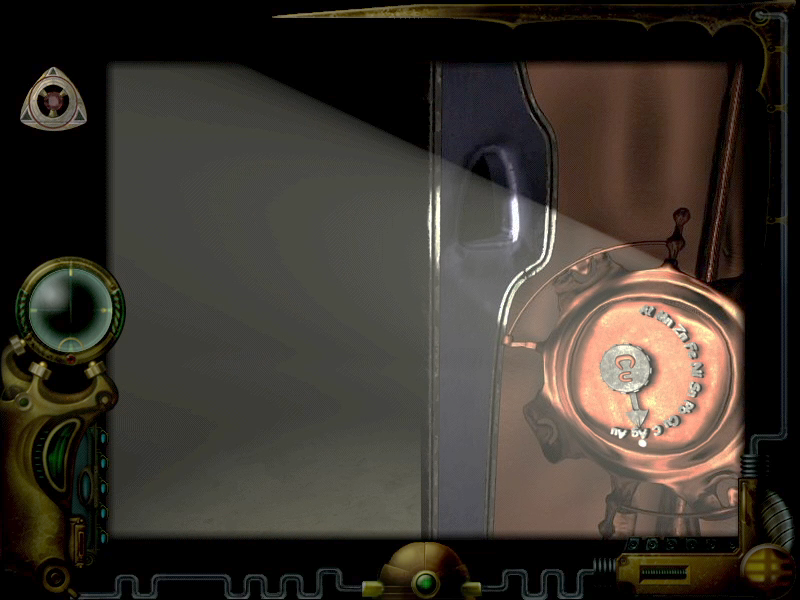  And this is what it looks like. You know the drill by now, it's pilfering time! 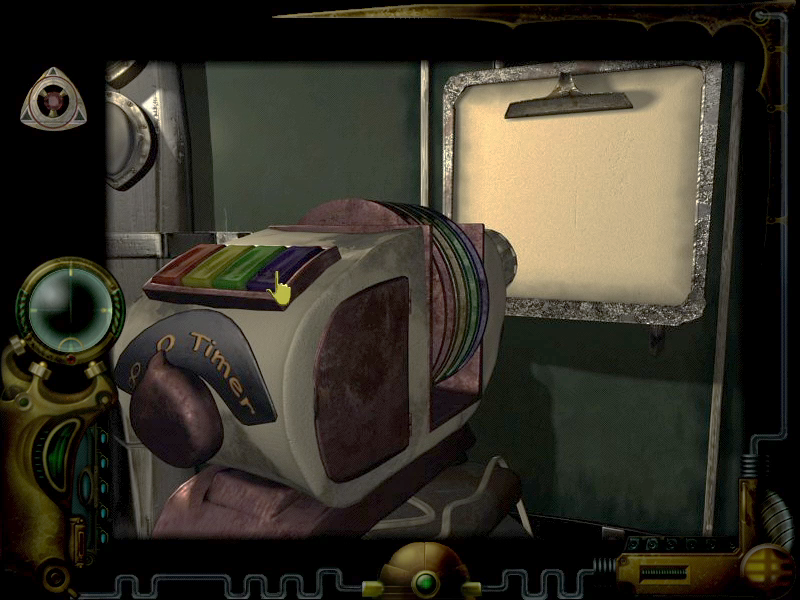 First, there's this thing. The buttons up top can be pushed, but seem to do nothing. 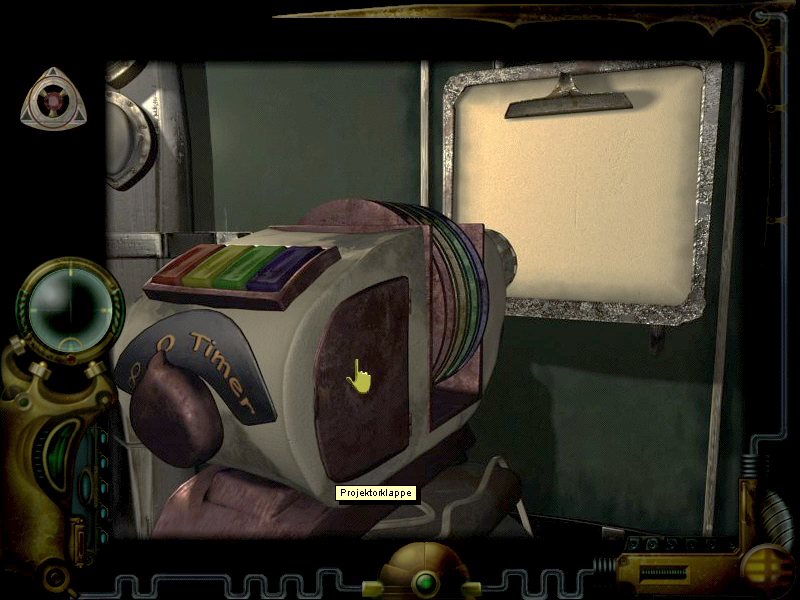 projector lid We can interact with this lid on the side  empty bulb holder and view an empty space where a light bulb seems to go. 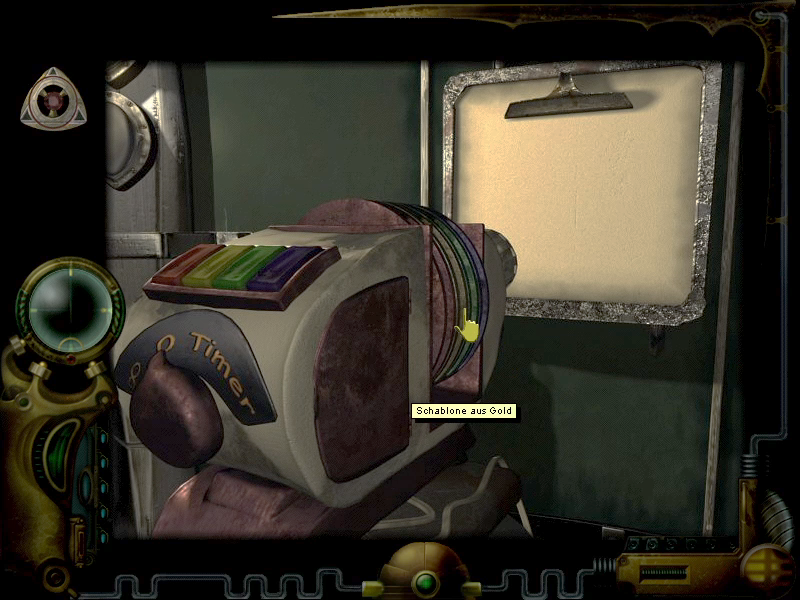 golden template Finally, this middle part contains something we can pick up, though the actual item can't be seen in the scene 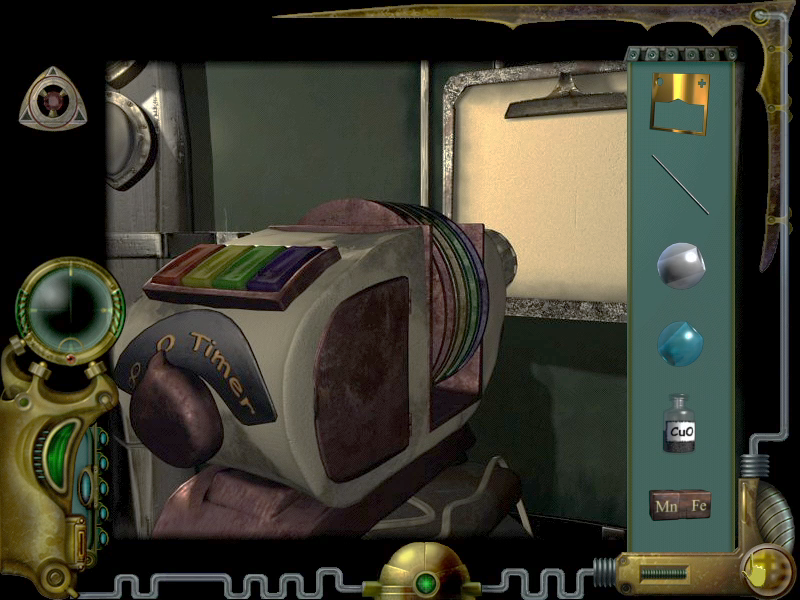 so here it is in our inventory. Picked up: golden template 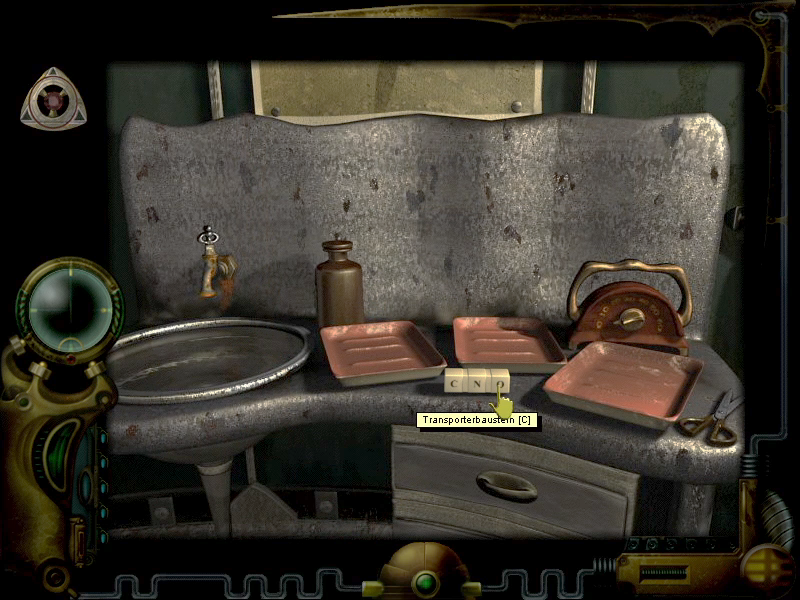 On the left, there's this work table with a familiar object Picked up: transporter block [C] There's also these three bowls 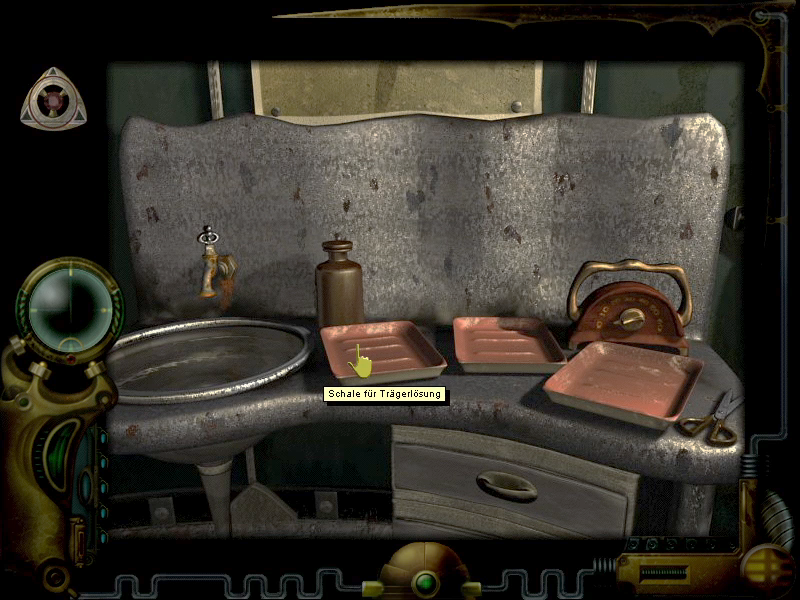 bowl for carrier solution 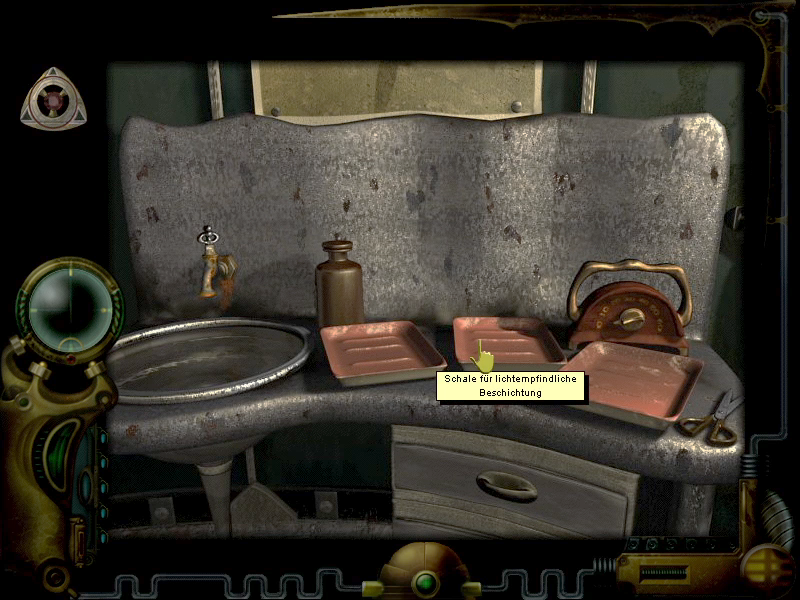 bowl for light-sensitive coating 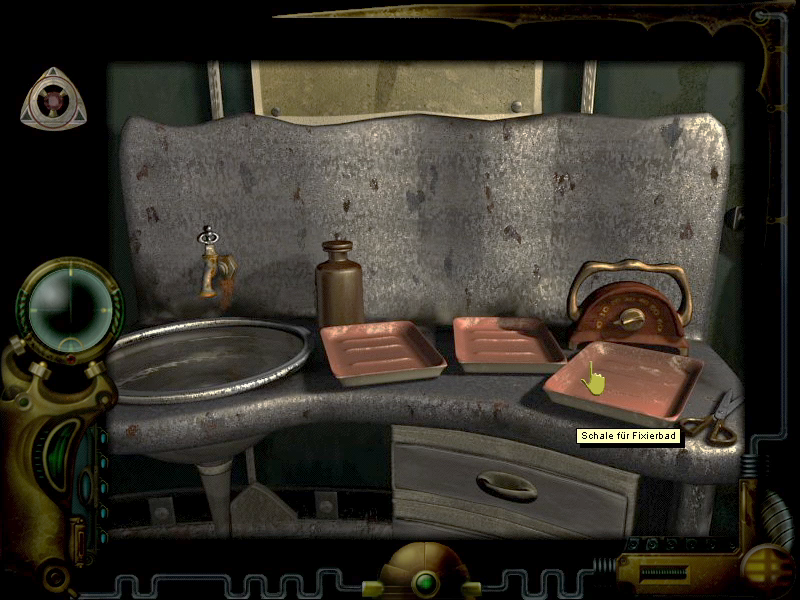 bowl for fixing bath Below this table, there's also a drawer 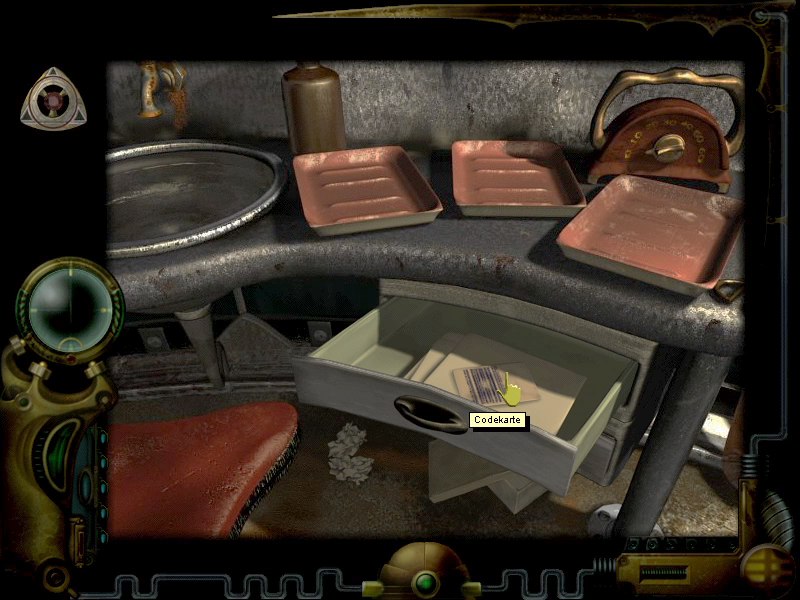 code card 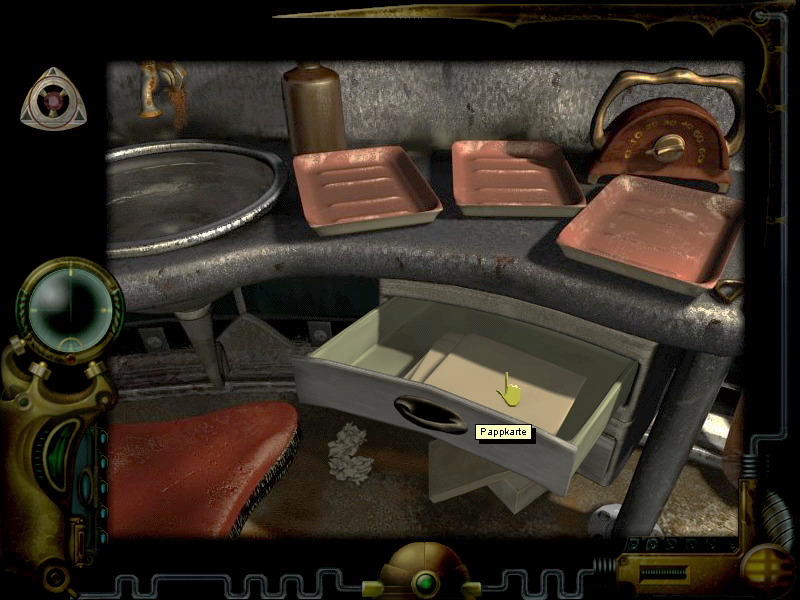 cardboard Picked up: code card, cardboard We can also investigate the currently turned off second lamp 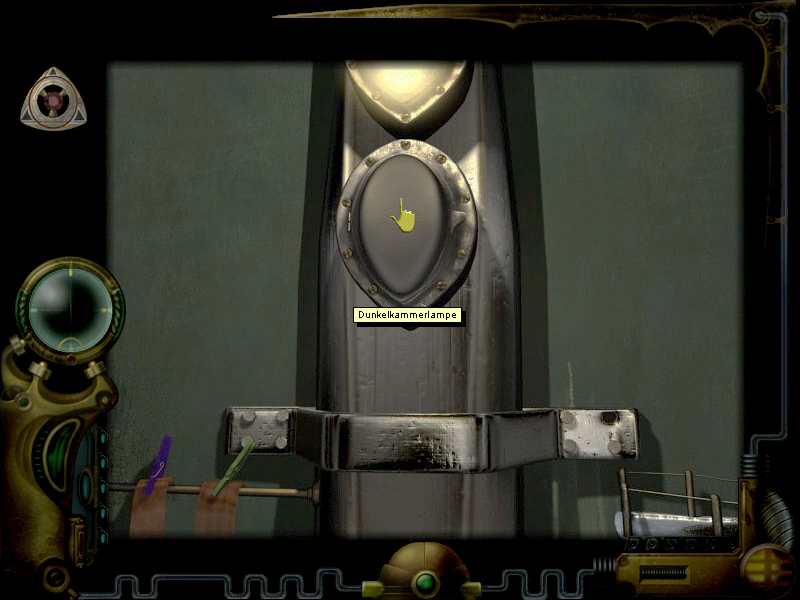 dark room lamp 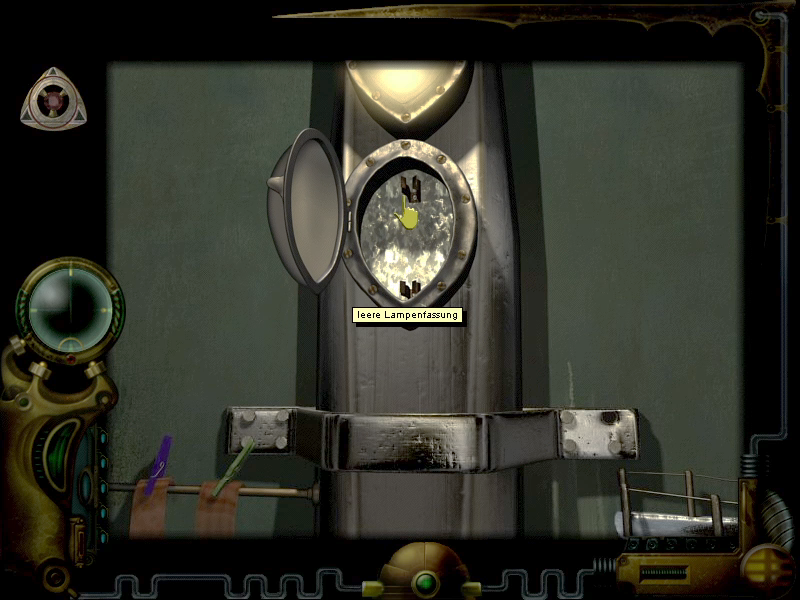 empty bulb holder Nothing in here right now. Of course, the serious bulb shortage occurs in the lab where the bulbs are actually interactable. Anyway, there's also a cupboard in here 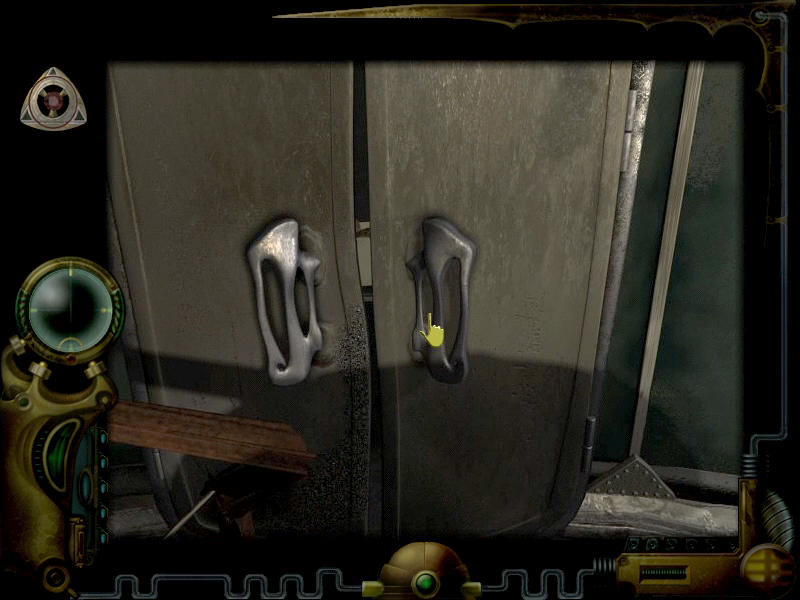 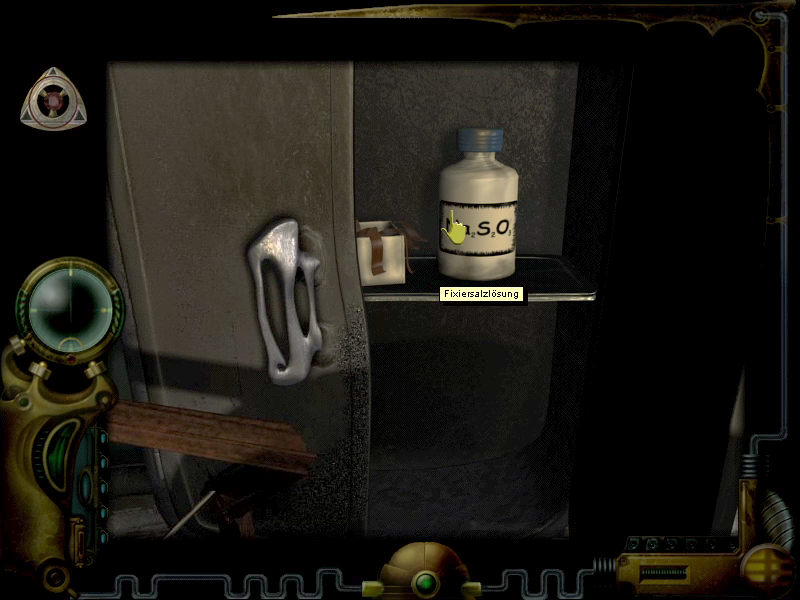 fixing salt solution Picked up: fixing salt solution(Na2S2O3) The last thing to do is to move the lab into the Ag position 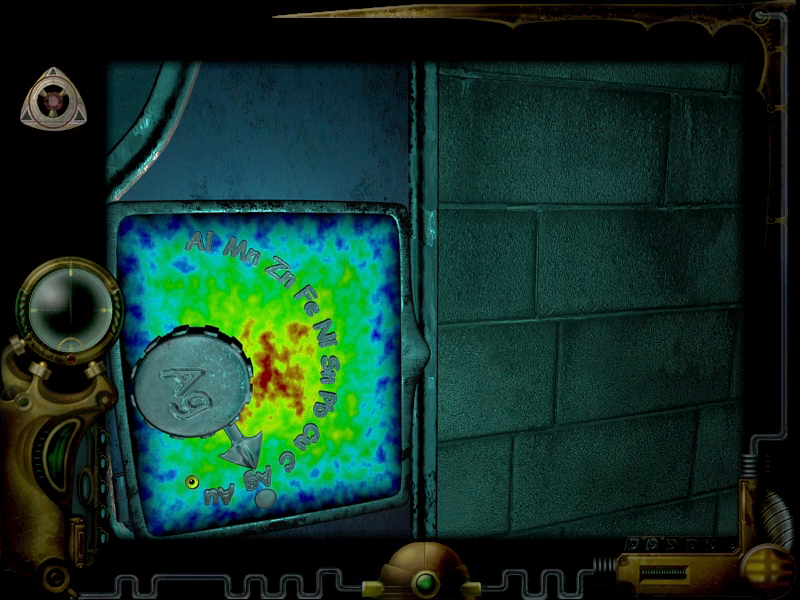 but expectedly, no light turns on, and the game doesn't allow us to turn around in the dark, so we're forced to just move back to the Cu position. And that's all for this particular place, but we've picked up three more transporter blocks, so we've got more places to check out. 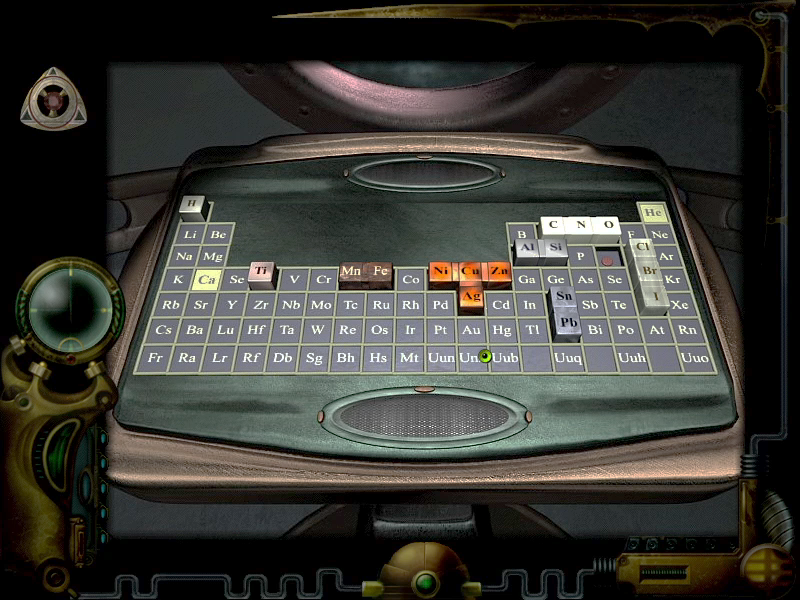 Only one button missing, and if you've got some familiarity with the periodic table, you can guess that that button will probably be sulfur. Anyways, time to explore further. For no particular reason, I pick the Fe block first. 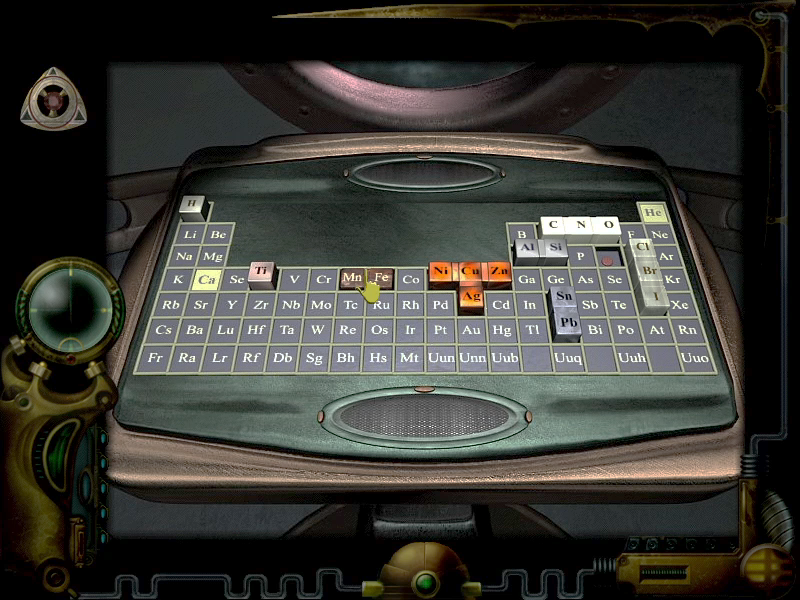  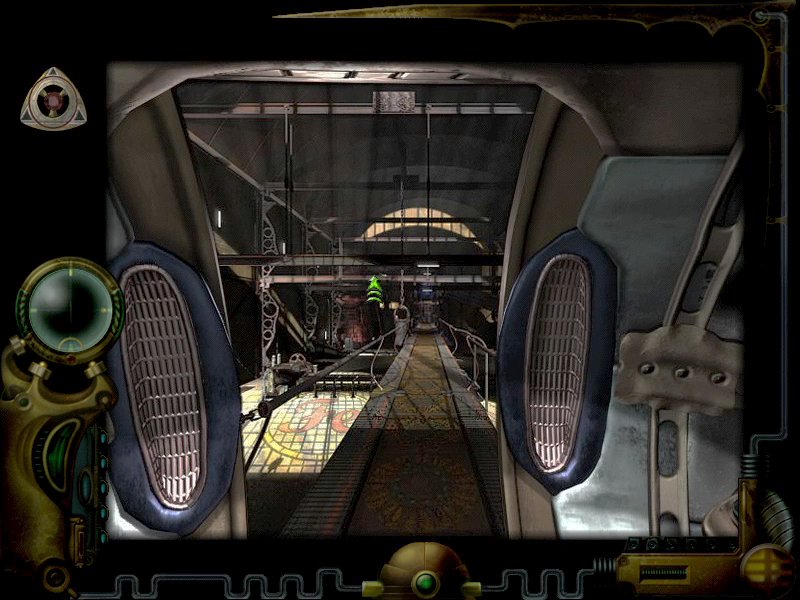 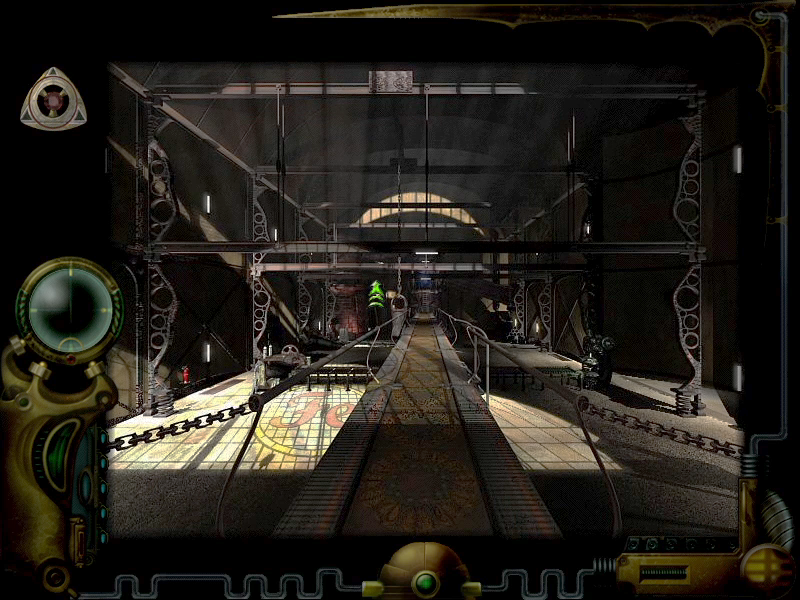 Alright, that's a walkway overseeing a big hall. Plenty of stuff to explore here, so let's get on with it.  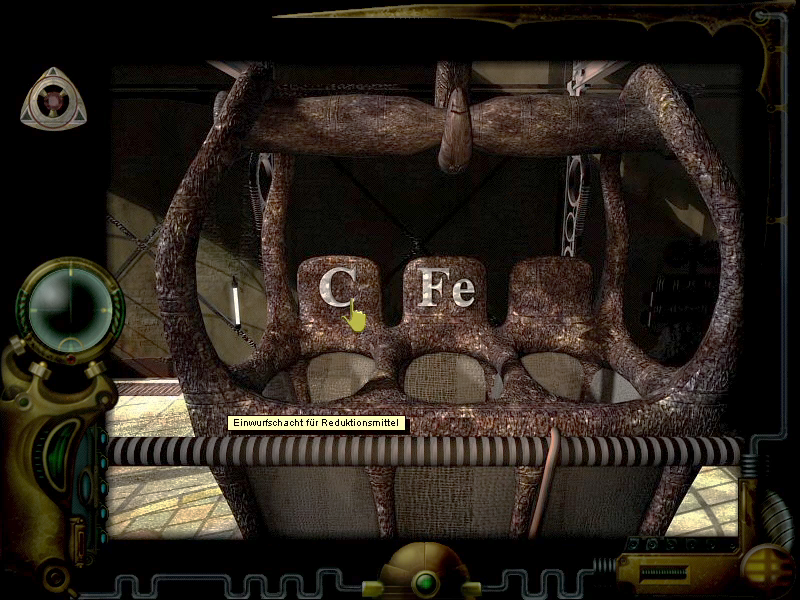 chute for reducing agent A few steps along the walkway, we find this collection of chutes 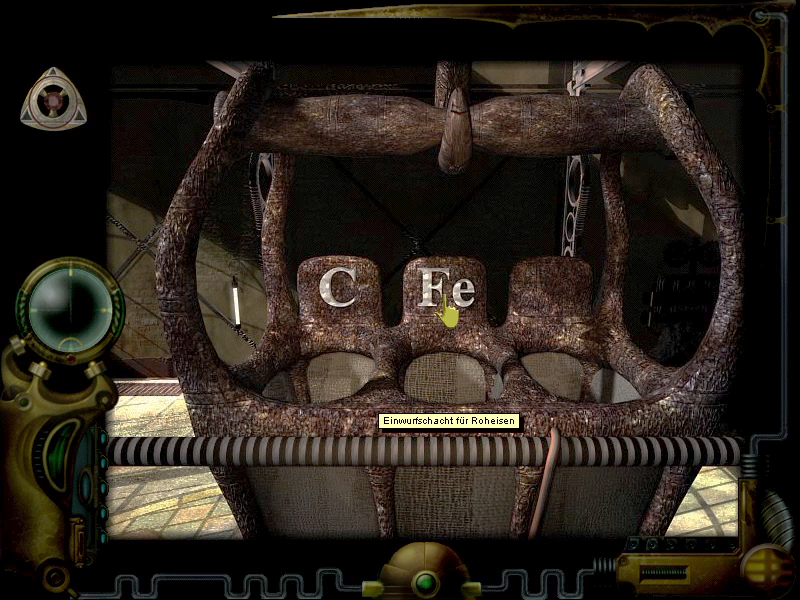 chute for raw iron 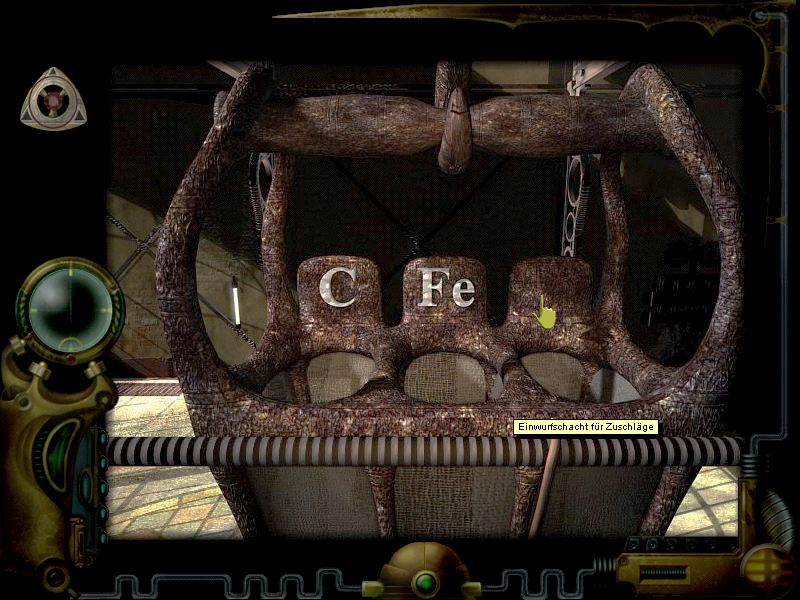 chute for additives Two clearly labelled chutes and one for mysterious "additives". I'm sure something eventually will tell us what additives we need. 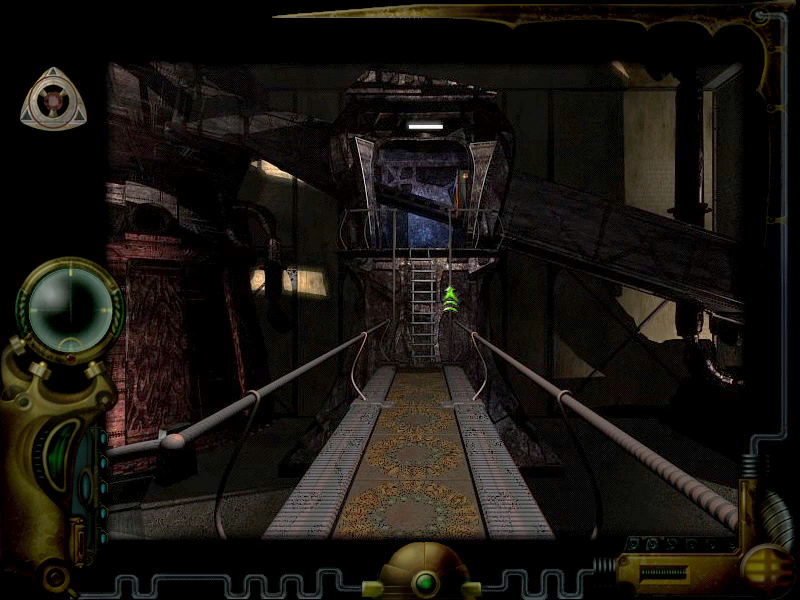 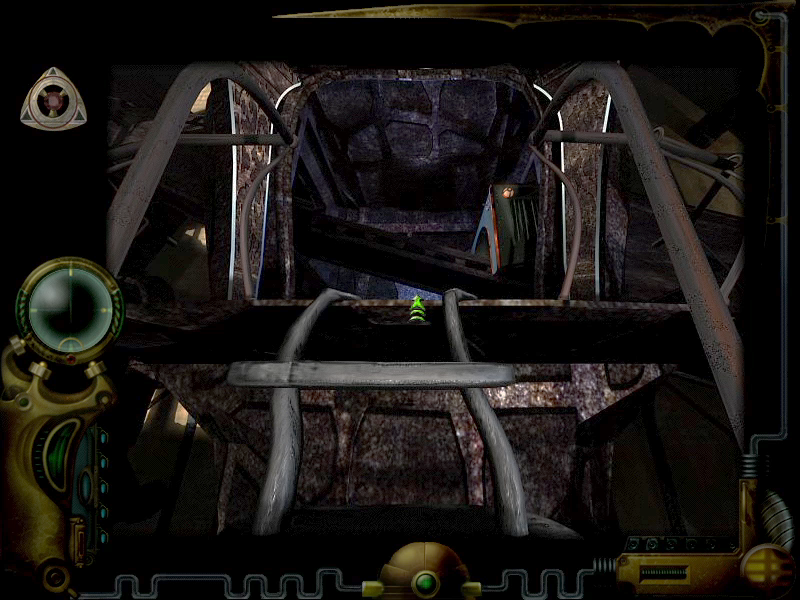 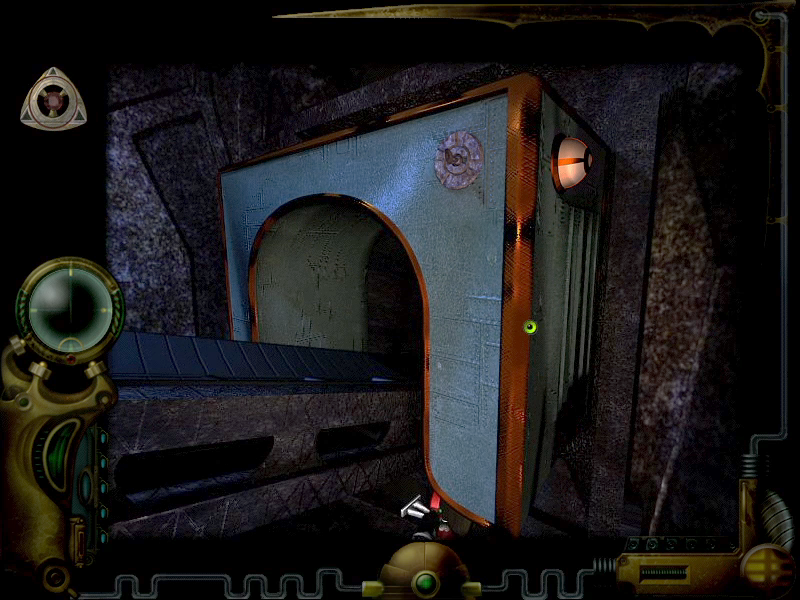 At the end of the walkway, we climb up a ladder and find this conveyor belt. 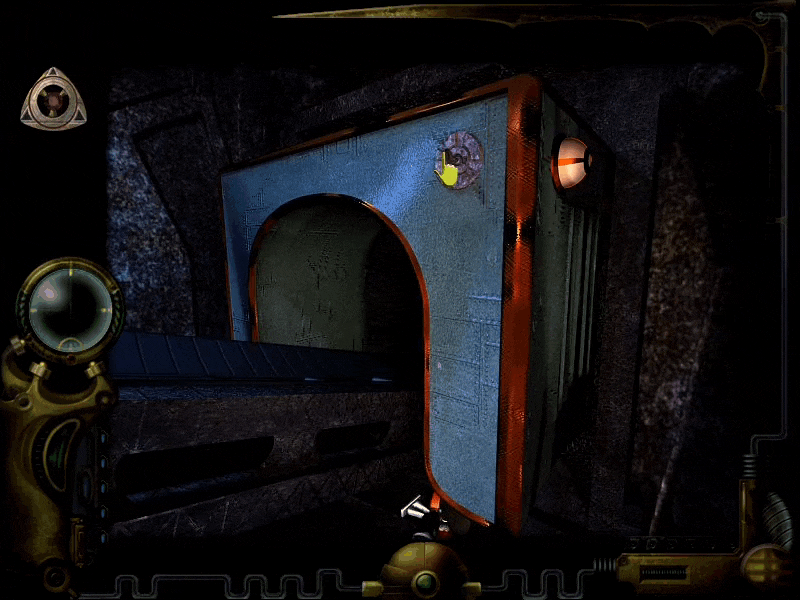 very thin metal pipe Turning it on causes it to produce this pipe, as well as sound a siren and flash that light bulb. Picked up: very thin metal pipe Turning it on after removing the pipe, it starts to produce iron ore, which we also nab. 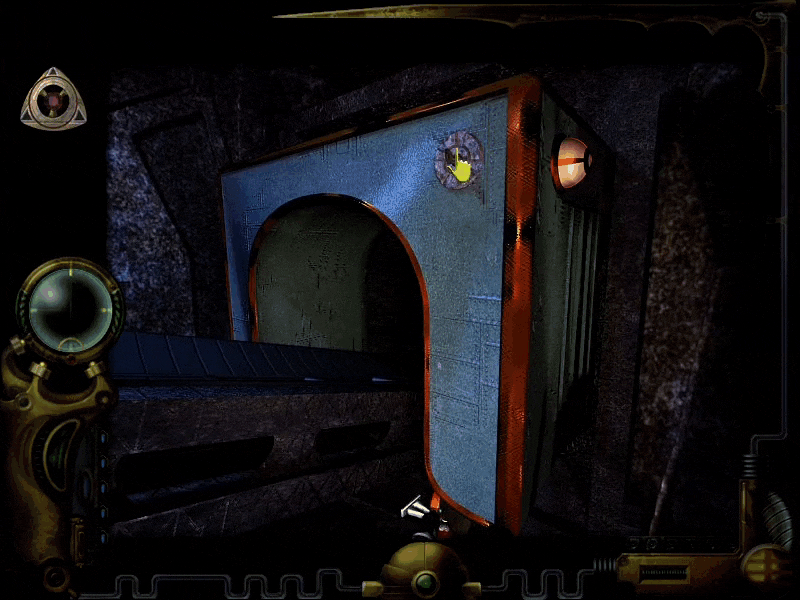 iron ore Picked up: iron ore We then return to the walkway and take the first of the ladders to the side, that you might have noticed already, to get down to the ground. 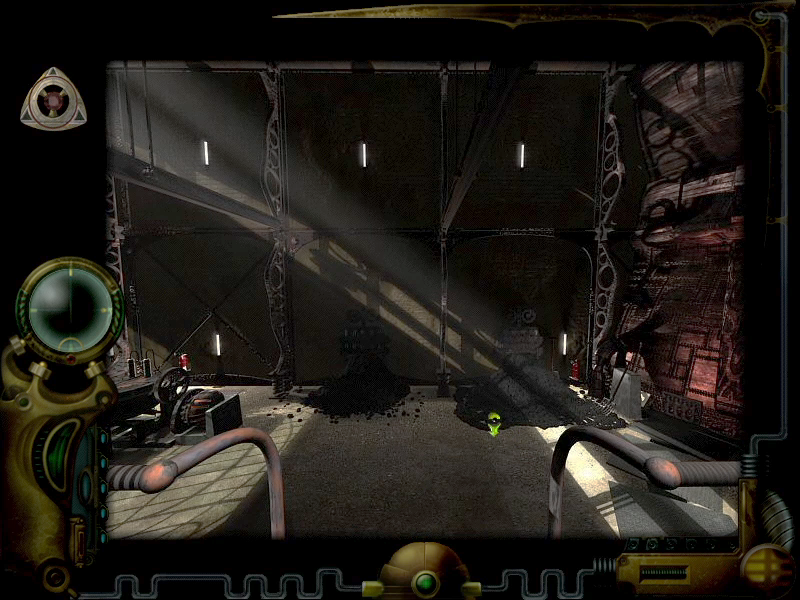 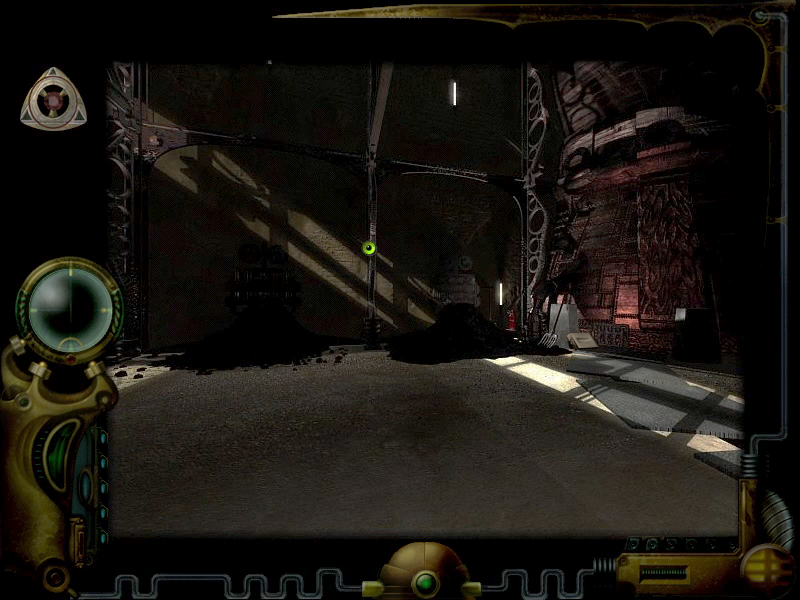 Okay, this place. This is what I was remembering back when I complained about the navigation in this game sucking in places. Nothing whatsoever tells you where in this big hall you can go or not. Actually, if I color it in roughly  the yellow bars is where the game lets us turn around 180 degrees (to climb up that ladder), and the green circle is where we can walk forward. And sure, there seem to be things there, but nothing tells me why we can walk there and not to that coal pile on the left. Now, I think it's good that we are being funnelled to the interesting places instead of having to bumble around through a fully realised floorplan to find the three interactable spots, but still, it's more waggling around of the mouse pointer to find out where I can go than I'd like. More signposting (like with the worn-out footpath in the Ti section) would've been great. Anyway, enough ranting, let's check that place out. 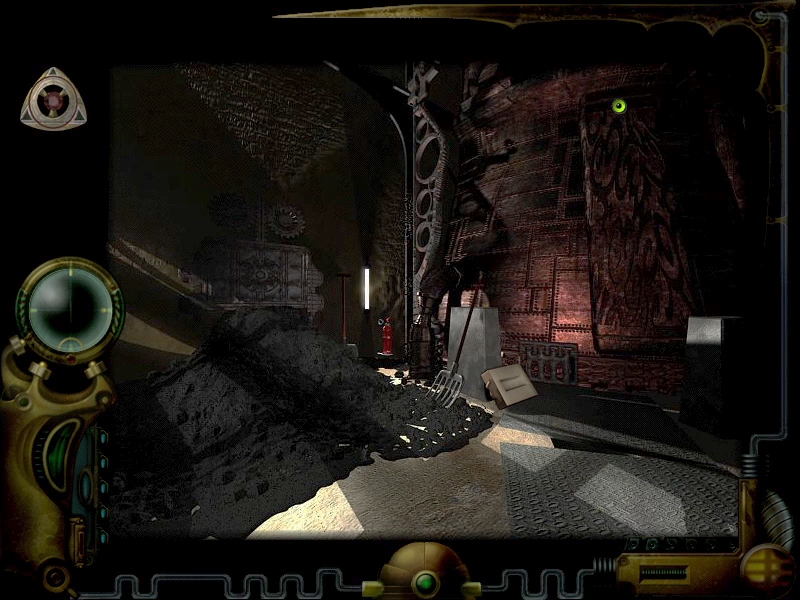 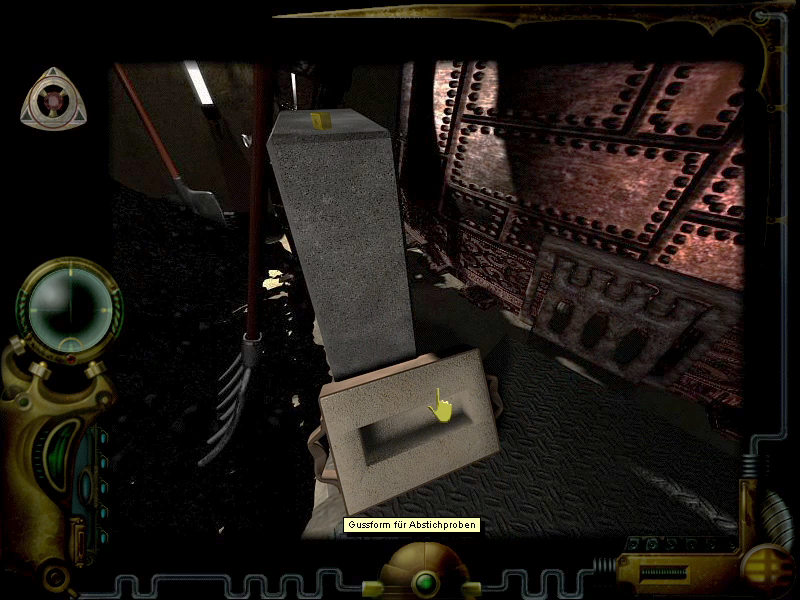 mold for sampling and on that slab, the last transporter block is lying around. 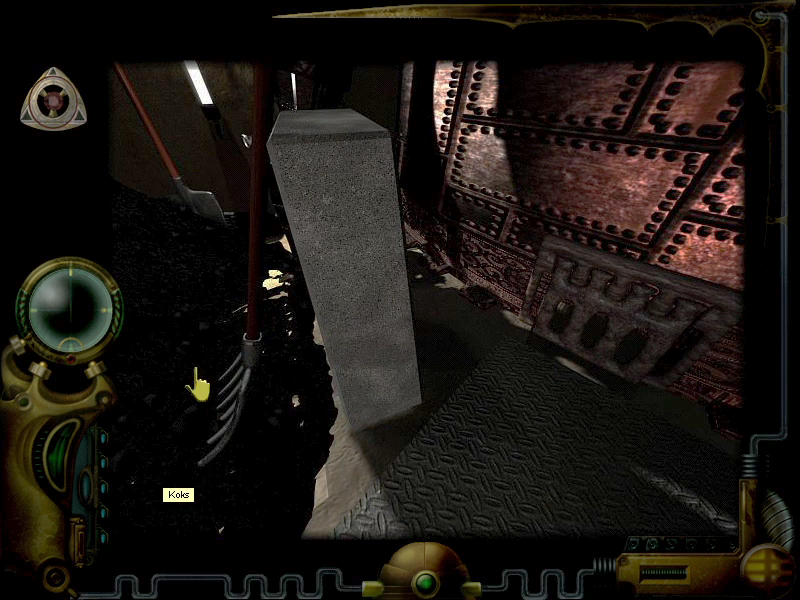 coke Picked up: mold for sampling, transporter block[S], coke 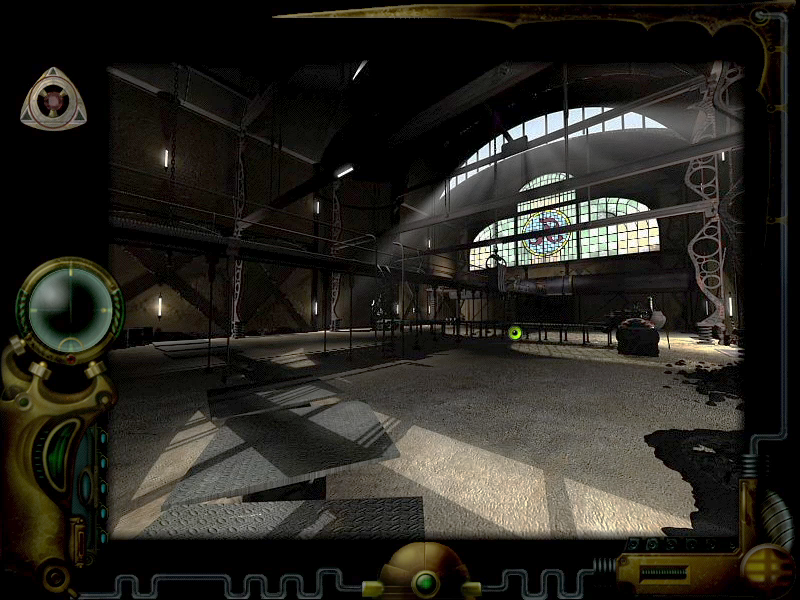 Turning around, it seems like there actually is a footpath shown here. We can only get back on that walkway, so let's do that and check out the next ladder, closer to the transporter. 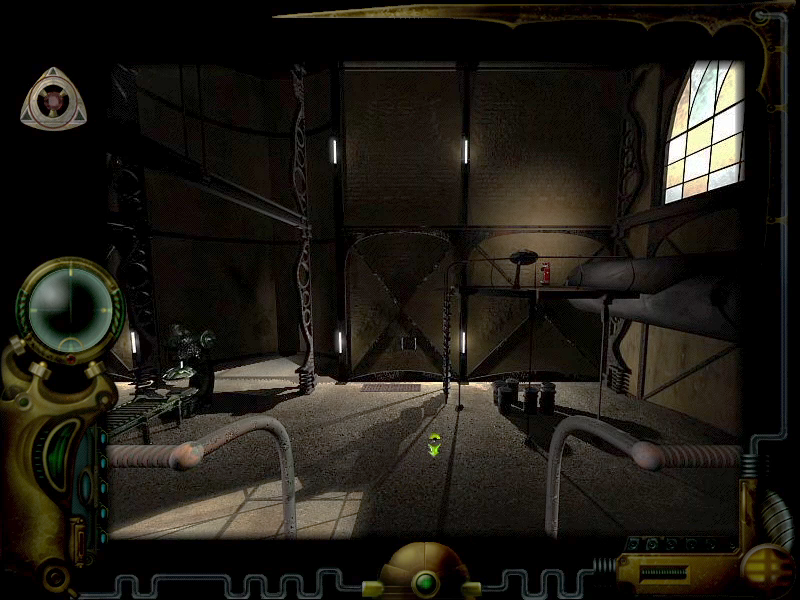 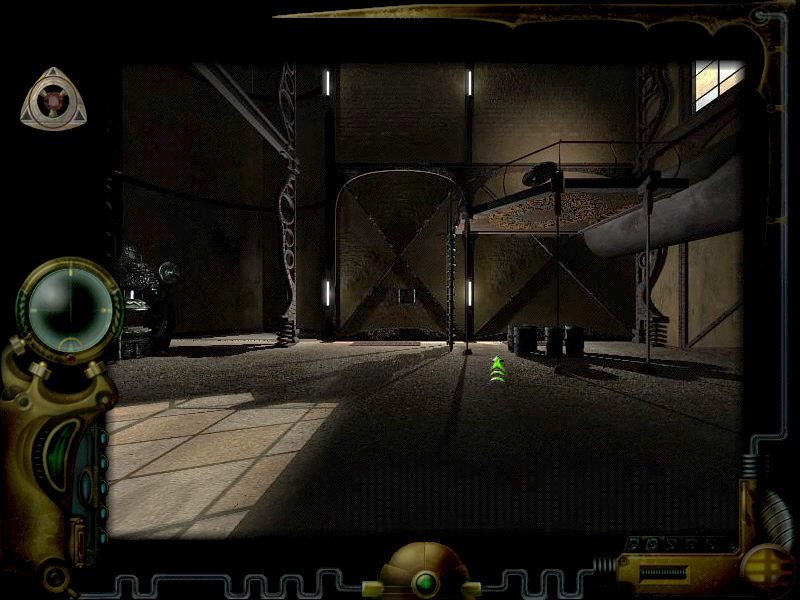 Same deal, we have to discern where the game allows us to go. Let's take the offered way forward. 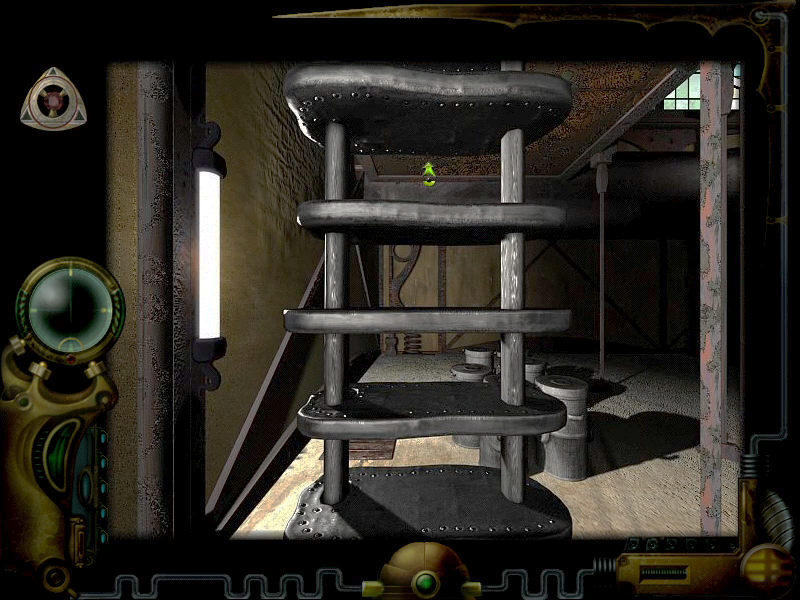 Straight ahead, we find this ladder. 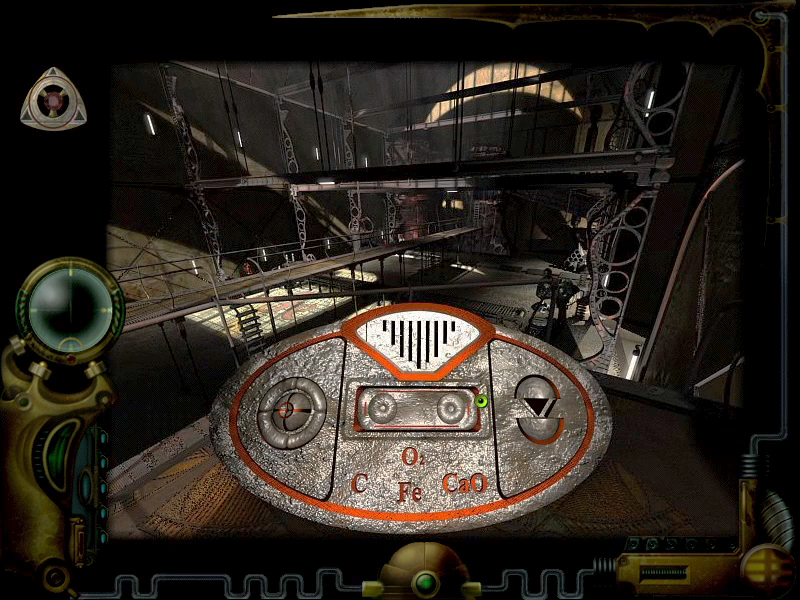 Up the ladder, there's this panel. 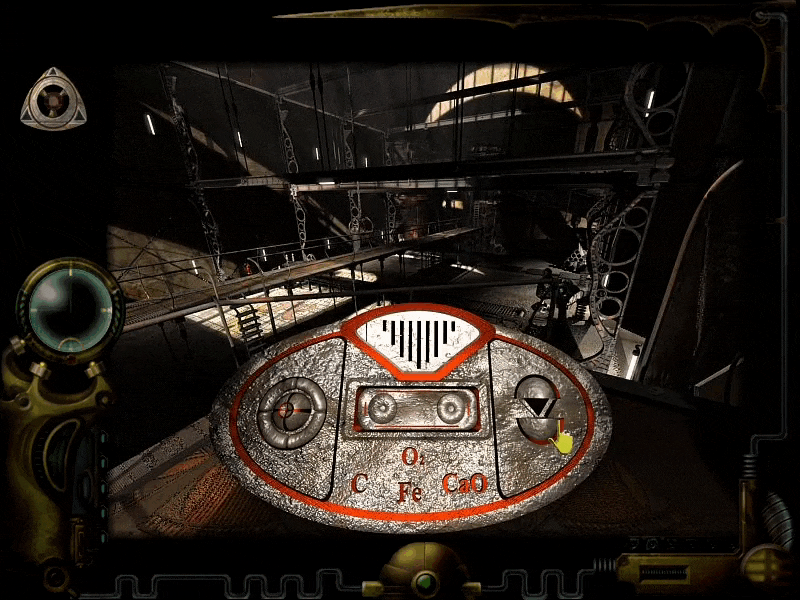 The button on the right moves that thing in the background. The button on the left can be pushed, but doesn't seem to do anything. 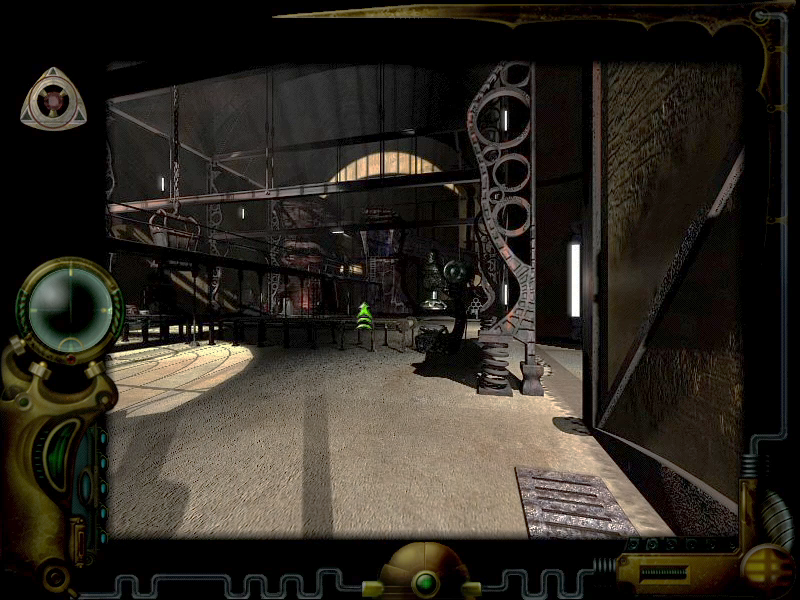 Coming back down the ladder, we see that the game allows us to walk forward here, to that thing that we moved with the button just now. We couldn't have walked there in a straight line from the walkway, we had to walk over here first. 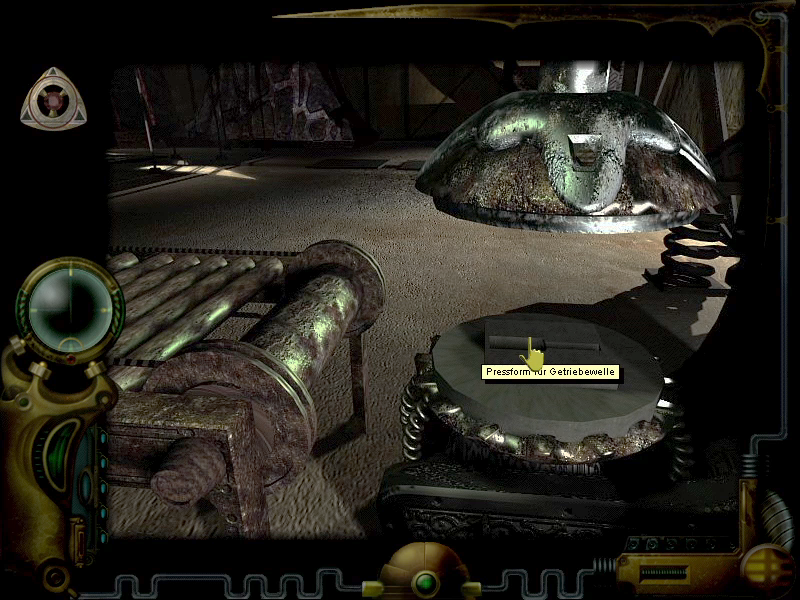 mold for transmission shaft Hmm, I think I have a rough idea how that will come in handy. We can't take it though, so it probably is meant to be used where it is. And that's all for this place, time to check out the next one! 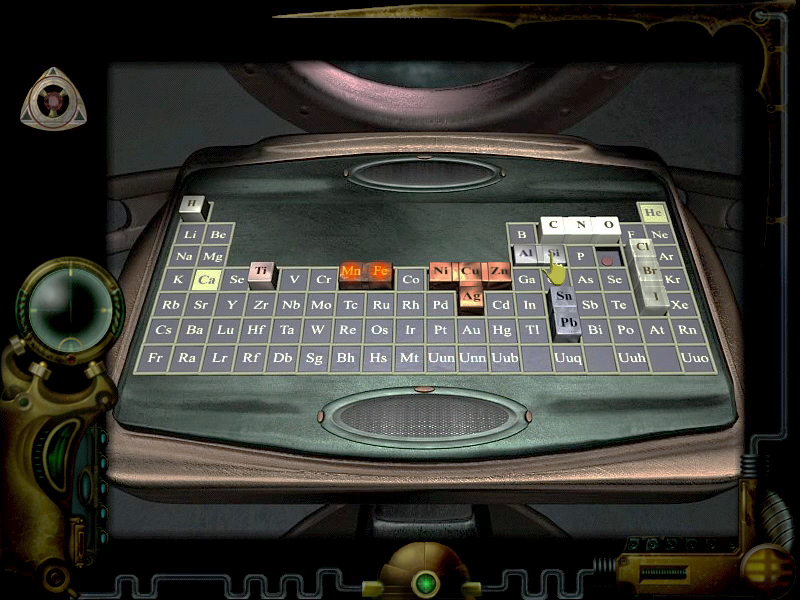 Let's go for aluminium.  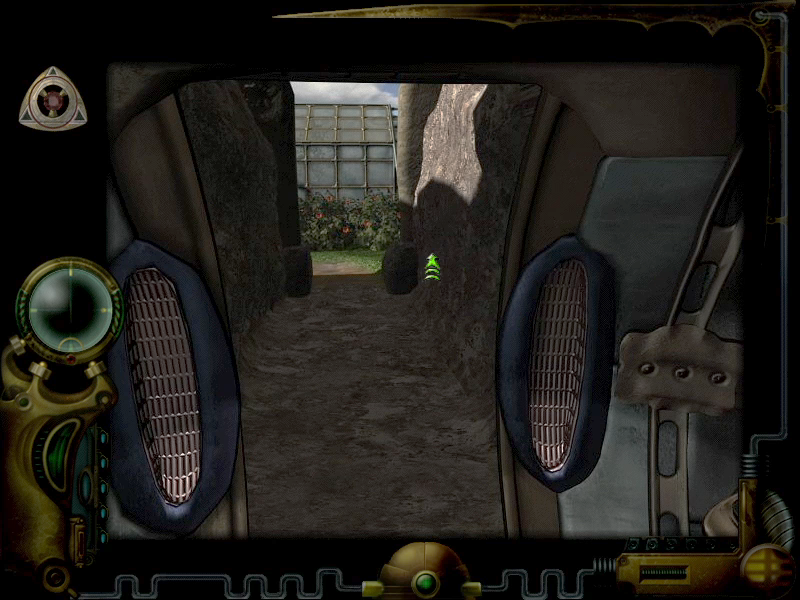 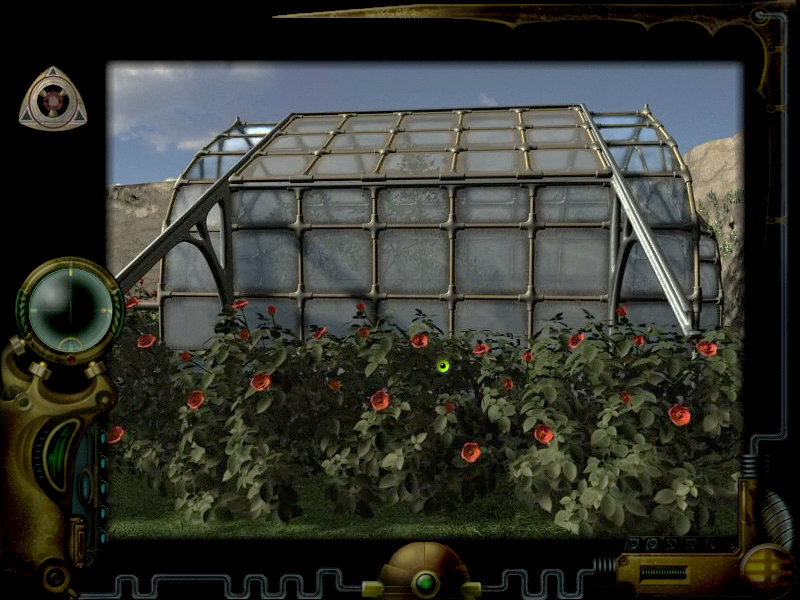 Looks like we've got a greenhouse. Nothing we can do with it just yet, but we can walk around it. 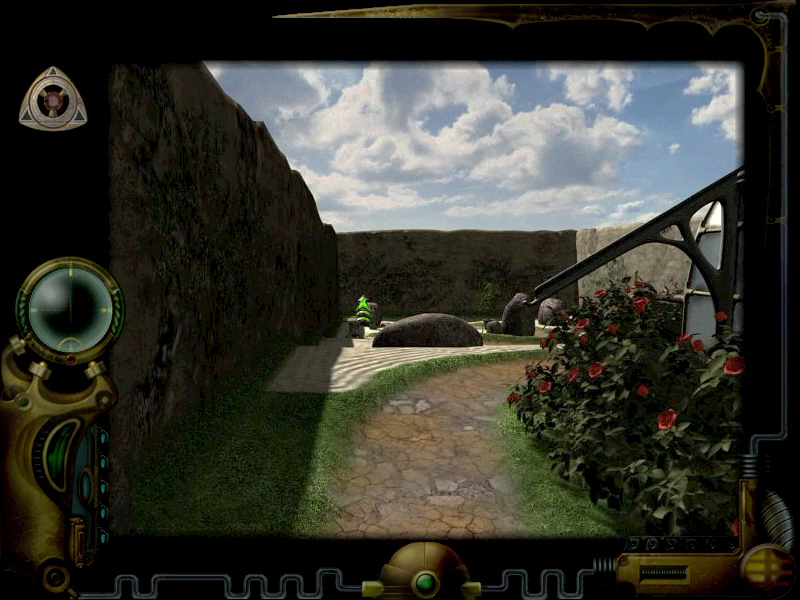 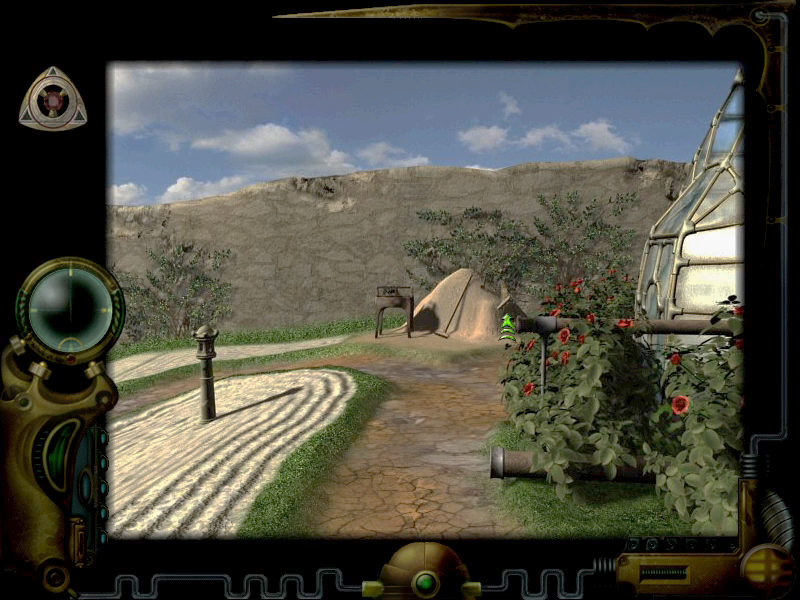 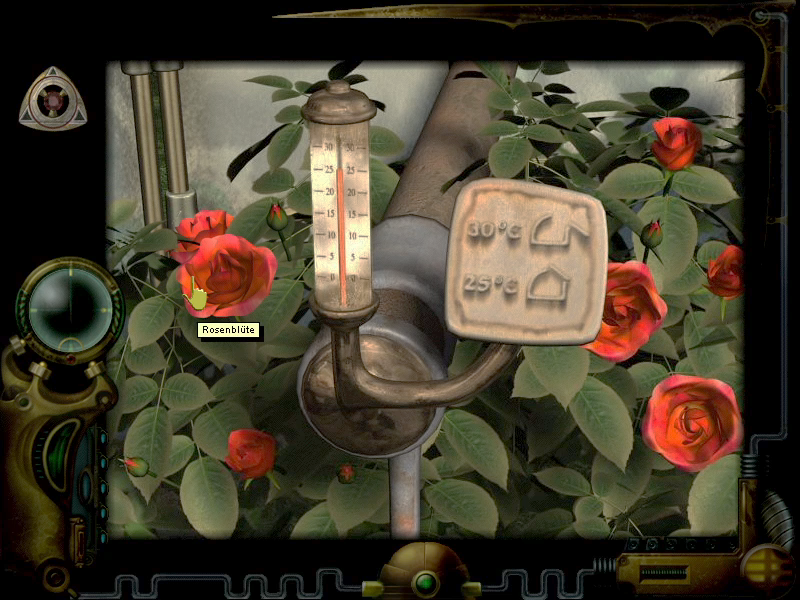 rose blossom Picked up: rose blossom We can look further down from here 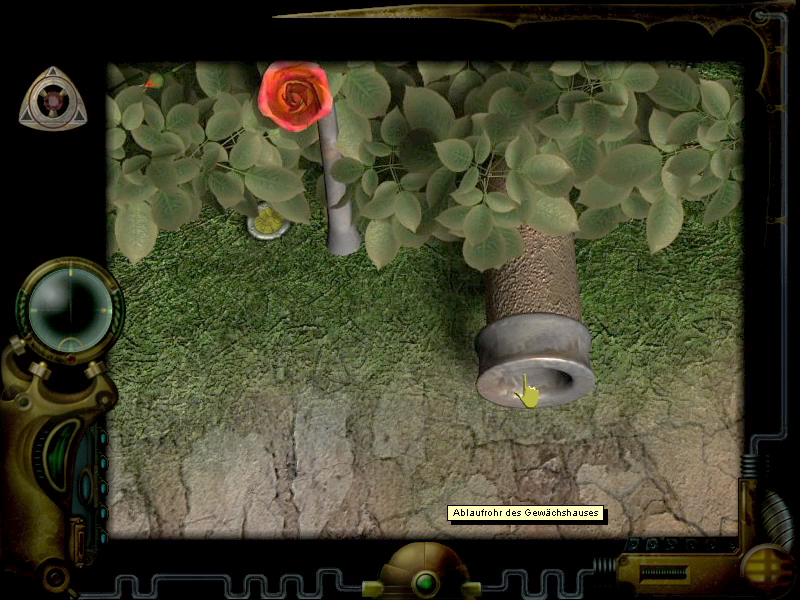 drain pipe of the greenhouse and find that thing, plus a learning chip about lime (as in, the calcium compound, not the citrus fruit) Picked up: learning chip: lime 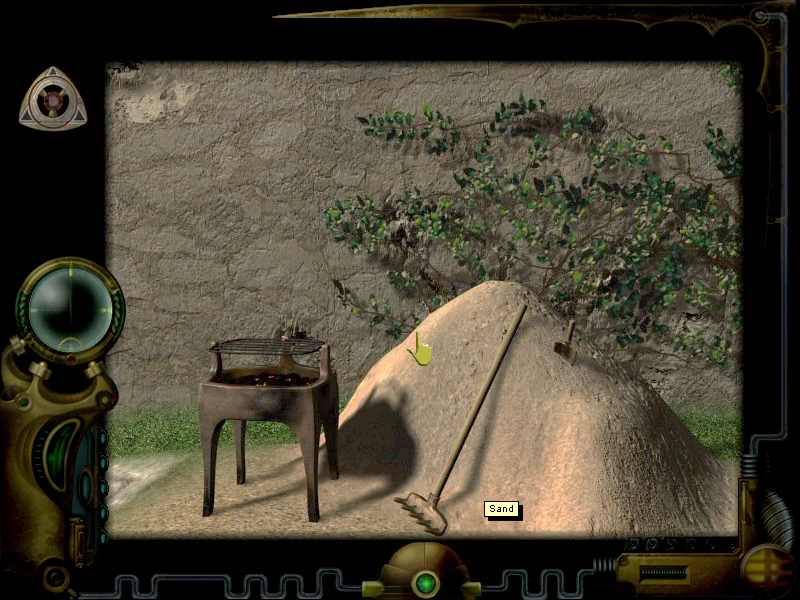 sand 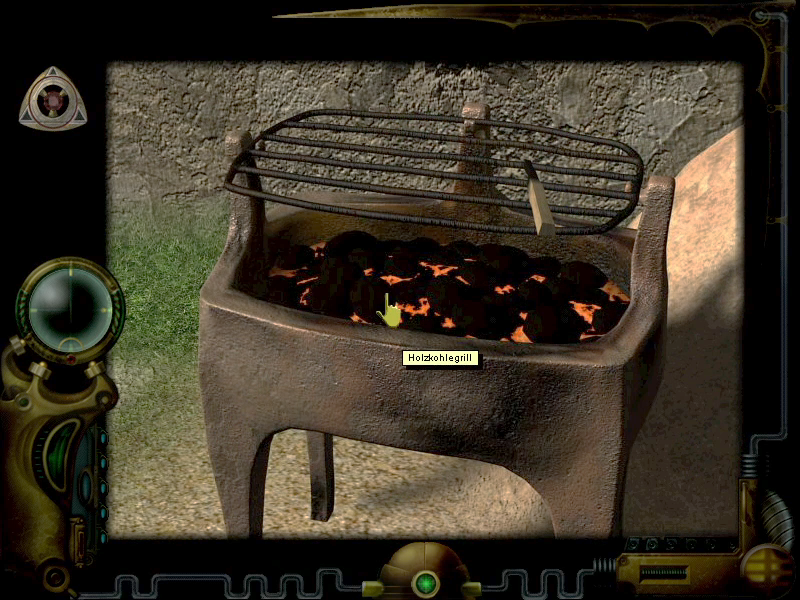 charcoal grill 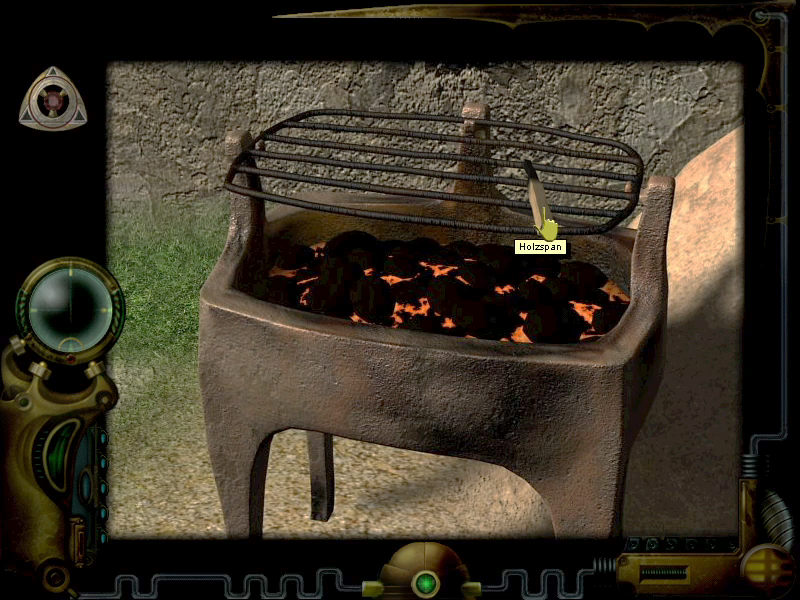 woodchip Picked up: sand, woodchip More random things that probably will be used at some point 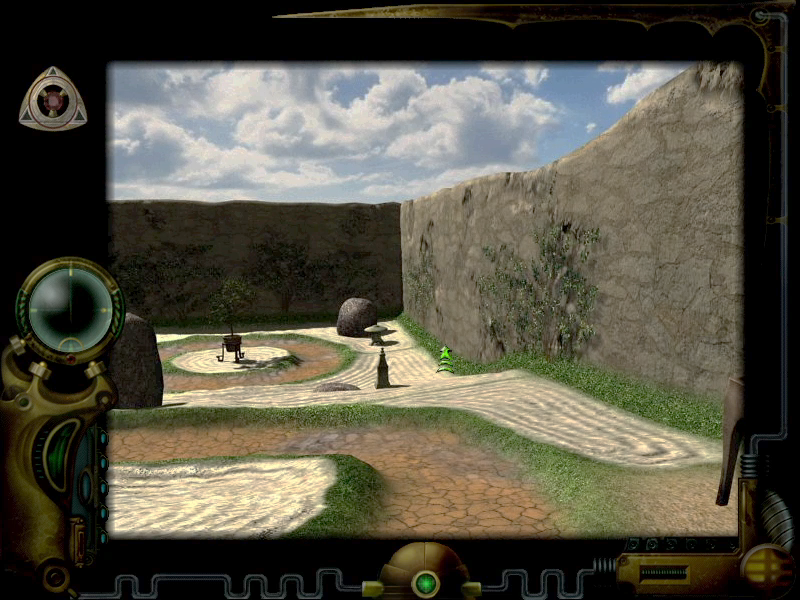 There also is a path through this zen garden-like area, and at the end, there's a planter 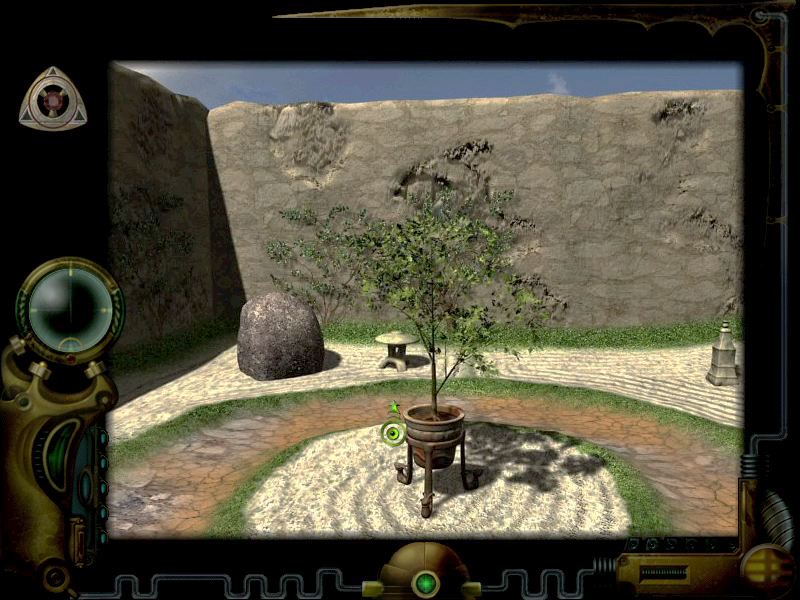 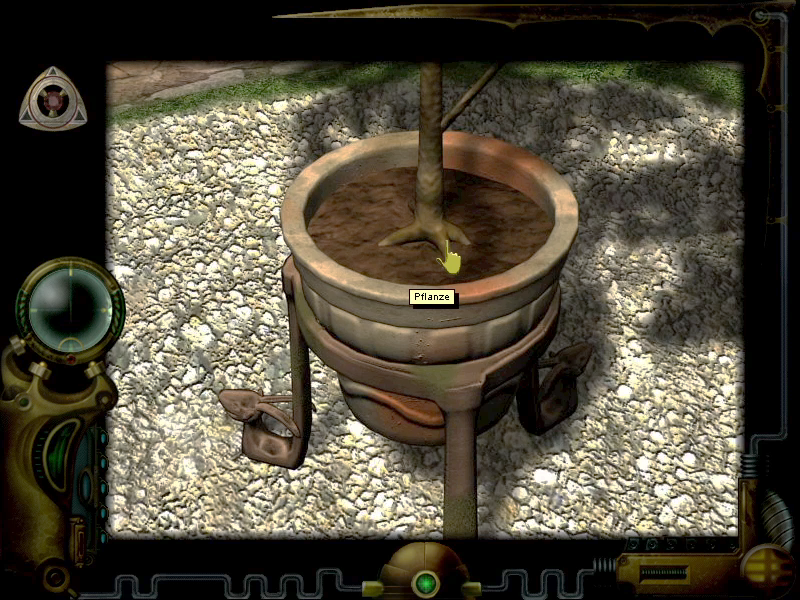 plant 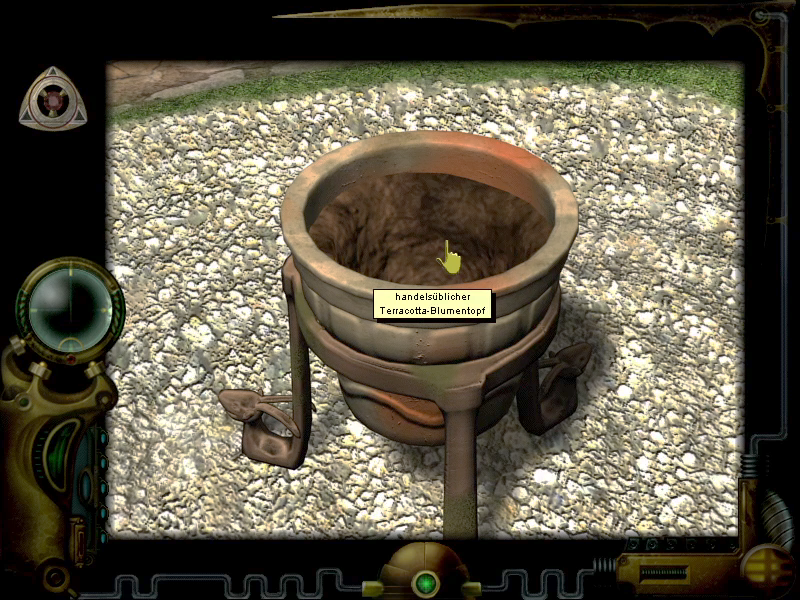 commercially available terracotta flower pot Picked up: plant This label is really funny to me, because we're supposed to be in a weird chemistry world, so calling this pot "commercially available" (or maybe "standard issue"?) feels very out of place. Do these people come to our world to buy their pots? 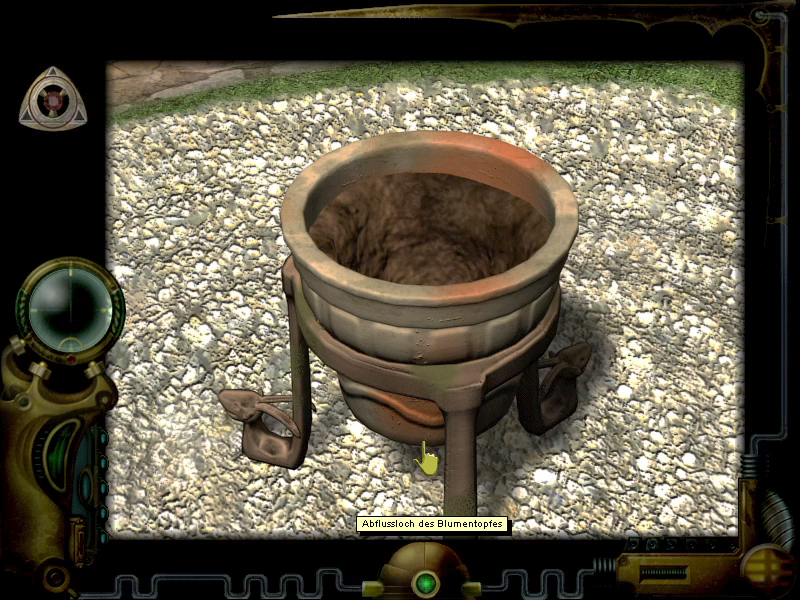 drain hole of the flower pot The game also makes sure to inform us that the pot has a drain hole. Anyway, that again is all we can do now, two more locations to check out. 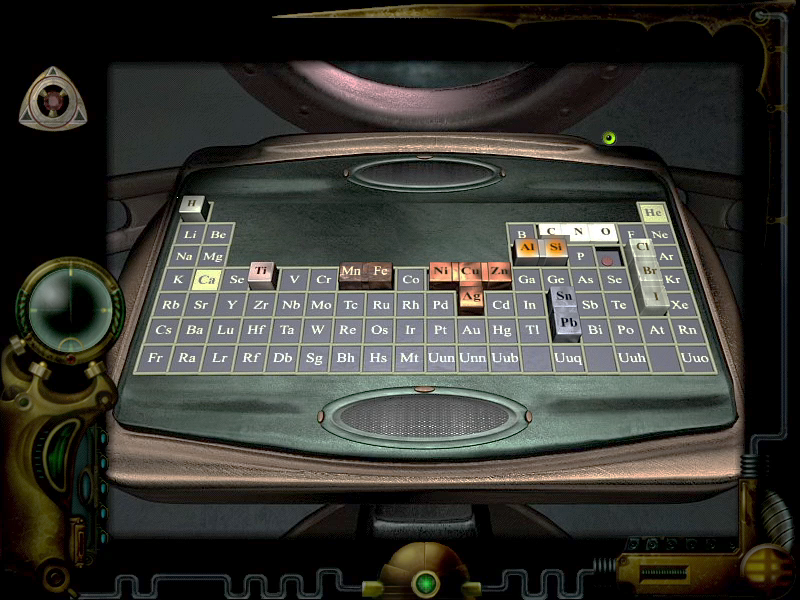   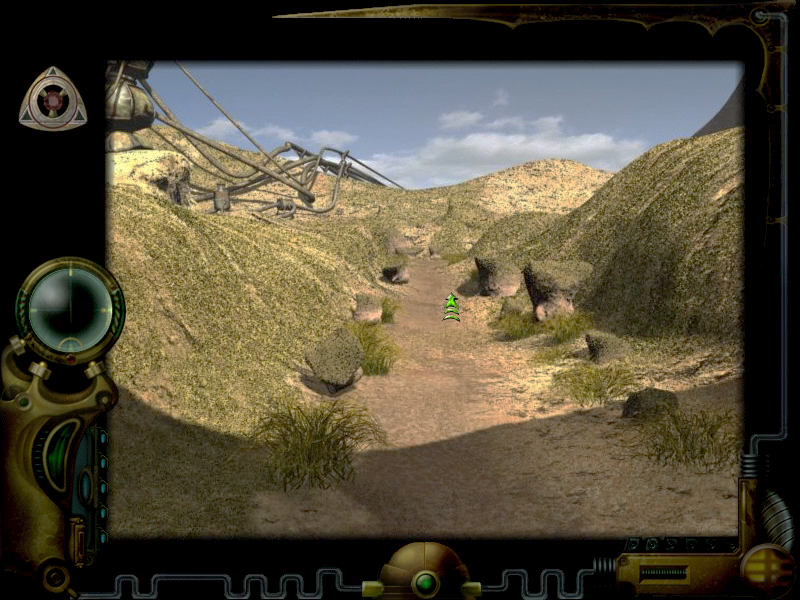 Fresh air, and some pipelines, I guess, to our left. Let's see what's up with that. 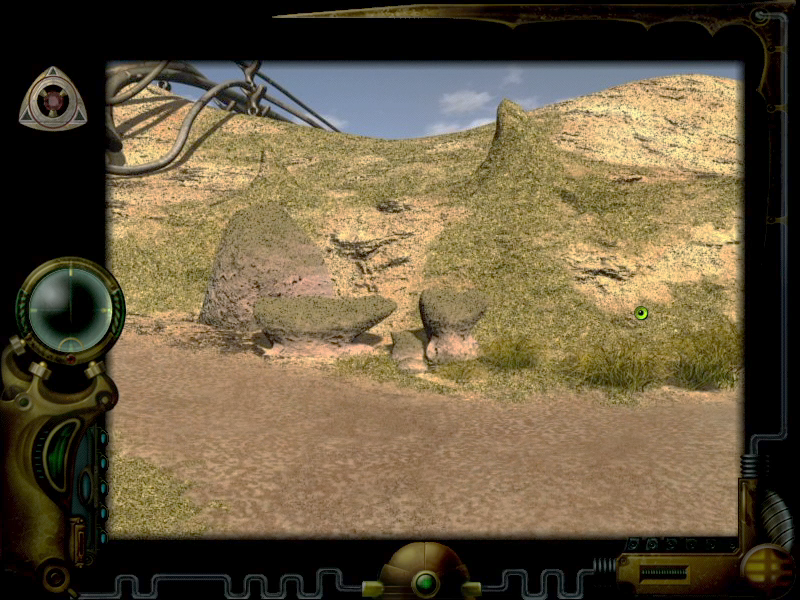 But first, we come to this fork in the road and I choose to walk right. 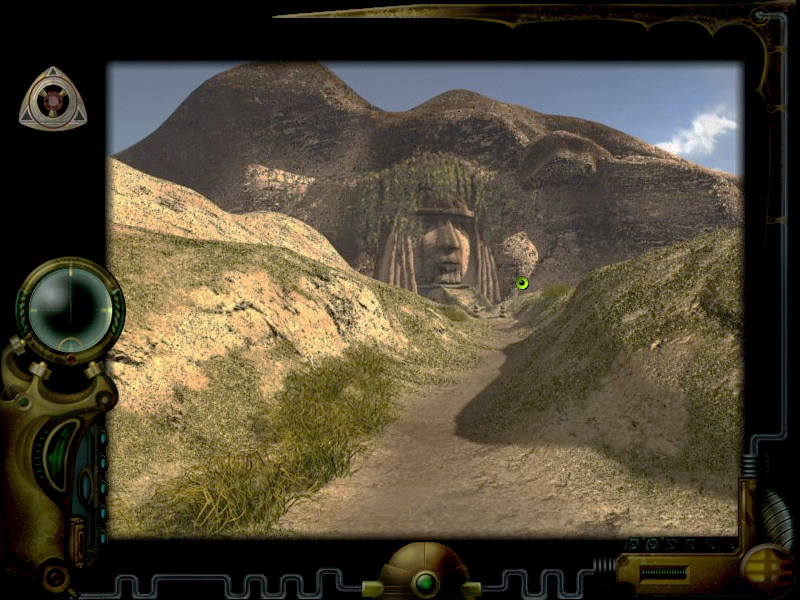 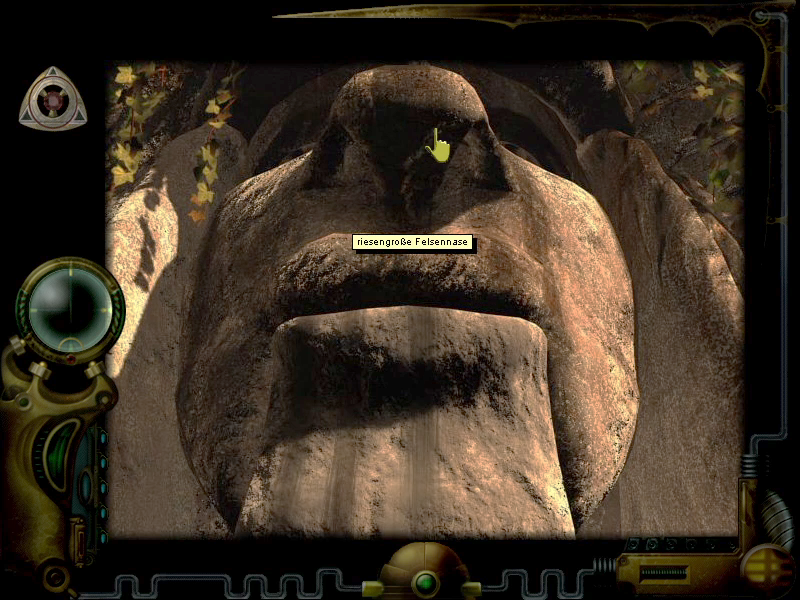 gigantic rock nose You know what they say about guys with big noses  Nothing for us in this corner though, so let's turn around 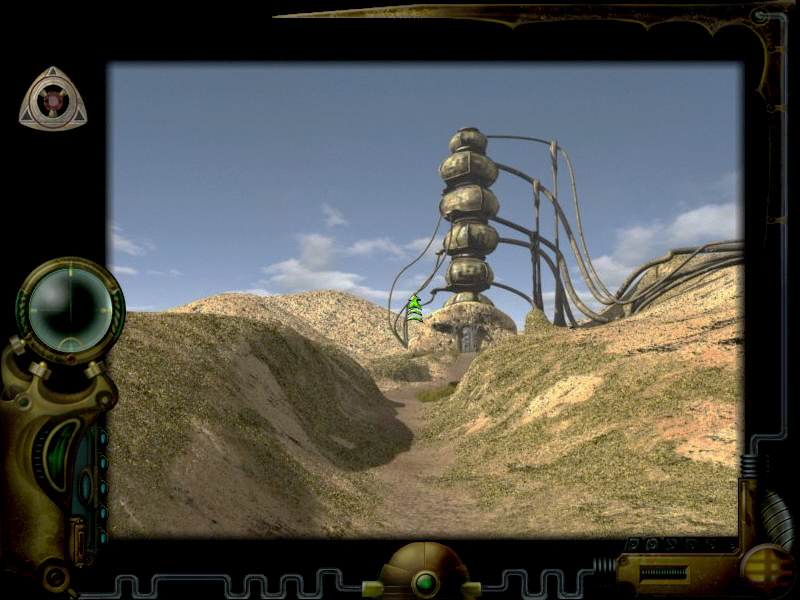 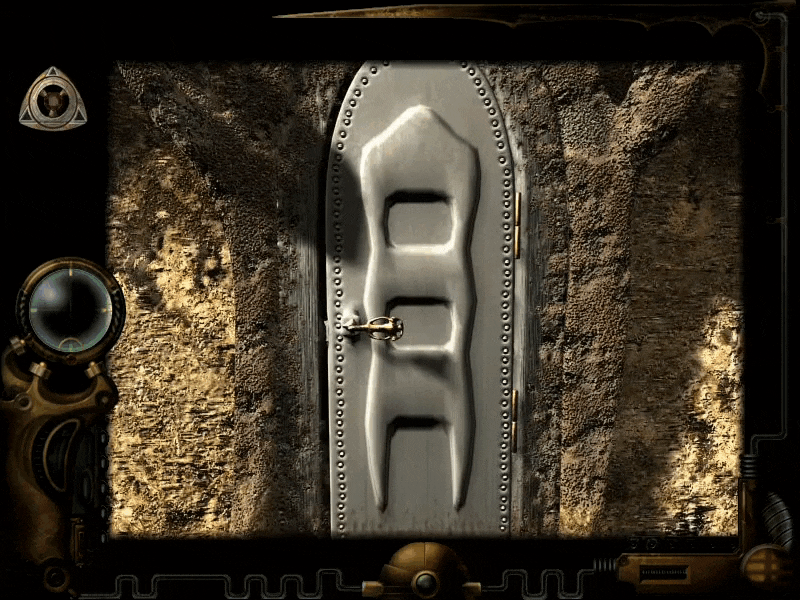 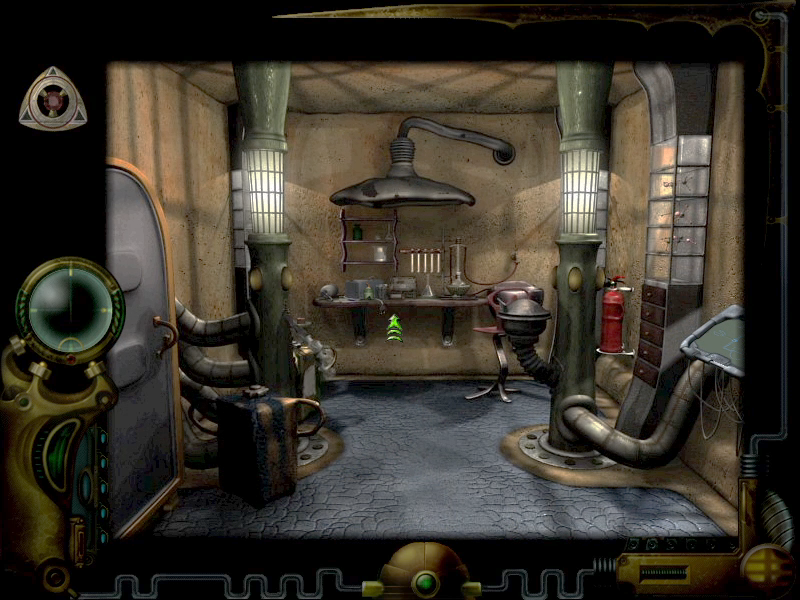 Wow, another lab. Let's see what it's got. 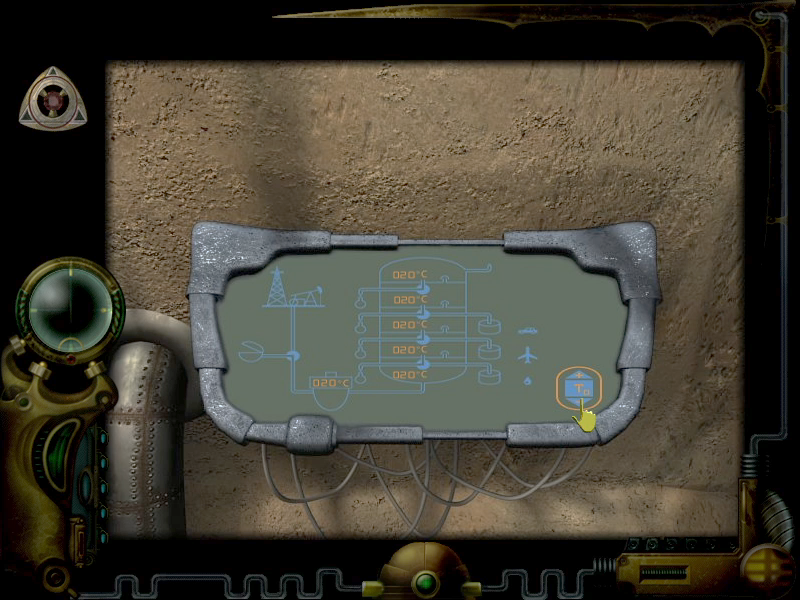 First, there's this familiar screen. It has buttons on the lower right, but I don't seem to be able to interact with them. 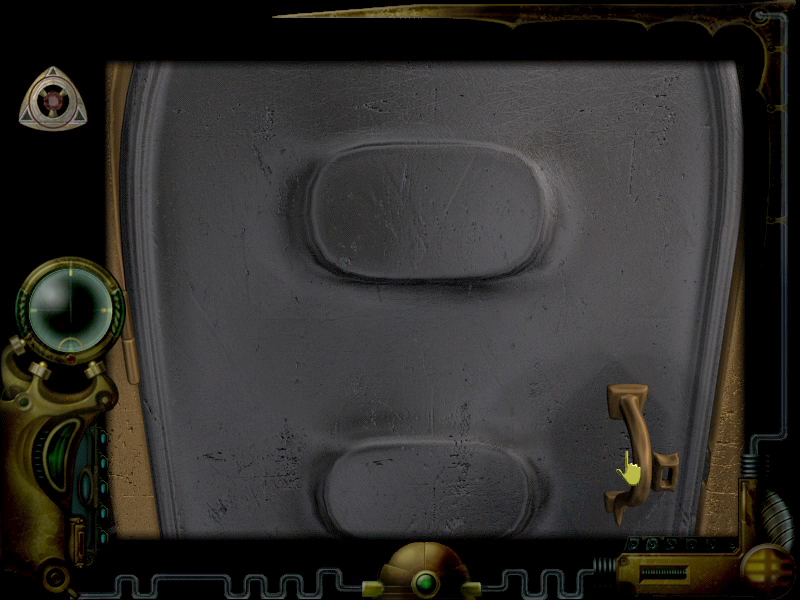 Across from it, there's this door, but it doesn't want to open 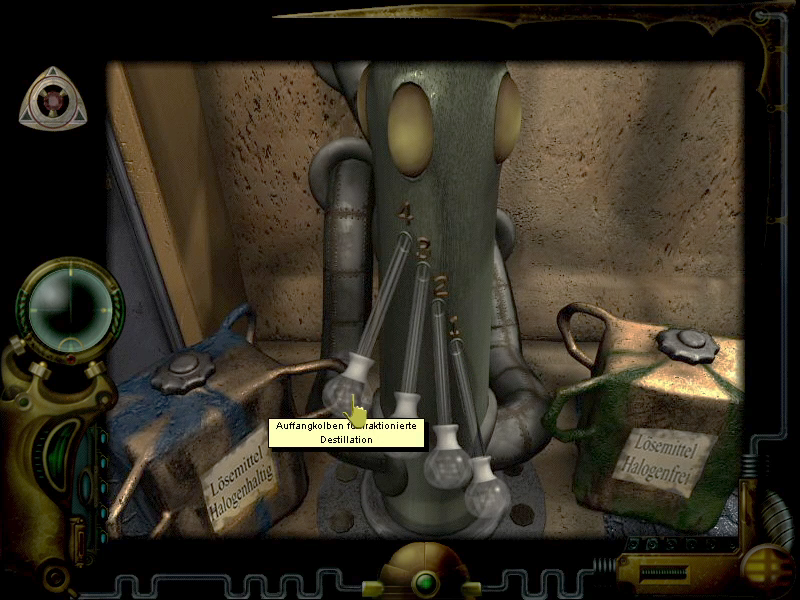 receiving flask for fractional distillation The four flasks here all give this label. Furthermore, those canisters are labelled "halogenated solvents" and "non-halogenated solvents". 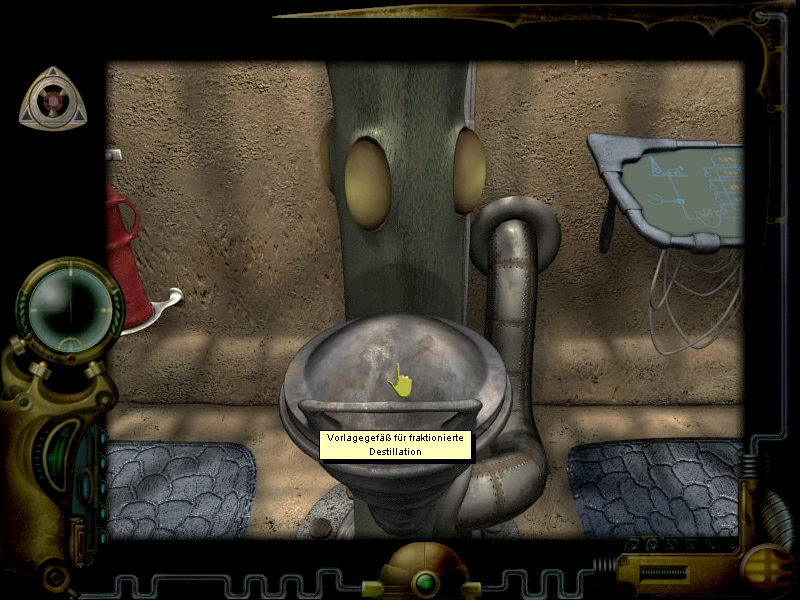 feed vessel for fractional distillation Across from the flasks, we get this thing, which opens up. 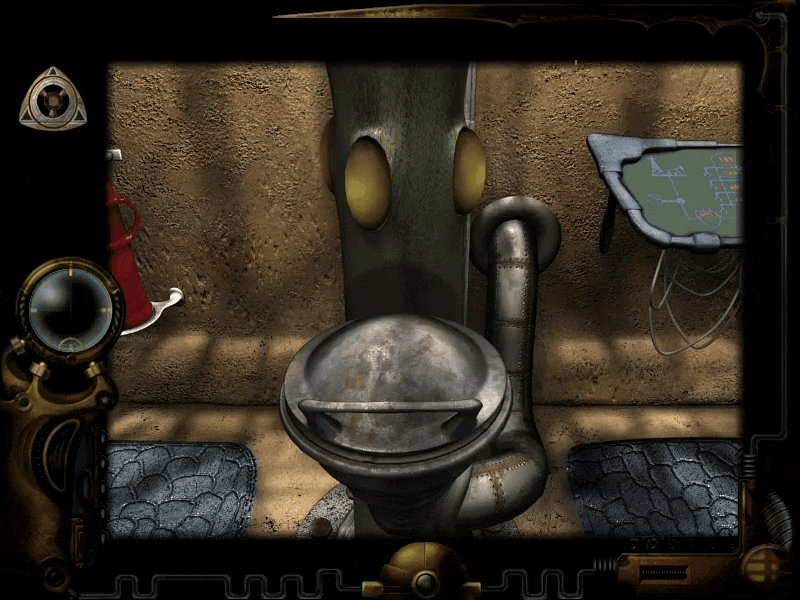 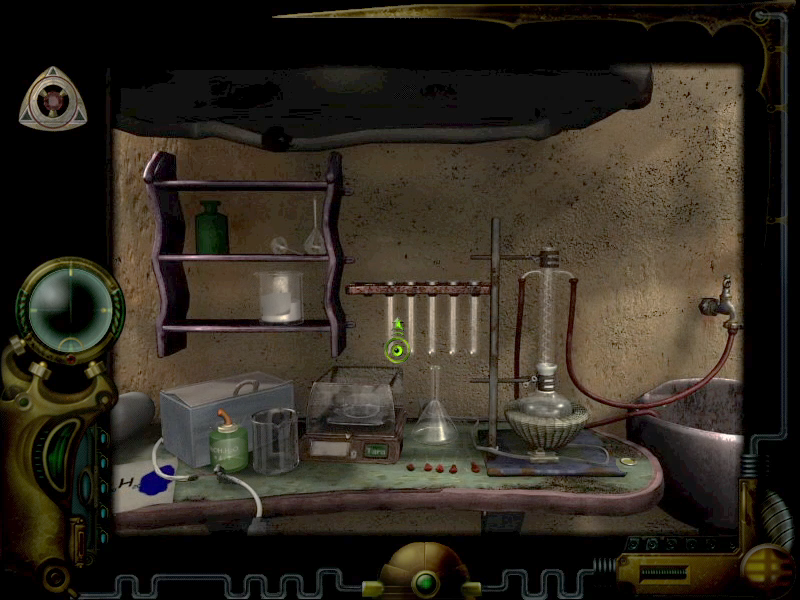 Finally, there's the corner with this lab bench. 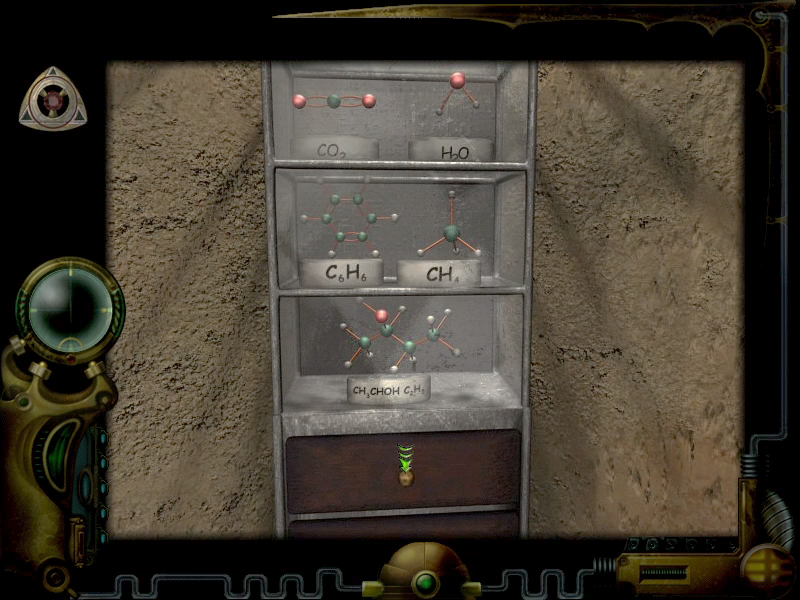 On the left, there's these molecule models, but nothing to click. The left part of the work bench has some more pickups 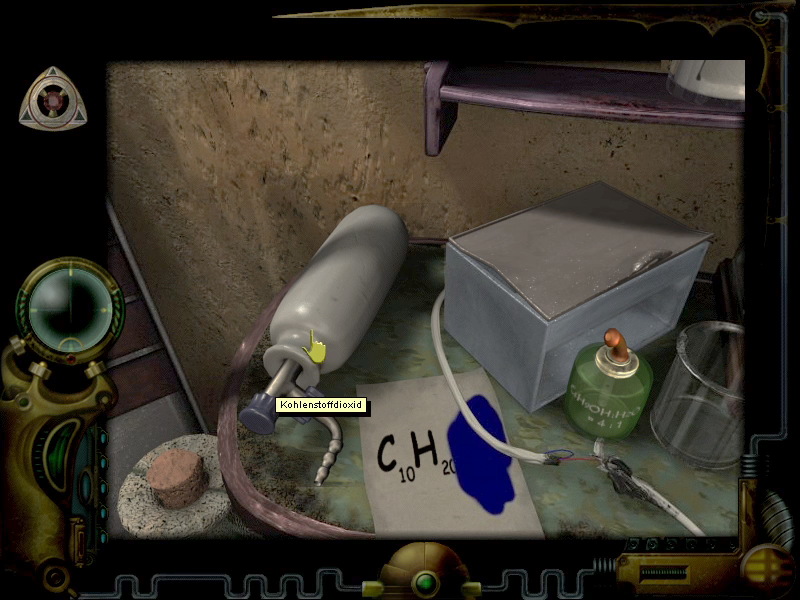 carbon dioxide 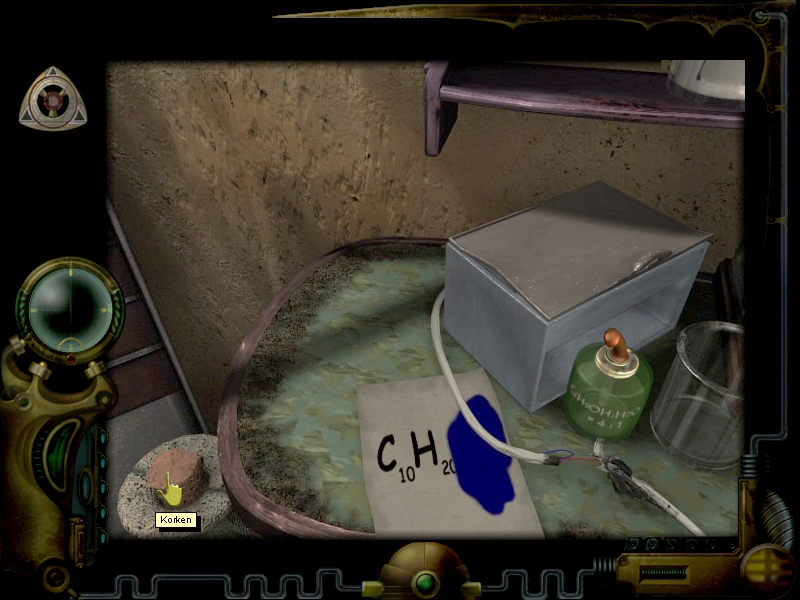 cork 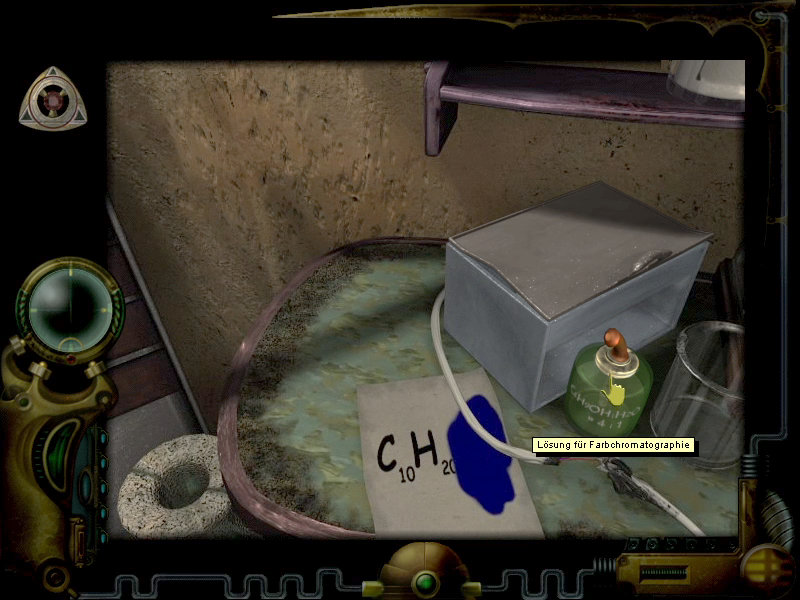 solution for color chromatograpy 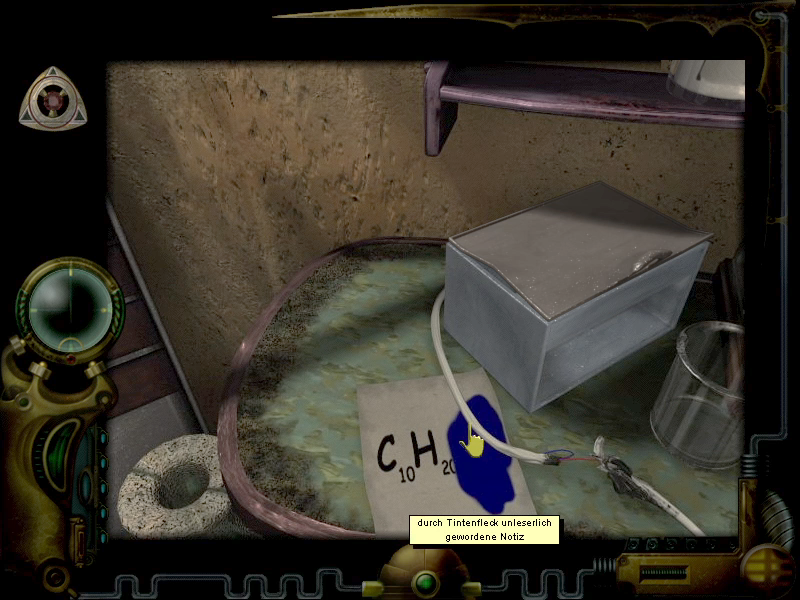 note made illegible by ink stain 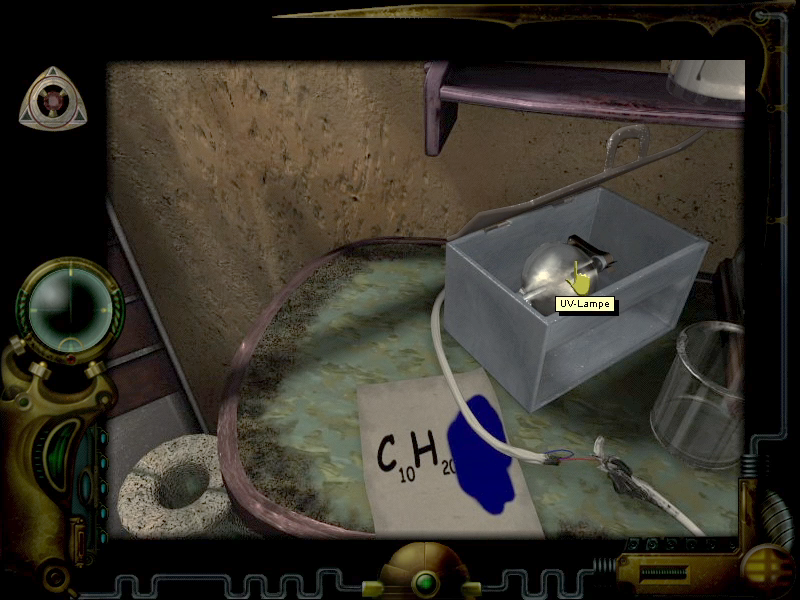 UV lamp Picked up: carbon dioxide, cork, solution for color chromatography, UV lamp Note that we couldn't pick up the note. 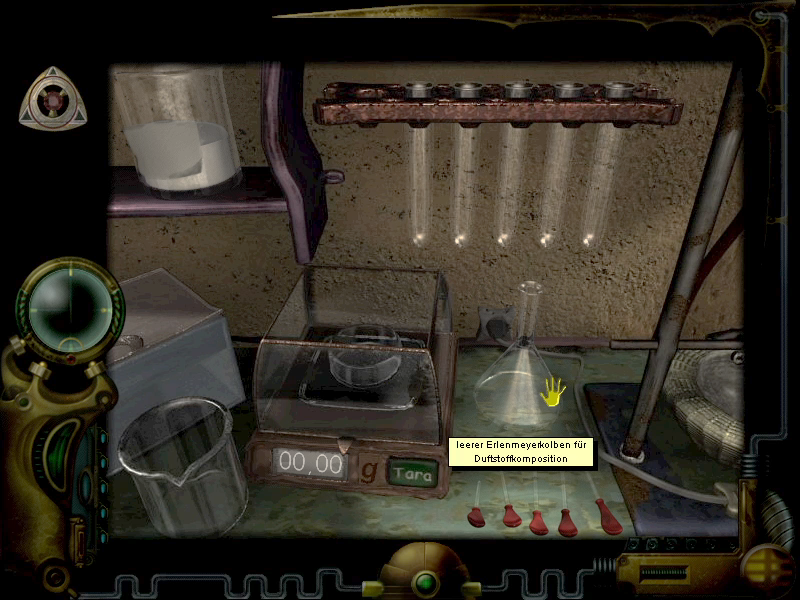 empty Erlenmeyer flask for scent composition 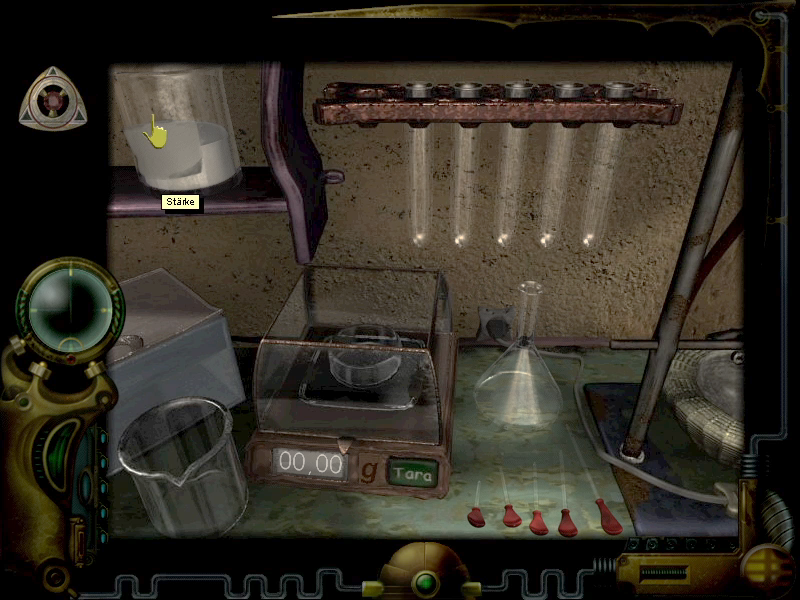 starch We can interact with the pipettes there, but not really do anything until we've figured out what we actually want to do here, and unless I'm mistaken, that's still a ways off. Picked up: starch 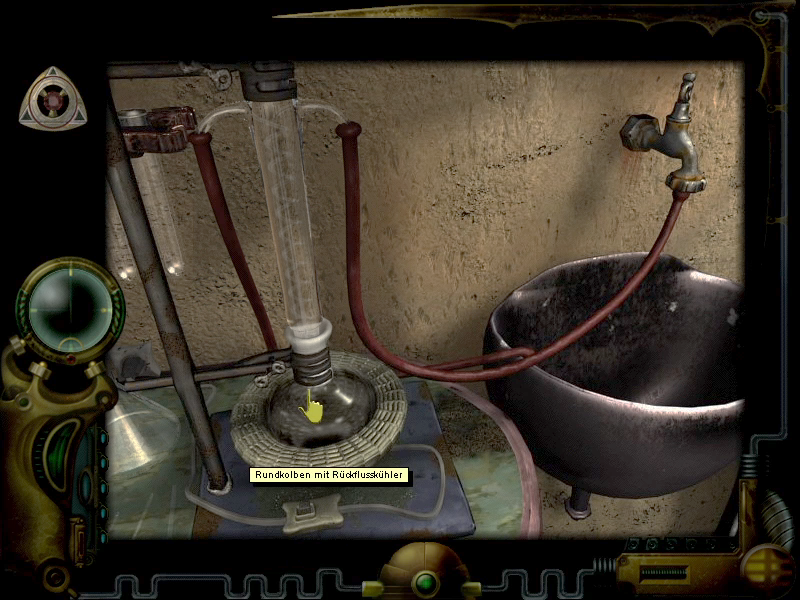 round-bottom flask with reflux cooler The right side of the lab bench has this thing, and the learning chip for esters Picked up: learning chip: esters I briefly deliberated whether to leave this for you, but because I think it's fairly obvious (particularly if you've read the diary entries in the last update), I solve one puzzle immediately. 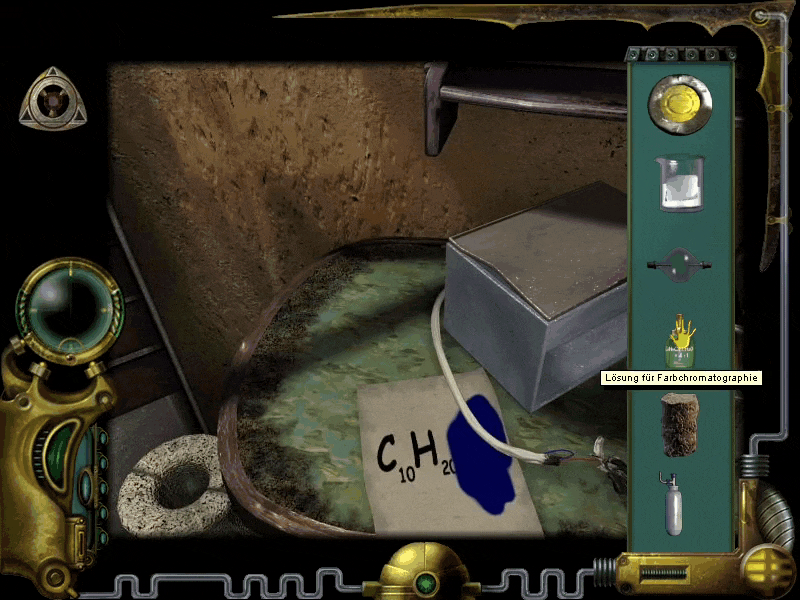 Lost: solution for color chromatography As for what that is supposed to be used for, I'll let you think on that. We actually have some hints here. Other than that, we're done in this section for now, so let's plug in the final transporter block and see what that sulfur place is like. 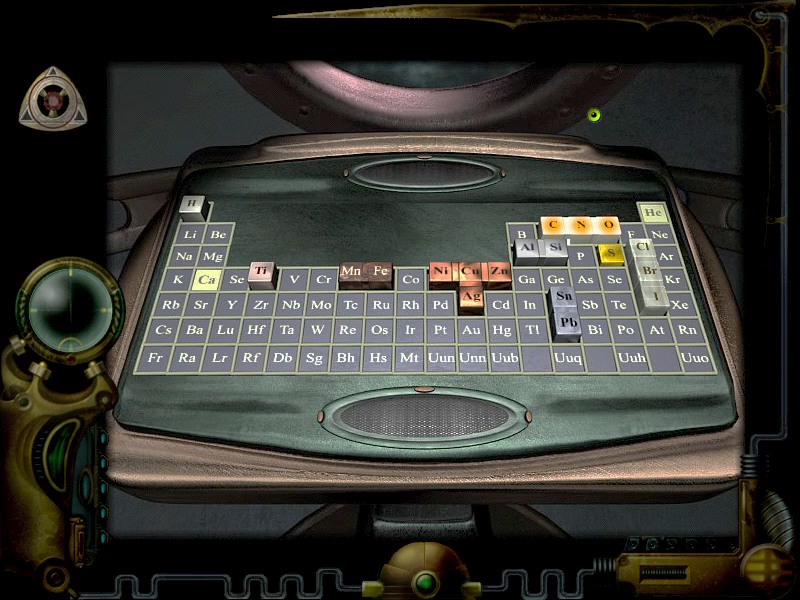  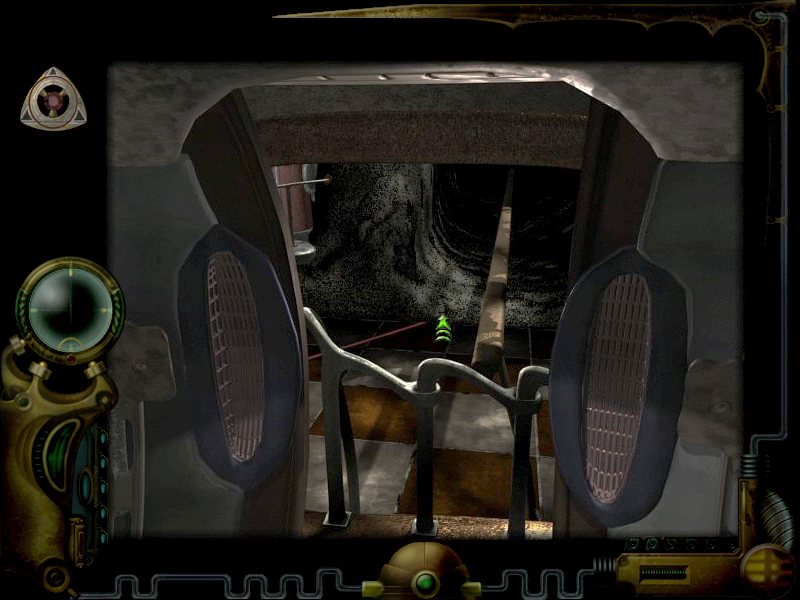 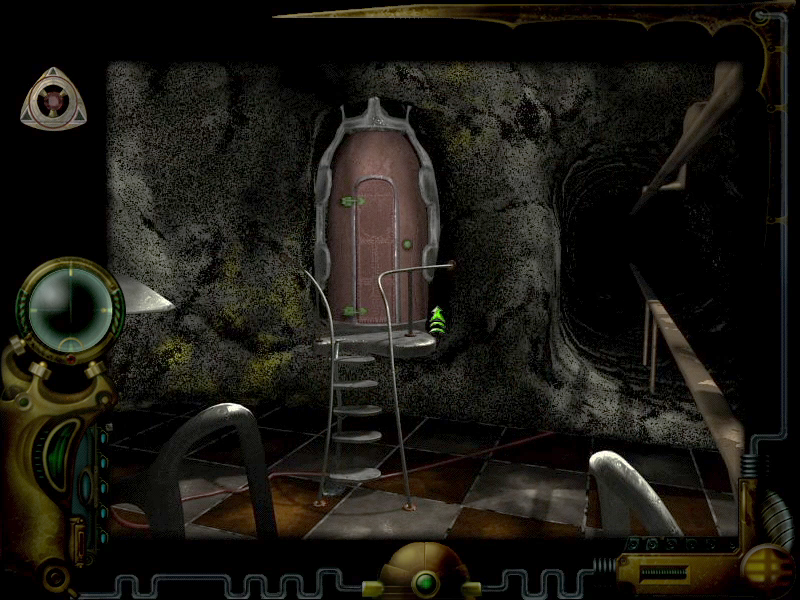 Huh, seems familiar. In fact, this is the same place as the Pb button brought us. There is a small difference though, when we use the Pb button to get here, we get an alarm noise once the transporter stops, that doesn't happen with the S button. Anyway, since it's the same place, there's nothing really new to get here, so we've explored all we can explore for now. There actually is one interactable spot that I missed showing you though, back in the Ti area.  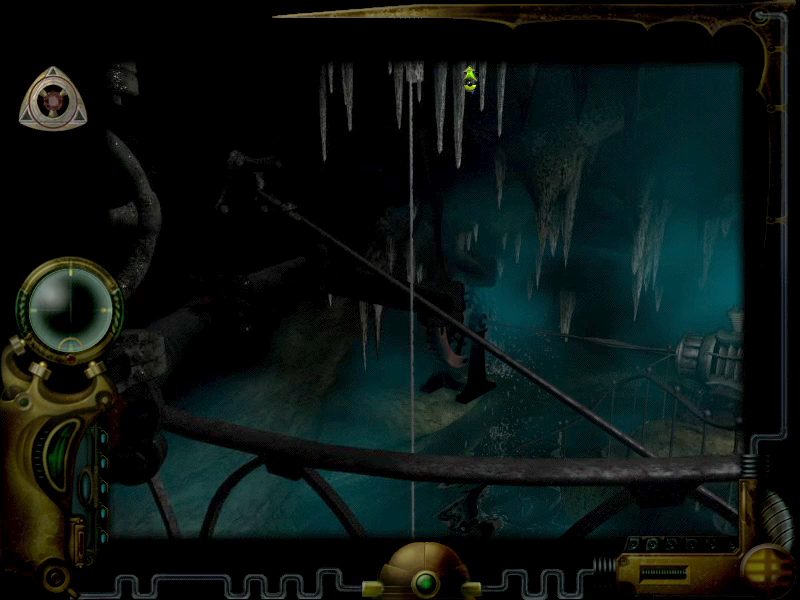 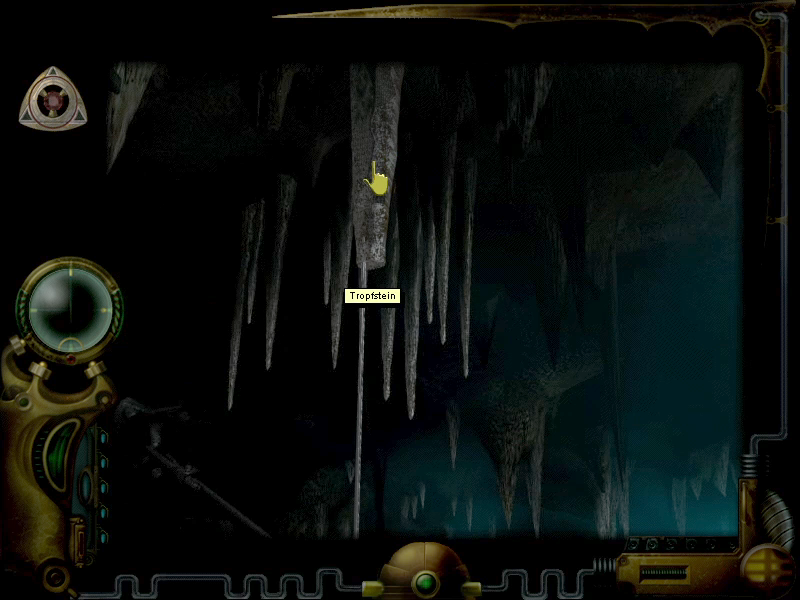 stalactite This one is relevant for an upcoming puzzle, so I thought I'd share it now. Anyways, that's all for this update. We've seen all the places we can go to right now, we've picked up everything we can (I think), and we've gotten a fair bit of hints of what sorts of chemical reactions we can do, and what problems we have right now that should be fixed. I'm compiling our current situation, hopefully without spoiling too much: Puzzles to be solved: How do we get into the H tower? What's the point of the right screen in the control room of the Ti area? How do we operate the Fe factory? What can we do with the machinery in the various labs in the Cu area? More specifically, how do we operate the Ag lab? What's up with Pb and S leading to the same location? How do we open the door in the Cl area? What's the scent lock and how do we open it? What's up with the glass bead bracelet the lab tech was asked to repair? What's the transmitter molecule and how do we synthesize it? Inventory starch UV lamp cork carbon dioxide (CO2) plant sand woodchip rose blossom coke mold for sampling iron ore (Fe2O3) very thin metal pipe fixing salt solution (Na2S2O3) cardboard code card golden template bicycle spoke white glass beads turquoise glass beads copper oxide (CuO) sulfuric acid (H2SO4) aluminium grits iron filings nitric acid (HNO3) barium nitrite (Ba(NO3)2) dregs of snow steel worm wheel broken glass prism amphora with lemon juice ultrapure water (H2O) Knowledge gathered: Energy and environment Electrochemistry Metals Salts Redox reactions Lime Esters Unlocked areas: Ti - Control Room Cl - Swimming pool H - Tower base Pb/S - Volcano Cu - Inorganic Labs Fe - Factory Al - Greenhouse C - Organic Lab With all that in mind, consider what we might already be able to solve. A few of the reactions the notes we found hinted at, we can already do. Maki fucked around with this message at 08:24 on Aug 15, 2023 |
|
|
|
Yeah, I think it's likely those bubbles are indeed because of electrolysis of water. That tends to happen quite easily as a side effect if you crank up the current even a little bit.
|
|
|
|
The thing that confuses me about this is that this is supposed to be a learning game, but the bubbles just come out of left field and (except for the section of the encyclopedia where they talk about electrolysis of water in context of making both hydrogen and oxygen), all the things about electrochemistry just talk about the different potentials of metals, so I find it a bit strange that they decided to model that reaction path in, and then just at the anode.
|
|
|
|
I played Physics game from the same series and was very confused or lazy to write stuff down.
|
|
|
|
Update B - Open World Chemistry Having unlocked all the transporter blocks the previous time and seen the before unseen places of the factory, the greenhouse and the organics lab, giving us fresh pastures to forage random chemicals and other thingamabobs people left lying around. We also found the S transporter block with sent us to the same place as the Pb transporter block (which we had found way back when), but without a beeping noise playing on arrival. Since this is one of the more glaring mysteries staring us into the face and it's one we can actually work with immediately, let's do just that. Back in Update Li, we found out that in the volcano station, there was this thing below the transporter:  motor with missing transmission shaft This is what we need to fix to make sense of the whole transporter block thing. We also found this mold in the Fe factory last update:  mold for transmission shaft so it's pretty clear that we can use this mold to cast the transmission shaft we require. What do we need for that? Well, the factory makes steel based on the ingredients on the panel we found:  The oxygen we just get from the ambient air, so we're left with three ingredients to procure. C is carbon, which is the easiest, because we already found coke in the previous update, which is basically pure carbon. The Fe aka iron, you might think we already have in form of iron ore, but that is actually Fe2O3 so we need to turn that ore into elemental iron. I'll get back to that in a minute. The CaO is quicklime. How does one make quicklime? Well, here we get to learn about the lime cycle. There are three lime compounds that are relevant for the lime cycle:
For each one of the three, there is a fairly simple reaction to get to the next one in line (and it's a cycle, so we go from bottom to top): By adding water, we can make caustic lime from quicklime: CaO + H2O → Ca(OH)2. This reaction is also exothermic, so it gets pretty hot. By adding carbon dioxide, we can turn caustic lime into limestone: Ca(OH)2 + CO2 → CaCO3 + H2O And finally, by heating it up, we can turn limestone into quicklime: CaCO3 → CaO + CO2 This tells us that if we can procure either caustic lime or limestone, we can make quicklime with it. Here's were the stalactite from the tail end of the last update comes in: Stalactites are limestone, so if we can take some of that stalactite, we can heat it and make the CaO we need. How do we do that? Adventure game logic to the rescue!  stalactite we see that a stream of water is flowing through the stalactite. We can plug that stream with the cork 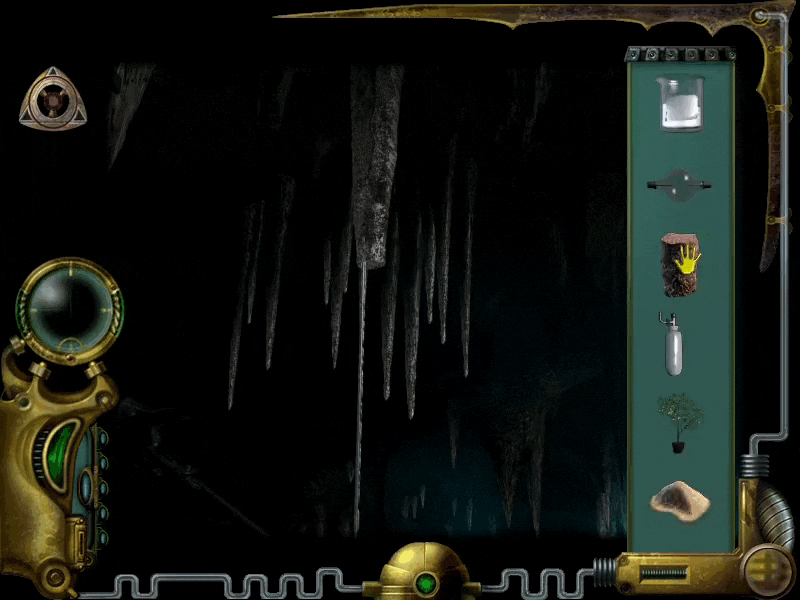 stalactite clogged and filled with water 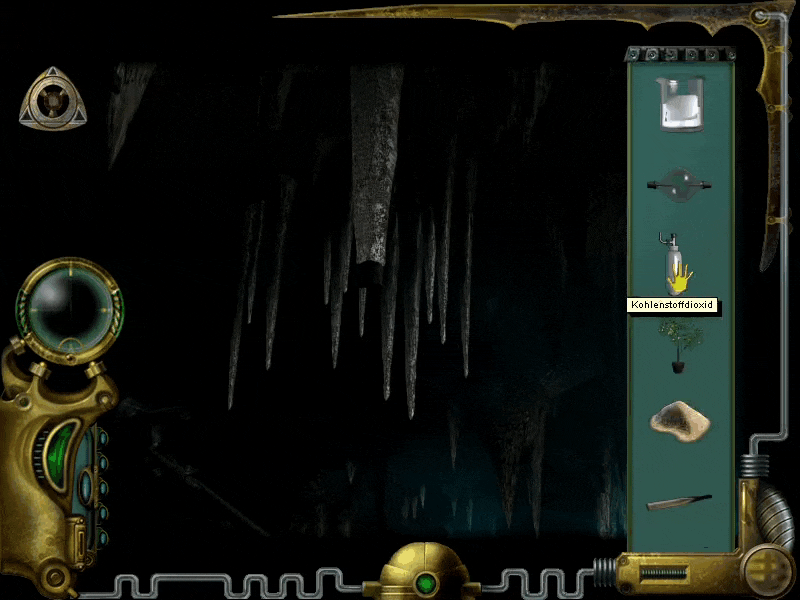 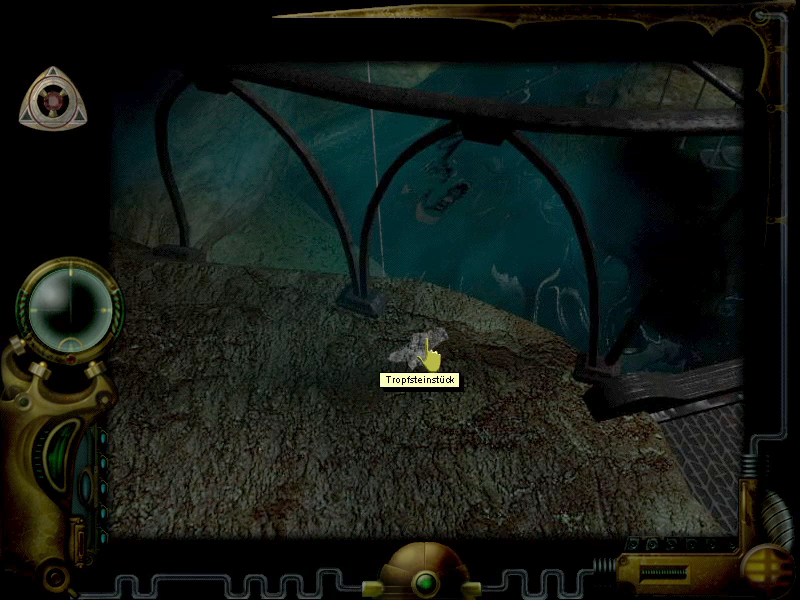 piece of stalactite Lost: cork Picked up: piece of stalactite Alright, that's the piece of stalactite, which is limestone, which we can turn into quicklime by heating it. How do we heat it? Well, we've already found a burner in the Zn lab, so let's try and use that.  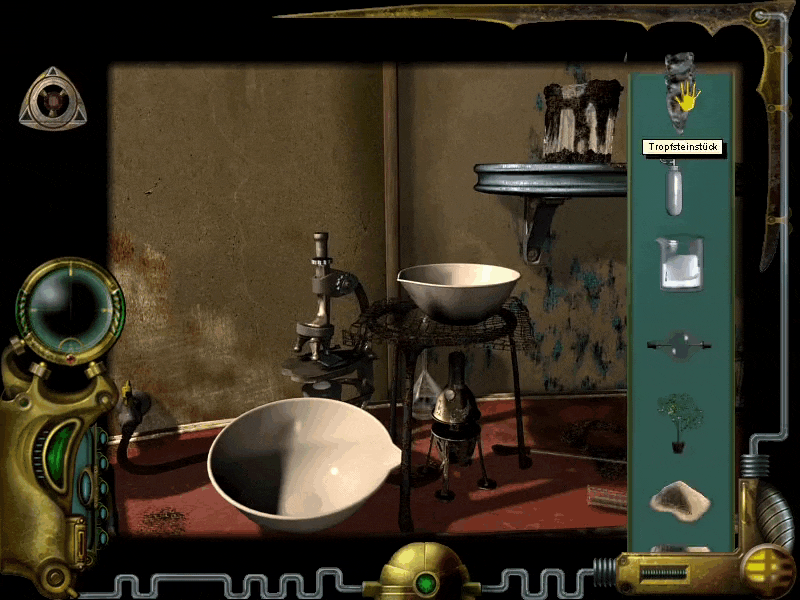 crucible with piece of stalactite 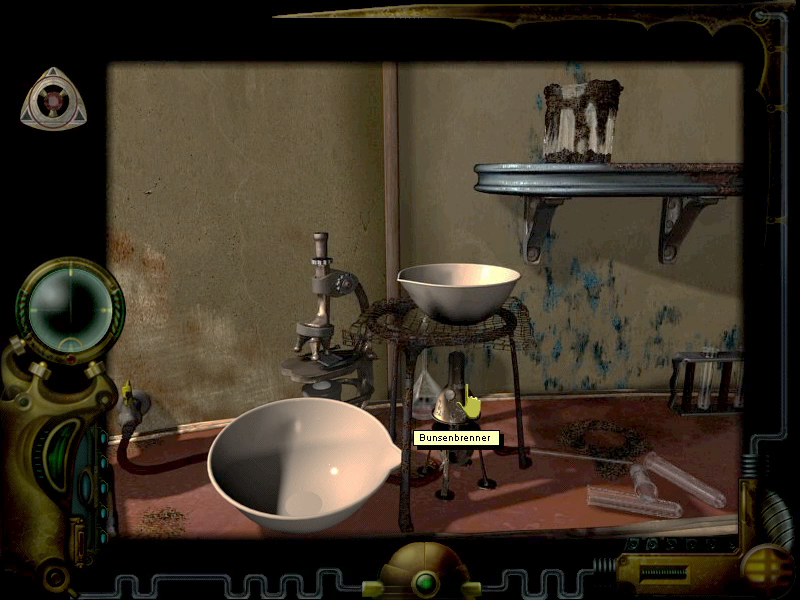 bunsen burner Lost: piece of stalactite The limestone goes into the crucible without a problem, but when we try to activate the burner, nothing happens. some lab dude posted:We keep losing power and gas for the labs in the Cu-position! Until we have solved this probem, the brothers will get used to moving the rooms out of that position before they can start their work. You might be remembering this journal entry from Update Li, but even moving the lab into the Zn position, nothing happens. There is, however, another point some lab dude posted:After the big explosion we had to move the lab for organic chemistry into the maintenance building for the petrol fractionation. I hope we won't get any problems from integrating the fractional destillation for lab use into the existing plant. I will instruct the brothers that gas supply to the city is only guaranteed at a temperature above 250°C. That's more helpful. So the organics lab we visited last time also contains the facilities to send gas to the labs in the city, and the setting is probably wrong right now. Fixing this will take a bit more moving around.  First, we go to the control panel back in Ti  and switch it so the pictograms show that the oil pump goes into the distillation plant.  Now we go to the organics lab and set the temperature to above 250°C on the control planel that now responds to clicking it. 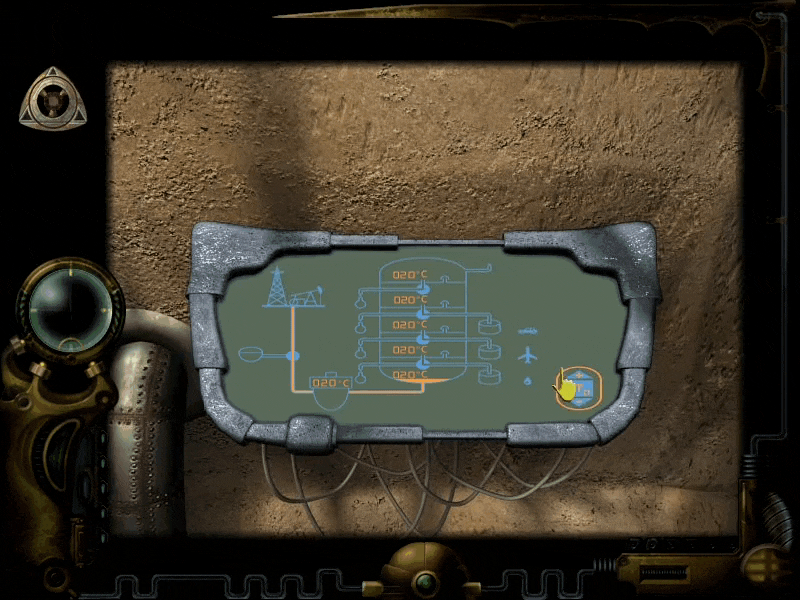  And now, we can return to the Zn lab and turn on the burner 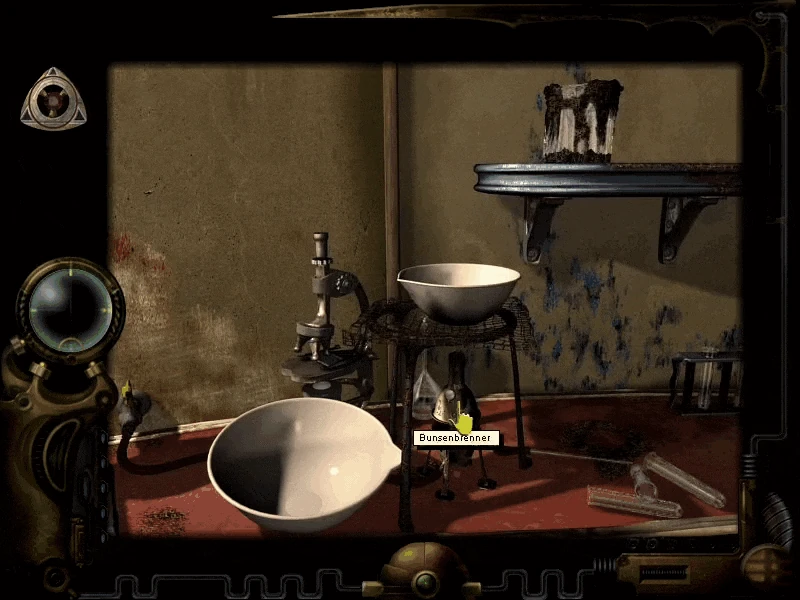 crucible with quicklime/empty crucible and I have a bit of trouble getting the game to recognise what I want to do, but in the end, it works. Picked up: quicklime Now we've got two ingredients for making steel, so let's consider the last one, the iron. As mentioned, we need to make that from the iron ore. The chemical term for what we're trying to do is a reduction. We have something that's been oxidized and we are trying to unoxidize it. This is commonly done by providing something else to oxidize, so we're reducing one thing by oxidizing something else. This is known as a redox reaction. Historically, it meant doing what we are doing now, moving oxygen around, but nowadays, the concept has been generalised to talk about electrons that are doing the moving, but that doesn't need to concern you, the important part is, we need something to take the oxygen from the iron, which can be a metal forming stronger bonds with oxygen than iron does. The aluminum grits that we collected a while ago should do the trick just nicely. The actual reaction that we will be doing is called thermite, which generated a lot of heat, but also requires some energy to get started. Luckily, the lab dude's diary provides us with an illustration. some lab dude posted:
We're going to make a sparkler, and we already have everything we need for it right here. 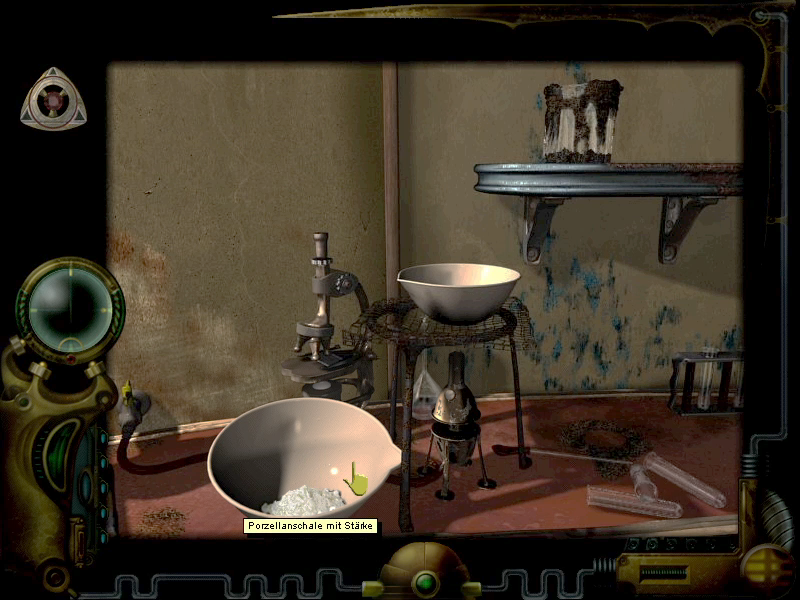 porcellain bowl with starch 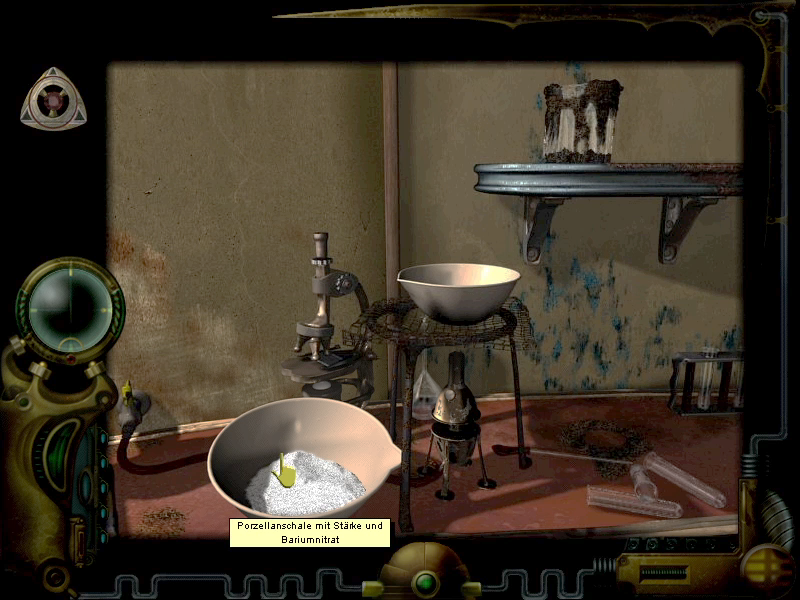 porcellain bowl with starch and barium nitrate 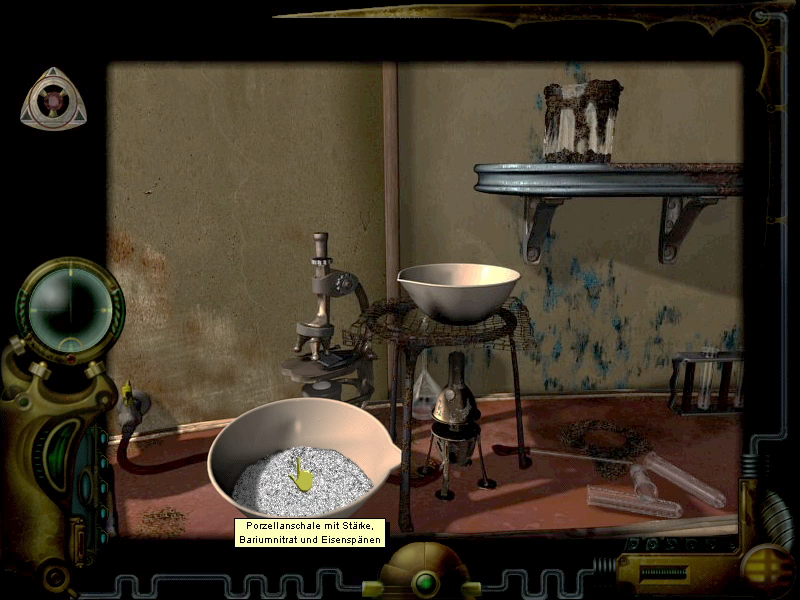 porcellain bowl with starch, barium nitrate and iron filings 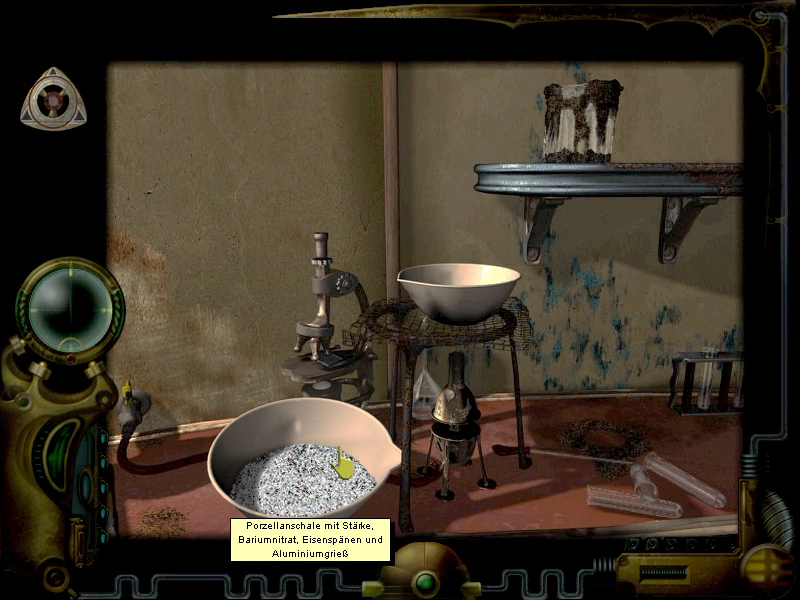 porcellain bowl with starch, barium nitrate, iron filings and aluminium grits 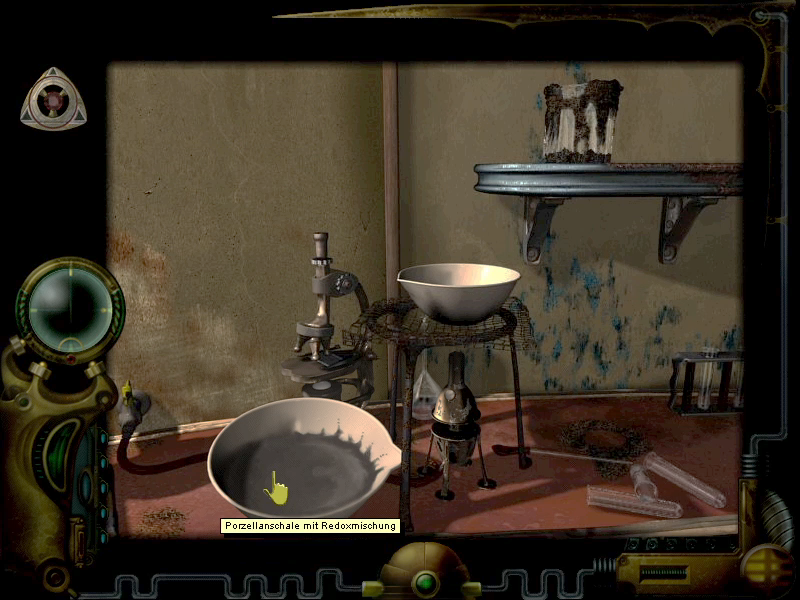 porcellain bowl with redox mixture 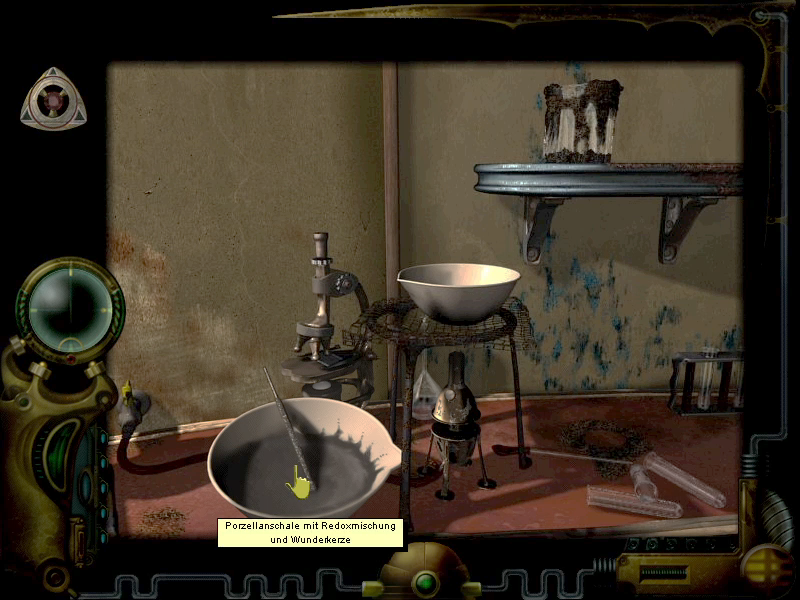 porcellain bowl with redox mixture and sparkler Lost: starch, barium nitrate, iron filings, bicycle spoke Picked up: sparkler So, as the text suggests, a sparkler burning is a redox reaction as well, or rather, there's multiple things going on at the same time. The four relevant components here (the water only serves to make a nice paste) are the barium nitrate, the two metals, and the starch. The easiest thing that happens when the sparkler burns is that the metals react with oxygen to form oxides. That's a very standard reaction when burning something. 4 Al + 3 O2 → 2 Al2O3 4 Fe + 3 O2 → 2 Fe2O3 The starch is also burning, turning into carbon dioxide and water (yes, if you didn't know, burning organic compounds frequently produces water). Starch forms gigantic molecules, the reaction written down here describes what one sugar in a starch chain would maybe burn as: C6H10O5 + 6 O2 → 6 CO2 + 5 H2O Finally, the barium nitrate decomposes because of the heat, into barium oxide, nitrogen and oxygen 2 Ba(NO)3 → 2 BaO + 2 N2 + 5 O2 This is one reaction that could happen, we can also get nitrous oxides here and carbon monoxide from burning the starch, but the exact gases don't matter that much to the overall result. So the metals burn to form oxides. At the same time, the starch and barium nitrate create gases that expand and propel glowing pieces of burning metal through the air, which we can see as the sparks of the sparkler. Note that the decomposing barium nitrate provides oxygen, which is why a sparkler, once the reaction has been set into motion, can burn without requiring additional oxygen and can therefore burn even in inert gas, stuck in the ground or underwater. If you actually try the underwater bit, it probably won't work, because the water will cool the small sparkler down enough that the reaction will just stop. Now, we only need to use a vessel strong enough to withstand the enourmous heat that thermite produces. The illustration above already suggests something we've seen, which is the standard-issue flower pot in the greenhouse area.  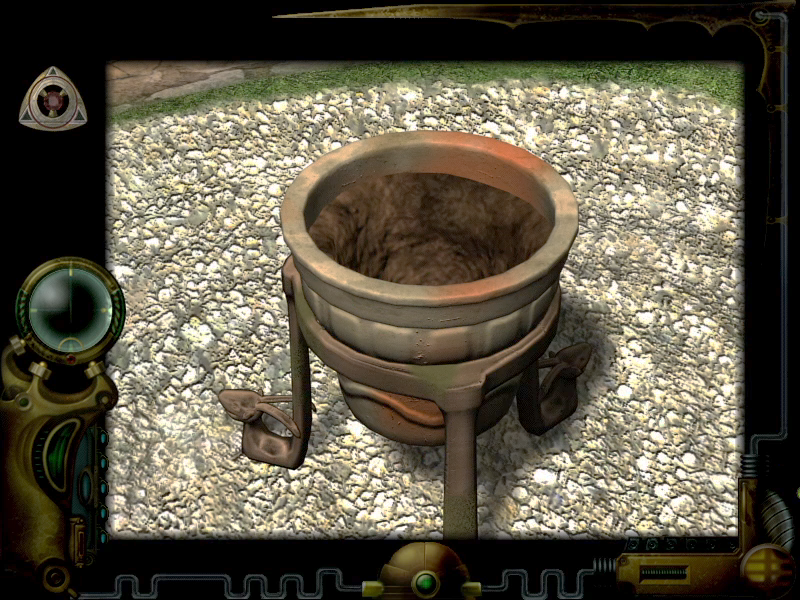 We fill in the iron ore... 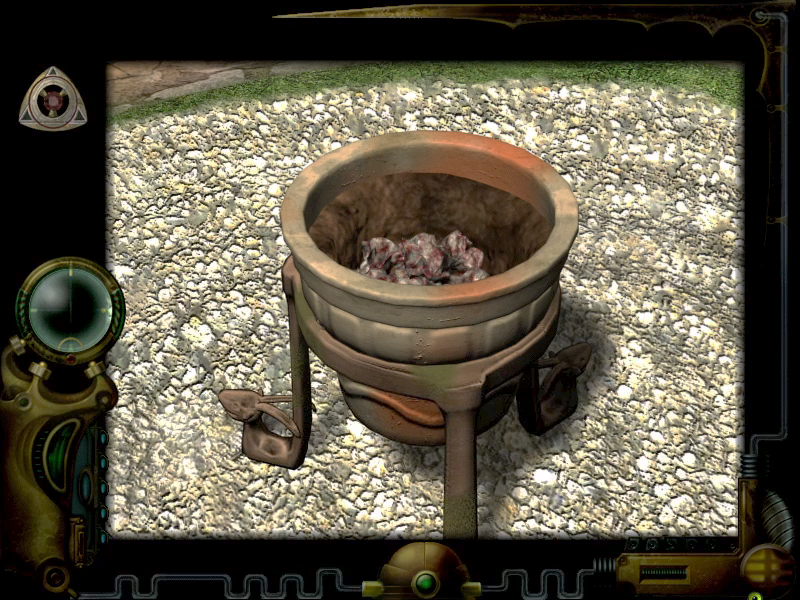 ...the aluminium grits... 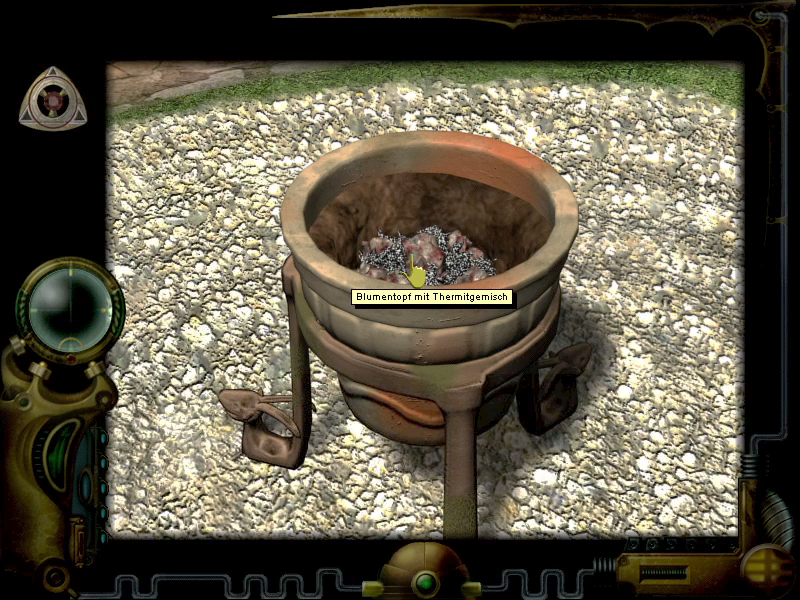 flower pot with thermite mixture ...stick in the sparkler... 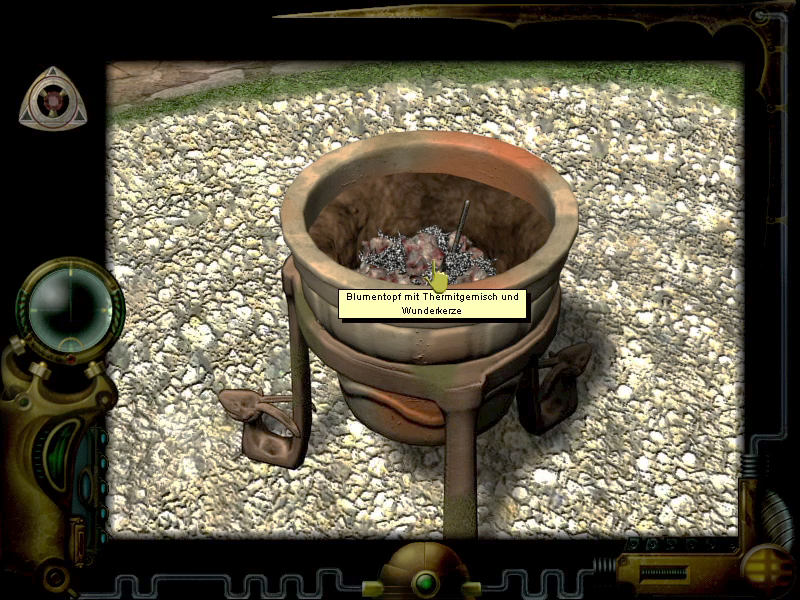 flower pot with thermite mixture and sparkler ...put the mould below it as a receptacle... 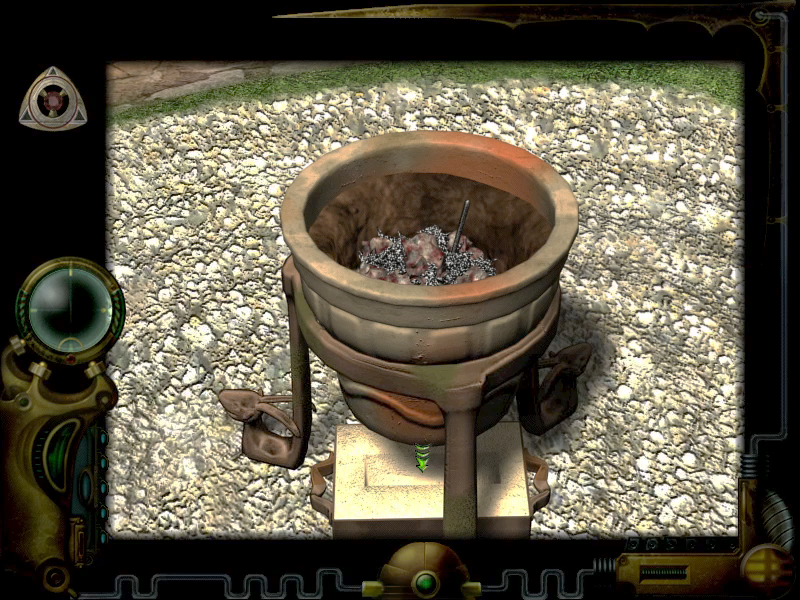 ...and light the sparkler on fire with that woodchip we found.  That didn't work, guess the woodchip, though charred, was not hot anymore. No problem, let's go and light it. 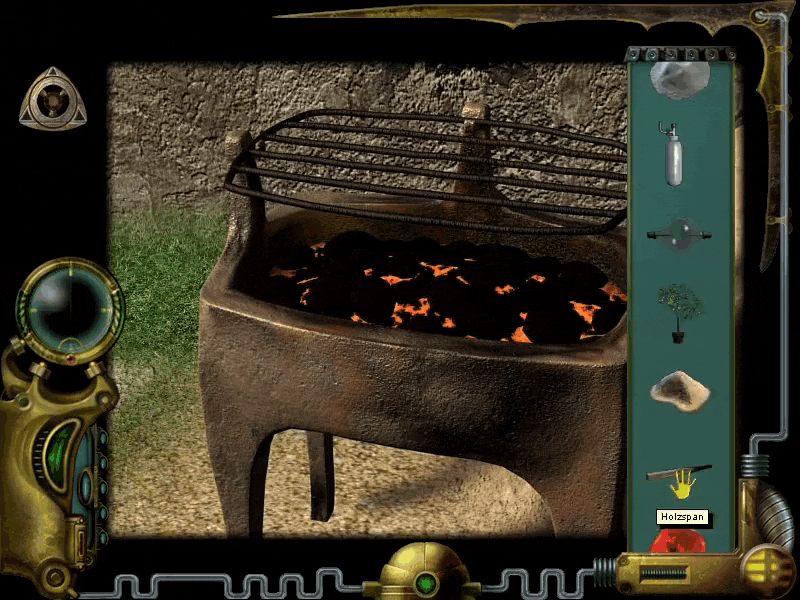 smouldering woodchip Let's go and retry this. 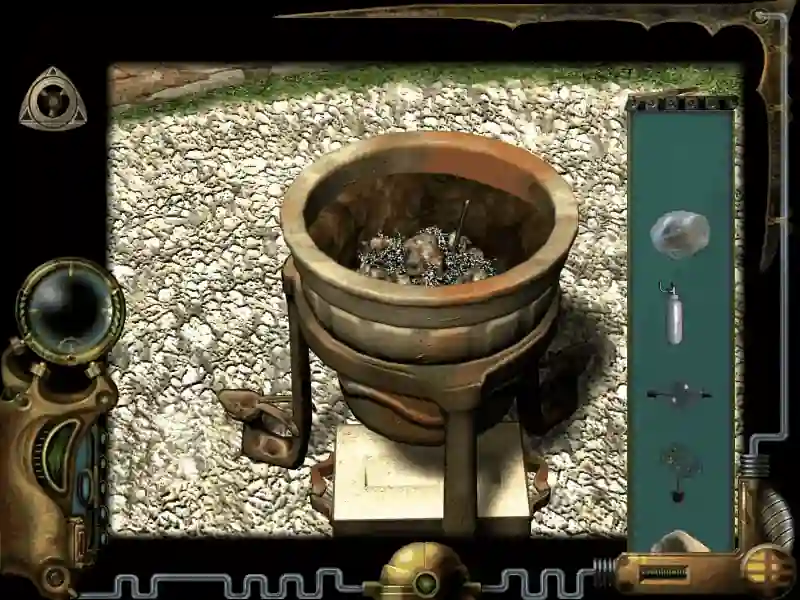 After a rather violent reaction, the mould is filled with hot metal that in real life would probably take quite a while to cool down. Thankfully, our pants lab is properly insulated, so we can just stick the presumably half-molten piece of iron right in a pocket. 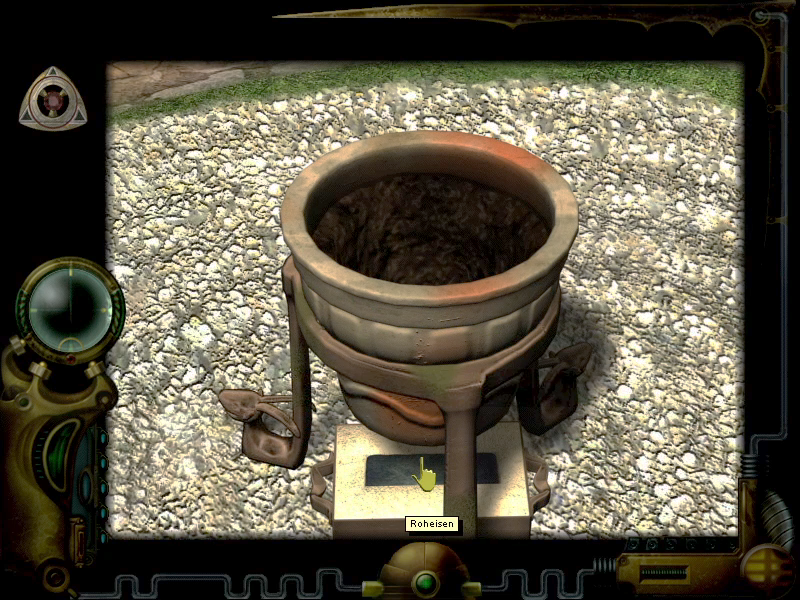 raw iron Lost: iron ore, sparkler, mould, smouldering woodchip Picked up:raw iron What happened here is that the iron ore and aluminium reacted to iron and aluminium oxide: Fe2O3 + 2 Al → 2 Fe + 2 Al2O3 Upon turning around, Richard contacts us again. https://www.youtube.com/watch?v=kpagwcHOVSY Sounding kinda smug for a guy in prison there, Richard. And "years"? I'm pretty sure this playthrough won't take that long, so I guess I'm the top chemist now. Anyways, with that raw iron, we now have everything we need to make steel.  Throw in the coke 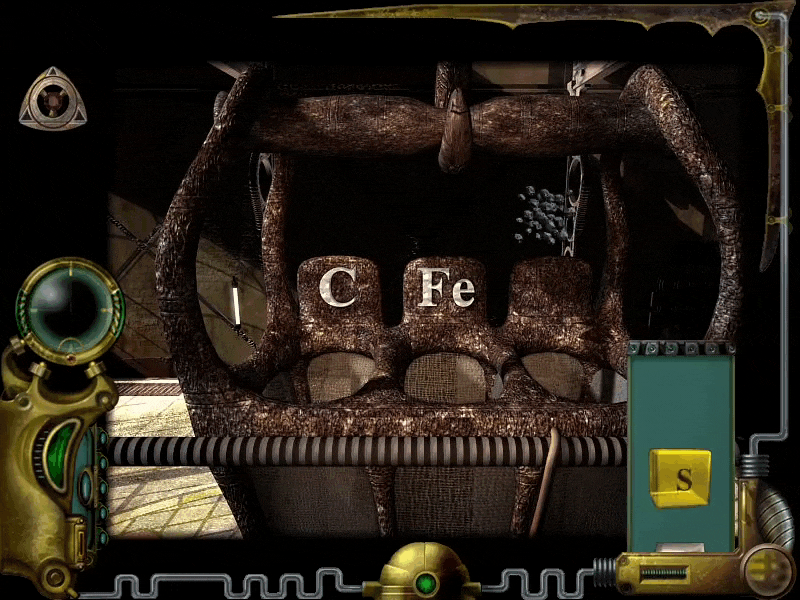 Throw in the raw iron 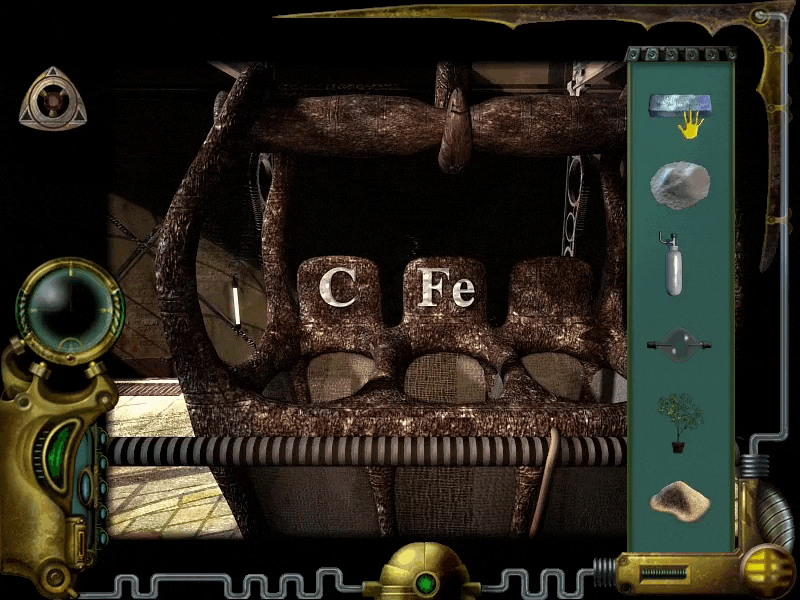 Throw in the calcium oxide 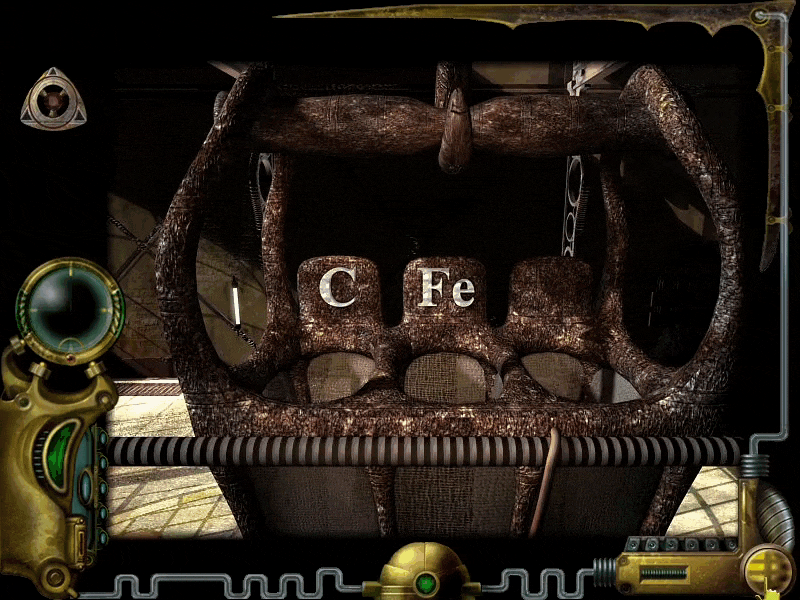 And make our way back to the control panel. If we push the big button to the left, the finest animation the late 90s could produce plays out. So fine I'm uploading it to youtube because trying to compress this down to 2MB sounds like a horrible idea. https://www.youtube.com/watch?v=41axFAuOEXA Finally, we push that button to the right to engage the press 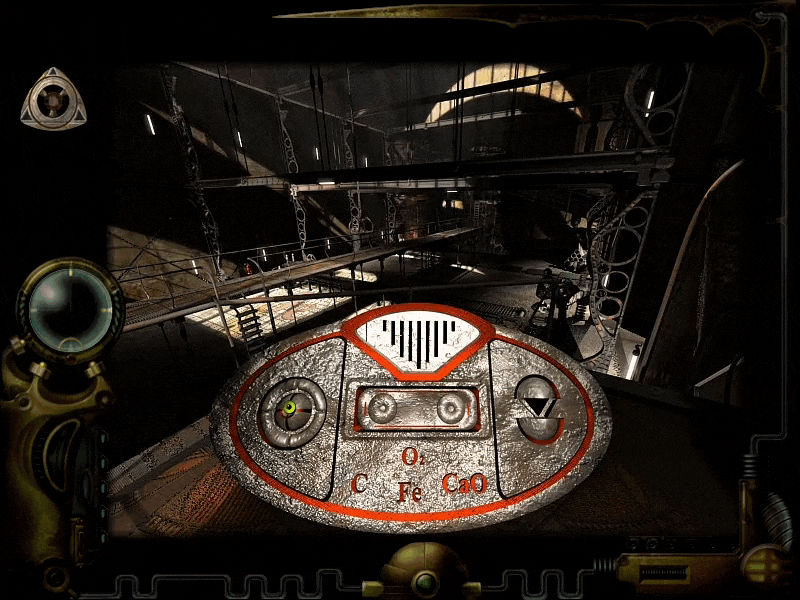 Time to check out what we've made. 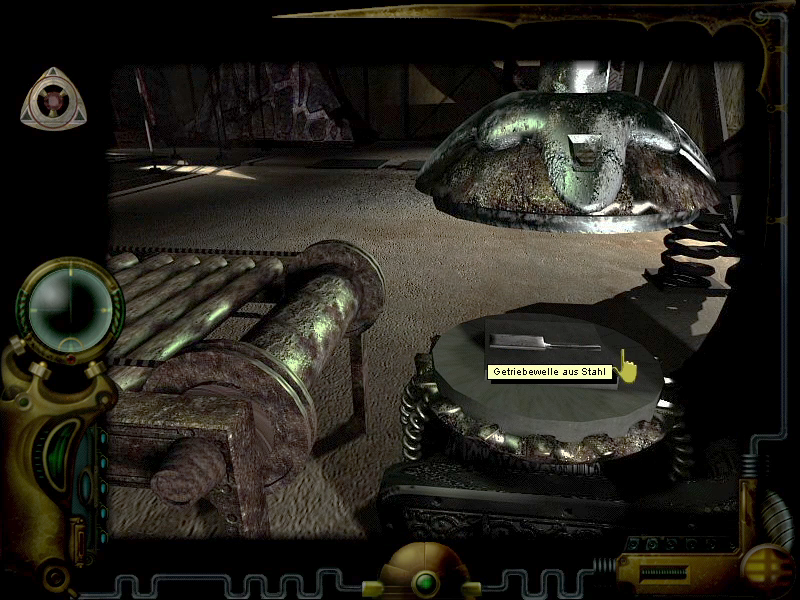 steel transmission shaft Looks like it worked. Lost: coke, raw iron Gained: steel transmission shaft So, we made steel. Steel is an alloy of iron and carbon, which means it's a metallic substance made from mixing multiple substances together of which at least one is a metal. Instead of forming a compound (like NaCl, table salt), it's a mixture that retains a lot of the properties of the metal(s) that went in, but some properties chance. The addition of the right amount of carbon makes it stronger and more resistant. Add too much carbon and you get cast iron instead, which is still durable, but has to be, as the name implies, cast because it isn't malleable enough. In modern steel, there's a host of other metals put in there to fine-tune the properties of the steel (such as chromium, which makes it resistant to corrosion). The CaO we added fulfills a different task, however: It gets rid of impurities in the steel by fusing with them to form slag, which can be removed. Anyway, we already know where that shaft goes, so let's go and put it into place.  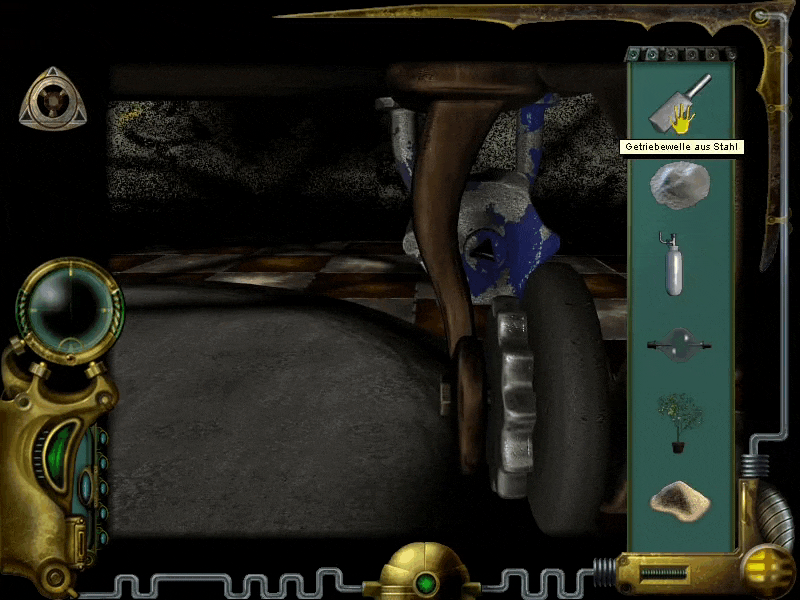 transmission shaft with missing worm wheel 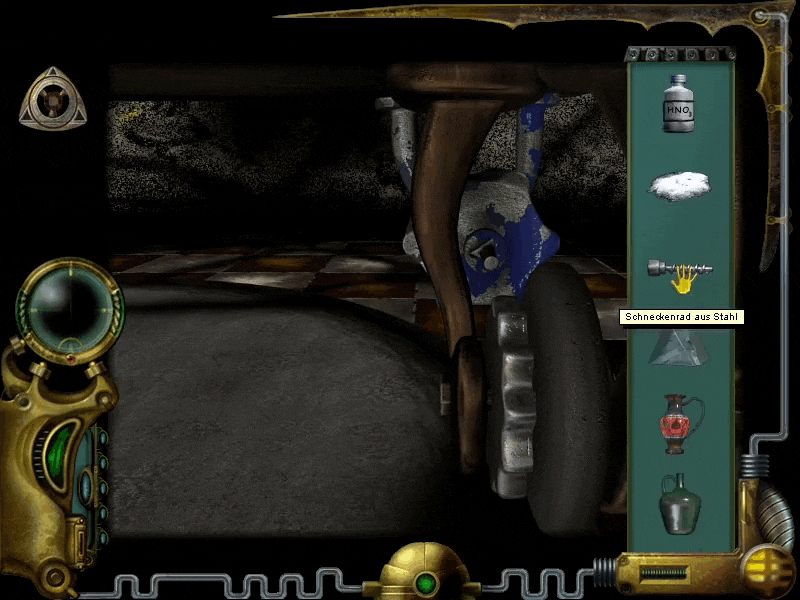 motor Alright, that looks fixed. Let's try pushing that Pb button again and see what happens. 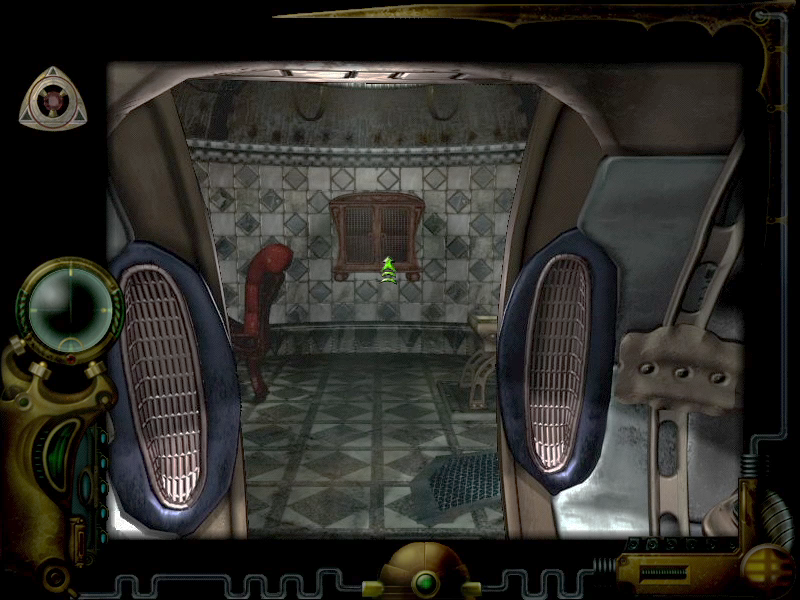 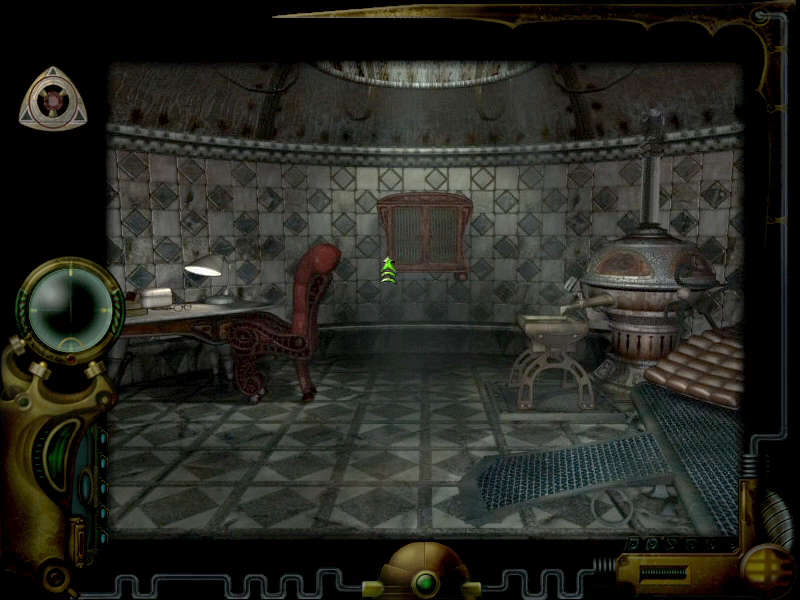 We've successfully unlocked the final location on the transporter! Let's check it out. From left to right, we have (aside from non-interactable views)  this thing with an ominous radiation symbol 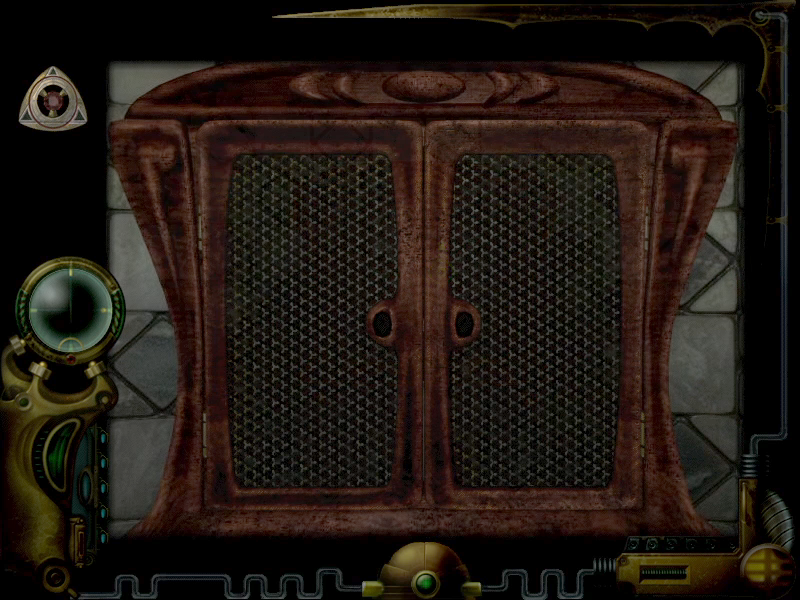 a small cabinet 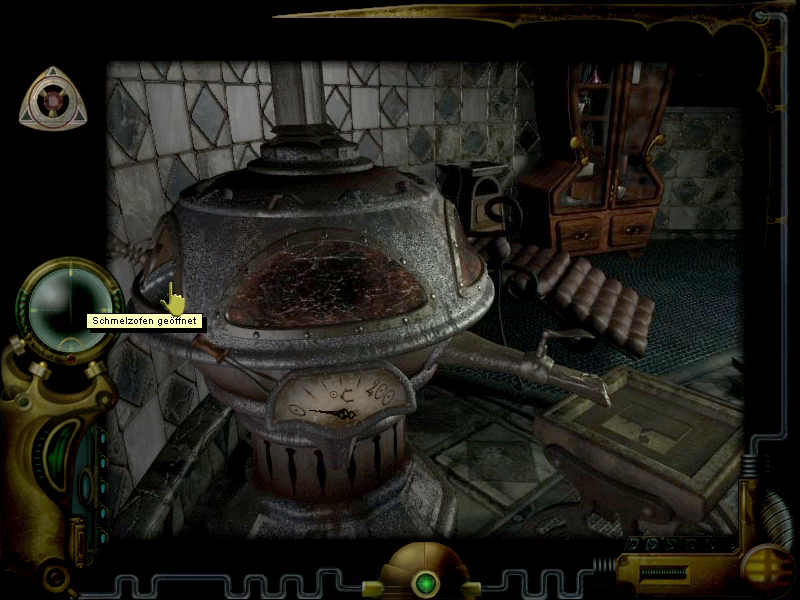 smelting furnace open a melting furnace 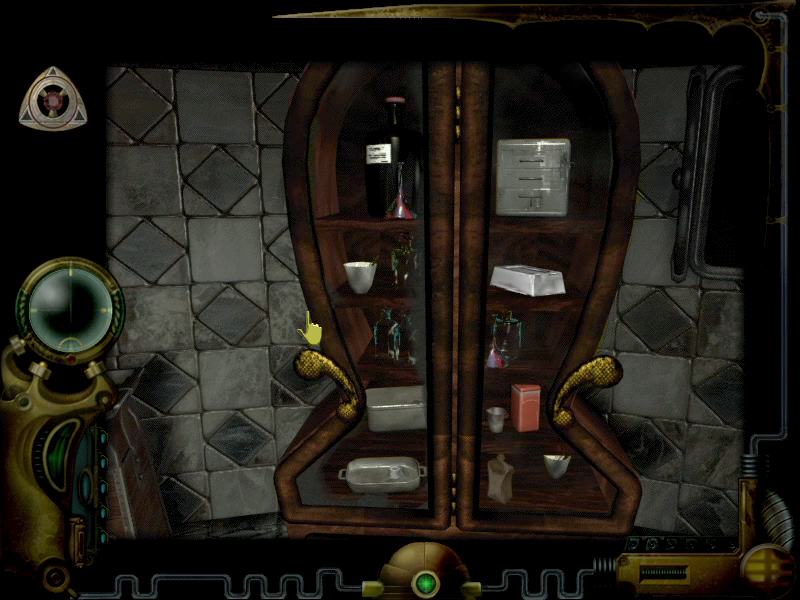 and a bigger cabinet. Checking out the cabinets first, we pick up yet more things. 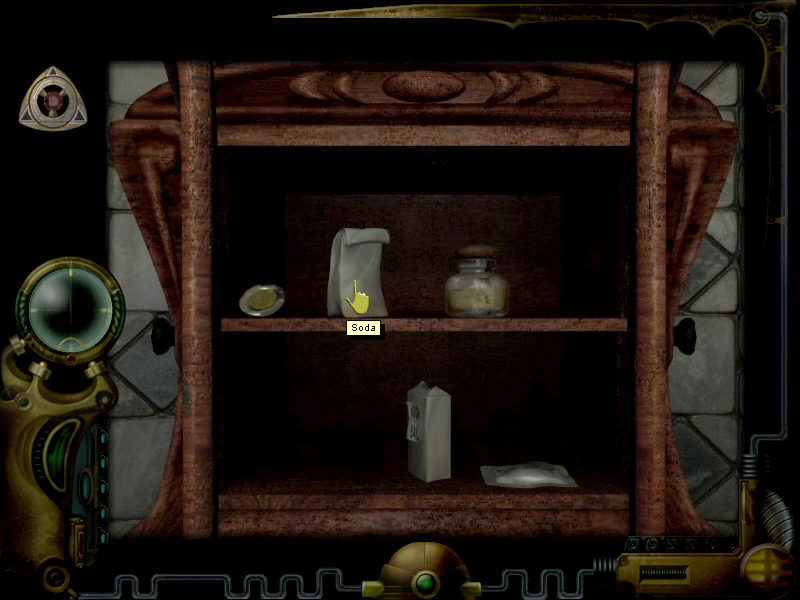 soda 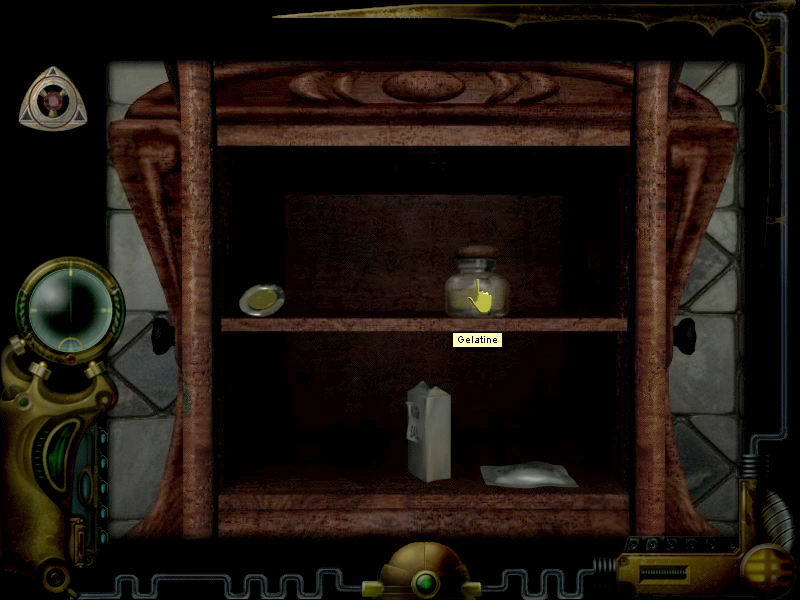 gelatin 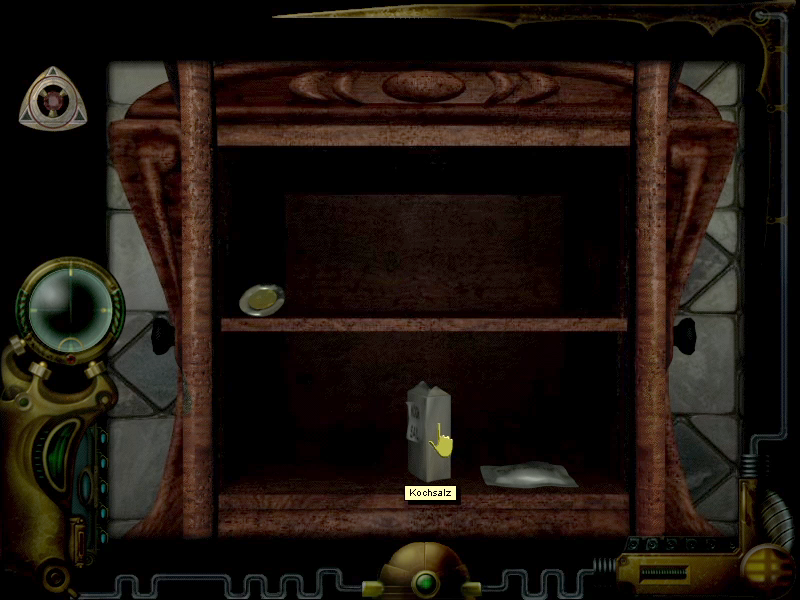 table salt 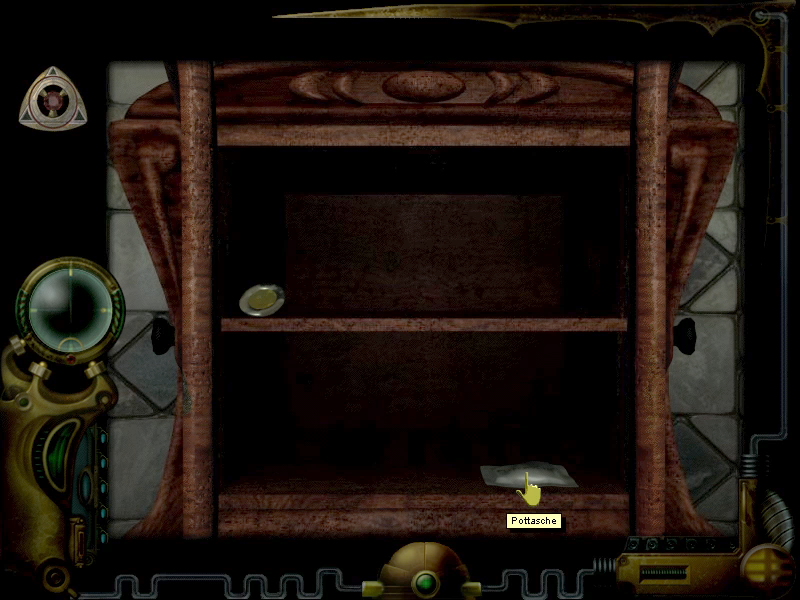 potash 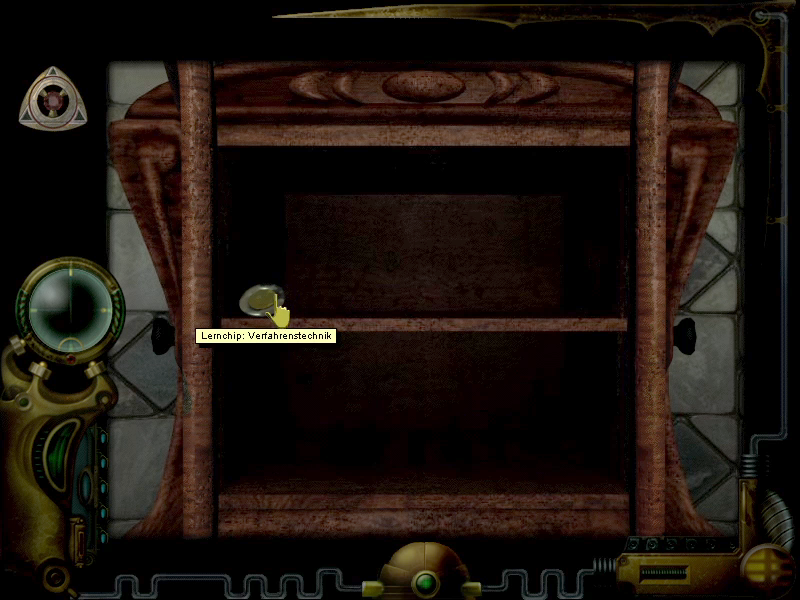 learning chip: process engineering Picked up: soda, gelatin, table salt, potash For the other cabinet, fun fact: It has two doors. 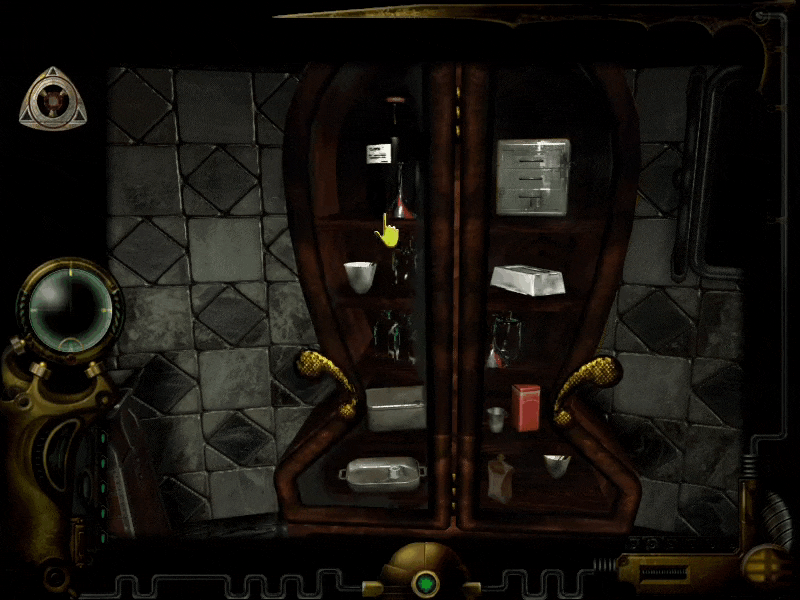 You might be able to open the left door, but none of the things in here are interactable. Everything interesting is on the other side. 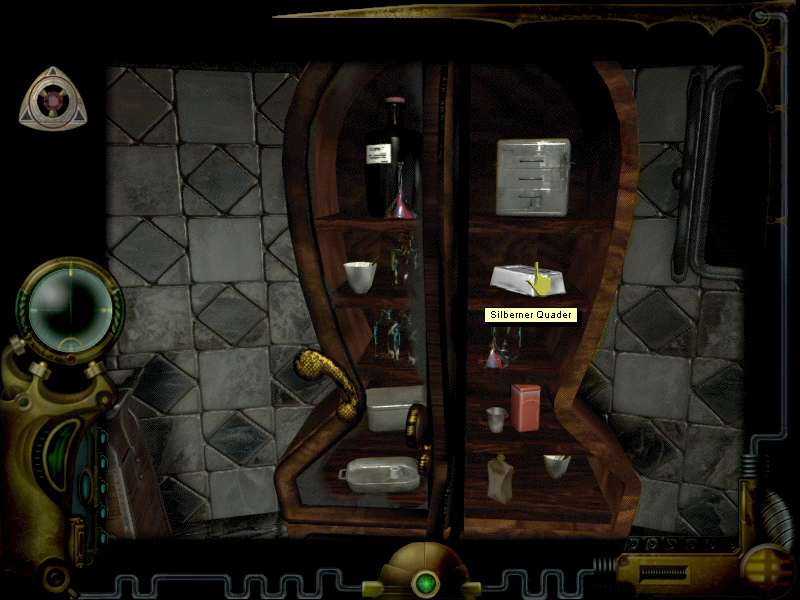 silver cuboid 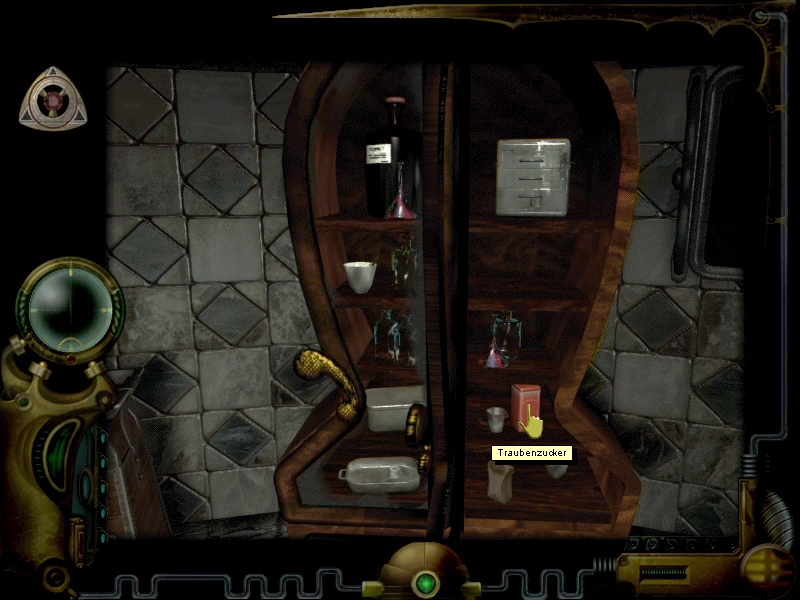 glucose 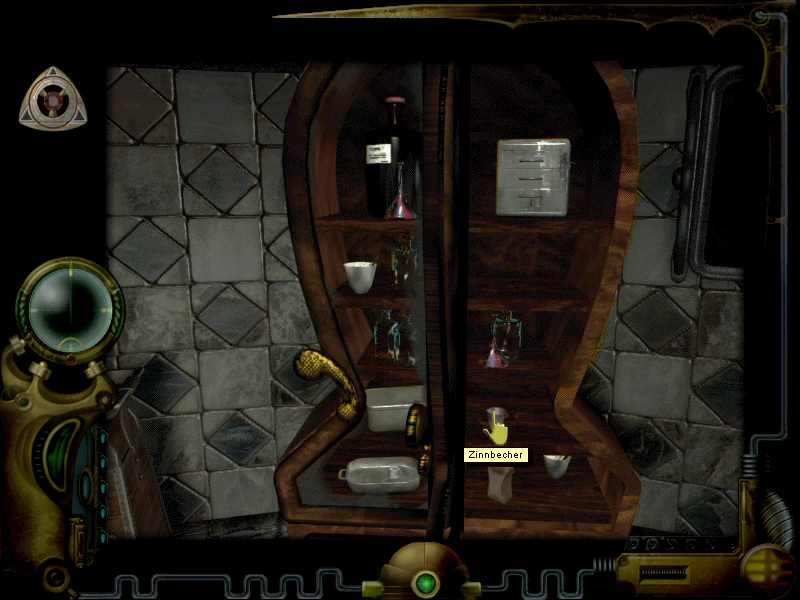 tin cup 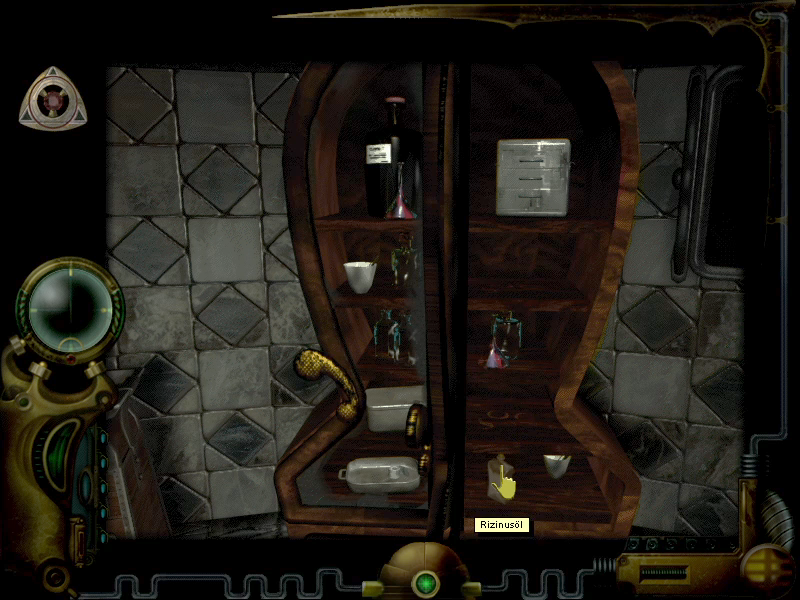 castor oil Picked up: silver cuboid, glucose, tin cup, castor oil Now, let's go for that furnace. 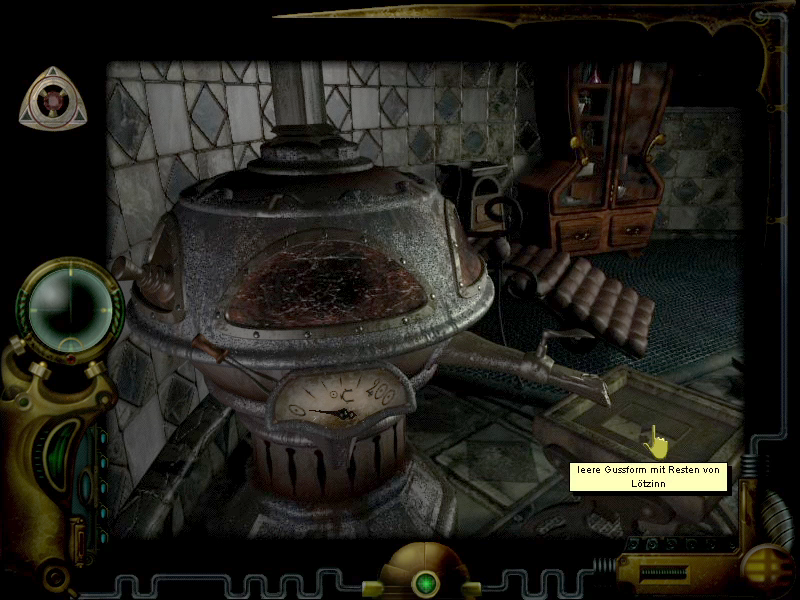 empty mould with dregs of solder We can use the levers to turn this thing on and off, but that does nothing and none of the items in my inventory want to be put into the furnace, so I guess we still gotta wait. This leaves us with only the radiation device left of the entrance to examine up close. 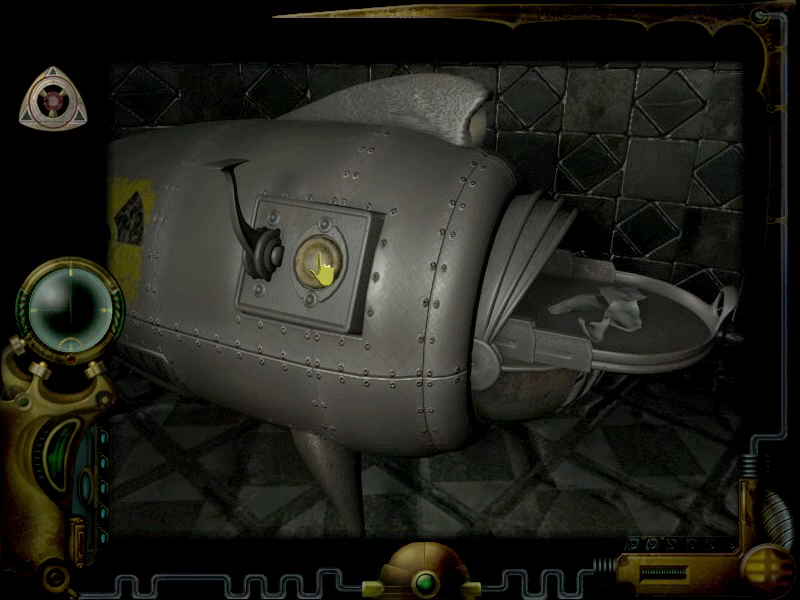 Okay, so we've got a lever, a button, and a tray. On its own, the button does nothing. The way to work this is to first pull the lever... 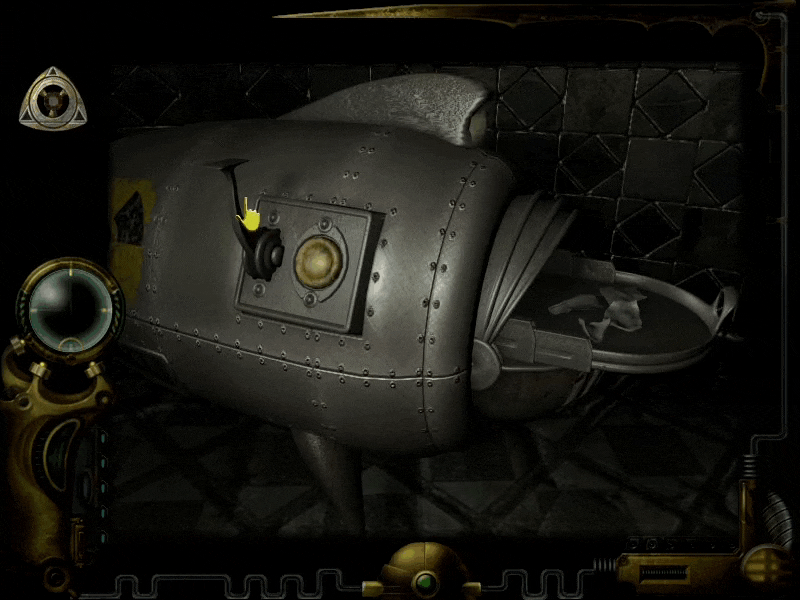 ...then push the button... 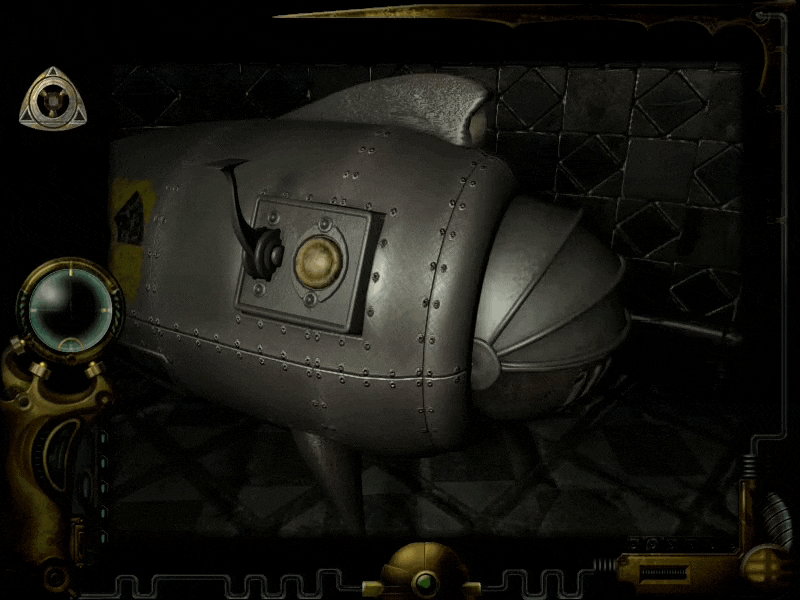 ...the machine turns on! We can inspect the result on the projection surface to the right. 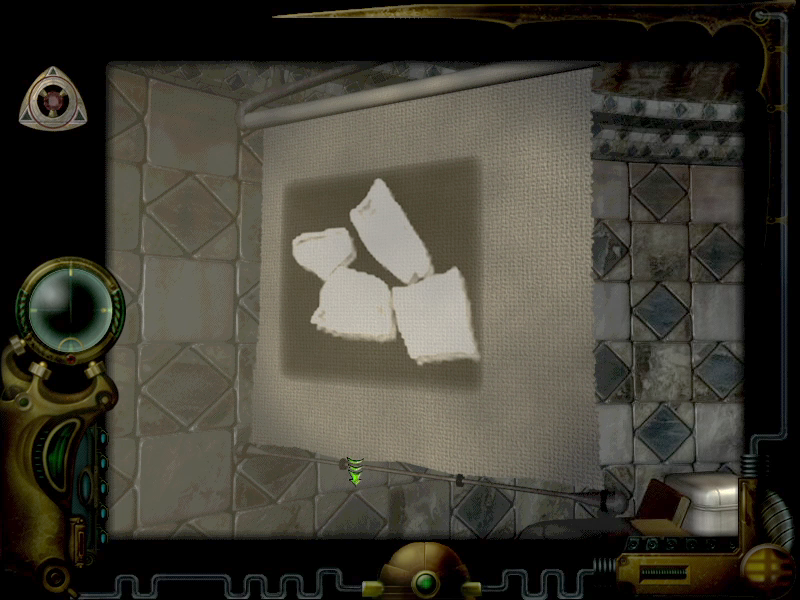 In case this means nothing to you, this machine uses X-rays to produce an image of the inside of whatever's on the tray. The white spots in the image mean that what we are x-raying here does block x-rays. Let's open the thing back up and check. 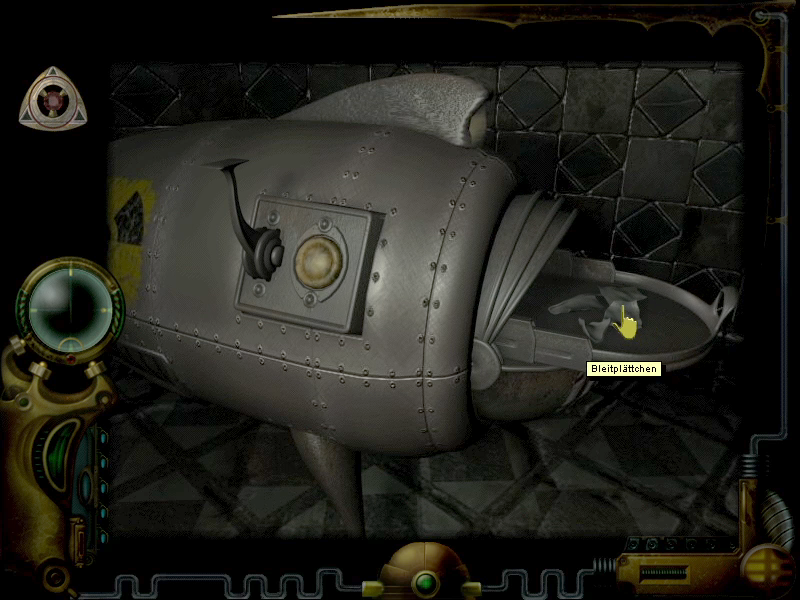 lead platelets Picked up: lead platelets Yep, that'll do it. Thinking we might be able to x-ray something in our inventory, I try out a few things 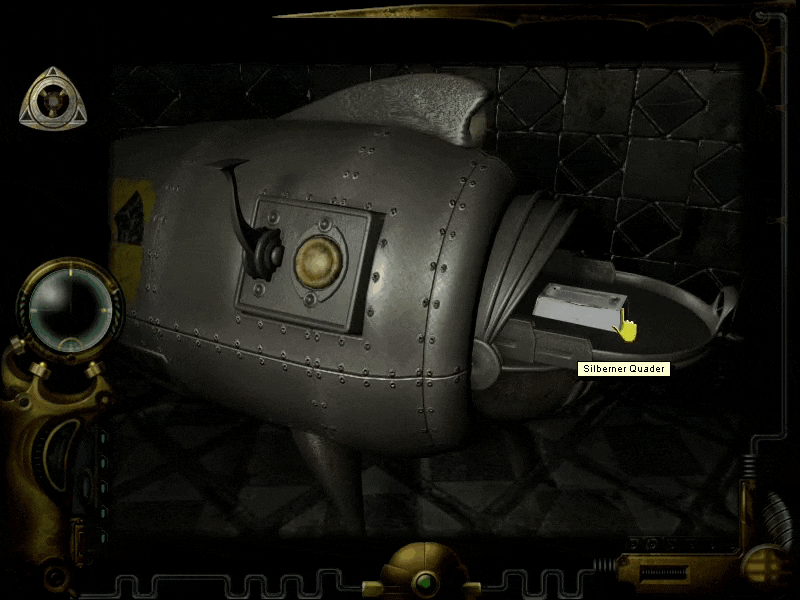 And with the silver cuboid, we hit something the game will let us x-ray. 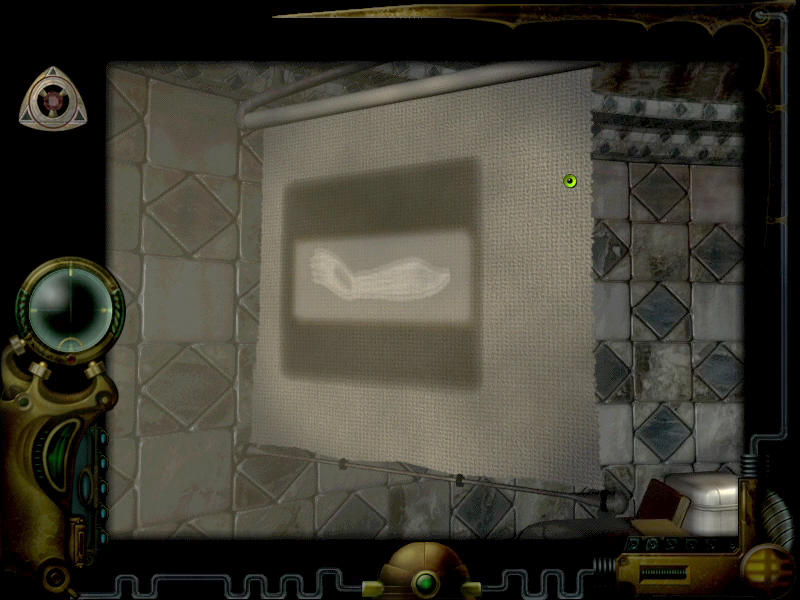 Looks like there's a forearm with hand inside that cuboid. We pick it back up. (EDIT: I should also note that scanning it with that thing we've got at the left side of the inventory gives us both Au (gold) and Ag (silver), so a reasonable guess is that the cuboid is silver and the thing inside it is gold.) And that's all we have for this update. We have now truly completed the transporter controls and checked out all places it can take us. While we picked up loads of new stuff, we are actually carrying one item in total less as well, since we used a lot of stuff to get that steel transmission shaft made. Also, while we have now completed the transporter, we still are missing at least one learning chip (which I can see by some topics in the encyclopedia still missing, which seems to be about isotopes and about specific hydrocarbons), so there's still (unsurprisingly) things left to discover. From here on out, I think our tasks become a lot more interrelated, so we'll have to see what will make sense to tackle next. I've still got the list of puzzles from last time, minus what we figured out this time around. Puzzles to be solved: How do we get into the H tower? What's the point of the right screen in the control room of the Ti area? What can we do with the machinery in the various labs in the Cu area? More specifically, how do we operate the Ag lab? How do we open the door in the Cl area? What's the scent lock and how do we open it? What's up with the glass bead bracelet the lab tech was asked to repair? How do we get the presumably golden forearm out of the silver cuboid? Inventory silver cuboid castor oil tin cup glucose potash (K2CO3) table salt (NaCl) gelatin soda (Na2CO3) lead platelets quicklime (CaO) carbon dioxide (CO2) UV lamp plant sand rose blossom very thin metal pipe fixing salt solution (Na2S2O3) cardboard code card golden template white glass beads turquoise glass beads copper oxide (CuO) aluminium grits nitric acid (HNO3) dregs of snow broken glass prism amphora with lemon juice ultrapure water (H2O) Knowledge gathered: Energy and environment Electrochemistry Metals Salts Redox reactions Lime Esters Process engineering Unlocked areas: Ti - Control room Cl - Swimming pool H - Tower base Pb - Medical room S - Volcano Cu - Inorganic labs Fe - Factory Al - Greenhouse C - Organic lab Maki fucked around with this message at 22:31 on Oct 8, 2023 |
|
|
|
Honestly, this is a really cool game, now that the sandbox has opened up. The animations also remind me of some of the old Nancy Drew games, or maybe Team Xtreme: Weather Disaster.
|
|
|
|
Quackles posted:Honestly, this is a really cool game, now that the sandbox has opened up. The animations also remind me of some of the old Nancy Drew games, or maybe Team Xtreme: Weather Disaster. Yeah, I do have fond memories of it. And when you can actually figure something out based on chemistry you know, it feels great. My biggest issue with it is that it isn't always great at telling you what it wants you to do. This probably comes across less with me piloting this game and half-remembering where to go and what to do. Like, the thermite reaction was well established with the lab dude's diary, and step-by-step instructions. The coke was just there, so that's also reasonable. But that you're supposed to get the quicklime from limestone that you get by corking and freezing a stalactite, that I find hard to come up with (had I not half-remembered it). Side note, I have added a few more facts about that silver cuboid that I learned when editing in some of the chemical formulas for the inventory just now, that might help with signposting what the game expects you to do with that thing. Maki fucked around with this message at 10:31 on Oct 8, 2023 |
|
|
|
Reading the update I was a bit confused that to make pure iron, we needed to do a thermite reaction which uses up pure iron. But I guess the heat was enough to decompose a lot of the iron ore, much more than the little amount of iron you used for the thermite.
|
|
|
|
Carbon dioxide posted:Reading the update I was a bit confused that to make pure iron, we needed to do a thermite reaction which uses up pure iron. Does it use up iron? I realise I forgot the equation there (gonna go over the update later), but shouldn't thermite be Fe2O3 + 2 Al -> 2 Fe + Al2O3
|
|
|
|
Maki posted:Does it use up iron? I realise I forgot the equation there (gonna go over the update later), but shouldn't thermite be I don't know? You said in your update you put iron filings in the thermite mixture so that both of these reactions could happen simultaneously. 4 Al + 3 O2 → 2 Al2O3 4 Fe + 3 O2 → 2 Fe2O3
|
|
|
|
Carbon dioxide posted:I don't know? You said in your update you put iron filings in the thermite mixture so that both of these reactions could happen simultaneously. I think that's in the sparkler, not the thermite reaction. Thermites are typically reactions that move oxygen from a metal oxide to a more electronegative base metal - so you go from e.g. iron oxide + aluminium to iron + aluminium oxide.
|
|
|
|
Oh right, you use the sparkler to get the thermite reaction going. Still my point stands, I was confused for a bit by the fact that you needed elemental iron to run the reaction to make elemental iron.
|
|
|
|

|
| # ? May 5, 2024 00:38 |
|
Carbon dioxide posted:Oh right, you use the sparkler to get the thermite reaction going. Yeah, fair point, it's a bit hard to keep track of what's what. I guess, in the end, we make more iron from the thermite than we need to put into the singular sparkler
|
|
|



